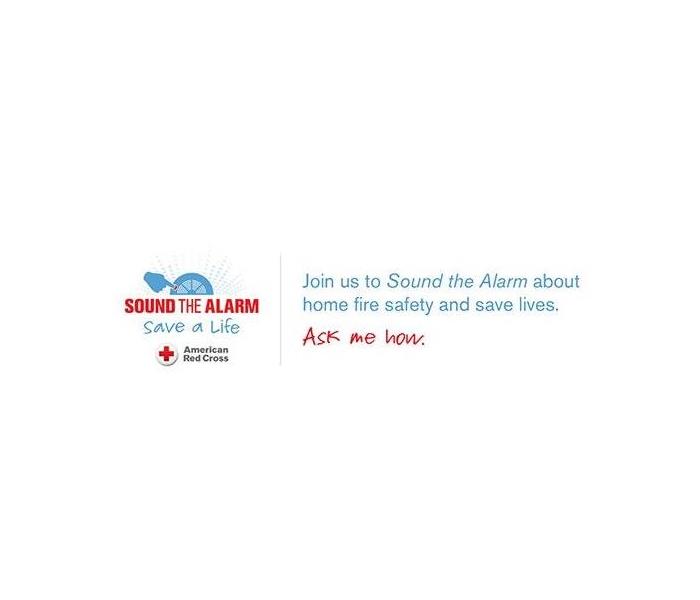Archived Blog Posts
How to Deal With Flood Damage | SERVPRO of St. Charles
6/28/2023 (Permalink)
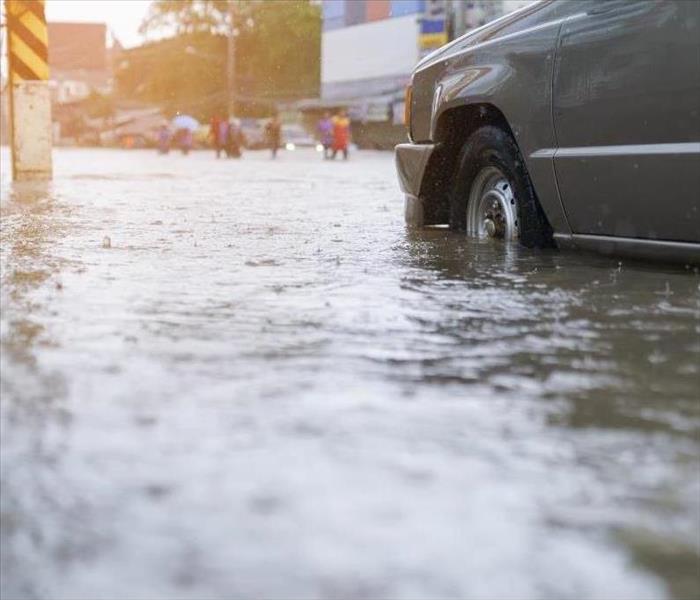 SERVPRO of St. Charles is here to help with flood damage
SERVPRO of St. Charles is here to help with flood damage
Floods can be devastating natural disasters, wreaking havoc on homes and properties. Recovering from flood damage requires a well-structured and organized approach to minimize further loss and restore your property to its pre-flood condition. In this article, we will provide you with a comprehensive guide on how to handle flood damage effectively. By following these steps, you can navigate the restoration process more efficiently and ensure the safety and well-being of your home and family.
Step 1: Ensure Safety
Before entering your home or property after a flood, prioritize safety. Ensure that the floodwaters have fully receded and it is safe to return. Be cautious of structural damage and potential electrical hazards. Wear appropriate protective gear such as rubber gloves, boots, and face masks to avoid exposure to contaminants in the water.
Step 2: Document the Damage
Once it is safe to enter your property, thoroughly document the flood damage. Take photographs or videos of all affected areas, including structural damage, personal belongings, and appliances. This documentation will be invaluable for insurance claims and aid in the restoration process.
Step 3: Contact Your Insurance Company
Notify your insurance company about the flood damage as soon as possible. Provide them with all necessary details, including the extent of the damage, photographs, and videos. Understand your insurance policy and coverage to ensure you are aware of what is eligible for compensation.
Step 4: Disconnect Utilities
For safety reasons, turn off the main power supply to your property. Additionally, shut off the gas and water supplies to prevent further damage and potential hazards. Contact the appropriate utility companies if you require assistance with these procedures.
Step 5: Remove Standing Water
Begin by removing any standing water from your property. Use pumps, wet/dry vacuums, or hire professional water extraction services if necessary. Properly dispose of the water to prevent contamination and further damage.
Step 6: Dry and Ventilate the Property
After removing the standing water, it is crucial to dry out your home or property thoroughly. Open windows and doors to promote air circulation, and use dehumidifiers, fans, and heaters to expedite the drying process. Remove wet carpets, furniture, and other items that can harbor moisture.
Step 7: Clean and Disinfect
Floodwaters can introduce harmful contaminants and pathogens to your home. Clean and disinfect all affected surfaces, including walls, floors, and furniture. Use appropriate cleaning agents, wear protective gear, and follow manufacturer instructions for effective disinfection.
Step 8: Remove Damaged Materials
Inspect your property for damaged materials that need to be removed. This may include drywall, insulation, flooring, and furniture. Discard damaged items properly, following local regulations, and keep a detailed inventory of all disposed of belongings for insurance purposes.
Step 9: Repair and Restore
With the damaged materials removed, assess the structural integrity of your property. Repair any structural damage, including walls, floors, and roofs, with the help of professionals if necessary. Ensure that repairs comply with building codes and regulations.
Step 10: Seek Professional Assistance
Depending on the severity of the flood damage, you may need to engage professional restoration services. Experienced flood damage restoration companies, like SERVPRO of St. Charles, can provide expertise and specialized equipment to expedite the restoration process and mitigate further damage.
Step 11: Evaluate and Enhance Future Protection
As you restore your property, take the opportunity to evaluate your flood protection measures. Consider implementing strategies such as installing flood barriers, elevating electrical systems, sealing foundation cracks, and landscaping changes to divert water away from your property. Consult with experts or local authorities for guidance on flood mitigation.
Should You Get Your St. Charles Home Tested or Sampled for Mold?
3/13/2023 (Permalink)
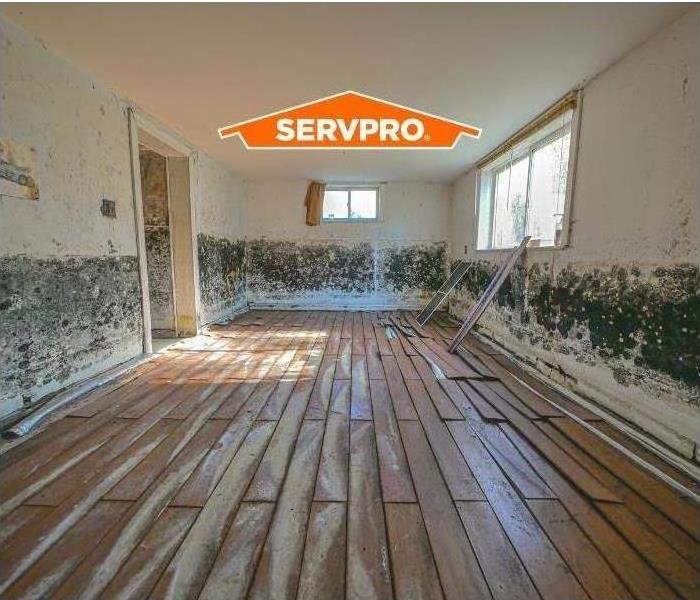 SERVPRO of St. Charles is here to help with all your mold remediation services.
SERVPRO of St. Charles is here to help with all your mold remediation services.
When is time to get a sample for mold? If visible mold growth is present, sampling is unnecessary.
Surface sampling may be useful to determine if an area has been adequately cleaned or remediated. Sampling for mold should be conducted by professionals who have specific experience in designing mold sampling protocols, sampling methods and interpreting results.
Sample analysis should follow analytical methods recommended by the American Industrial Hygiene Association (AIHA), the American Conference of Governmental Industrial Hygienists (ACGIH), or other professional organizations.
Are there federal regulations or standards regarding mold testing?
Standards or Threshold Limit Values (TLVs) for airborne concentrations of mold, or mold spores, have not been set. Currently, there are no EPA regulations or standards for airborne mold contaminants.
Understanding Mold
When water intrudes into your property, mold growth can start in as little as 48 hours. Consider the following mold facts:
- Mold is present almost everywhere, indoors and outdoors.
- Mold spores are microscopic, float along in the air, and may enter your home through windows, doors, or AC/heating systems or even hitch a ride indoors on your clothing or a pet.
- Mold spores thrive on moisture. Mold spores can quickly grow into colonies when exposed to water. These colonies may produce allergens and irritants.
- Before mold remediation can begin, any sources of water or moisture must be addressed. Otherwise, the mold may return.
- Mold often produces a strong, musty odor, and that odor can lead you to possible mold problem areas.
- Even higher-than-normal indoor humidity can support mold growth. Keep indoor humidity below 45 percent.
The Mold Remediation Process
Every mold damage scenario is different and requires a unique solution, but the general mold remediation process stays the same. Learn more about our mold remediation process.
- Emergency Contact - (636) 442-0847
- Inspection and Mold Damage Assessment
- Mold Containment
- Air Filtration
- Removing Mold and Mold-Infested Materials
- Cleaning Contents and Belongings
How to Know If Your St. Charles Home Has Plumbing Issues
3/7/2023 (Permalink)
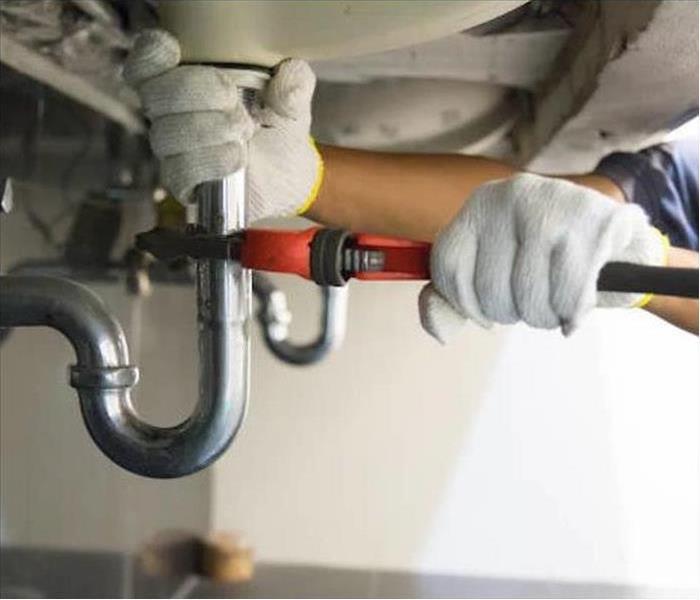 Plumber works on pipe in St. Charles, MO.
Plumber works on pipe in St. Charles, MO.
Water damage due to a plumbing issue in your St. Charles home can be life-changing. But there are some common signs that homeowners can look for, and steps they can take, to help avoid a major water issue at home.
Consider this example:
A homeowner and his family head off for a three-week vacation. While they’re away, a minor toilet leak grows, until it reaches a pace of three gallons of water per minute. By the time the homeowners returned from their three-week vacation, the unaddressed leak had poured more than 30,000 gallons of water into their home. The water ruined furniture, fixtures and irreplaceable family valuables, and rendered the property virtually uninhabitable for an extended period of time.
But this is just a cautionary tale. The following guidance is meant to help you learn about the potential water issues from common plumbing problems and how you can take steps to help prevent disaster.
Causes For Plumbing Problems
Plumbing issues can occur anywhere in your home. Frequently, lack of maintenance is the root cause of these problems. However, other causes can include:
- Manufacturing and design defects.
- Installation errors.
- Exposure to cleaning products (for example, by storing chemicals under the sink or by cleaning surfaces of plumbing components).
If caught early, many plumbing problems can be addressed before serious damage occurs. For this reason, regular inspection of your home’s visible plumbing parts can be critical. Knowing the lifespan of parts and appliances is also important, as is properly maintaining the other parts of your home and its features and systems.
Signs to Look For
Want to help prevent plumbing complications from damaging your home and potentially resulting in expensive property damage or loss? Start by visually inspecting your plumbing on a regular basis. Look for drips and slow leaks. Be sure to check the areas surrounding your pipes as well. If you see water damage on cabinetry or other nearby materials, there may be an active leak that you’ll want to locate.
Your entire home plumbing system may not be visible, but there are certain places in your home where you can readily inspect plumbing components:
- Under sinks and washtubs.
- Inside access panels near showers, sinks or appliances.
- Attachments to toilets, water heaters and appliances.
- Basements and crawl spaces.
You will want to look at any piping, valves and fittings in the areas listed above. Leaks are most common at connection points, so pay close attention to the plumbing connections on faucets, washing machines, refrigerators, dishwashers, water heaters, water filtration systems, shut-off valves and toilets. Your home’s piping system may also have multiple connections between various sections of pipe. Appliances and fixtures themselves can cause problems, so be sure to inspect those as well, and keep up with any regular maintenance recommended by the manufacturer.
The signs of a problem will vary by component. For example, problems in copper piping may look very different from problems in PEX, a common type of plastic piping. In general, you want to look for signs of corrosion, cracking, hazing, discoloration and mineral deposits from a water leak.
Protect Your St. Charles Home From Water Damage
2/24/2023 (Permalink)
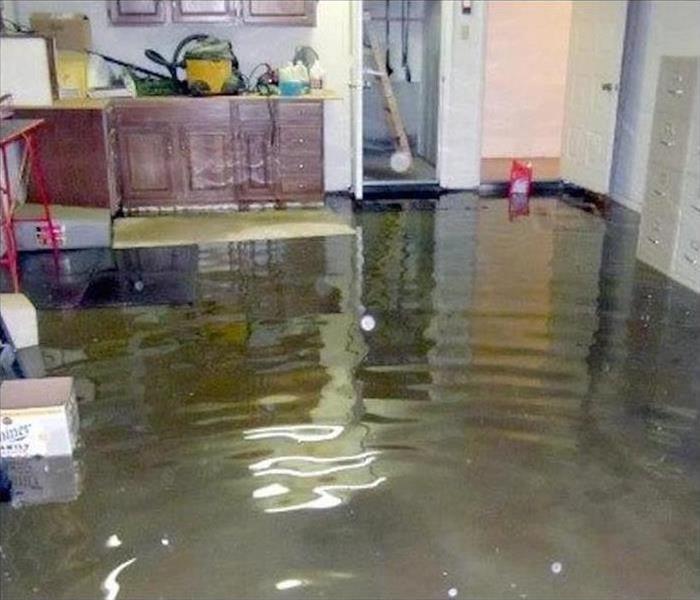 Prevent water damage in your St. Charles home.
Prevent water damage in your St. Charles home.
There are many ways to help protect your St. Charles home from water damages. Water losses occur when water finds its way outside of the appliances you rely on to run your household’s daily needs. When we think about the causes of severe water damage to our homes, we usually think about extreme weather like a hurricane or torrential rains. But the unfortunate reality is that extensive damage is often the result of ordinary household plumbing systems and appliances that fail – and these can be just as destructive to your home as an extreme weather event.
Preventative Measures
Fortunately, there are steps that you can take to help prevent water damage from plumbing problem in your St. Charles home. It is helpful to understand some of the common causes of water damage.
These may include:
• Heating and air-conditioning systems
• Water heaters
• Valves
• Appliances
• Pipes and plumbing fixtures
How to Detect Water Damages
Water damage can often go undetected, even if the telltale signs are there. Plumbing that is housed inside the walls of your home, in less-trafficked areas like a basement or attic, or behind a cabinet or appliance, can easily go unnoticed. That’s why it’s important to check your appliances and plumbing from time to time.
- Know where the main water supply enters your home, locate the main shut-off valve and make sure it’s functioning properly.
- If you will be away from home for an extended period, consider shutting off the water supply, but consult with a heating professional first to understand if doing so will compromise any other systems in your home. Maintain a temperature of at least 55 degrees in your home. Also, if your home is protected by a fire sprinkler system, do not turn off the water to this system, and maintain sufficient heat to prevent a freeze-up.
- Consider having your air-conditioning system inspected regularly by a professional. Check around the unit for indications of leaks. Check the drain lines annually and clean them if they are clogged. Change the air filter annually at a minimum.
- Inspect water heaters, showers, tubs, toilets, sinks, dishwashers, refrigerators and washing machines annually, and have them repaired if there are signs of leaks or corrosion. Be sure to include supply lines, hoses, connections and fittings in the inspection.
- Check caulking around showers, bathtubs, sinks and toilet bases, and make repairs as needed.
- If your refrigerator has an ice machine or water dispenser, check the hose between the wall and the refrigerator to determine if it is pinched or stressed. Also look for signs of leaking or wear and tear.
- Check exposed plumbing (pipes, valves, etc.) for signs of leaking or corrosion. Have any pipe damage fixed immediately to prevent more costly repairs in the future.
For any questions or concerns about water damage in your home, call SERVPRO of St. Charles at (636) 442-0847
Water damage due to a plumbing issue in your home can be life-changing. But there are some common signs that homeowners can look for, and steps they can take, to help avoid a major water issue at home.
Consider this example:
A homeowner and his family head off for a three-week vacation. While they’re away, a minor toilet leak grows, until it reaches a pace of three gallons of water per minute. By the time the homeowners returned from their three-week vacation, the unaddressed leak had poured more than 30,000 gallons of water into their home. The water ruined furniture, fixtures and irreplaceable family valuables, and rendered the property virtually uninhabitable for an extended period of time.
But this is just a cautionary tale. The following guidance is meant to help you learn about the potential water issues from common plumbing problems and how you can take steps to help prevent disaster.
Causes For Plumbing Problems
Plumbing issues can occur anywhere in your home. Frequently, lack of maintenance is the root cause of these problems. However, other causes can include:
- Manufacturing and design defects.
- Installation errors.
- Exposure to cleaning products (for example, by storing chemicals under the sink or by cleaning surfaces of plumbing components).
If caught early, many plumbing problems can be addressed before serious damage occurs. For this reason, regular inspection of your home’s visible plumbing parts can be critical. Knowing the lifespan of parts and appliances is also important, as is properly maintaining the other parts of your home and its features and systems.
Signs to Look For
Want to help prevent plumbing complications from damaging your home and potentially resulting in expensive property damage or loss? Start by visually inspecting your plumbing on a regular basis. Look for drips and slow leaks. Be sure to check the areas surrounding your pipes as well. If you see water damage on cabinetry or other nearby materials, there may be an active leak that you’ll want to locate.
Your entire home plumbing system may not be visible, but there are certain places in your home where you can readily inspect plumbing components:
- Under sinks and washtubs.
- Inside access panels near showers, sinks or appliances.
- Attachments to toilets, water heaters and appliances.
- Basements and crawl spaces.
You will want to look at any piping, valves and fittings in the areas listed above. Leaks are most common at connection points, so pay close attention to the plumbing connections on faucets, washing machines, refrigerators, dishwashers, water heaters, water filtration systems, shut-off valves and toilets. Your home’s piping system may also have multiple connections between various sections of pipe. Appliances and fixtures themselves can cause problems, so be sure to inspect those as well, and keep up with any regular maintenance recommended by the manufacturer.
The signs of a problem will vary by component. For example, problems in copper piping may look very different from problems in PEX, a common type of plastic piping. In general, you want to look for signs of corrosion, cracking, hazing, discoloration and mineral deposits from a water leak.
For any questions or concerns about water damage in your home, call SERVPRO of St. Charles at (636) 926-0033.
Why You Should Check Your Sump Pump At Least Once Per Year
2/21/2023 (Permalink)
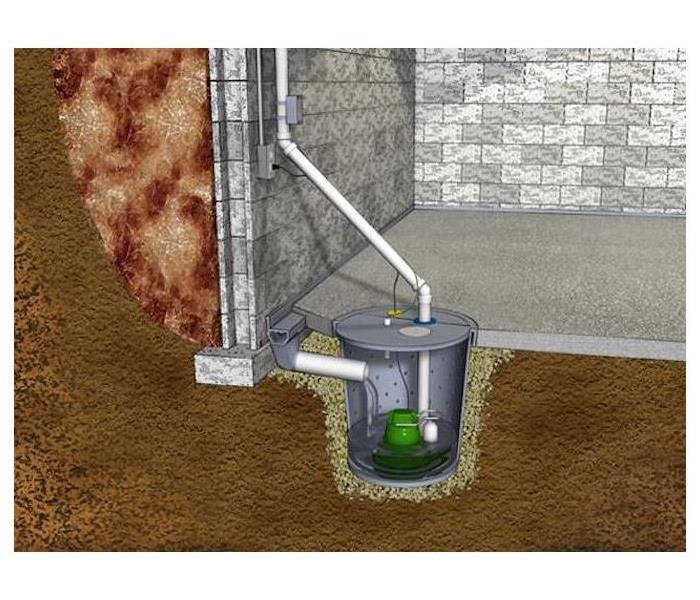 Inspect your sump pump at least once a month.
Inspect your sump pump at least once a month.
A sump pump is a vital component of your home's equipment.
Sump pumps help keep your property safe by controlling water and keeping your home dry. Often found in basements, sump pumps are typically professionally installed in a specially constructed sump pit. When the water table around your home is high, your sump pump can help keep your basement dry and can minimize damage to your home if you experience a plumbing or appliance leak. As a homeowner, you'll want to maintain your sump pump to make sure it's working properly.
The sump pump's job is to pump water outside and away from the home. To help keep it functioning properly, your sump pump needs regular maintenance. Here are some tips to help make sure your sump pump stays in good working condition.
How to Help Keep Your Sump Pump in Good Condition
- Check the pump at least once a year:
• Is the sump pump plugged in?
• Is the power cord in good shape?
• Is the discharge hose connected properly?
• Is there any debris in the area that could clog the pump and prevent it from working properly?
To check if your sump pump is functioning properly, pour water into the sump pit. Look for the sump pump to start up automatically and whether the water drains quickly.
- Since sump pumps run on electricity, consider installing a battery backup to help ensure yours will not fail, even in the event of a power outage. If you have installed a battery backup, during your test of the sump pump installation, unplug the pump to ensure that it will function properly on battery power.
- Find the location where your pump discharges outside your home. Make sure that the discharge will not occur near your foundation, and that the area is clear of any debris. Do not discharge your sump pump into a septic tank or sewer system. Contact a licensed professional if you need help locating where your sump pump discharges.
- Promptly contact a licensed professional if your sump pump is not working properly.
Biohazard Cleanups in St. Charles, MO
2/6/2023 (Permalink)
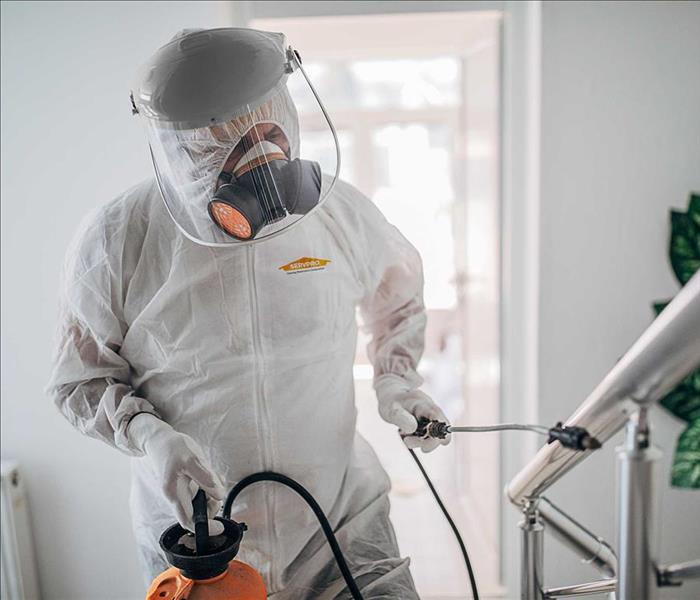 A SERVPRO technician works on a biohazard job.
A SERVPRO technician works on a biohazard job.
When people hear the term “biohazard”, they may ask themselves what this means. SERVPRO of St. Charles can save you from doing extra work researching this term. Let's help you learn about the basics of biohazards, give you some examples, and explain the importance of a proper clean up.
The Importance of Biohazard Cleanup
First of all, it’s important to recognize that biohazards need to be eliminated as soon as possible. If not eliminated, human feces and other biological waste can present an unsafe environment for people. Biohazards are transmissible in a number of ways, including the obvious form: touch. When you touch a dirty surface, like a sink that has not been cleaned thoroughly or often enough, you can contact biohazards. Certain biohazards can be ingested (eaten or drank in liquid form), inhaled, or shared in blood-to-blood contact (if biohazards enter an exposed wound, for example). The latter is possibly the most dangerous.
What Is a Biohazard?
Essentially, a biohazard is a disease or pathogen spread from a living organism (i.e. animals and humans) that is dangerous when ingested. To present a scenario, imagine a bathroom in an office space. This room in an office is in use every day of the week. People expose themselves to the toilets and sinks when utilizing bathrooms. Let’s say the bathroom is never cleaned thoroughly, and an employee uses an unsanitary bathroom. In this case, an employee is at a major risk of developing a disease from a biohazard.
However, biohazards are nearly always dangerous. Here are some common examples of biohazards, including materials you may not realize fall into this category.
Bloodborne Pathogens
While blood is essential to maintain the life of a person or animal, it produces the opposite effect when it escapes the body. To present another scenario, a crime could occur inside a home, leaving unsafe bloodborne pathogens and other bodily fluids in the building. After a crime scene investigation is finished, let’s say that the building is never cleaned afterward. If this were to happen, people would not be able to use the building and it would be called biohazardous. The reason is that blood contains what is known as bloodborne pathogens.
Examples of these pathogens include HIV, HBV, and many other types of harmful diseases. In this same scenario, if a homeowner tries to remove blood and other bodily fluids themselves, they are at a high risk to develop this disease. They can ingest these pathogens from these pathogens entering their body. How could this happen? Let’s say a homeowner has a cut or broken skin still healing; their chances of exposure are very high if bloodborne pathogens are exposed to their skin.
Animal Feces
Finally, human fluids and blood are not the only type of biological hazard that could pose a risk of someone developing a disease in their body. If a person owns a pet in their home, the dog or cat may remain inside for many hours of the day. What can happen, especially when domesticated pets, is that they leave feces or other animal fluids on the floor at any time of the day. It is important to monitor your pets throughout the day to spot an occurrence like this.
This is because animal feces, as mentioned before, presents a biohazard to a home if left unattended. Over time, if not cleaned, the odor and feces begin to accumulate in the home. If left unattended, the home can be uninhabitable for a homeowner or anyone else interacting with the house. That is why a biohazard cleanup is essential to combat the chances of this occurring.
When your home or office space is exposed to biohazards, you can rely on our professional bio-cleaning services at SERVPRO of St. Charles. To learn more about what we do, you can send us an inquiry or call us at (636) 926-0033.
Hoarding Cleanup in St. Charles
2/3/2023 (Permalink)
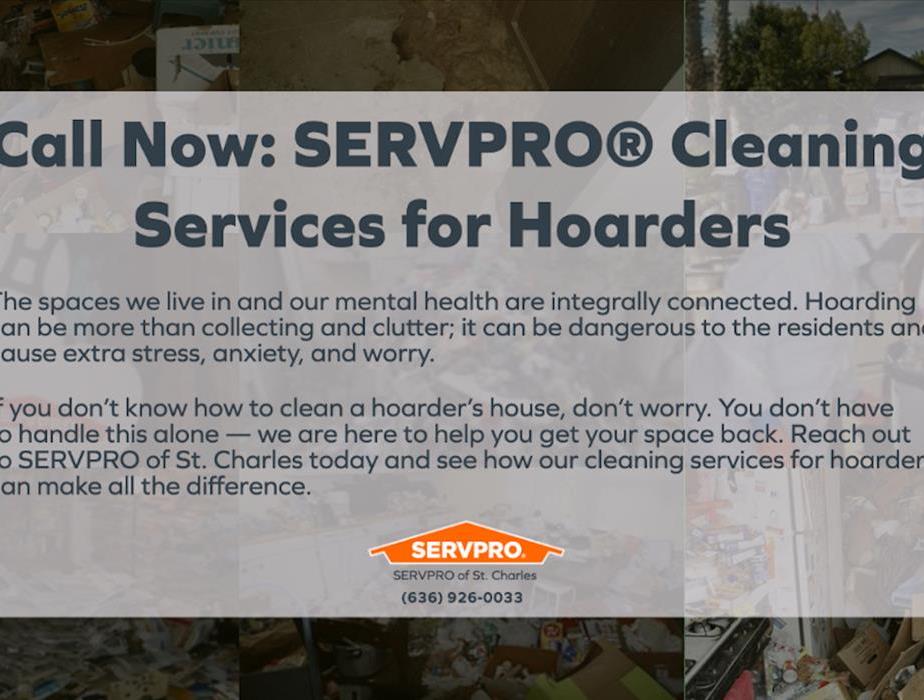 Call SERVPRO of St. Charles for hoarding cleanup solutions
Call SERVPRO of St. Charles for hoarding cleanup solutions
When faced with a hoarding cleanup in St. Charles, effective communication with the hoarder is crucial for progress. Saying or doing the wrong thing may shut down communication and halt progress. Hoarding is a serious issue, and it should be handled with care and patience. It's important to understand the condition before addressing it to help with communication and the cleanup process.
The following "Do's and Don'ts" guide can serve as a general reference, but if you need further guidance, don't hesitate to reach out for more specific advice.
Do's:
1. Connect with the hoarder: Empathize with the hoarder and let them know you'll be there for them throughout the entire cleanup process.
2. Seek professional help: Therapists who specialize in hoarding can provide more specific guidance.
3. Continuously communicate with the hoarder: Follow up on the situation to keep the hoarder motivated.
4. Discuss safety first: Reorganizing can create a safer living environment, so bring this up before discussing the removal of items.
5. Acknowledge the importance of items: Items have an emotional connection to hoarders, so approach them as important.
6.Keep the situation confidential: Promise not to discuss anything related to the hoarder's situation without their permission.
7. Ask questions respectfully: Understand the hoarder's reasons for keeping items, as they may have had a traumatic experience.
8. Promote donation: Let the hoarder know that their items will be put to better use by someone who needs them.
9. Be patient: The process should be taken one step at a time.
10. Hire a professional cleaning service: This can help the relationship with the hoarder and ensure items of value are preserved.
Don'ts:
1. Don't judge the hoarder or make assumptions about their situation.
2. Don't discard any items without the owner's permission.
3. Don't force the hoarder to get rid of items they are attached to.
4. Don't ignore any health or safety hazards, such as mold, pests, or fire hazards. Call professionals immediately.
5. Don't ignore any legal requirements, such as obtaining proper permits or disposing of hazardous materials.
6. Don't pressure the hoarder to clean up all at once, as this can be overwhelming and lead to a relapse.
7. Don't try to clean it all by yourself, especially if the clutter is overwhelming.
If you are in need of a hoarding cleanup, call the professionals at SERVPRO of St. Charles (636) 926-0033.
SERVPRO of St. Charles City Commercial Restoration Services
1/31/2023 (Permalink)
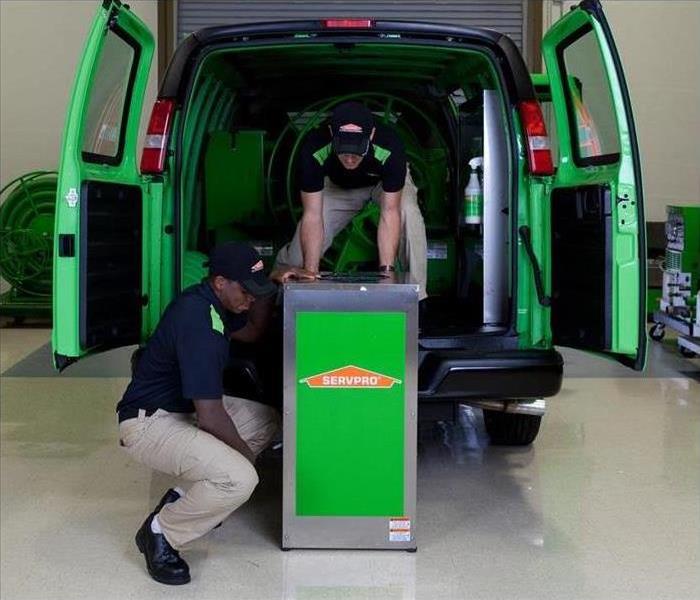 SERVPRO of St. Charles City helps with all your commercial restoration service needs.
SERVPRO of St. Charles City helps with all your commercial restoration service needs.
SERVPRO of St. Charles City offers many different services that we offer for commercial properties. We understand that it is difficult at times to schedule services during business hours, so we can work with you to find a time that best fits you and your company's needs.
If needed we can work in one section at a time in order to keep your business open while we work, or we can attempt to schedule it before or after business hours.
In addition to our emergency water, fire, and storm clean up services we also offer many other cleaning services. These include, but are not limited to:
- Air Ducts and HVAC
- Biohazard
- Carpet and Upholstery
- Ceilings, Floors, and Walls
- Drapes and Blinds
- Odor Removal
- Sewage
- Trauma and Crime Scene
- Vandalism
FIRE DAMAGE
The faster SERVPRO of St. Charles City arrives on-site to perform fire, smoke, and soot cleanup and restoration, the better the results— including lower claim costs.
Within four hours of a loss notification (and usually much earlier), SERVPRO of St. Charles City will be on-site to help ensure a fire damage is handled properly by utilizing the following services:
Structural Cleaning
After a smoke or fire damage, ceilings, walls, woodwork, carpeting, and floors will often need a thorough cleaning. SERVPRO® will pretest to determine the extent of damage, then use the specific equipment and cleaning products required to clean and protect the different types of surfaces found within the structure.
Contents Cleaning
All the restorable contents in the affected areas will be professionally cleaned and deodorized. This includes area rugs, furniture, draperies, and upholstery. SERVPRO can provide wet or dry-cleaning services. Additionally, all other restorable contents will be cleaned and deodorized to preloss condition. This includes electronics, art, wood furniture, kitchen items, clothing, bedding, and much more. Finally, SERVPRO of St. Charles City can provide an inventory list of all “to be claimed” items.
Deodorization
SERVPRO of St. Charles City provides specialized services that rid your insured’s home or place of business of offensive odors left behind by fire or smoke damage. We do not merely cover up lingering odors with a fragrance; we seek out the sources of the odor and remove them.
WATER DAMAGE
If you have recently become a victim of commercial water damage, you may be wondering what you can do to mitigate your damages. There is a critical period in which certain actions must be taken to preserve as much of your property as possible and to decrease any health risks when water damage has occurred in a commercial space.
Preparing a Space for Water Damage Restoration
Before you enter your commercial space or any flooded building, you will need to make sure the electrical power to the structure is shut off. You should also be aware that during a flooding event, small animals or reptiles tend to seek shelter inside of buildings. Be prepared to deal with the discovery of wild animals in your space.
Protect yourself from entering any flooded building by wearing an organic vapor respirator. You can purchase these at any local paint and building supply stores. You also want to have rubber gloves, protective clothing, and eye protection. The first thing you should do is ventilate the affected areas by opening the windows and placing fans where possible.
Unfortunately, there likely will be items that you need to throw away. Any items that are porous and have absorbed contaminated floodwater cannot be restored. If your commercial space has drywall, mattresses, pillows, box springs, particle board, carpets or carpet pads, these will need to be discarded if they have become saturated. However, there is good news: If you have clothing or household fabrics that can be machine-washed, you may be able to salvage them. Use your washing machine to clean these items with a 10-minute soak at the minimum in hot water with detergent. The soap and normal wash should remove most of the contamination and any staining that is present.
Be aware that your commercial space will need a thorough professional inspection, cleaning and possibly restructuring. Water damaged walls and installations must be removed and repaired, and pockets of saturation should be exposed for drying and sanitizing. Always remember that mold growth could take a few days to appear as it thrives in a moist environment with organic-type materials such as paper or particle board and in temperatures that range between 60 and 86 degrees Fahrenheit. Keep good airflow throughout the interior environment, and maintain moderate temperatures to decrease the risk of any mold growth. It is also important that you let your space dry out before any rebuilding occurs.
If you would like more information on any of the services listed above, please call SERVPRO of St. Charles City at (636) 926-0033.
5 Winter Home Heating Safety Tips
1/17/2023 (Permalink)
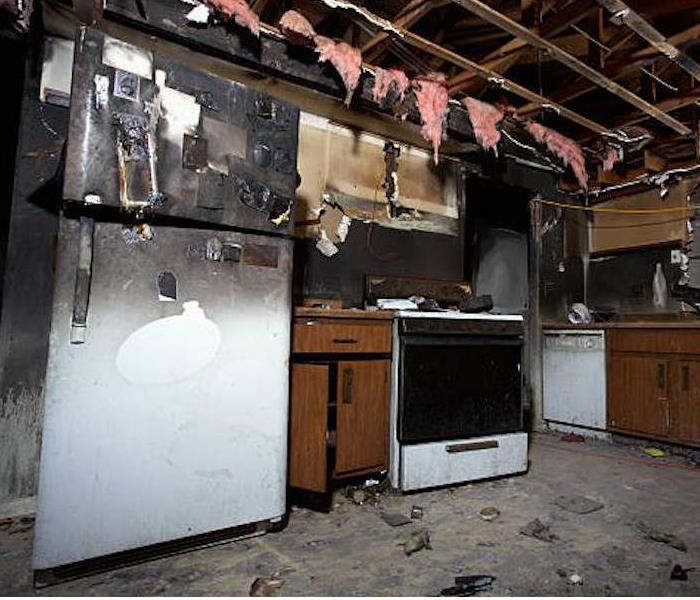 Preventative measures can help avoid a winter fire.
Preventative measures can help avoid a winter fire.
1. Be Aware of Flammable Materials
Keep anything that burns easily at least three feet away from fireplaces, wood stoves, furnaces and space heaters. Fires often spread past its origin point because the heat source was too close to something flammable. Make sure nothing is close to your heat sources to prevent a fire from spreading.
2. Service Your Heating System Annually
Hiring a professional to inspect and clean your heating system and chimneys can help ensure your safety. These checks should be done annually. You should also be active in checking the areas around the furnace and boiler.
3. Don’t Leave Space Heaters Unattended
25,000 house fires and more than 300 deaths are caused each year by space heaters. Never keep space heaters on when no one is around or while you are sleeping. Space heaters should be plugged directly into a wall, as extension cords or power strips can overheat and cause a fire.
4. Test Smoke and Carbon Monoxide Detectors Monthly
According to a study by the federal Centers for Disease Control and Prevention, the first month of the year is the worst for carbon monoxide poisoning. House fires are also common after the holidays. It’s extremely important to regularly check that all your detectors have working batteries.
5. Fireplace Safety
Keep a screen over your fireplace to stop sparks from flying out. Let fire ashes cool before putting them into any covered, metal container. Also, ashes should never be kept in plastic containers. Keep all containers of ashes a safe distance away from your home.
How to Prevent Ice Dams
1/17/2023 (Permalink)
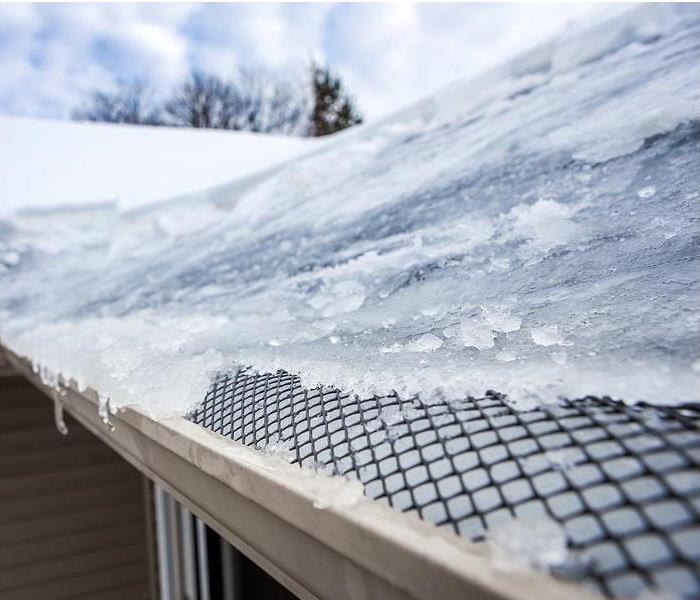 Ice dams can cause damage to your home.
Ice dams can cause damage to your home.
Icicles hanging off the edge of the roof can be beautiful scenery on a winter day, but those frozen crystals can cause some ugly problems for your home.
Icicles are formed by the combination of snow-covered roofs and freezing weather. These conditions are what leads to ice dams—a ridge of ice that forms at the edge of the roof that prevents melting snow/water from draining.
Dams can be a real pain in the ice. They can tear off gutters, loosen shingles and cause water to back up, resulting in water pouring into the house. This can lead to paint peeling, floors warping and ceilings getting stained and sagged.
Moisture entering the home from ice dams can also cause respiratory issues for your family, resulting from mold and mildew growth.
What can be done to prevent these damn...err..dams?
Clear the Roof
Instead of waiting for warm weather to solve the problem, you can take matters into your own hands.
The first short-term move is to stop any leaking.
You can set up a box fan in the attic and aim it at the bottom of the roof where water is leaking in. This will freeze the water and stop the leak.
Another effective move can be taking a long-handled aluminum roof rake to scrape off snow.
You can also de-ice your roof with pantyhose.
Seriously.
By filling the leg of a pair of panty hose with a calcium chloride ice melter, you can melt through the ice and snow to create water flow. Lay the hose so it crosses the ice dam and overhangs the gutter.
Uniform Roof Temperatures
Ice dams are caused by nonuniform roof surface temperatures.
For dams to form, the top of the roof must be above 32 degrees, while lower surfaces are below freezing.
When the snow on the top of the roof melts, water flows down to the bottom of the roof and freezes, creating the dam.
In most cases, the reason for the lack of uniform roof temperatures is due to heat from the house warming the roof.
One way to reduce heat escaping is by adding insulation. This will make the top surface temperature of the roof closer to surrounding attic temperatures, creating more uniformity.
This step should come after making the ceiling air tight so that no warm, moist air can flow from the house into the attic. For an unsealed attic hatch or whole-house fan, you can use weatherstripped caps made from foil-faced foam board held together with aluminum tape.
Heating cables can also create uniform roof temperatures. By heating the roof from the outside instead of blowing in cold air from the inside this tactic can equalize your roof’s temperature.
More Solutions
There are several other tactics you can take to solve your ice dam issue.
Double check that the ducts in your house connected to the kitchen, bathroom and dryer vents all lead outdoors through the roof or walls, but not through the soffit. Seal and insulate ducts by spreading fiber-reinforced mastic on the joints of HVAC ducts and exhaust ducts, and cover them with R-5 or R-6 foil-faced fiberglass.
Use caulk to seal around electrical cables and vent pipes with a fire-stop sealant. You should also look for spots where light shines up from below or the insulation is stained black by dirt.
Recessed lights should be replaced with insulated contact (IC) rated fixtures, as old-style lights can’t be insulated without creating a fire hazard.
Bridging the gap between the chimney and house framing with L-shaped steel flashing that’s kept in place with unbroken beads of a fire-stop sealant is another possible remedy.
Winter Weather Hazards
1/3/2023 (Permalink)
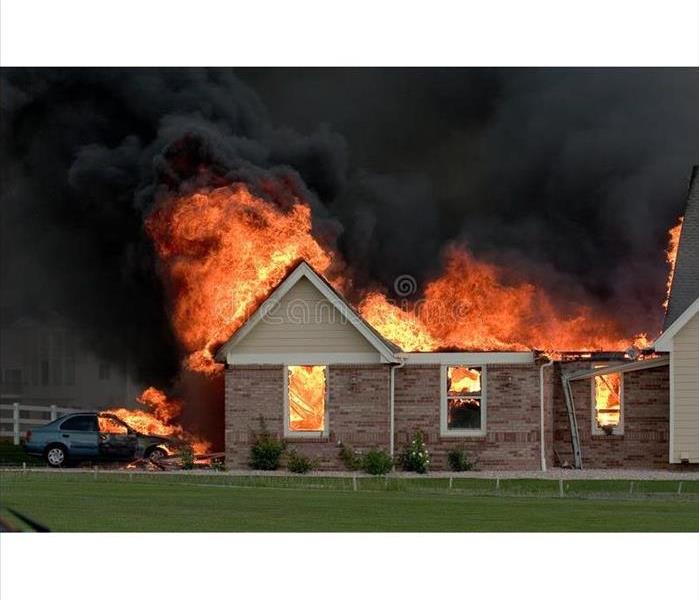 Winter fires generally take place in the kitchen or from heating systems.
Winter fires generally take place in the kitchen or from heating systems.
Winter weather leads to issues for thousands of people and their homes each year. Since cold weather can cause issues that don’t occur the rest of the year, it’s important to be vigilant about any problem that could arise.
Here are some potential problems that should be on your radar this winter.
1. Heating System Fire
While most winter fires take place in the kitchen, heating systems can also be a culprit. Thousands of residential fires occur each year due to failure of home heating systems. Fireplaces, chimneys and chimney connectors are responsible for half of the fires. That’s why it’s important to have your heating system checked regularly, especially if you have a gas or electric furnace or heat pump.
Space heaters also cause many fires in the winter, and in total cause 25,000 per year. Space heaters should never be left on unattended, especially after going to sleep.
Being aware of the potential hazards of your heating system can keep you fire-free this winter.
2. Frozen Pipes
Pipes freezing and bursting can be a nightmare for your home.
Frozen pipes cause an estimated $400-$500 million in damage annually. To avoid adding to that number, it’s crucial to take preventive measures. Drain water from pipes that are likely to freeze and disconnect any outside hoses.
If you are still worried that your pipes might freeze, you can also place a 60-watt bulb in areas you’re concerned with. Just make sure none of the materials near the bulb are combustible.
To keep pipes from freezing, your thermostat should be kept around the same temperature at all times, and your house temperature should never fall below 55 degrees.
3. Ice Dams
While ice dams can be pretty to look at, they can be a nuisance to deal with. Since ice dams are caused by a lack of uniform roof surface temperatures, this problem must be addressed if you are experiencing ice dams. Making your ceiling and attic air-tight, adding insulation and installing heating cables to the roof are all steps that can create uniform temperatures.
If you are already dealing with ice dams, you can take a long-handled aluminum roof rake to scrape off snow from the roof. And if you’re experiencing leaking, you can set up a box fan in the attic and aim it at the bottom of the roof where water is leaking in. This will freeze the water and stop the leak.
4. Carbon Monoxide
Cold temperatures can often lead to problems with carbon monoxide in the home. Sadly, 430 people die annually from carbon monoxide poisoning, while approximately 50,000 are hospitalized.
Carbon monoxide poisoning occurs due to faulty heating systems. Whether it’s unvented space heaters, malfunctioning furnaces, clogged chimneys or other heating system issues, it’s important to make sure your system is functioning properly.
That’s why you should have your furnace and fireplace inspected before each winter. In addition, carbon monoxide detectors should be installed in your home (if you don’t already have them), and the batteries should be checked and replaced regularly.
Also, make sure that if you’re going to use space heaters they are properly ventilated.
How SERVPRO Spells Help
1/3/2023 (Permalink)
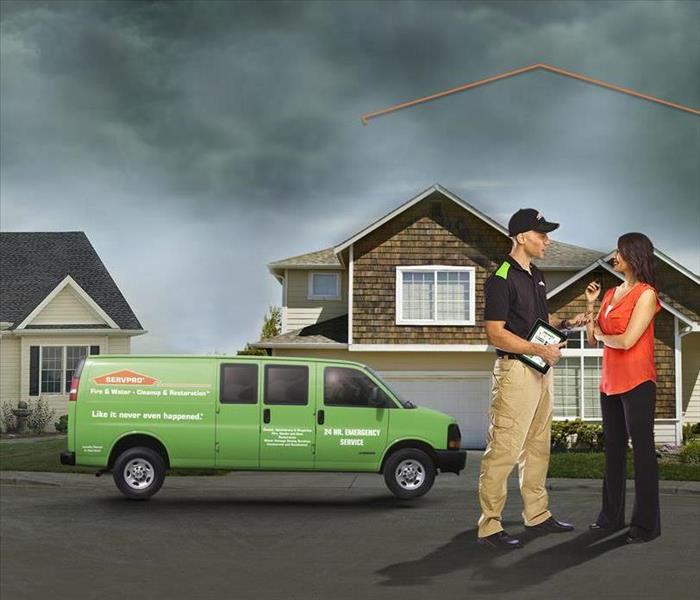 SERVPRO of St. Charles is here to help.
SERVPRO of St. Charles is here to help.
You forgot about the chicken dinner on the stove, filling the house with smoke. The water pipe breaks flooding the entire basement. A roof leak has caused mold in your attic space. The fire sprinkler bursts, saturating the floors of your warehouse.
We all need help at some point in time. Help to clean the smoke off the walls and remove the odor. Help to extract the water and dry the structure. Help to safely remove the mold in your attic. Help to dry out your warehouse and get you back to work.
This is how we spell help:
S is for the Service that we provide. 24 hours a day, seven days a week. We are always here to help.
E is for the Expert advice that we offer. We are your expert Fire & Water Clean Up and Restoration company.
R is for the Resources that we can bring to every job. Air movers, dehumidifiers, air scrubbers, drying mats, duct cleaning machines, carpet cleaning machines. Residential and commercial. Whatever your job demands.
V is for Value. We value our customers and it is truly an honor to serve you.
P is for the Professionalism that we bring to every job. We are always prepared. Our highly trained staff is here to “Make it like it never even happened”.
R is for being Ready for any sized disaster. Our crews are on call and always ready to answer the call when needed.
O is for the Outstanding work that we provide. Our work is certified, warrantied and performed by IICRC trained technicians.
SERVPRO of St. Charles is always here to help!
Water Damage Prevention Tips
11/17/2022 (Permalink)
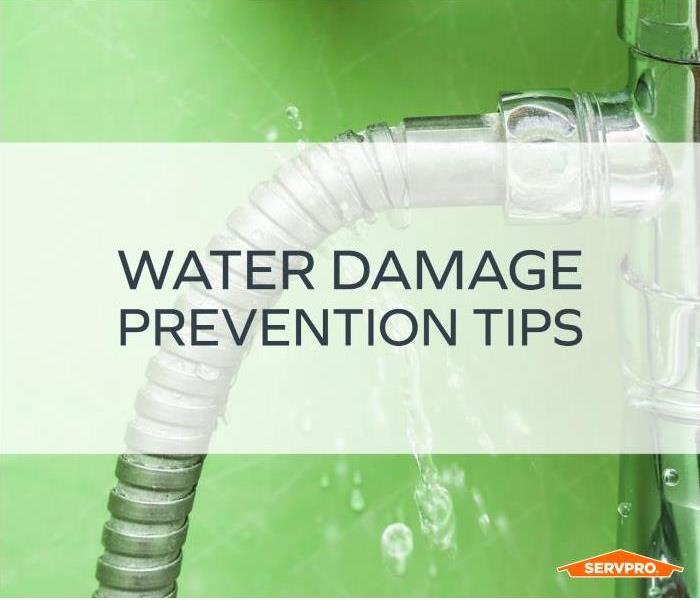 Don't wait. If you have water damage, contact SERVPRO of St. Charles.
Don't wait. If you have water damage, contact SERVPRO of St. Charles.
Ignoring water damage in your home can be a costly mistake. Knowing what to do to avoid water damage can protect your investment.
Here are a few ways you can avoid water damage in your St. Charles, Missouri home:
- Older wood windows should be cleaned, repainted, and re-stained periodically. Glazing compound around older windows should be replaced as needed. Update your windows and doors. Watertight options are best in new windows and doors.
- Replace washing machine supply hoses. Plan for new ones every three to five years as part of a proactive maintenance plan.
- Regularly check your roof for signs of damage, such as excessive wear on shingles or missing shingles.
- Use gutters and downspouts to make sure water is diverted away from your home and its foundation. In some cases, it is necessary to update of repair drainage.
- Test your sump pump twice a year or as suggested by the manufacturer.
- Much home piping has a lifespan of 50 to 80 years, so if you have an older house, ask a plumber to check its condition. PVC pipes may need to be replaced every 25 to 40 years.
- Seal your basement. Thick coatings, paint and silicate-based sealers may help minimize or prevent water damage. Each method varies in application and cost.
Even minor plumbing problems can turn into major issues down the road. Mold and mildew can create the ideal conditions for harmful bacteria and fungus to start growing and eventually cause a myriad of health problems for your family, including young children and family pets.
If left unchecked, water leaks will cause more damage to your home or business, which is why they need to be addressed the instant you notice them.
Water Damage? Contact SERVPRO of St. Charles at (636) 926-0033.
Protect Your Investment from a Mold Lawsuit
10/13/2022 (Permalink)
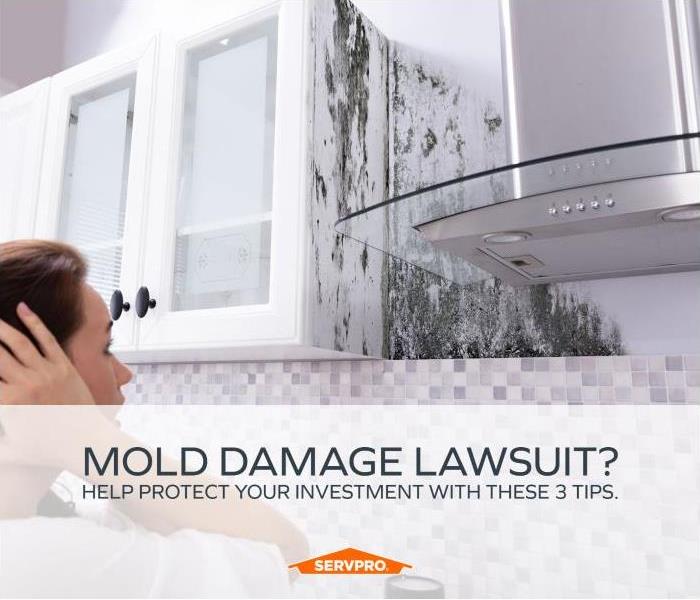 SERVPRO has the training, experience, and equipment to contain the mold infestation and remediate it to preloss condition.
SERVPRO has the training, experience, and equipment to contain the mold infestation and remediate it to preloss condition.
As a commercial property manager in St. Charles, MO, you have certain responsibilities when it comes to issues of mold in the buildings that you manage.
Mold can be a touchy subject because mold insurance claims tend to be imprecise. Many insurance companies have riders that exclude certain types of mold damage so you must have a secondary insurance plan of some sort.
Here are three reasons why you as a property manager could face a mold damage lawsuit. Understanding the possibilities will help you to ensure that you have the proper coverage.
- Property Damage
If it is discovered that mold has damaged the tenant's property or products, the mold claim will likely be over who is responsible for paying for damages and how much things are worth. One way to avoid this issue is to have the building inspected before you rent it and come to a formal, written agreement with the tenants about who is responsible for what in the event of damaged property. - Commercial Fitness
Commercial buildings don't have to be inhabitable the way residential buildings do, but they do have to allow for the intended business to function. If a tenant feels that the building is no longer fit for its intended use, then lawsuits over mold insurance claims could result. - Prevention and Remediation
Preventing mold growth and remediating existing mold are probably the most common reasons that property managers could find themselves involved in a lawsuit. Mold prevention looks like responding to concerns about leaks and dampness while remediation is about repairing an existing problem.
Especially if you've agreed with your tenant about who is responsible for what aspect of mold remediation and prevention, keeping up your end of the bargain and maintaining good records will help when faced with a legal dispute. When in doubt, hire a professional mold remediation specialist such as SERVPRO of St. Charles to provide an assessment.
It’s important to know what responsibilities you have and how to prepare for them. It is also important to know who to call when disaster strikes. SERVPRO of St. Charles City can respond quickly, working to first contain the infestation to help prevent its spread to other parts of the building. Next, we will begin the remediation process, working safely and effectively to manage the situation. We have the training, experience, and equipment to contain the mold infestation and remediate it to preloss condition.
Have a Mold Problem? Call Us Today – (636) 926-0033
3 Fire Extinguisher Tips for Business Owners
9/7/2022 (Permalink)
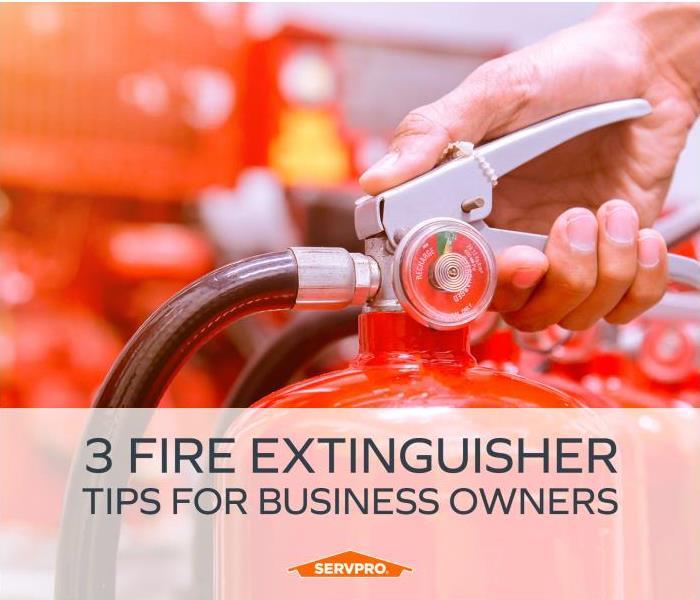 A fire extinguisher can protect your staff and property in St. Charles, MO.
A fire extinguisher can protect your staff and property in St. Charles, MO.
Keeping a fire extinguisher at your commercial property in St. Charles, Mo is a wise choice and also a requirement. According to the Division of Fire Safety, all commercial buildings are required to have a minimum 2A*10B*C rated fire extinguisher within 75 feet of all points of the building(s). Stairs may not be used as a path to an extinguisher. Typically, one 2A*10B*C extinguisher can serve a maximum 3,000 square foot area. Some operations and facilities have more stringent requirements.
In an emergency, effective use of the device reduces potential fire damage and protects staff.
Consider the following three tips:
Purchase the Right Extinguisher
Do your homework before going shopping. Look into local fire code ordinances to determine how many devices you need for your property based on the square footage. There are also different classes of extinguishers depending on possible hazards at your place of business.
- Class A – Paper, cloth, wood
- Class B – Flammable liquids such as gasoline
- Class C – Electrical fires
- Class D – Metals including lithium, titanium, and magnesium
- Class K – Cooking oils or grease in a kitchen fire
Train Staff on Correct Usage Techniques
It is not enough to have a fire extinguisher present; employees must be trained on proper usage. Extinguishers are most effective on small fires in the early stages. For portable extinguishers, the PASS method is an easy way to teach and learn.
- Pull – Remove the pin
- Aim – Point the nozzle at the bottom of the flames
- Squeeze – Maintain pressure on the handle to activate the device
- Sweep – Move the device from side to side towards the fire.
Plan for Fire Emergencies
Extinguishers are part of a more comprehensive safety plan. In the case of a fire emergency, there are other considerations for both staff safety and minimizing fire damage.
- Evacuation – Practice procedures, exit routes and roles
- Supplies – In addition to extinguishers, have disaster supply kits on hand
- Hazards – Map potential onsite hazards, such as combustibles
- Insurance – Obtain coverage through a commercial insurance company
- Recovery – Have contact information readily available for a fire restoration company like SERVPRO of St. Charles.
A fire extinguisher is a smart way to protect your staff and property in St. Charles, MO, in the event of a fire emergency. Prepare ahead of time by purchasing the appropriate device, training staff, and knowing what to do during and in the aftermath of a fire.
If you experience a fire, SERVPRO technicians are trained to address small and large fire damage projects. We are IICRC certified and have the experience to tackle difficult problems. Our team is ready to serve businesses and families in the greater St. Charles area including St. Peters, O’Fallon, Weldon Spring, and Portage Des Sioux.
Call us and let us help you, (636) 926-0033
Source: Missouri Division of Fire Safety (mo.gov)
Commercial Water Damage in St. Charles, MO
8/23/2022 (Permalink)
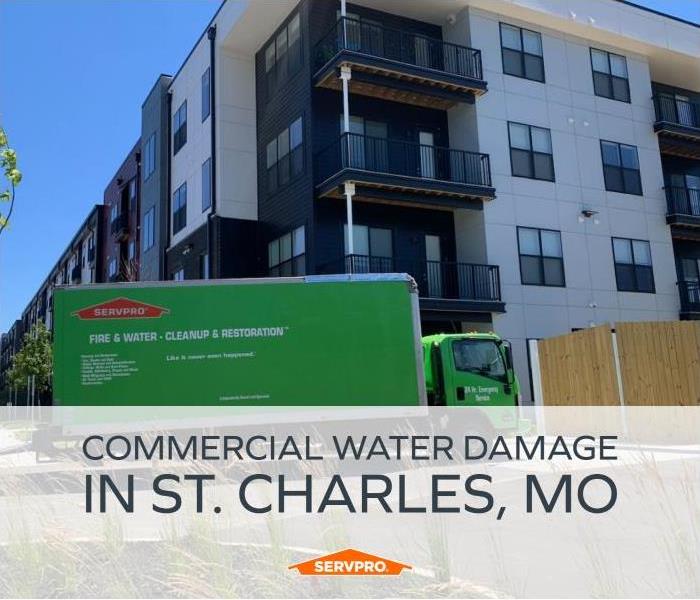 When you call, we answer the phone - ready to help. Fire and water emergencies don't wait for regular business hours and neither do we.
When you call, we answer the phone - ready to help. Fire and water emergencies don't wait for regular business hours and neither do we.
Whether it’s the aftereffect of a sudden storm, the result of aging pipes, or a leaky roof, water damage can strike your business at any time and have a devastating effect. To properly handle commercial water damage, St. Charles is home to a water restoration company it can trust.
Commercial Water Damage Restoration with Your Business in Mind
At SERVPRO, we know there is never a convenient time for fire or water damage to strike your business. Every hour your business is closed for restoration means lost revenue and productivity. Therefore, when you have an emergency, we’ll be there fast with the help you need.
We can handle any size job and move quickly so you can get back to business. As a local business, we take great pride in approaching each property as if it were our own and providing the quality restoration you expect.
Trust the Pros
We have staff ready to respond 24/7, 7 days a week. Our goal is to have an experienced technician at your door within four hours of your call. We will perform a full walkthrough and damage assessment. After the assessment, we will put together a plan and we’ll go over each step, so you’ll know exactly what to expect. We can also point out any unsalvageable so you can decide how to proceed and assist on filing your insurance claim. We can also provide mold remediation services, if necessary.
When you call, we answer the phone - ready to help. Fire and water emergencies don't wait for regular business hours and neither do we.
If your business suffers a major loss, call (636) 926-0033.
Mold Remediation in St. Charles After Major Flash Flooding
8/18/2022 (Permalink)
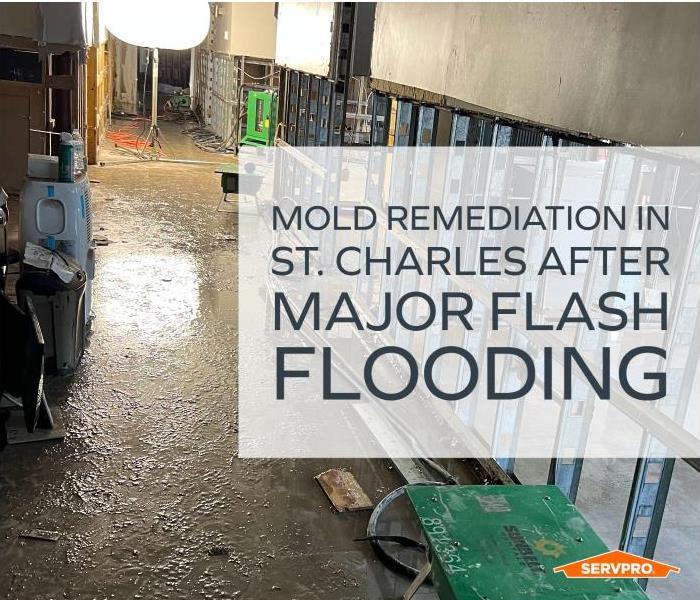 If your St. Charles, MO home or business has mold damage from the recent flash flooding or another source, we are here to help.
If your St. Charles, MO home or business has mold damage from the recent flash flooding or another source, we are here to help.
After the significant rainfall that occurred just a few weeks ago there may start to be a musty odor in your home or business. Maybe you can see mold spores starting to grow on your drywall in a dark corner of your basement. SERVPRO of St. Charles can help you remove the mold and musty odor that has invaded your property. We specialize in water and mold restoration, with advanced training in restoration techniques and experience to quickly restore your property.
How can I tell if I need mold remediation?
Unfortunately, if your home or business was impacted by flash flooding or interior water damage, mold is a likely outcome if it was not dried properly. Mold spores will thrive when given moisture and the right materials to feed on. While mold is present everywhere, indoors, and outdoors, we can restore your home or business to pre-exposure levels.
When you call SERVPRO of St. Charles, our Green Fleet to your door with skilled technicians and all the right equipment for the job. Every mold infestation is different, from the amount of mold to the types of materials affected. Each scenario requires a unique solution, but the general process stays the same. After our arrival, we will:
- Identify the moisture source to remove water and address the root cause. Failing to do so only means we leave an outlet for mold to develop again.
- Containment is put into place using sheeting and negative air pressure to keep microscopic spores from moving into unaffected areas of your property.
- We begin pulling up mold spores with the help of vacuums and air scrubbers with HEPA filtration.
- All surfaces get thoroughly cleaned, sanitized, and deodorized with the help of specialized cleaning agents and anti-microbial products.
We welcome questions and want you to feel comfortable while our technicians are repairing your property. If you want a new level of peace of mind when hiring someone for mold remediation, our skilled team at SERVPRO of St. Charles is here to help.
If You See Signs of Mold, Call Us Today – (636) 926-0033
St. Charles County Hit By 1,000 Year Flash Flood
7/29/2022 (Permalink)
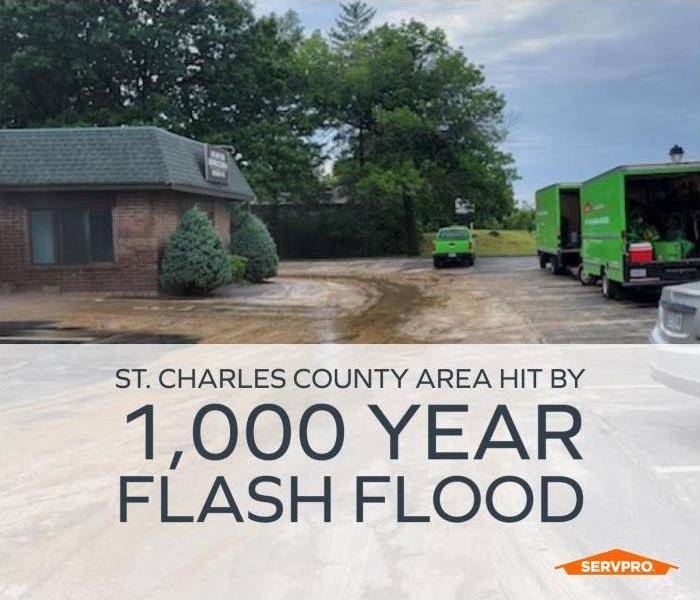 If your home or business has been affected by the recent flooding, we are here and ready to help. Give us a call today.
If your home or business has been affected by the recent flooding, we are here and ready to help. Give us a call today.
On Tuesday, July 26th, 2022, a complex of thunderstorms set up along the I-70 corridor in Missouri. Several rounds of thunderstorms with rainfall exceeding 2inches in an hour affected this area, including the of St. Peters and the surrounding greater St. Charles, MO area. Upwards of 11” of rain fell in St. Peters, MO and over 8” of rain fell in St. Charles, MO. This rainfall was one of the most significant events since records began in 1874. 7.68” of rain was received in just 6 hours, which has a 1 in 1,000 chance of occurring each year. This also accounts for 25% of the normal amount of rain for July and August combined.
A state of emergency was called Wednesday in St. Charles County. The flooding caused roads to close, homes to be evacuated and left motorist stranded. When the Dardenne Creek Levee breached north of St. Peters in the St. Charles County area, water poured across highway C flooding nearby parks such as Lone Wolff Park. Homes, apartments, and businesses have suffered major water damage. Many have had to abandon their homes and enter shelters.
SERVPRO of St. Charles City has been busy helping those affected by the recent flash floods, calling in additional help from the Disaster Recovery Team. Team Wolfe arrived with a semi full of equipment and trained water restoration technicians to help with the large influx of customers needing immediate help restoring their homes and businesses.
If your home or business has been affected by the recent flooding, we are here and ready to help. Give us a call today.
Source:
July 26th, 2022 Historic Flash Flooding in the St. Louis Metro Area (weather.gov)
St. Charles County issues a state of emergency after flooding | FOX 2 (fox2now.com)
We Are Ready if Fire Damage Strikes
7/21/2022 (Permalink)
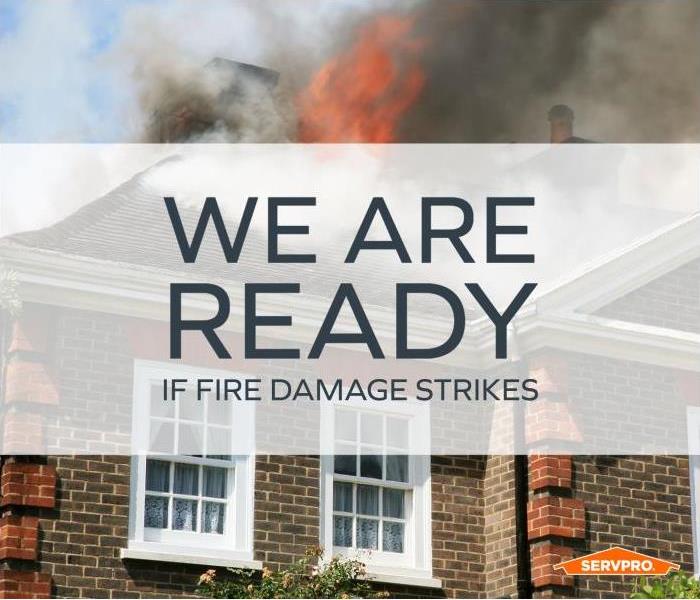 Our team is ready to serve businesses and families in the greater St. Charles area.
Our team is ready to serve businesses and families in the greater St. Charles area.
While cases where fire consumes an entire home in St. Charles, MO happen, there are many times in which the fire damage is minor. However, soot and smoke can damage the entire home, making even a small fire a disaster. You may feel hopeless and without options, but that’s not the case.
Involving a professional is the best way to reduce costs and prevent secondary damage. Depending on the type of fire, and the way it is fueled, may require different techniques. SERVPRO of St. Charles is IICRC certified and has the experience to tackle difficult problems. The level and type of damage will likely require a unique response.
Minor damages typically involve mostly smoke residue damage. The deposits are light to moderate, and restoration mostly involves a deep cleaning of the affected surfaces and fabrics. There are different techniques that are technicians use to remove the smoke odor and residue from your home. In this type, almost all the cleaning would be done onsite.
In more moderate damage situations, there will be smoke and heat damage on different surfaces. Your cabinets, drywall, and contents may have heat damage. Odors will likely be stronger at this damage degree as well. Our technicians will use varying techniques to remove items that are heavily damaged and determine what can be cleaned or will need to be replaced.
In majorly fire damaged homes, there is more severe heat damage throughout the home. Usually this is close to where the fire started, but this can leave parts of the structures framing charred. This often involves making structural repairs and gutting the heavily damaged parts of the home. Smoke damage is often heavy throughout. This requires extensive cleanup and removal of debris from the structure. Content cleaning for majorly damaged homes will need to be completed offsite.
Each fire damage situation is unique, and the process may vary depending on our customers' needs. We will explain the restoration process that is unique to your home upon onsite inspection. We are happy to answer any questions and make the process as stress free as possible.
We also provide board up services to help protect your home from additional damage during extended repair.
As soon as the fire trucks leave, give SERVPRO of St. Charles City a call. We will arrive onsite and help determine what your next step will be to reduce damage and work with your insurance company.
Our team is trained to address small and large fire damage projects. Our team is ready to serve businesses and families in the greater St. Charles area including St. Peters, O’Fallon, Weldon Spring, and Portage Des Sioux.
Call us and let us help you, (636) 926-0033
Beat the Summer Heat
7/19/2022 (Permalink)
 Think your HVAC could use a cleaning? Give us a call!
Think your HVAC could use a cleaning? Give us a call!
Summer is here, and if you’re like most people in the greater St. Charles, MO area, you’ve turned on your air conditioner to keep it cool indoors. Like all pieces of equipment, air conditioners run more efficiently in optimal conditions.
What can you to do make sure your AC is running smoothly?
You should make sure your air conditioner gets an annual tune up in the spring, but it’s not too late! A tune up can include tightening all electrical connections, checking the wiring, lubricating fans, and cleaning the system. You will also need to check the coolant levels. Having a professional inspect your unit in detail can help avoid problems during the busy summers.
Another important step to keeping your air conditioning working is simply keeping it clean! Make sure to check your air filter. Make sure to change your filter regularly.
You should also take the time to clean your ductwork. When the air conditioner turns on, fine particulates drift into the home and can lower your indoor air quality. This is also what goes back to your air filter. Have your airducts professionally cleaned to make your system be more energy efficient. Ductwork can also be leaky. Loose joints or damaged sections can allow cooler air to escape into unoccupied areas of your home.
SERVPRO of St. Charles City technicians routinely inspect the heating, ventilation, and air conditioning unit (HVAC). We will make recommendations about the best way to address any indoor air quality concerns. This can save you money and provide peace of mind on the health of your system.
For more information on HVAC and air duct cleaning, call us today.
Preparing Your Home for Vacation
7/7/2022 (Permalink)
 We provide emergency cleaning and restoration services 24 hours a day, 7 days a week.
We provide emergency cleaning and restoration services 24 hours a day, 7 days a week.
Your vacation should be worry free! That’s why it’s a good idea to prepare your home before you leave on a long trip! To prevent break-ins, try to make your home looked lived-in, for example: stopping the mail, using lights on a timer, using motion-activated outdoor lightning, and keeping your grass trimmed are all excellent ways to have that lived in appearance. If you use social media, it’s also a good idea to keep the vacation photos to close friends and family you trust until you arrive back home.
Disaster can also strike while you are away in other forms: fire and water damage.
To help prevent fires, unplug electronics around the house that don’t need power while you’re gone. Unplug televisions, computers, or unused chargers, as an example. Keep the air conditioning running, if you do not have a programmable thermostat, you can raise the temperature to around 85 degrees.
Water damage while on vacation is more common than you may realize! Turning off the main water supply to your home is the best defense against flooding. There will likely be some water in the line, but it will not continue to spray water. This will limit the amount of water that can damage your home and save you thousands.
Rainwater can also cause trouble while you’re away. If the sump pump fails during a major storm, you could return to a flooded basement. Make sure your pump is working properly before leaving town. For an extra layer of protection, install a sump pump with a battery backup.
If you’re away for a period after the leak happened, this can also cause mold damage. At SERVPRO, we have seen homes completely overtaken by mold turning extended vacations.
Coming home from vacation to find water, fire damage, or vandalism is something that nobody wants to happen. We hope these tips help keep your property safe, but if you do come home to damage, we are ready to help. We provide emergency cleaning and restoration services 24 hours a day, 7 days a week. We have the training and expertise to help make your damage “Like it never even happened.”
Need Emergency Service? Call Us 24/7 – (636) 926-0033
Heat Wave Safety
6/13/2022 (Permalink)
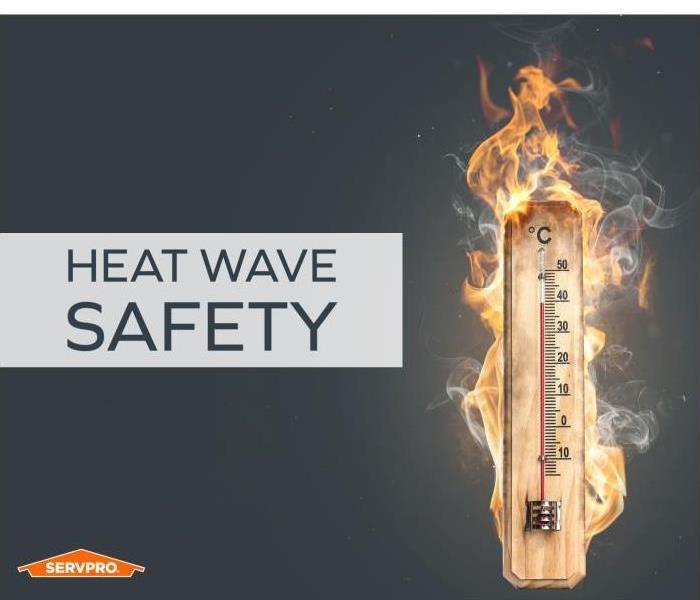 We hope everyone stays safe and cool during this heat wave.
We hope everyone stays safe and cool during this heat wave.
Extreme heat is expected over the next few days in the greater St. Charles area. Extreme heat can be dangerous, especially to infants, children, and the elderly.
Here are a few tips to keep safe during the heatwave:
- Drink plenty of fluids. Don’t wait until your thirsty, and avoid sugary, caffeinated, or alcoholic drinks. Avoid icy beverages that can cause stomach cramps.
- Heavy sweating can remove salt and minerals from your body that need to be replaced. A sports drink or snack can replace the salt and minerals you lose in sweat.
- Don’t forget about your pets. Provide plenty of fresh water for your pets and leave the water in a shady area.
- Check in on older adults and individuals with health conditions. Make sure they are drinking enough water, have access to air conditioning, and if they are showing any signs of heat exhaustion or heat stroke seek emergency care immediately.
- Wear appropriate clothing: Choose lightweight, light-colored, and loose-fitting clothing.
If you believe someone is suffering from a heat-related illness, you need to know what to look for and know what to do. There are different types of illness from heat, and different responses and symptoms to look for.
Heat cramps are muscle spasms, often in the abdomen, arms, or calves, and it’s caused by large loss of salt and water in the body. Look for heavy sweating during exercise, muscle pains or spasms. If this occurring, stop physical activity and move to a cooler place. Drink water or a sports drink. The cramps will need to go away before resuming activity. If the cramps last longer than one hour, get medical help right away.
Heat exhaustion is a severe heat related illness require emergency medical treatment. Look for heavy sweating, cold, pale and clammy skin, fast pulse, tiredness or weakness, dizziness, headache, and brief fainting. Move to a cooler place, put cool wet clothes on their body, use misting and fanning or take a cool bath and sip water. If vomiting occurs, symptoms get worse or last longer than one hour or confusion develops get medical help right away.
Heat stroke is the most serious medical condition caused by extreme heat. It requires immediate emergency treatment. This can result in death without immediate medical attention. Look for high body temperature (104°F or higher), hot, red, dry or damp skin, fast strong pulse, headache, dizziness, nausea, confusion and losing consciousness. Call 911 right away – heat stroke is a medical emergency. While waiting for help, move to a cooler place, try to lower body temperature with a cool or cold bath, misting, fanning or apply cool clothes, if a bath is not available. Do NOT give the person anything to drink.
We hope everyone stays safe and cool during this heat wave. Make sure to drink plenty of water!
Source: Heat Wave Safety | Heat Exhaustion Safety | Red Cross
Should You Choose a Certified Restoration Company?
6/13/2022 (Permalink)
 We provide a fast response to your water restoration emergency and are available 24/7, 7 days a week – even on holidays.
We provide a fast response to your water restoration emergency and are available 24/7, 7 days a week – even on holidays.
You come home from work one day when you notice the toilet in your master bathroom has overflowed. Water not only flooded the bathroom, but the master bedroom too. You head downstairs and realize the water went down into the vents and into the ceiling of your basement below. Drywall is hanging and water is still pouring out onto the floor. You grab your phone and quickly search for the water restoration company that is closest to you – or one that claims to be the cheapest.
The problem is – not all restoration companies are created equal. It’s costly lesson to learn when suddenly the water that flooded your bathroom has become mold down in your basement because it wasn’t dried properly. Therefore, when you use your favorite search engine, you want to make sure your restoration company is IICRC Certified.
The Institute of Inspection Cleaning and Restoration Certification (IICRC) establishes the recognized standards, credentials, and certification for the inspection, cleaning, and restoration industries. These strict guidelines guide restoration technicians on the procedures to make sure that your water damage is dried properly.
At SERVPRO of St. Charles City, our technicians are trained in the best techniques and up to date theories. Our technicians regularly receive continuing education in restoration and remediation as well as IICRC Certifications. It’s important that our team grasps the concepts and skills to provide excellent service.
We provide a fast response to your water restoration emergency and are available 24/7, 7 days a week – even on holidays. We serve the greater St. Charles, MO area and are ready to respond when you need us most.
Have questions? Call us now – (636) 926-0033
First Responders' Night
6/9/2022 (Permalink)
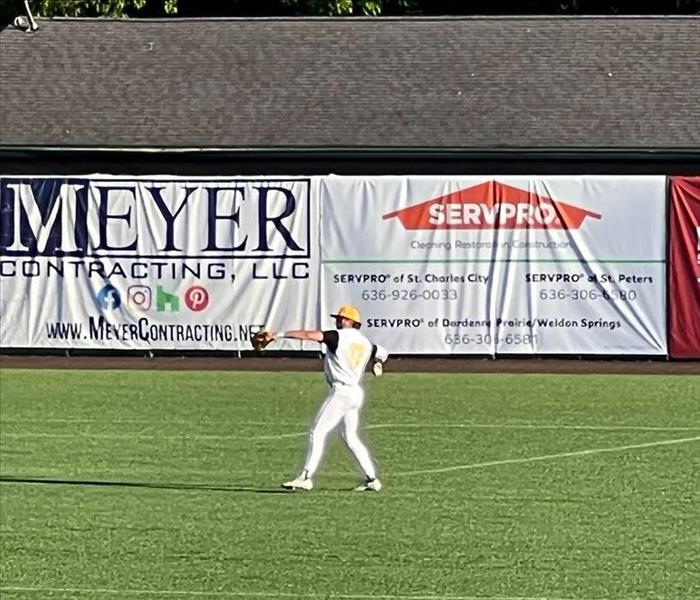 First Responders' Night at the CarShield Stadium in O'Fallon, MO.
First Responders' Night at the CarShield Stadium in O'Fallon, MO.
At SERVPRO of St. Charles City, we make it a goal to be involved with the greater St. Charles area community. We are proud to sponsor local events, bring food to first responders, and lend a helping hand to those when they need it most.
On June 3rd we sponsored a baseball game at CarShield field in O’Fallon. The First Responders’ night O’Fallon Hoots vs. the River Dragons game was in honor of our local first responders. We were able to give away over 300 tickets to our local first responders and their families to attend. Not only did they get to have a fun time at the game, but the game concluded with an awesome fireworks display!
It was an amazing day greeting our first responders and their families as they entered. We hope everyone had a great time and we look forward to the next game.
Restoration After a Grease Fire
6/2/2022 (Permalink)
 SERVPRO of St. Charles City fire damage restoration specialists have all the tools and training needed for every size disaster.
SERVPRO of St. Charles City fire damage restoration specialists have all the tools and training needed for every size disaster.
Cooking is one of the most common causes of a kitchen fire. Did you know that the highest risk comes from frying foods? A grease fire in your greater St. Charles area home is dangerous.
These types of fire can get out of control quickly. Prevention is critical when it comes fires, so here are some helpful tips to remember when your cooking:
- Always use a clean surface. Clean up any spills on your cooktop once it cools. Greasy exhaust hoods or stovetops can catch fire quickly.
- Never leave food unattended. It can take just minutes for cookware to scorch or boil over.
- Always keep a lid within reach and a fire extinguisher nearby.
When you experience a kitchen fire, there are bound to be strong odors even if the fire was relatively small. SERVPRO of St. Charles City is always available 24/7 when you need help handling the cleanup after a grease fire or any blaze within your home or business. We make it “Like it never even happened.”
A kitchen fire can be intimidating, but we are here for prompt emergency fire restoration service. Give us a call today, (636) 926-0033.
Why Is My Smoke Alarm Beeping?
5/20/2022 (Permalink)
 Don’t risk it – protect yourself and your family by promptly investigating – and if needed, replacing your smoke detectors.
Don’t risk it – protect yourself and your family by promptly investigating – and if needed, replacing your smoke detectors.
We all know by now that having a working smoke detector is critical when it comes to home safety. A properly functioning smoke detector can alert you to danger and help save lives.
Sometimes smoke alarms sometimes can make a loud obnoxious chirp noise – even though there is no smoke. Why is it being so – let’s face it – annoying?
Perhaps time flew by, and you forgot to change the batteries. Maybe it is a loose battery, or the terminal is obstructed. Open your smoke detector and if all looks well put a new battery inside. Use the self-check button on your alarm to ensure everything is functioning after installing or resetting the batteries.
- Checking your batteries once a month is recommended.
- Change your batteries once a year if they are replaceable.
- If you have a non-replaceable 10-year battery smoke detector, replace it as soon as possible when it starts chirping.
Another reason your smoke alarm may chirp is due to a dirty sensing chamber. Routinely dusting your alarm can help with this issue.
If you have a wired smoke detector with battery backup, and replacing the battery didn’t help, you should inspect each detector wiring for loose connections. If you notice lights dimming, especially when an appliance is in use, contact an electrician.
After checking over your smoke alarm, your smoke detector is still beeping? It might be the end of its lifespan. Did you know that smoke alarms typically last about 8-10 years? After this period, the units sensing capacity may diminish, reducing its effectiveness. It may simply be time to replace your smoke detectors.
While a fire alarm may not spare your home from a destructive fire or smoke damage, this device may save your life. Don’t risk it – protect yourself and your family by promptly investigating – and if needed, replacing your smoke detectors.
If your home experience smoke or fire damage, our team at SERVPRO of St. Charles City are ready to help restore your property to preloss condition.
Our team is trained to address small and large fire damage projects. We are IICRC certified and have the experience to tackle difficult problems. Our team is ready to serve businesses and families in the greater St. Charles area including St. Peters, O’Fallon, Weldon Spring, and Portage Des Sioux.
Call us and let us help you, (636) 926-0033.
Severe Weather: What To do When Your Attic Floods
5/18/2022 (Permalink)
 If your home or business experiences storm damage to your roof and attic we are here to help.
If your home or business experiences storm damage to your roof and attic we are here to help.
Especially during the spring and summer months, homes and businesses in the St. Charles City area can experience severe weather that could damage roofing including, strong winds, hail, and tree damage. Roof damage can cause water damage in your attic space. Do you know who to call if you experience storm damage?
Often, if you have a large attic in your home, it can be used as a storage area. We understand that while these items are in storage, they are often items you do not wish to part with. Our fast mitigation response time will allow us to prevent additional unnecessary damage to these items.
When your roof experiences damage, water can leak into your attic and ceiling and even cause water damage throughout your property. SERVPRO of St. Charles City not only provides restoration services for water and storm damage, but we can also provide emergency services to help prevent additional damage.
Repairing your roof or any damage to your home is a priority but keeping the water out until final repairs can be done is even more important. We also have a wide range of building services to help prevent additional damage. Using tarps or boarding up openings and windows are our first focus and allows us to begin restoration. We use equipment such as air movers and dehumidifiers to quickly dry your property.
We also offer build back services and can help with reconstruction needs your property may have after the severe weather. Once restoration is complete, we can transition to construction.
We are no stranger to damage from severe storms and are ready to help quickly when you need us most. We are available 24/7, 7 days a week. Give our SERVPRO of St. Charles City team a call today: (636) 926-0033.
Do Carpeted Floors Increase the Urgency of Water Cleanup for Your Office?
5/5/2022 (Permalink)
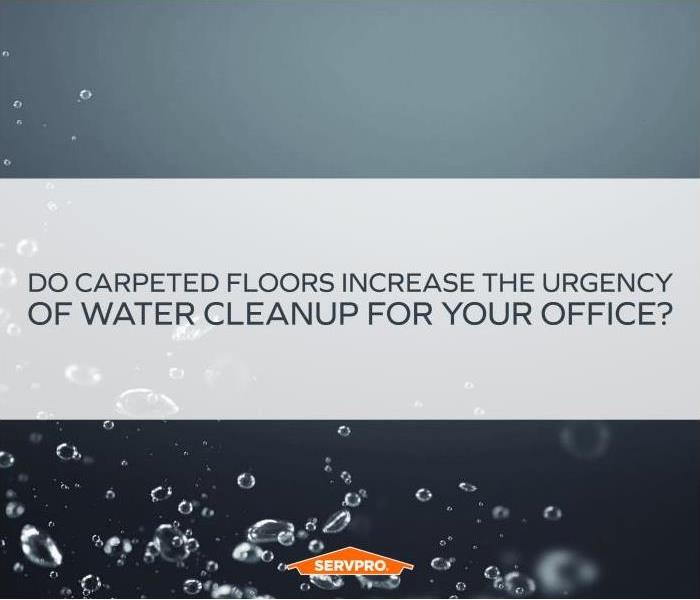 SERVPRO of St. Charles City responds quickly to water damage to prevent secondary damages.
SERVPRO of St. Charles City responds quickly to water damage to prevent secondary damages.
Water damage can happen at any time: day or night. Timing can complicate your decision on handling the damage, because it could be right before a busy day, or at the end of the day when the office is heading home. Water damage can take some time to restore, so you may decide to wait until its more convenient. It is not ideal to wait when it comes to water damage.
Carpet, for example, can absorb water quickly, and when left wet over extended periods, structural damages occur that lead to the disintegration of their layered construction. By waiting, carpeting that could have been restored, may have to be disregarded. Our water damage restoration technicians have experience handling carpets and understand the details of water damage to carpeting.
Carpeting is made of various materials including fibers like nylon, wool, polypropylene, or polyester. The primary backing is made from thermoplastic or latex adhesive, while the secondary backing is made from jute or polypropylene. This layered construction is one of the reasons you should not delay water damage restoration in your office. When exposed to moisture for a prolonged period, the adhesives holding the primary fibers deteriorate, leading to irreversible damage, such as delaminating. Stains and foul odors also develop.
When you call SERVPRO of St. Charles City – we are ready to respond. We offer emergency restoration services 7 days a week, 24 hours a day – even on holidays.
Call us at (636) 926-0033 and we will come up with a plan that minimalizes the impact to your business’s busy schedule.
Dealing with Commercial Fire & Smoke Damage in St. Charles
4/22/2022 (Permalink)
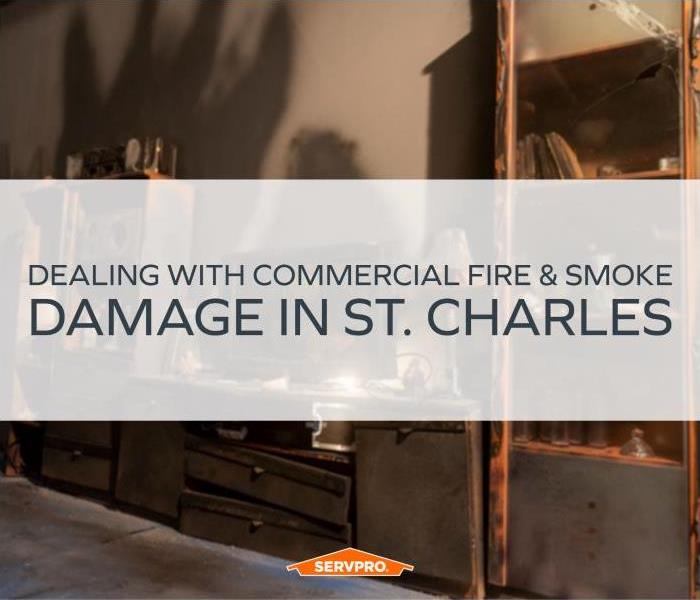 SERVPRO of St. Charles City takes pride in assisting commercial property owners to get back in business after fire and smoke damage.
SERVPRO of St. Charles City takes pride in assisting commercial property owners to get back in business after fire and smoke damage.
A fire has damaged my commercial property and I need help restoring it to its former state. Who can help me remove all the ash, water, odor, and smoke stains?
After a fire has damaged your commercial property, you need to call a professional to restore it. SERVPRO of St. Charles City is a locally owned and operated company that can handle the restoration of your facility.
After the initial assessment, our technicians can work to maintain the structural integrity of the building. They may also use roof tarps and board up windows or openings. Firefighting efforts often cause water damage from hoses and sprinklers. SERVPRO technicians can extract the water and dry the structure quickly and efficiently depending on the situation.
Our technicians will work to get rid of the soot and dust that has accumulated inside the building. They will also remove items that have been damaged and organize the ones that can be salvaged. Since soot is acidic, it can cause more damage the longer it remains in place. It also can cause a foul odor, which we can help remove during our restoration process.
If reconstruction services are required after the fire, we can help with commercial construction. We are truly your one-stop shop for returning your business to preloss condition.
SERVPRO of St. Charles City takes pride in assisting commercial property owners to get back in business after fire and smoke damage. We respond 24 hours a day, 7 days a week, 365 days a year throughout the greater St. Charles area, including St. Peters, O’Fallon, Weldon Spring, and Portage Des Sioux.
Call Us Today – (636) 926-0033
Preventing Storm Damage
4/6/2022 (Permalink)
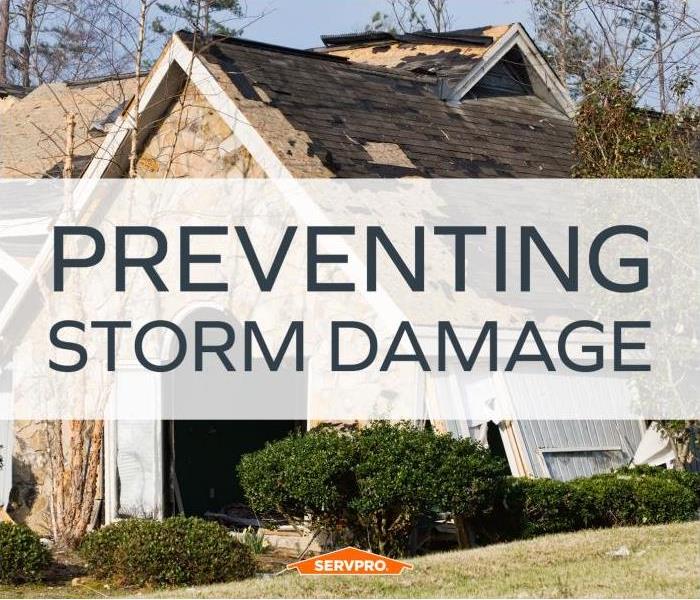 Wherever you find a storm you’ll find SERVPRO green trucks and green shirts. Our motto emphasizes our work: “Faster to any size disaster."
Wherever you find a storm you’ll find SERVPRO green trucks and green shirts. Our motto emphasizes our work: “Faster to any size disaster."
Every spring, we in the Midwest prepare for the season of storms. Unfortunately, many of us end up dealing with the damage caused by these natural disasters.
Despite the weather's unpredictable nature, there are still a lot of things that homeowners can do to protect their homes and property.
What can you do to help minimize storm damage? A little can go a long way.
Here are a few easy items to inspect before the next storm hits:
- One of the most important steps that homeowners can take is to replace damaged or missing shingles.
- Loose siding? The same rule applies, it’s important to ensure that your siding isn’t damaged.
- Keep the gutters clear. Even if you cleaned the gutters in the fall, make sure to double check that they are still clear this spring. This will help keep the water flowing away from your home.
- Inspect your property to make sure water from gutters and runoff will be flowing away from your home. The grade of the lot should work to move water away into a ditch, drain or other retention area.
- Check your sump pump. We have a helpful blog post you can view to help with this one: Sump Pump Checklist.
- Are your windows and doors properly sealed? In the event of tornadic winds, a small opening can allow enough wind inside to comprise the roof.
- Trim your trees. Regular trimming of the trees on your property can also help protect your home and property.
- If you know a storm is coming, you may not have time to make repairs on everything listed above, but simply identifying items that can become projectiles and cause damage can help. Take a walk around your property and move lawn furniture, tools, flowerpots, or any other yard debris into your garage, shed, or indoors.
While these steps may help save your property, the most important step keep your loved ones safe. Have a storm safety plan in place, including a safe location, like a basement or storm shelter, to ride out the storm.
When the storm is over, inspect your property for any damage. If damage occurs, SERVPRO of St. Charles City is ready to help. Wherever you find a storm you’ll find SERVPRO green trucks and green shirts. Our motto emphasizes our work: “Faster to any size disaster." We specialize in helping families and businesses recover after small and large storms.
Have Storm or Flood Damage? Call Us 24/7: (636) 926-0033
Sump Pump Checklist
4/5/2022 (Permalink)
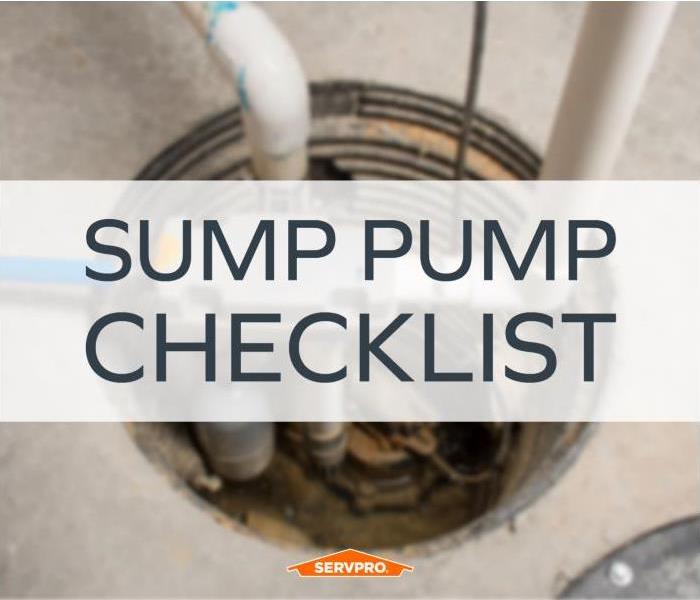 At SERVPRO of St. Charles, we are ready to help restore water damage from a malfunctioning sump pump, or any other source, without delay.
At SERVPRO of St. Charles, we are ready to help restore water damage from a malfunctioning sump pump, or any other source, without delay.
If your basement is usually dry during the rainy season, thank a sump pump. It works hard to keep it that way by automatically pumping out water that's threatening to enter it.
It's important to periodically check your sump pump to make sure it's working properly. Doing this will help keep the water out of your basement and prevent it from causing damage.
It's also important to know how to check and maintain your sump pump. Below are a few tips to keep your sump pump running and prevent accidental breakdowns.
- Make sure that the pump is completely upright. Doing so will prevent it from tipping over and putting too much pressure on its components.
- Take the cover off the pump and look inside. Make sure that the basin and pit are clear of debris and any other objects that might cause an overflow.
- Make sure that the drain hose is connected correctly. A blocked drain hose can cause your pump to run continuously, which could affect its ability to dispose of the water that's collected in the pit.
- If the inlet screen is blocked, the water that's coming from the pump will not be able to enter the pit. This could cause a basement flood.
- Make sure that the float component of your sump pump is free of debris and is moving freely. A faulty float can cause the pump to run continuously, which could eventually cause its engine to fail.
- The next time you hear your sump pump running, go outside and make sure its discharge pipe is pumping the water away from your home at a safe distance. If it’s too close, the water could seep back into your pump, causing your pump to run continuously and inefficiently. The more your sump pump runs, the more likely it is to burn out early in its life span.
- To test the performance of your sump pump, fill the pit with water and turn it on. After carefully monitoring the situation, make sure that the discharge pipe is flowing properly.
- Having a backup battery or a generator is also important if the power goes out during a storm. This could cause your pump to stop working, which could cause a flood in your basement.
If you perform all these steps and notice an issue, it may be time to call a professional to diagnose and fix the issue with your sump pump. Don’t risk damage and get it fixed quickly.
While these tips may help prevent your sump pump from breaking, there is always the unexpected issue that may occur. At SERVPRO of St. Charles, we are ready to help restore water damage from a malfunctioning sump pump, or any other source, without delay. Serving the greater St. Charles, Missouri area, we strive to arrive onsite quickly and restore your home to preloss condition.
What to Do After A Fire
3/24/2022 (Permalink)
 If you’ve suffered a house fire call SERVPRO of St. Charles to help restore your home back to preloss condition.
If you’ve suffered a house fire call SERVPRO of St. Charles to help restore your home back to preloss condition.
After a fire, it can be hard to know what to do next. The actions you take immediately after a fire can affect the restoration of your property.
Your first priority should be to get in touch with a fire damage restoration specialist, such as SERVPRO of St. Charles, to assess the damage and get your property back to its pre-fire condition.
Before entering a building following a fire, make sure that you have the necessary clearance from the Fire Marshal. Also, wear a protective mask to avoid inhaling the smoke. It is best to avoid the scene of the fire, because the more you move around, the more soot can be spread.
If you must enter your home, follow these simple steps:
- Don't go to heavily burned areas as they may be unsafe.
- Do not attempt to clean off smoke and soot residues from surfaces on your own.
- Discard all food items that were exposed, especially open containers.
- Do not use utensils and dishware that were contaminated.
- Do not use computers, TV’s or other electronic devices, as shorts can cause electrocution.
- Take photos of the damage and make a list of damaged items.
- Contact a contractor to board up windows and other open areas.
- Do not make any permanent repairs until the insurance adjuster has seen the damage.
- Keep any receipts for temporary repairs made for reimbursement purposes.
If you’ve suffered a house fire, follow the tips above – and call SERVPRO of St. Charles to help restore your home back to preloss condition. Call us to learn more about the fire damage restoration process.
Turning The Outdoor Faucet Back On
3/14/2022 (Permalink)
 Avoid water damage while turning your spigot back on this spring.
Avoid water damage while turning your spigot back on this spring.
The spigot is the faucet located on the outside of your house where you connect a garden hose. In winter, you likely turned the water off to prevent freezing and possibly water damage to your home.
Now, it’s time to open them so you can water your garden and enjoy the warmer weather!
While turning the water back on to your outside hose may sound simple, there are some precautions to consider to make sure you don’t end up with water inside your home.
- Tighten (close) the wheel/valve on the spigot(s). You may have left them open during the winter, but now is the time to make sure they are closed since you’re turning on the water.
- Locate your water shutoff valve. It is located inside your house, usually in the basement, crawl space or utility room. The valve will be connected to a pipe that leads to the outside where your spigot is connected to your house. If you have more than one spigot, each one will have its own shutoff valve.
- Open the valve to allow water to flow to the spigot. If you have loosened the bleeder valves to allow water to drain when you shut the water off, tighten them now to help prevent leaks.
- Once the water is flowing, make sure there is a fair amount of water coming out, low pressure may mean there is a leak.
- Go back inside while you let the water run, and check for any leaks.
We’ve had a few calls over the years because a customer was outside washing the car or watering the garden, meanwhile the water was leaking inside creating a big mess. Take the extra step and go back inside because pipes and fixtures that have frozen and thawed may not start to leak until full water pressure is re-applied.
If you happen to have a water leak, no matter or large or small, SERVPRO of St. Charles is ready to help minimize the damage. Give us a call!
10,000 Gallons of Water - A Commercial Water Loss in St. Charles, MO
3/3/2022 (Permalink)
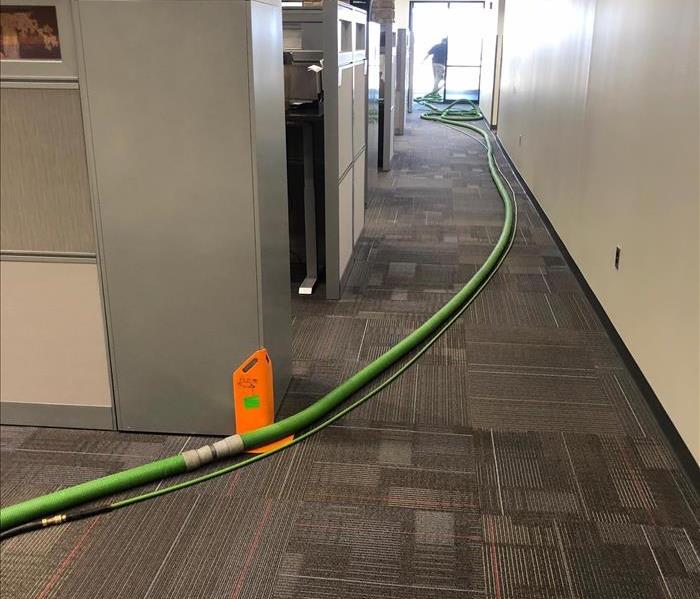 When disaster strikes your home or business you know who to call: SERVPRO of St. Charles City.
When disaster strikes your home or business you know who to call: SERVPRO of St. Charles City.
It was a cold day in the St. Charles area on January 20, 2022. The state and most of the country had been in the grips of single digit cold weather for several days.
At 5:05pm on January 20th, SERVPRO of St. Charles City received a call from one of its commercial customers in need of urgent help.
Earlier that day a fire suppression system water line had frozen and broke in the attic of one of their buildings. With devastating force, water poured from the ceiling.
Nearly 80% of the 41,000+SF building was affected by freezing cold water.
Within 30 minutes of the call SERVPRO of St. Charles City had its initial disaster response team out.
Working conditions onsite were not favorable. The power was out due to the running water and outdoor temperatures were nearing zero.
Our crews worked through the night, braving the cold weather and poor conditions.
They extracted over 10,000 gallons of water from the 30,000sf of drenched building. Crews would end up removing over 5,000sf of soaked drywall and 30,0000sf of wet delaminating carpet and take down 30,000 sf of cubicles and office equipment.
After water extraction and tear out drying equipment was set to stabilize the building and dry all salvageable materials.
Complete drying took a little over a week utilizing 42 dehumidifiers, 124 air movers and 6 air scrubbers.
After a short period of time under difficult conditions the building is ready for reconstruction and occupancy.
When disaster strikes your home or business you know who to call: SERVPRO of St. Charles City. Serving St. Charles, MO, St. Peters, MO, O'Fallon, MO, Weldon Spring, MO and Portage Des Sioux, MO we are locally owned and operated and ready to help. Our business is to put you back in business.
Severe Storms: SERVPRO is READY to Help
2/25/2022 (Permalink)
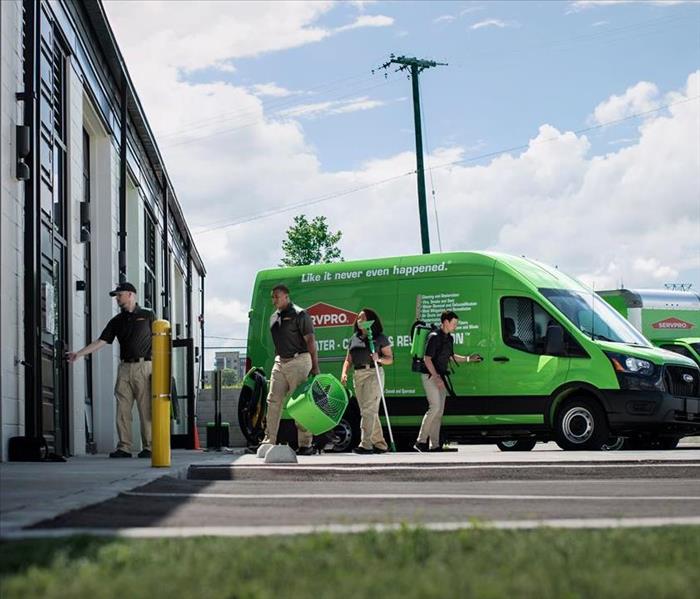 When there is water damage to your home, SERVPRO of St. Charles City is here to help. Our team is available 24/7, 7 days a week, 365 days a year.
When there is water damage to your home, SERVPRO of St. Charles City is here to help. Our team is available 24/7, 7 days a week, 365 days a year.
With Spring quickly approaching, homeowners need to be ready for severe storms. Preparing an emergency kit, trimming trees, and checking your roofs condition are a few ways to be ready before severe storm season. As much as you prepare, there is always the chance for damage, especially water damage. Water damage can disrupt your home, but also require the help of a professional team to be resolved properly.
SERVPRO Technicians are IICRC-Certified to handle water damage and know the best practices in the industry. By using moisture meters and infrared technology, we can detect areas where water deposits exist, even if they are invisible to the naked eye. By thoroughly extracting water with submersible pumps and handheld devices, we use professional drying equipment such as air movers and dehumidifiers to expedite the drying process. We use moisture meters to track drying and make sure materials are making progress. By being thorough, we prevent the possibility of mold in the future from your water loss.
When there is water damage to your home, SERVPRO of St. Charles City is here to help. Our team is available 24/7, 7 days a week, 365 days a year. Don’t risk water damage as a do-it-yourself project because the consequences of not drying your home correctly can be long lasting.
SERVPRO is your ally when you encounter water damage in your St. Charles area home or business. Serving St. Charles, St. Peters, O'Fallon, Weldon Spring, and Portage Des Sioux, MO we are ready to help restore your home to preloss condition.
Have Questions? Call Us Today – (636) 926-0033
Will Insurance Cover My Water Loss?
2/22/2022 (Permalink)
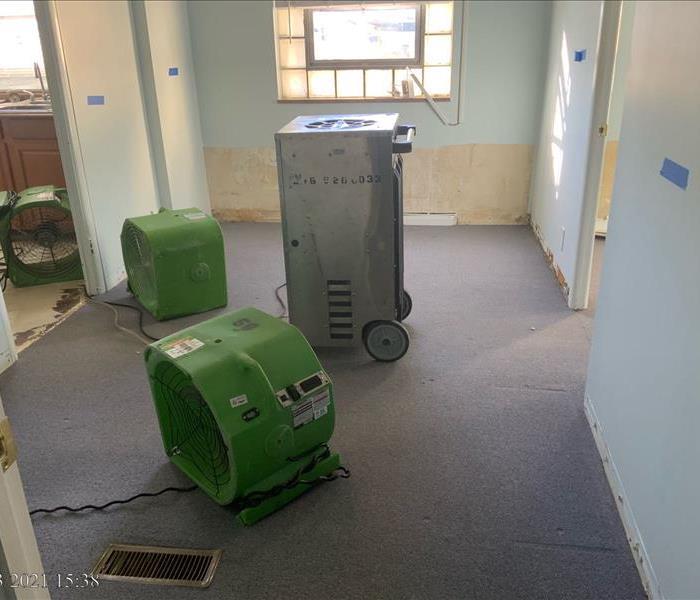 We respond to large and small water damage intrusions 24 hours a day, 7 days a week, 365 days a year throughout the greater St. Charles area.
We respond to large and small water damage intrusions 24 hours a day, 7 days a week, 365 days a year throughout the greater St. Charles area.
Water can be one of the biggest threats to your home and belongings and having insurance that covers water damage is critical. Water damage is one of the most common and costly types of insurance claims. According to the Insurance Information Institute, 29% of all homeowner’s insurance claims are from water damage.
How well do you know your homeowner’s insurance? Did you know, typically water damage that is considered “sudden and accidental” is covered. However, gradual damage can get a bit trickier. Frequently, flooding is not covered unless you have a separate flood insurance policy.
What else usually isn’t covered? Here are some common problems that are typically not covered by a standard homeowners insurance policy.
- Water damage due to lack of maintenance. An example would be failing to fix a known plumbing issue.
- Water damage from intentional acts. This includes setting your house on fire or purposely turning off the heat during the winter.
- Water damage due to floods, hurricanes, and tsunamis. While we may not need to worry about hurricanes or tsunamis in Missouri, flooding can often cause problems for homeowners.
- Water damage that backs up through a sewer, drain, or sump pump. This typically requires special sump and water backup coverage.
- Water damage from leaks from a swimming pool or other structures.
- Water damage from seepage or leaks through a foundation.
- Cost to repair or replace the source, such as a broken dishwasher or washing machine.
While these are the most common problems, the most reliable way to know what isn’t covered is to talk to your insurance agent. Depending on the type of water damage and size, it can often cost thousands of dollars to repair water damage. Knowing your coverage can help you know what to expect.
Who do you call for water damage restoration?
When your home suffers a water damage, call a professional. As leaders in the water damage industry, SERVPRO of St. Charles City has advanced training and expertise, not to mention a tremendous amount of hands-on experience. We use this training and experience to quickly dry your home and restore it back to pre-water-damage condition. Our process includes documentation of the drying process to validate your property is dry. For a stress-free claims process, SERVPRO works with your insurance to help manage the insurance process and paperwork.
We respond to large and small water damage intrusions 24 hours a day, 7 days a week, 365 days a year throughout the greater St. Charles area, including St. Peters, O’Fallon, Weldon Spring, and Portage Des Sioux.
We are here to help: (636) 926-0033
What to Do If You Find Mold
2/10/2022 (Permalink)
Mold is a terrifying word to many property owners. A word with the potential to cause a ton of problems. What should be done if you find or suspect mold in your home or business? Let’s start with some facts about mold.
Mold Facts:
- Mold is all over, inside and out.
- Mold spores are microscopic, floating aloft into your home through windows, doors, or AC/heating systems.
- Mold spores thrive on moisture, quickly growing into colonies when exposed to water. These colonies may produce health effects.
- Before mold remediation can begin, any sources of water or moisture must be addressed. Otherwise, the mold may return.
- Mold often produces a strong, musty odor and can lead you to possible mold problem areas.
- Higher-than-normal indoor humidity can support mold growth, so keep indoor humidity below 45 percent.
- Significant mold growth can occur in 48-72 hours.
- Mold may present a greater risk to children, the elderly, and anyone with respiratory problems.
- A strong, musty odor may indicate hidden mold behind drywall or under carpeting.
How do you know if you have mold? One of the easiest ways to identify if your property has mold damage is seeing the actual mold spores. However, this is often a sign of a larger problem and should be properly investigated by a professional. Another sign can be if you notice a bit of moldy or musty smell, which can also indicate there may be a mold issue.
It’s also a good idea to check where you know water has leaked in the past. Past flooding can also lead to mold issues, becoming a problem a long after if the initial water damage was not thoroughly dried. Be sure to check previously flooded areas for mold.
One of the first steps before remediation of your mold affected area is to stop the source. Many times, mold is from a small plumbing or roof leak. The source will need to be repaired or the mold will simply come back again and again. If you’re not sure of the moisture source, it’s best to hire a professional such as SERVPRO of St. Charles City for help.
Our technicians can inspect your home or business. SERVPRO of St. Charles City, SERVPRO of St. Peters and SERVPRO of Dardenne Prairie/Weldon Springs has the training, protective gear, and specialized equipment necessary to handle your mold problem.
We are here to help. Give SERVPRO of St. Charles City a call today: (636) 926-0033.
Make Your St. Charles Business "Ready for whatever happens".
2/4/2022 (Permalink)
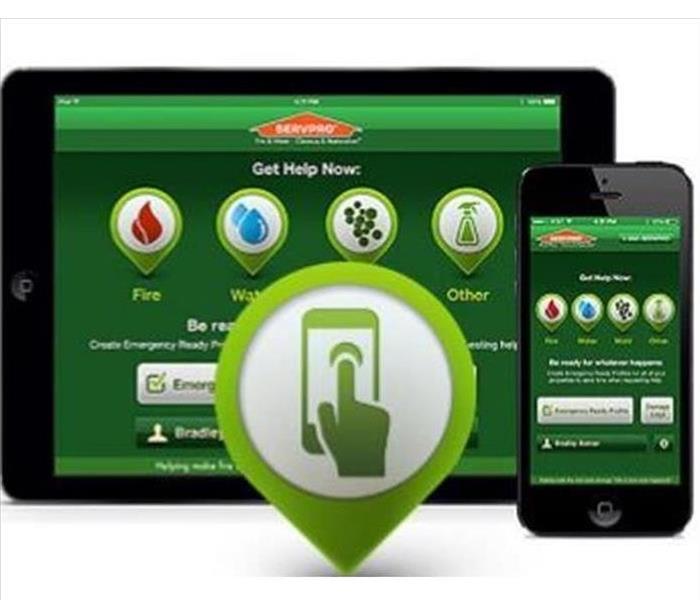 Set your mind at ease with a SERVPRO® Ready Plan. Call (636) 926-0033 to schedule an assessment.
Set your mind at ease with a SERVPRO® Ready Plan. Call (636) 926-0033 to schedule an assessment.
Water damage can be catastrophic for business owners. One of the best ways to reduce the impact of water damage to your business is to prepare a SERVPRO Emergency Ready Profile. We know business owners in St. Charles, MO are busy, but our no cost assessment can reduce costs and downtime in the occurrence of a water damage emergency. Reacting without a plan can be even more devastating.
How does it work?
By developing a SERVPRO Emergency READY Profile for your business, you minimize business interruption by having an immediate plan of action. Knowing what to do and what to expect in advance is the key to timely mitigation and can help minimize how water and fire damage can affect your business.
- A no cost assessment of your facility.
- This means there is no need to allocate funds, giving you a great value at no cost.
- A concise Profile Document that contains only the critical information needed in the event of an emergency.
- It will only take a little time to complete and will not take you away from current projects. But it will save a lot of time if ever needed.
- A guide to help you get back into your building following a disaster.
- This can help minimize the amount of time your business is inactive by having an immediate plan of action.
- Establishes SERVPRO of St. Charles City as your disaster mitigation and restoration provider.
- You have a provider that is recognized as an industry leader and close by.
- Identification of the line of command for authorizing work to begin.
- This saves time so we can begin the work of mitigating the damage which can save you time and money.
- Provides facility details such as shut-off valve locations, priority areas and priority contact information.
- Having a quick reference of what to do, how to do it and who to call provides solutions in advance of an emergency so that during the emergency you are "Ready for whatever happens.
As many as 50% of businesses close following a disaster, according to the latest research. We can help make your business "Ready for whatever happens".
We serve all the greater St. Charles, MO area, including St. Peters, O’Fallon, Weldon Spring, and Portage Des Sioux.
Set your mind at ease. Call (636) 926-0033 to schedule an assessment.
Frozen and Burst Pipe Prevention Explained
1/18/2022 (Permalink)
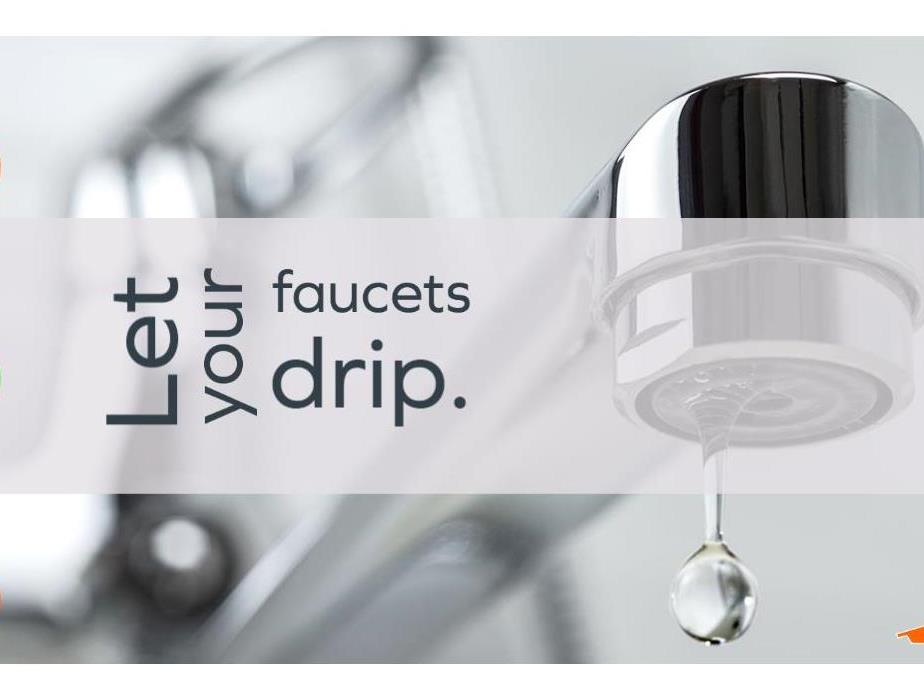 Letting your faucets drip can be a helpful prevention method for frozen pipes.
Letting your faucets drip can be a helpful prevention method for frozen pipes.
Each winter, we at SERVPRO of St. Charles city see frozen or burst pipes wreak havoc on our commercial and residential customers. What can you do to help prevent damage? What can you do to minimize or restore damage if it does occur?
How to Avoid Frozen Pipes
Prevention is a key step when it comes to frozen pipes.
These inexpensive measures might help you avoid professional water damage restoration. Try these ideas:
- Regularly check pipes for damage. As pipes age, even metal ones degrade and crack.
- Insulate pipes to heat evenly. Stable temperatures make the pipes less vulnerable to changes in the weather that may cause them to expand or contract.
- Seal gaps where cold air enters. Even a small opening lets in enough air to significantly lower the temperature of a room.
- Insulate attics and basement spaces. If water pipes are running through these areas, insulation will prevent residential and commercial water damage from ruining a cozy home or office building.
When you hear the weather report that temperatures are dropping, the following tips can help:
- Keep the thermostat above 55 degrees, even in unused rooms.
- Let warm kitchen air into cabinets by opening doors that can warm the pipes behind them.
- Open faucets to keep the water slowly circulating through the pipes so that it doesn’t freeze.
- Turn off the water at the mains before going on vacation.
What to Do When Your Pipes Freeze
Even after precautions, pipes still freeze. However, there are a few things to make pipes less likely to burst.
- If pipes freeze, turn the water off at the main connection.
- Open working faucets and leave the water running.
- Open the faucet closest to the frozen pipe and start thawing the ice slowly. For example, lie a heat pack on the part of the pipe closest to the faucet, slowly moving it along the frozen pipe as the ice melts.
What to Do When a Frozen Pipe Bursts
- Shut the water supply. It is a great idea to know where the valve is to the main water supply on the property before an emergency. Turn it off as soon as the leak or freeze issue becomes apparent.
- Mop if it’s safe. Water causes nasty problems, and it might be helpful to assist in preliminary water removal with a bucket or mop while waiting for professional water cleanup. Only do this if it is safe—there should be no electricity or saltwater damages when walking or touch spills. If there’s uncertainty, wait for the water or fire damage restoration service to arrive and keep people away from the area.
- If there is damage, call SERVPRO immediately—prompt repairs will prevent other issues from arising at the height of the cold weather. Water damage is our specialty, and if water damage is done incorrectly, it could mean mold remediation later.
If your home or business has water damage from a burst pipe or another source, give SERVPRO of St. Charles City a call.
The phrase “Faster to Any Size Disaster” is a SERVPRO motto and it describes the culture of SERVPRO of St. Charles City. We respond to large and small water damage intrusions 24 hours a day, 7 days a week, 365 days a year throughout the greater St. Charles area, including St. Peters, O’Fallon, Weldon Spring, and Portage Des Sioux.
Easy Steps to Prevent Storm Damage
1/18/2022 (Permalink)
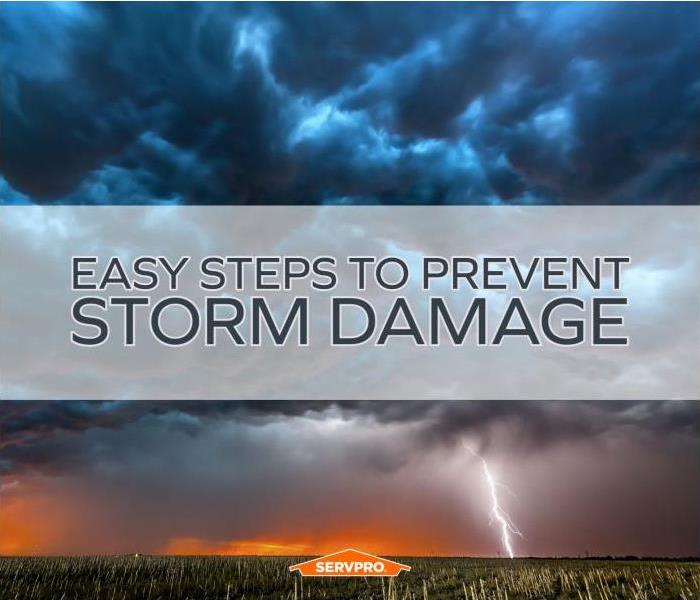 If your St. Charles area home or business experiences damage from a storm, SERVPRO of St. Charles City is here to help.
If your St. Charles area home or business experiences damage from a storm, SERVPRO of St. Charles City is here to help.
While severe storms typically happen during the spring and summer season, it’s anyone’s guess when a severe storm will occur. We can often experience severe storms at any time, causing property damage to your St. Charles, MO home or business.
There are a few steps you can take to help prevent damage to your home, with many being part of your basic upkeep. However, they can go a long way in minimizing damage.
- Replace Missing/Damaged Shingles
- Damaged shingles are more likely to break free. Missing shingles leave a gap for wind to get under and do more damage. If your roof gets a leak from missing shingles, it can cause water damage.
- Keep your gutters clear and ensure water moves away from your home.
- Keeping your gutters clear allows water to flow freely and not back up. It’s also a good idea to make sure that your down spouts flow away from your home.
- Ensure the grade of your property keeps water away from your home, and instead flows into a ditch or other retention area.
- Check Your Sump Pump
- Before a large rain, double check your sump pump is in working order. For extra security, having a backup sump pump is a great way to prevent basement flooding.
- Identify Items that Could Become Projectiles
- Secure outdoor patio furniture or loose items that can be blow away by the wind. Look for lawn decorations, tools, flowerpots, etc. Secure these items in garage, shed, or indoors.
- Anything that’s not secured can be a liability, even loose fence posts. Fence posts are often overlooked when preparing for severe weather. Give each one a shake to check for loose ones.
- Trim Your Trees
- Tree limbs near your home, vehicles, or even your neighbors’ trees can cause damage to your home. Make sure to trim your trees regularly.
- Get a Generator
- A bad storm can knock out power for a few hours – or days. Having a generator can go a long way in ensuring you don’t lose your food and can stay in your home.
One of the most important tasks is to protect your family. Have a storm safety plan in place, with a safe location to go to ride out the worst storms. Have an emergency kit with medical supplies, water and food for a few days is also essential for your safety plan.
Storms can bring a lot of uncertainty, but you can depend on SERVPRO of St. Charles City to help if you experience storm damage. Give us a call, 24/7, 7 days a week – (636) 926-0033.
Certified: SERVPRO Cleaned – a defensive cleaning program
1/10/2022 (Permalink)
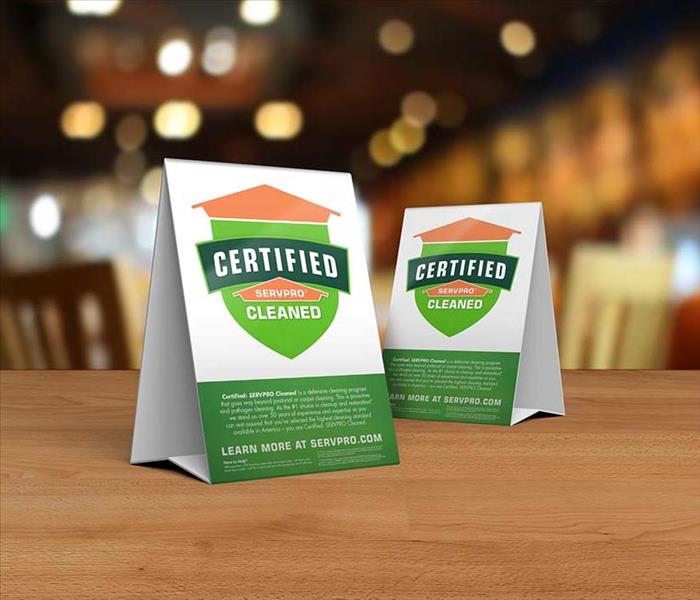 Our defensive cleaning program gives your business a way forward by providing your employees and customers ongoing safety and assuredness.
Our defensive cleaning program gives your business a way forward by providing your employees and customers ongoing safety and assuredness.
Let us help you get back to business
As COVID-19 cases surge again in 2022, we’re all moving back toward a new kind of normal. The expectations of visitors, customers, and employees who come into our establishments have evolved, and staying safe and well is a top concern. The global COVID-19 pandemic has changed what it means to be clean, and we’ve developed a program to help your business meet the new higher standard of clean that is now expected.
Certified: SERVPRO Cleaned is a defensive cleaning program we’re offering to businesses and commercial locations to address the current COVID-19 pandemic. This proactive viral pathogen cleaning program goes well beyond janitorial or carpet cleaning. By choosing Certified: SERVPRO Cleaned, you, your employees, your customers, and your community can rest assured that you’ve selected a higher cleaning standard – you are Certified: SERVPRO Cleaned.
Extensive training and specialized products
As the #1 choice in cleanup and restoration*, we stand on more than 50 years of experience and expertise to help your business become Certified: SERVPRO Cleaned. Beyond fire & water, SERVPRO professionals are trained and experienced in biohazard decontamination and chemical spills – always adhering to the cleaning and decontamination standards set by the Centers for Disease Control and Prevention and local authorities.
From formulating and creating our proprietary cleaning products, like SERVPROXIDE, at our headquarters in Gallatin, TN, to taking the utmost care while disinfecting, we will ensure you and your business are set up to inspire consumer confidence as the economy continues to reopen.
3 C’s – Consult, Clean, and Certify
When the stakes are this high, you want a partner who has developed an industry leading, proprietary training program, cleaning solutions, and remediation processes over decades. We’ve cleaned up some of the most challenging biohazards imaginable. Certified: SERVPRO Cleaned reflects our unique experiences and capabilities. The program is grounded with our unique 3 C’s: Consult, Clean, and Certify.
- Consult – Every business is different, which is why you’ll be assigned a Cleaning Protocol Consultant who understands your business and will create a cleaning program to meet your specific needs. This program will be developed based on your business type, size of space, amount of high frequency touchpoints, foot traffic and congestion points.
- Clean – Based on your specific business needs, your location will undergo a thorough, deep clean, using exclusive cleaning products, according to protocols set forth by the CDC. Our employees have years of experience, and we will go beyond the scope of work that regular janitorial staff perform. Cleanup procedures generally include cleaning of porous and non-porous surfaces, disinfecting of non-porous surfaces, cleaning and disinfecting of equipment, tools, and/or supplies used for cleanup process, and disposal of hazardous materials. In the event of a suspected or confirmed COVID-19 event, we will be there cleaning within 24 hours to ensure you get back to business as quickly as possible.
- Certify - Once your business location has been Certified: SERVPRO Cleaned, you will gain access to proprietary signage, digital emblems, and other collateral that communicates that you’ve selected a higher standard of clean available to help protect your employees and customers. And because we add the day, month, and year to that proprietary stamp of clean, your guests will know that not only did you choose Certified: SERVPRO Cleaned, but that your location is being cleaned regularly at this standard.
Call today for a Certified: SERVPRO Cleaned consultation
We’re Here to Help – 24 hours a day, seven days a week.
Call SERVPRO of St. Charles City today at 636- 926-0033 for your Certified: SERVPRO Cleaned consultation.
* #1 Choice in cleanup & restoration based Commercial Attitude & Usage Tracking study. Polling 816 commercial business decision makers on first choice for future needs related to cleanup & restoration work. Study conducted by C&R Research: October 2019
Certified: SERVPRO Cleaned means professionally trained SERVPRO franchises perform the requested cleaning, sanitizing and disinfection services according to proprietary SERVPRO protocols and recognized industry and CDC standards with EPA approved cleaning products to deliver a SERVPRO certified cleaning experience. Each SERVPRO franchise is independently owned and operated.
How to Use a Wood Stove Safely
1/6/2022 (Permalink)
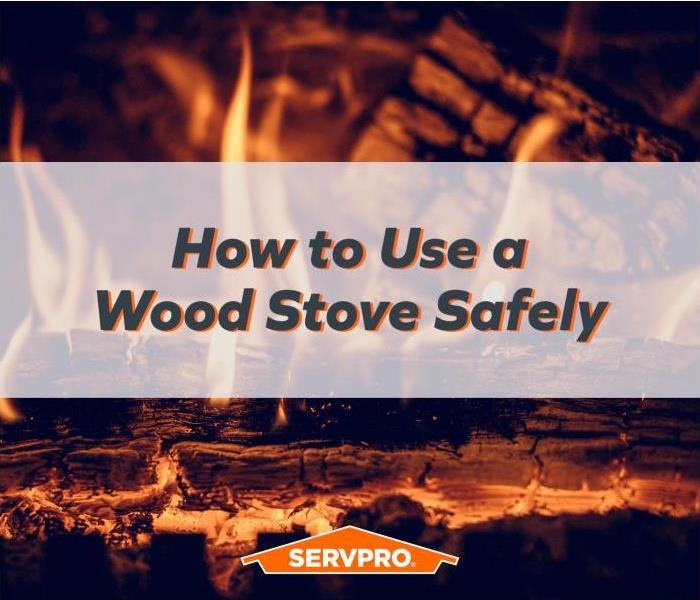 If your home experiences fire due to a wood stove or other source, give SERVPRO of St. Charles City a call. We are here to help.
If your home experiences fire due to a wood stove or other source, give SERVPRO of St. Charles City a call. We are here to help.
During the bitter cold winter months, many homeowners use alternatives to their home heating systems, such as fireplaces, pellet stoves or wood stoves. Each of these heating methods has its benefits and can provide an excellent heat source. If properly installed, maintained, and operated, each can provide years of warmth safely and efficiently. However, using wood stoves also presents risks, such as accidental fires and carbon monoxide poisoning. Proper use of wood stoves can help to significantly reduce the chances of a fire breaking out in your home.
Alternative heat sources do require a certain amount of upkeep for operation and safety. Wood stoves are no exception. So, what can you do to keep your wood stove operating in peak condition? First, let’s look at the type of wood stoves.
Types of Wood Stoves
There are many types and styles of wood stoves suitable for home heating, but most wood stoves can be categorized as either freestanding or a wood stove insert.
A wood stove insert fits into the fireplace opening and vents through the chimney. Some come equipped with a blower to help circulate the heat.
A free-standing wood stove connects to the chimney through a chimney connector. Some may share the flue of an existing or they may vent into a separate chimney built for the stove.
Using the Wood Stove
Be sure to have your chimney inspected to determine if it can be used with a wood stove, because wood stoves generate very hot combustion gases, its chimney must be either masonry or manufactured specifically for burning wood.
If you have a freestanding wood stove, make sure it is located closely to the chimney to limit the length of the flue pipe. When installing, make sure you have easy access to inspect and clean both the stove and chimney connector.
If you have recently moved into a home with a wood burning stove, it’s a good idea to have an inspection performed. This can help make sure it's ready and safe to use, and the inspector may be able to give you some tips on its use.
Never use a freestanding wood stove on a combustible surface such as a wood floor, and it should not be connected to a chimney flue that services another appliance. This could cause a fire or release carbon monoxide.
While wood stoves can provide savings in heating your home, there are some do’s and don’ts to keep in mind to help avoid potential risks, such as burns, fire or carbon monoxide poisoning.
Do:
- Keep children and pets away when you have a fire burning in the stove, as the outer surfaces of the stove and flue pipe are very hot. And keep anything that can burn at least 3 feet away from the stove.
- Make sure you have working carbon monoxide and smoke alarms in your home. Alarms—both fire and carbon monoxide—should be located outside each sleeping area and on every level of the home.
- Regularly remove ashes and properly dispose of them—but do not put them directly into a trash can. Ashes can take several days to cool completely. Instead, place ashes in a covered metal container located at least 10 feet away from buildings or vehicles.
- Have your chimney cleaned and inspected regularly; ideally, at the start of the heating season. It is also a good idea to have it checked halfway through the burning season to check for any creosote buildup.
- Have your wood stove inspected by a professional at least once every year for any wear and tear, especially to the door hinges, the combustion chamber and the connection between the stove and chimney.
- Keep an eye out for any damage or unusual wear and tear, such as buckling, cracks in the glass, open seams or cracks in or corrosion of the metal.
Don’t:
- “Over fire" the stove—in other words, make a larger fire than the stove can handle. Over firing will result in flames entering the flue pipe or chimney, and can cause damage to the stove, the chimney connector or the chimney itself, which could result in a house fire. To avoid over firing, check the instruction manual or with the manufacturer.
- Let ashes build up in the bottom of the stove, as they can interfere with the air flow into the combustion chamber, trap heat and take longer to extinguish.
- Burn anything other than wood in your wood stove. Other combustibles, such as rubber, plastics, garbage or coal, can damage your stove and could also explode or give off toxic, hazardous fumes.
By taking these precautions, you’re ready to use your wood stove during these cold winter months.
If you do experience smoke or fire damage from your wood stove, we are here to help. For professional fire damage remediation, contact SERVPRO of St. Charles City.
Is Category 2 Water Damage Affecting Your Business?
12/31/2021 (Permalink)
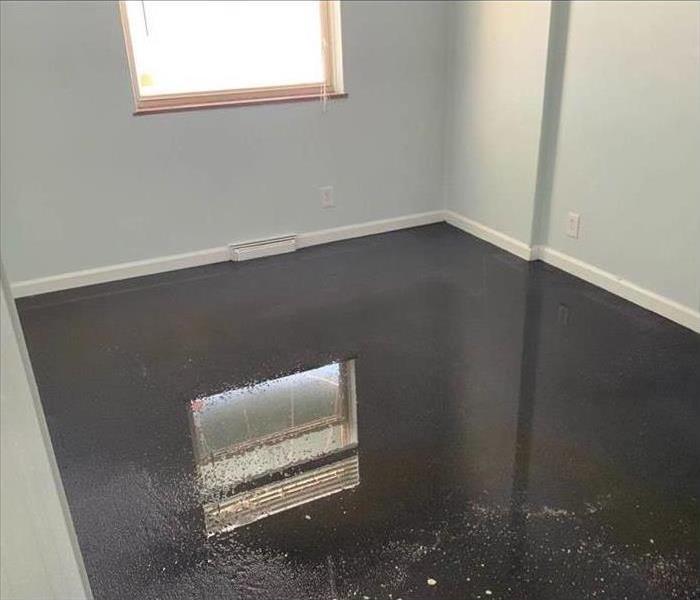 Commercial water damage in Portage Des Sioux, MO.
Commercial water damage in Portage Des Sioux, MO.
It is important to keep your commercial property in Portage Des Sioux, MO, clean and safe for your employees, clients, and customers. One way to do this is to identify and professionally clean up Category 2 water damage when it occurs. Once you've determined that you have unwanted water, a commercial building restoration service can properly locate the source of the leak and perform water pipe repair.
Identify Category 2 Water
Category 2 water, also known as gray water, is water that contains contaminants. While this water may not be as obviously unsanitary as Category 3 (or black) water, it can still make people very ill. Common sources of Category 2 water include the following:
- Broken pipes carrying water from appliances such as washing machines and dishwashers
- A leaking toilet
- A failed sump pump
It's important to note that Category 1 water can also turn into Category 2 water if it's ignored and allowed to stagnate or if it travels throughout your property. For example, Category 1 water that starts on the second floor of the building and travels through the walls and floors to the first floor can become Category 2 due to fungal growth.
Work Quickly To Clean Up Damage
It is important to take steps to quickly mitigate damage from Category 2 water. Immediately turn off your main water valve if you notice a leak or burst pipe. Next, soak up as much of the water as you can using disposable, absorbable materials. It is also important to relocate all property and furniture to a clean, dry area. Determine if water pipe repair is necessary and contact a professional company to dry flooded areas.
If left unattended, damage from Category 2 water can make you and your employees sick. Protect your business, your property, and your workforce by knowing how to identify this problem and who to call when it occurs.
Will a Drain Cleaner Damage My Pipes?
12/26/2021 (Permalink)
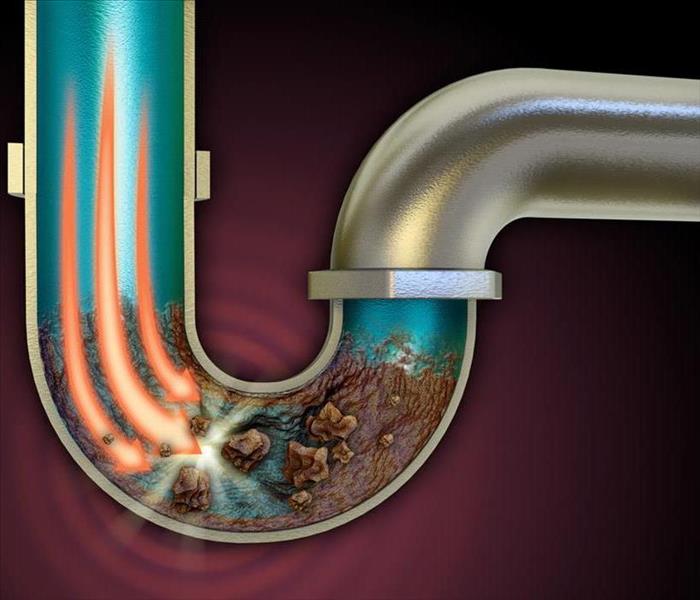 Make sure your drains stay clear for a good, long time.
Make sure your drains stay clear for a good, long time.
Can Cleaning Products Damage Your Pipes?
As a homeowner in Weldon Spring, MO, you most likely will encounter a clogged drain at some time. Your first inclination might be to go to the store and pick up some drain cleaner. This may seem like a simple solution, but can cleaning products damage your pipes?
How They Work
There are three different kinds of chemical cleaners:
- Oxidizing - includes peroxides, bleach or nitrates
- Acid - muriatic acid or sulfuric acid
- Caustic - caustic potash or lye
These cleaners use an electron transfer process to either give or take away electrons from the organic substances blocking the pipe, thereby creating heat, which breaks down the materials and clears the clog. This process can, however, cause harm to your pipes.
How They Cause Harm
The heat from these chemicals can warp or soften the pipes, especially when they are older metal pipes or plastic pipes. There's a higher danger of damage if the clogged drain is completely blocked. If there's nowhere for these caustic chemicals to go, they will just sit in the pipes, eventually eating through them if not removed.
Besides harming your pipes, these chemicals can be harmful to you and to the environment. They can irritate your throat and eyes, and if improperly handled, can cause burns. Once they go down the drain, they can end up in waterways and landfills, causing harm to wildlife.
Alternatives
Before using a chemical in the drain, try to clear the blockage using a snake or augur. If this doesn't do the trick, try using a non-toxic solution such as an enzymatic drain cleaner. These cleaners work by actually eating the clog with bacteria or enzymes. They work best on organic blockages such as soap or hair but can take as long as 24 hours to work.
If you are not able to clear the clog by yourself, it's best to call a plumbing professional to assess the problem and clear the clogged drain. If the blockage is further down the pipes, they can do a thorough sewage cleaning to make sure your drains stay clear for a good, long time.
Kitchen Fires: 4 Cooking Tips To Reduce Fire Hazards
12/21/2021 (Permalink)
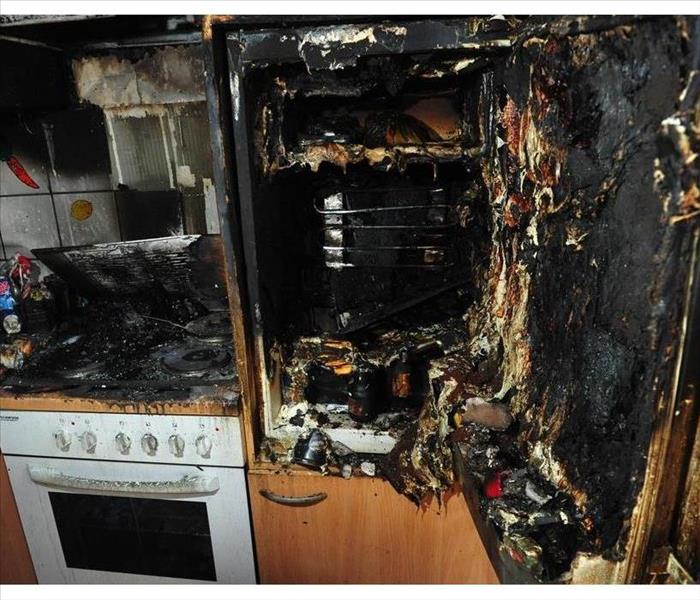 Kitchen fire in O'Fallon, MO.
Kitchen fire in O'Fallon, MO.
Kitchen Fires
While every home should have a smoke detector in the kitchen, there are several other tips for keeping your home and yourself safe when cooking. From rolling up your sleeves and tying back your hair to keeping flammable materials, like paper towel and dish towels, away from the stove, cooking safety is essential when it comes to fire prevention. However, many homeowners can be complacent about the following four risk factors.
1. Appliances
Fire damage is devastating, but the fact that so many fires are caused by faulty or mishandled appliances is shocking. Appliances, if not maintained, are a leading cause of home fires. Be sure to service all your appliances properly. Additionally, unplug small countertop appliances as they draw electricity even when not in use, which can lead to overheating.
2. Too Much Oil or Grease
One of the most overlooked cooking tips is to use less oil and grease. In cooking, a little goes a long way when it comes to these two substances. Using too much of either can lead to grease fires which, if left unattended, can get out of hand quickly. It is important to remember not to throw water on a grease fire because it will only splash the pan and cause the fire to spread, instead use salt or baking soda. For other possible ways to extinguish a grease or oil fire, call a fire remediation specialist in the O'Fallon, MO, area
3. Spills
Another common cause of many kitchen fires is a dirty stove or oven. Always wipe up spills immediately and clean cooktops after use. Leftover grease, oil or food can ignite on the burner, causing a fire. This is another reason why it is essential to keep an eye on food as it cooks because these types of fires require a quick response, or they can spread quickly.
Unfortunately, while the kitchen is the heart of the home, it is also the most likely place for fires to begin. The above tips offer several suggestions for helping you maintain a safe and fire-free home.
Does Renters Insurance Cover Fire Damage?
11/23/2021 (Permalink)
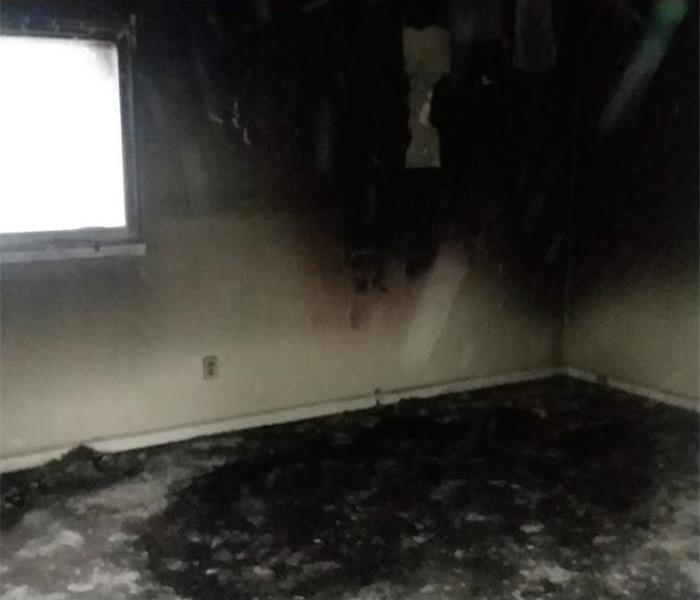 Fire damage to a home in St. Peters, MO.
Fire damage to a home in St. Peters, MO.
Is Fire Damage Covered by Renters Insurance?
Fire coverage on renters insurance can offset the loss of possessions and other liabilities after a fire. The exact coverage may vary from policy to policy, so it may be beneficial to familiarize yourself with the fire portion and limits of a policy, and then discuss any concerns with the insurer.
Rental Property Coverage
The homeowner's coverage maintained by a landlord typically covers a rental property, but not your contents. This is where renter policies kick in. Renter coverage often also provides limited liability coverage and compensates any third parties who sustain injuries or suffer damages on the property due to fire or negligence.
Personal Property Coverage
Fire damage to the contents in a rental property is a covered peril under most renters insurance policies. You should be able to obtain the full cost of property lost in a fire rather than the depreciated cash value. Be sure to check any policy you are considering to make sure this is the case. The current cash value will likely not be sufficient to replace the possessions you have lost.
Other Types of Coverage
Renters policies also tend to provide limited coverage for medical payments involving your liability for minor injuries to others. This coverage can also provide some measure of protection to the renter on the policy if another person is injured on the property. Depending on the policy you choose, you may also have some level of loss of use coverage to help to offset additional living expenses during the mitigation and restoration period after a fire.
If you rent an apartment or house in St. Peters, MO, you should consider the inexpensive ease of mind that is readily available through a renters insurance policy. When it comes to covering fire damage to contents or related liabilities, this policy can help to make a fire less of a devastating event. Additionally, your return to the property may be shortened if the landlord relies on the expertise of a fire restoration company.
Does A Business Need Flood Insurance?
11/11/2021 (Permalink)
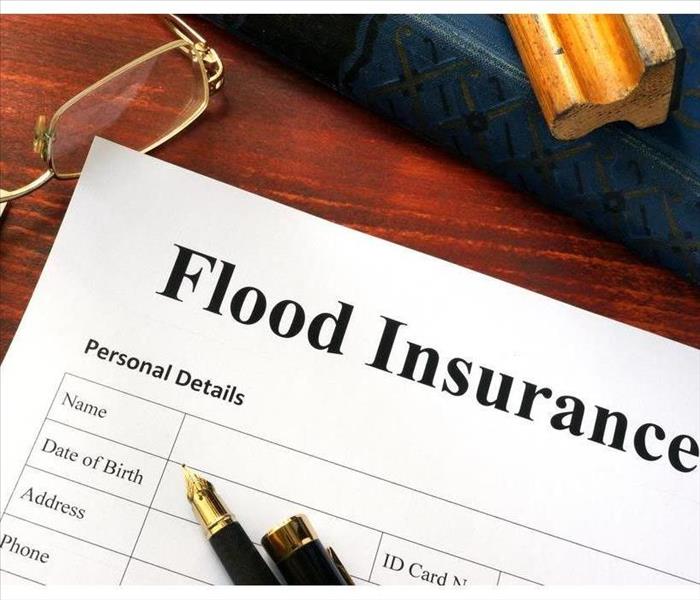 Flood insurance may protect against losses caused by flooding.
Flood insurance may protect against losses caused by flooding.
Flood Insurance For Your Business
Flood insurance is a useful tool to combat the risk of natural disasters, but many business owners do not understand the requirements and basics of these potentially valuable policies. Keep reading for clarification and consideration.
1. Is Insurance Necessary?
While commercial insurance is likely mandatory, coverage for flooding may only be required in some regions of the country. However, just because it is not required does not mean it is not necessary. Only you can be the judge of the necessity of this type of insurance. If your business is located in a low-lying area or an area prone to even small floods, it may be a nice addition to your policy.
2. Does Insurance Protect Against Losses?
Flood insurance may protect against losses caused by flooding. However, there may be specific requirements for that coverage to kick in. For instance, your flood policy may make a stipulate that the flooding is caused by a natural disaster, like the overflowing of lakes, rivers, or streams. Some plans may require an overflow to be a certain size before being labeled a flood. For example, many policies agree that water must cover a minimum of 2 acres or affect a minimum of 2 properties before being defined as a flood.
3. Does Insurance Cover Landscaping and Exterior Property Damage?
No, most flood policies do not cover damage done to the exterior of a property, including landscaping and septic systems. Additionally, business interruptions will likely not be covered by this type of policy. There are policies for business interruption as well as additional endorsements that can expand coverage to things like vehicles.
4. Does Insurance Cover Restoration?
Yes, if you have flood coverage, most policies will cover the costs of business restoration. While each policy is different, most will require that you receive a minimum of 3 estimates from restoration companies in St. Charles, MO, area.
While every municipality does not necessarily mandate flood insurance, it may be beneficial for business owners. Ensuring that your property is protected against every potential risk is a way to preserve and maintain operations. Right, not every business needs flood protection, but it may be worth considering.
Planning for Water Damage Cleanup
11/1/2021 (Permalink)
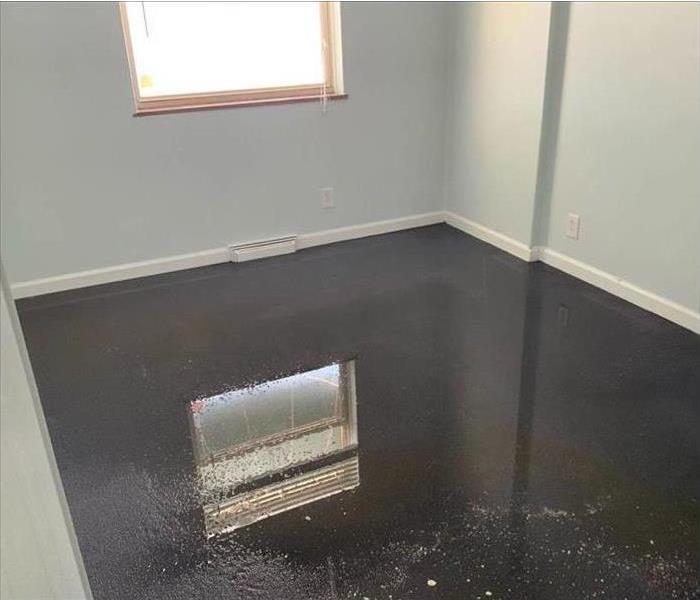 Water damage in a Portage Des Sioux, MO home.
Water damage in a Portage Des Sioux, MO home.
It is tremendously difficult to overstate the damage water can cause to a home. Because water is liquid, it can seep into places you may not even notice. Even worse, bursting pipes can flood a basement or other area quickly. If your Portage Des Sioux, MO, home has sustained water damage, you may be wondering how long restoration and remediation will take.
The Drying Process
Once you fix a broken pipe, your restoration service will likely begin to dry out your house. In most cases, drying a home takes between two and three days. There are, of course, special circumstances that may lengthen drying time. These can include the following:
- You have soaked wood floors
- You live in a humid climate
- Your home has sustained damage to several areas
Wood floors typically take between seven and 10 days to dry out completely. Restoration technicians usually use large fans to circulate air in the affected areas. Of course, if there are high levels of humidity in your house, drying times can take longer. Since bursting pipes can distribute water over large sections of your home, removing the excess water may extend the drying process as well.
The Restoration Process
When you work with a Portage Des Sioux, MO, restoration service, you can benefit from both expertise and equipment. Chances are good you can neither buy nor rent enough professional grade fans to sufficiently dry out your house. Because restoration technicians understand how to restore the comfort, value and appearance of your home, they are better able to target their efforts to maximize impact.
Few things can destroy a home faster than water damage. Still, you don’t have to be afraid of bursting pipes. When you notice flooding or other water-related damage, you can stop the event from continuing. Then, you may choose to work diligently to mitigate the negative effects of the damage. With the right professionals on your side, you can boost your odds of restoring your home to its pre-flood condition.
4 Things You Need To Know About Partial Loss
10/30/2021 (Permalink)
 Fire loss in a Weldon Spring, MO building.
Fire loss in a Weldon Spring, MO building.
Four Things You Should Know About Partial Loss
Fires don't always ravage commercial buildings in Weldon Spring, MO. Sometimes they cause small amounts of smoke damage rather than burn the structure to the ground. This type of fire loss is often called a partial loss. Even though the damage isn't as severe, your restoration may still be a long process. Here are four things you need to know about partial loss:
1. Recovery may be on the back burner. If other commercial buildings were affected by the fire, your fire restoration may not get scheduled right away. The more damaged structures may get priority over your partial loss.
2. There could be more damage than expected. You have to get an inspection done of your property even if you don't think there's much damage. The inspection will look at your roof, siding, windows, interior walls, plumbing and structure. You may find hidden points of damage in ducts and behind walls. You may have to fix air quality and mold, water, smoke and ash damage too.
3. You may have to replace undamaged items. If part of your roof or siding has been damaged, you may need to replace a larger portion of the materials than expected. To get your building back to a uniform appearance, you may need to redo the entire roof after a partial fire loss.
4. You need to work with a professional. Even though there isn't that much damage to repair, you still need to work with a fire mitigation team familiar with this type of repair work. If you fail to work with a true professional, your cleaning and repair may not be done as well as it should be.
No matter how much fire loss you have after flames break out in your commercial building, you need to take on a complete restoration. Sometimes even the seemingly easy repairs can take more work and time than initially expected.
Moisture, Mold, and Your Home
10/28/2021 (Permalink)
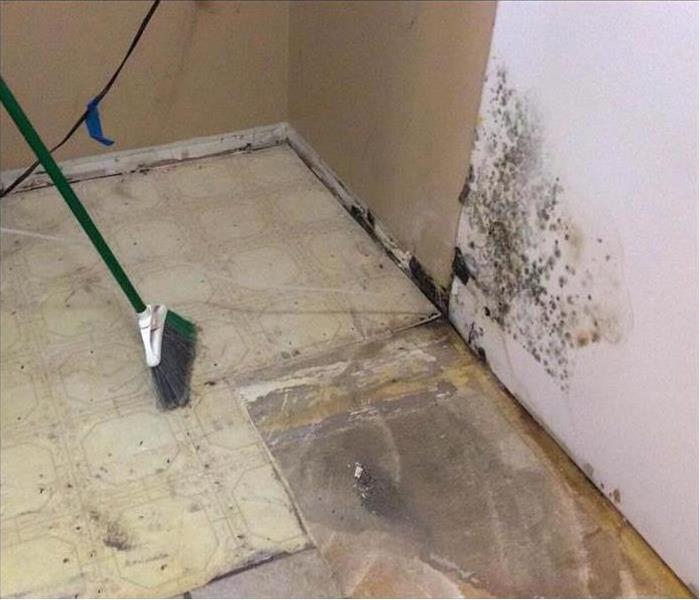 Mold growth was found in O'Fallon, MO home
Mold growth was found in O'Fallon, MO home
Mold, Moisture, and Your Home
Many people believe that removing moisture from a room, home, or building in O'Fallon, MO, will quickly kill all types of mold and their spores. Sadly, this is untrue. Mold spores do require water in some form to grow, but when they are deprived of all available water sources, the spores simply go into a type of stasis which allows the dormant yellow, red, or black mold to exist for many years without water. Then, at the first source of water, the fungus begins to grow and spread once again.
Mold Loves To Eat
Mold spores can go nearly everywhere as they float through the air. To complicate matters, the fungus can be a ravenous organism that feeds on anything organic that it can reach. This includes:
- Paper
- Wood
- Paint
- Carpet glue
- Dust
- Fabric
As one of the best recyclers on earth, mold evolved to help break down organic materials. If there is any type of moisture problem in your home and natural resources available, mold will probably soon be found there decomposing everything it can.
Mold Loves To Drink
To eliminate the growth of black mold, eliminate the moisture. This sounds simple enough, but porous surfaces can hold moisture for a long time. That makes immediate water removal nearly impossible.
Mold Loves To Spread
You cannot eliminate mold spores from your home because they are everywhere. Experts on mold remediation claim that when the spots of mold are large enough to be seen and require mold cleanup, it could be a problem. One square inch of visible mold can have as many as a million organisms that can quickly multiply into the billions as it germinates. When mold appears, it is often best to call the experts to evaluate the situation and keep the mold from spreading.
The easiest way to prevent black mold from invading your home is to keep the rooms moisture free, and that is nearly impossible. But you can limit the humidity levels of your home and take care of any water leaks as soon as they appear. Troublesome mold generally won’t be a problem if there is no water available.
Why to Have Electronics Cleaned After a Fire
10/23/2021 (Permalink)
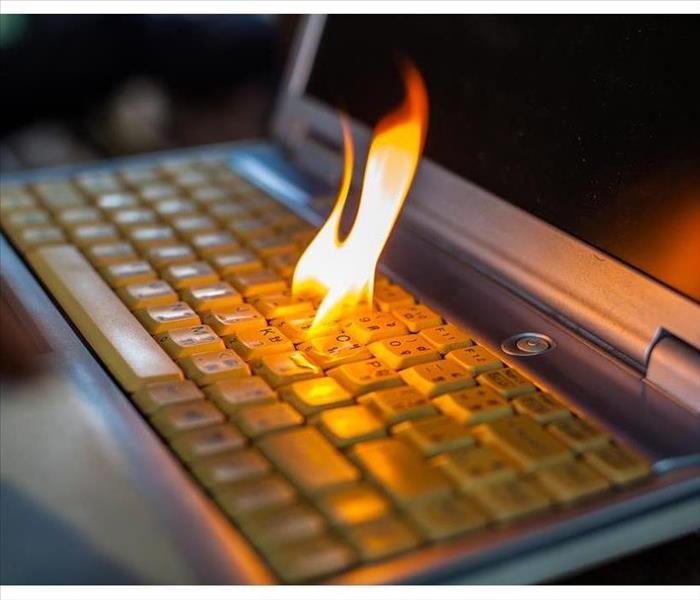 You should call professional expertise to restore your electronics.
You should call professional expertise to restore your electronics.
Why Should You Have Your Electronics Cleaned After a Fire?
If you have experienced a fire, you may not be sure whether electronics are safe to use. Even if a device was not destroyed, intense heat may have warped or otherwise affected delicate internal components. Restoring computers and devices filled with smoke and coated with soot is an important part of fire cleanup. Smoke damage poses several risks to electronics:
• Acidity: The acidity of smoke destroys metals and can cause them to disintegrate. Exposure to corrosive acids in the air may cause devices to fail or behave unpredictably in ways that may be dangerous. Electronics restoration experts can make sure that devices are safe to use and identify which items you should replace.
• Coated Components: Any device found near a fire is likely to require fire cleanup to remove all traces of smoke and soot. The black film which develops over internal components may insulate the heat-producing parts of an electronic device and cause circuits to short. In addition to causing a device to overheat, the chemicals in smoke and soot will adhere to any dust or debris already in a machine and intensify the damage.
• Lost data: Smoke or fire damage may wipe out hard drives, memory, and storage volumes. Even backup drives may be ruined. Electronics restoration professionals can help you retrieve as much data as possible. Keep in mind that the extent of the fire or smoke damage may limit how much can be salvaged.
You may be able to clean the exterior of your device by wiping it down, but you should depend on the professional expertise of a certified fire cleanup service in St. Peters, MO to restore electronics to working order. You should also take pictures or video to document the extent of the damage to your devices in case some of these items are beyond repair and you need to file claims for replacements.
4 Tips for Traveling During Storm Season
10/23/2021 (Permalink)
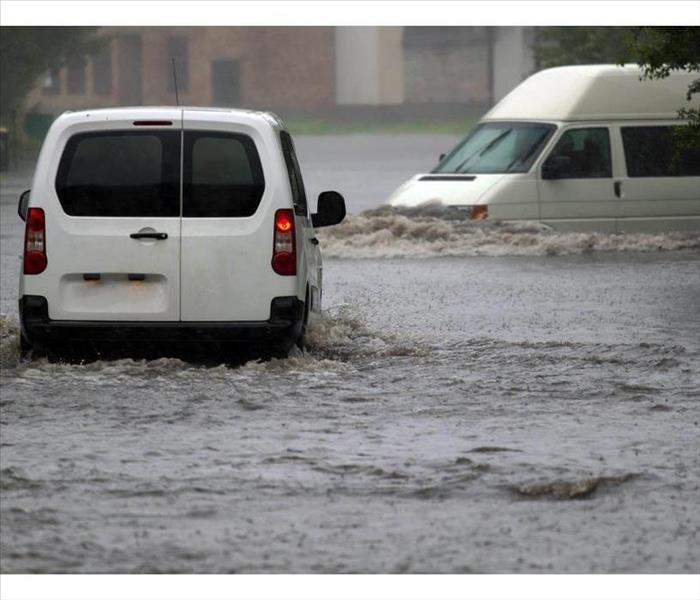 Don't drive on a flooded street.
Don't drive on a flooded street.
4 Travel Tips During Storm Season
Storms can happen any time in St. Charles City. Heavy rains and strong winds can cause damage to your home, but they can also affect your ability to travel. While a storm remediation service cannot help fix your travel plans, it can help repair any damage done to your home. If you want to travel, however, you can remember these four tips to help you avoid a canceled flight and have the best trip possible. Have a Backup Plan
Planning a trip during storm season can be risky, but you don't always have a choice. If you must fly when bad weather is likely, try to have a backup plan ready. This could include buying a travel insurance plan to help you reserve a new seat if your original flight is canceled. You may also want to consider having alternate travel dates in mind just in case.
Get to the Airport on Time
Even if you get an email telling you your flight has been delayed, you may still want to get to the airport in time for the original flight departure. The weather may clear up, which could allow the flight time to be moved back up. If you end up with a canceled flight, you are already at the airport to figure out a new travel plan.
Know Who To Call
Before you get to the airport, you may want to find out who you would have to call should your flight get canceled. Calling the airline directly can help you figure out a new flight if yours gets canceled. You may be told to go to the airline desk, but that will leave you waiting in line for who knows how long.
Pack Light
A canceled flight could require you to quickly change your travel plans. If you have to check bags, there's a chance you may lose some of your luggage in the shuffle. Keeping everything in carry-on bags ensures you can keep track of all of your belongings.
Traveling any time can be stressful. Keeping these storm tips in mind can help you have a great trip.
4 Ways To Remove Mold From Your Shower
9/27/2021 (Permalink)
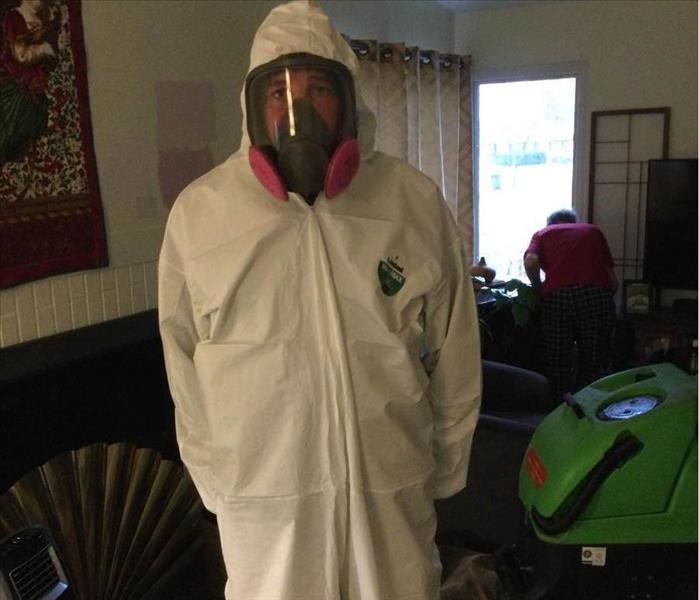 Stopping shower mold prevents it from turning from a localized problem into a household one.
Stopping shower mold prevents it from turning from a localized problem into a household one.
When you go to shower, you could potentially be surprised by the sight of black mold growing in your St. Charles home. A bathroom is a warm and moist environment that mold desires, but the mold doesn’t have to permanently reside there. With these four different methods, you can remove shower mold and stop it from becoming more of a hassle.
1. Soap and Baking Soda
Before getting more potent chemicals involved, the mold should be tackled with a solution of dish soap, baking soda, and hot water. This solution should be scrubbed and washed off in moldy areas to remove the surface infestation without risk of discoloration or damage to what’s underneath.
2. Bleach
As its popularity and usage imply, bleach is a good first line of offense against shower mold. Bleach should be diluted in a 1:2 solution with water and applied in multiple cycles of scrubbing and rinsing. Bleach is very effective at removing mold from glass, bathroom counters, and tiles.
3. Hydrogen Peroxide Solution
Unlike bleach, hydrogen peroxide can remove mold from porous surfaces such as wood. As an affordable household item, hydrogen peroxide is often easily obtainable in its recommended 3% solution form.
Hydrogen peroxide should first be sprayed on a small spot to ensure it won’t damage the surface. Once you have confirmed that damage will not occur, the entire moldy area should be coated and left to stand for at least half an hour before wiping it off. It may be worth multiple treatments following the same procedure to remove residual mold.
4. Professional Assistance
These home remedies treat the surface, but mold spreads and hides in places you may not know. A professional residential mold specialty crew can locate hidden mold with special tools and remove extraneous moisture that keeps it alive.
Stopping shower mold prevents it from turning from a localized problem into a household one. With the right method of treatment, you can keep your home clean and mold-free.
Don’t Get Washed Away: Understanding Flood Zones and the Requirements If You’re in One
9/13/2021 (Permalink)
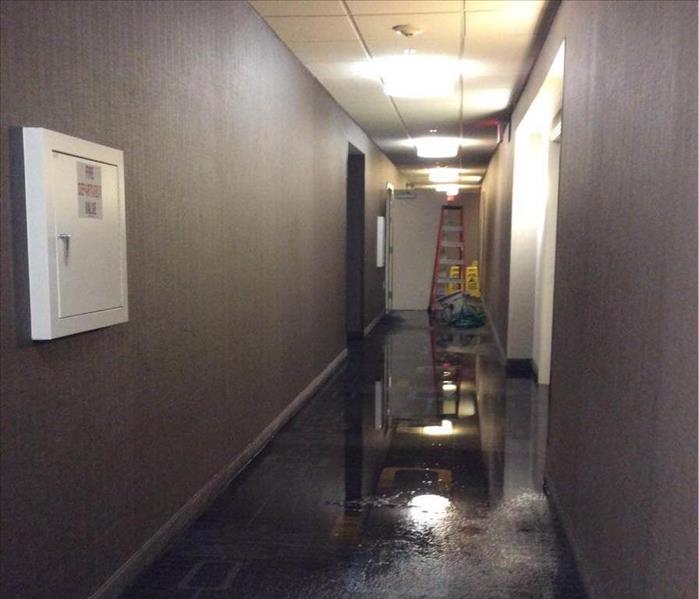 If you have more questions about zoning, you can always check the St. Charles, MO, area for flood and storm damage specialists.
If you have more questions about zoning, you can always check the St. Charles, MO, area for flood and storm damage specialists.
While flooding may not have been a concern in your previous home, you should at least keep it in mind while searching for a new home because there may be specific insurance requirements for particular flood zone designations.
1. Flood Insurance and the FIRM Map
If you are used to living in areas that didn’t require flood insurance, then the Flood Insurance Rate Map (FIRM) is likely a new concept. This map is released and produced by FEMA, in conjunction with local municipalities, to designate the likelihood of flooding in certain areas. These designations or zones help insurance companies determine requirements for homeowners, ensuring that they are covered for likely scenarios.
2. Zones Where Flood Insurance Is Optional
In a moderate to the low-risk flood zone, flood insurance is optional. These areas are typically marked on the FIRM map as zones B and X (shaded) and C and X (unshaded). These areas receive these designations after land surveys and studies have shown these areas to have adequate drainage or minimal severe weather patterns.
3. Zones Where Flood Insurance Is Required
Flood insurance is required in areas that are deemed high-risk, meaning that there is at least a 26% chance of floods over the life of a mortgage. These high-risk areas come with two designations: (1) high risk, or zones A, AE, A1–30, AH, AO, AR, A99, and (2) high-risk coastal areas, or zones V, VE, V1–30.
4. The Fluidity of Special Flood Hazard Areas
Another designation, the Special Flood Hazard Area (SFHA), is fluid, meaning that, while your house may currently be in an area where flood insurance is optional, due to changing weather patterns or tides you may be required to purchase flood insurance later.
If you have more questions about zoning, you can always check the St. Charles, MO, area for flood and storm damage specialists, reach out to any local insurance agent or check with FEMA to help clarify flooding requirements and your flood zone concerns.
3 Reasons To Purchase Business Insurance
8/31/2021 (Permalink)
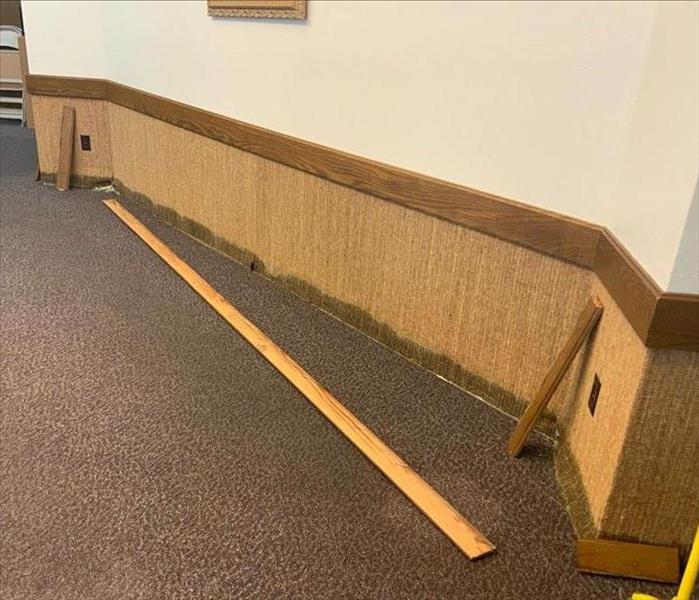 Water damage can be devastating to your business, and without insurance, making repairs can be expensive and time-consuming.
Water damage can be devastating to your business, and without insurance, making repairs can be expensive and time-consuming.
Managing a business in St. Charles can be a rewarding endeavor, allowing you to connect with your community and to share your passions with others. Unfortunately, water damage can be a huge setback to businesses of all types. Business insurance can help protect your company in the event that your commercial property is damaged by water.
Financial Security
With all the time, money, and energy it takes to maintain a successful business, liquid damage can create a mess that is costly to repair. Since the damage can happen so quickly, it’s often not possible to protect important documents, products, or other valuable items. Recovering and replacing expensive tools and products without insurance can be incredibly expensive. Business insurance often covers the costs of damage caused by floods, burst pipes, and other events that result in water damage.
Quick Cleanup
Water can quickly puddle and can result in a tremendous amount of damage to a business. Without insurance, you may spend unnecessary time trying to clean your space to prepare for repairs, and damage from water can even create hazardous environments. However, business insurance ensures that water cleanup is quick, easy, and efficient. With your business clean and safe, you’ll be able to reopen your location as soon as possible.
Peace of Mind
Maintaining a business means spending hours every day making sure you give your consumers the best products or experiences, and additional stress can take time away from perfecting your company. Although taking preventative measures to keep your location protected is always a good idea, water destruction cannot always be prevented. Not knowing how to respond if your business is damaged by water can create more stress, but business insurance can give you confidence that your organization can recover if water damages it.
Water damage can be devastating to your business, and without insurance, making repairs can be expensive and time-consuming. Business insurance can ensure that your business is protected in case your property is damaged by water.
A Quick Guide to Preventing Home Water Damage
8/24/2021 (Permalink)
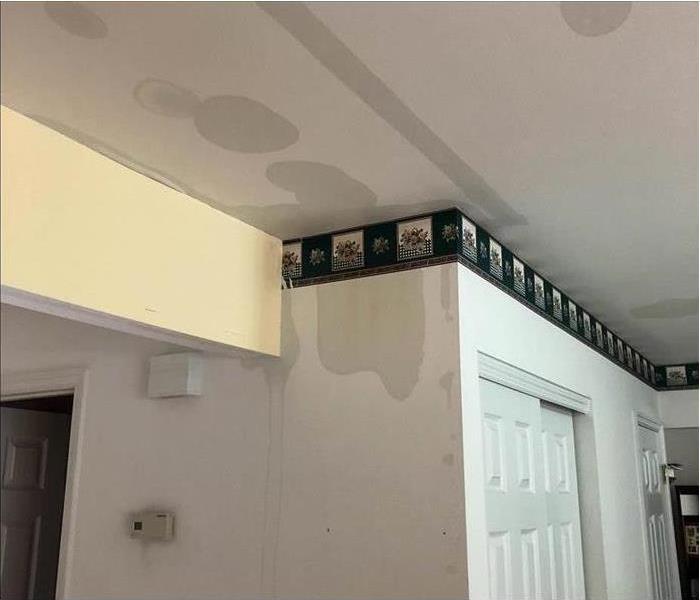 SERVPRO of St. Charles is here to help you with any water damage in your home!
SERVPRO of St. Charles is here to help you with any water damage in your home!
A Step-by-Step Guide To Preventing Water Damage In Your Home
Water damage is one of the costliest disasters a homeowner can experience. When water floods home basements, bathrooms, or crawl spaces, there is also the potential for personal property damage, mold, and structural integrity issues. You can safeguard your residence against many types of damage caused by water in your home with a few preventative steps.
Plumbing
Although you probably use plumbing each day, you may forget to check your pipes and appliances regularly. Here is some practical advice on preventing plumbing problems in St. Charles, MO.
• Inspect tubs and showers for cracks and caulking issues.
• Check appliances for loose hoses and damaged hose washers.
• Monitor faucet water pressure for a potential broken pipe.
• Know where the water shut-off valve is and make sure it works properly.
• Do a pipe cleanup by removing any buildup. Also, check heating, cooling, and plumbing pipes for cracks or leaks.
Basement
Water seepage often occurs in basement structures, and it is a major issue. Ground water can cause serious damage, but you can prevent most potential water damage by resealing your basement at the first sign of seepage after a heavy rain. Also, consider installing a backwater regulator valve to prevent sewer problems.
Outdoors
Inspecting your roof can prevent unwanted water from leaking into attics and damaging ceilings. If windows are missing caulk, reseal the panes to prevent rain damage. Also, take time to inspect gutters as you clean them of debris, because they can easily allow unwanted water to damage your property.
Assets
At the first sign of flood water in your home, consider calling a specialist in remediation in St. Charles, MO. The cleanup specialists can help protect your possessions by removing the water, drying the area, and setting up a dehumidifier. They can also disinfect the property to prevent mold growth.
Prevention
You may not be able to avoid all damage by water in your home, but you can prevent many potential flooding issues. By taking the preventative steps listed above, you can help safeguard your property from water damage.
Storm Shutters: The Simple Investment That Could Save Your Home
8/6/2021 (Permalink)
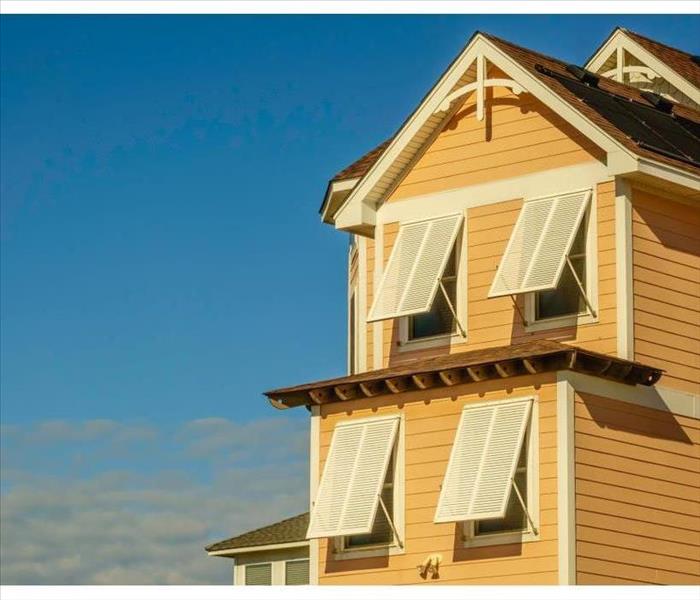 For the next storm season, invest in durable, protective shutters for your home.
For the next storm season, invest in durable, protective shutters for your home.
Storm Shutters
Sometimes it's hard to tell what preventative measures are necessary to protect your home from a natural disaster. However, high winds and hurricane damage in the past few years have cost Americans several billion, and unprotected windows can result in expensive damages:
- Broken windows
- Flooding
- Mold from water seepage
Is There Stylish Protection for My Home?
Thankfully there’s a simple solution to combating the effects of such damaging weather: storm shutters, which come in a variety of styles to fit everyone’s home décor (and budget):
• Accordion: Simple and straightforward to use, these manually folding shutters are available in strong materials like metal or polycarbonate.
• Bahama: This stylish variety not only provides protection from heavy rain and high winds, but also from the sun.
• Colonial: Protect your dream home with traditional blinds that frame your windows and add value to your property.
• Rolling: Prepare for a storm with ease with shutters that unroll or hide away at the press of a button.
How Do Storm Shutters Help?
All of these different options are permanent home fixtures that come in a range of materials, colors and designs. They’ll protect your home from flying objects, heavy rains and strong winds, so you won’t have to worry about damage to your windows or your home interior. Storm damage can be as minor as a few broken windows or as severe as flooding or mold.
Is There a Shutter for My Budget?
Most styles range between $15 and $30 per square foot of window area or anywhere between $200 to $1,000 per window. While installing storm shutters may seem like a daunting task if you have several windows, being proactive about protecting your home from high winds in St. Charles, MO, is extremely important and can save you thousands.
What if My Home Has Already Sustained Damage?
If your home has already sustained storm damage, contact restoration experts to ensure that it is thoroughly cleaned and restored. In the meantime, prepare for next season’s storms by investing in durable, protective shutters for your home.
Personal Protective Equipment for Safe Mold Remediation
7/22/2021 (Permalink)
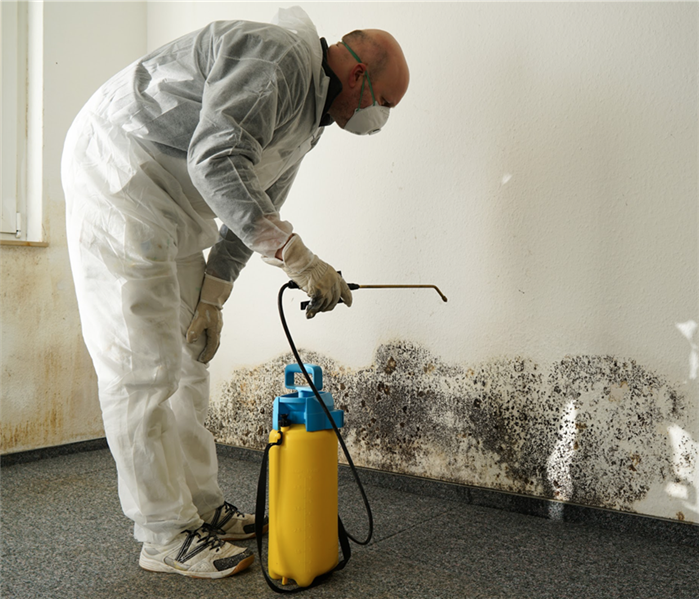 Mold remediation in Portage Des Sioux, MO.
Mold remediation in Portage Des Sioux, MO.
Mold Remediation Personal Protective Equipment (PPE)
Whether professionals are handling a mold outbreak in Portage Des Sioux, MO, or you hope to tackle the problem yourself, it is crucial that personal protective equipment is used. Cleaning up mold often involves the handling of potentially hazardous substances. Additionally, mold spores are microscopic and could become airborne or transported from one area to another during clean-up. The right equipment could prevent this and protect other areas of the property.
Items of personal protective equipment include:
- Disposable hair covers
- Safety goggles
- Air-purifying respirator
- Tyvek suits or clothing that can be immediately and appropriately laundered
- Disposable gloves
- Disposable shoe covers
Full Containment
While your property is in the process of remediation, containment is necessary to protect unaffected areas from new mold growth. There are several containment methods approved by the EPA, both full and limited. Full containment may occur when contamination of an entire building requires that layers of the wall are removed. Appropriate containment prevents the transfer of mold colonies into areas of the building that have already been treated.
Limited Containment
Limited containment could simply require a sheet of 6-mil fire-retardant polyethylene with a slit entry and flap. This sheeting may be held in place by duct tape. In many cases, containment also involves sealing off doors, pipe chases, and air vents to keep mold away from other areas of the property. Remediation experts have access to these materials and others used for containment.
Air Purification
Some air purifiers can be used to remove mold spores or at least remove odors that are caused by mold. If this method of controlling mold contamination is used to protect your Portage Des Sioux, MO, building, it's best to choose a filter that uses approved technology and is in compliance with established standards. Remember that these purifiers don't provide mold remediation; instead, they are a tool for prevention.
Top 5 Causes of House Fires
7/21/2021 (Permalink)
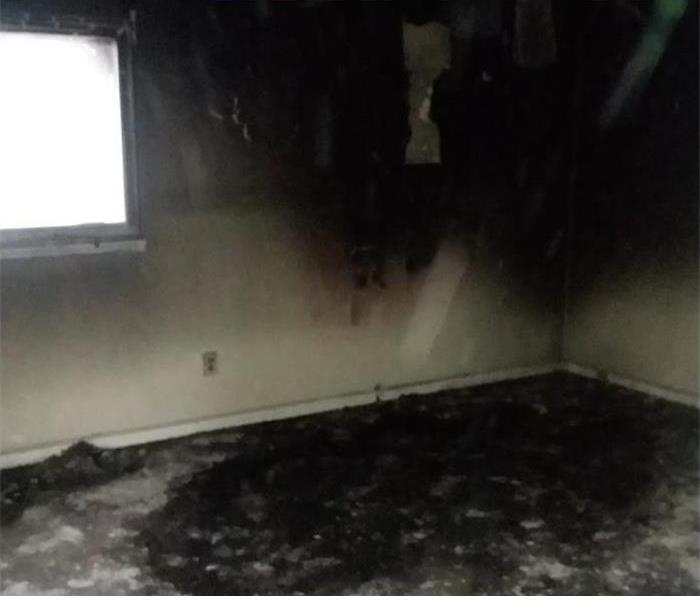 The best way to protect your own safety and reduce fire damage at your home is to know the common causes of home fire and how to prevent them.
The best way to protect your own safety and reduce fire damage at your home is to know the common causes of home fire and how to prevent them.
The Top 5 Reasons for House Fires
Every 86 seconds, fire departments across the United States respond to residential fires. As a homeowner in St. Peters, MO the prospect of a home fire is terrifying. Help prevent fires in your home by knowing the top five fire causes:
1. Cooking
Leaving cooking unattended is the leading fire cause in homes. The risk is increased with frying and attempting to extinguish the blaze without assistance from firefighters. Never leave your home with food cooking in the kitchen. If a fire starts, call 911 before attempting to put out the flames.
2. Smoking
The majority of house fires instigated by smoking involve bedding and upholstery. If you smoke, go outside if possible. Never smoke in bed or near flammable fabrics, especially when tired.
3. Heating
When heating is the reason for a home fire, it is commonly due to space heaters or wood stoves. Reduce your risk by turning off these devices when you are asleep or not at home. Furnace maintenance can help prevent fires due to central heating.
4. Electrical
Failures with electrical equipment or lighting cause 9-13% of residential fires. Check your cords, plugs, outlets and light fixtures for damage and repair or replace as needed.
5. Arson
There is little you can do to prevent a fire that is set intentionally. About half of this type of fire is set by children and adolescents.
The best way to protect your own safety and reduce fire damage at your home in St. Peters,MO is to know the common causes of home fire and how to prevent them. In addition to the above information, keep at least one functioning smoke detector at each level of your home. If possible, install a home sprinkler system. Have and practice an escape plan with your family in case of a fire. After a fire, contact your insurance agent and a fire restoration specialist to begin the process of smoke and fire cleaning.
How To Identify Category 3 Water Damage
7/13/2021 (Permalink)
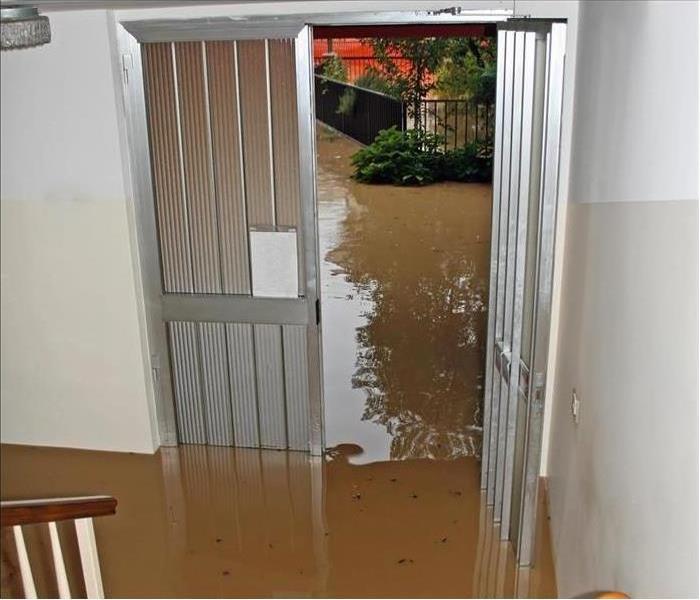 Flooding caused by rain in O' Fallon, MO
Flooding caused by rain in O' Fallon, MO
Learn How To Identify Black Water and Clean Up This Type of Damage
Category 3 water is highly contaminated. Insurance companies and restoration experts use this categorization to describe water that may contain chemicals, pathogens, and solid waste. This category of water calls for sewage cleanup. Identify the Source
The third category of water damage differs from the first two categories in terms of its origin. Category 1 water is clean, treated, and comes from a supply pipe. Category 2 water is contaminated, but does not contain solid waste. Category 3 water is a result of:
- Flooding caused by rain or rising bodies of water
- Sewer backups
- Water left standing for long periods of time
If water in a residence comes from any of these sources, it is very likely contaminated. Cleanup methods will depend on the amount of solids present.
Determine the Consistency
The fastest way to eliminate standing water is to use a pump. Some pumps can extract solid waste in addition to water. Homeowners will probably need to rent a pump or hire a water damage cleanup company. Solids in this category of water may include:
It is necessary to remove all standing water and solids. Homeowners or cleanup professionals should wear personal protective equipment when dealing with contaminated water.
Clean and Disinfect
In addition to cleaning, it is also necessary to disinfect areas exposed to black water. Mitigation professionals often perform several phases of cleanup, including:
- A disinfecting pre-treatment
- Tearing out
- Cleaning
- Disinfecting
Carpet and drywall should be torn out and replaced, as it is difficult to completely disinfect porous materials. Professionals can recommend the best approach to clean and restoration.
Homeowners should hire a sewage cleanup company to remove black water from a residence in O'Fallon, MO. Quickly completing the mitigation process may limit primary damage and reduce the risk of mold.
Preparing Your Business for a Flood
7/13/2021 (Permalink)
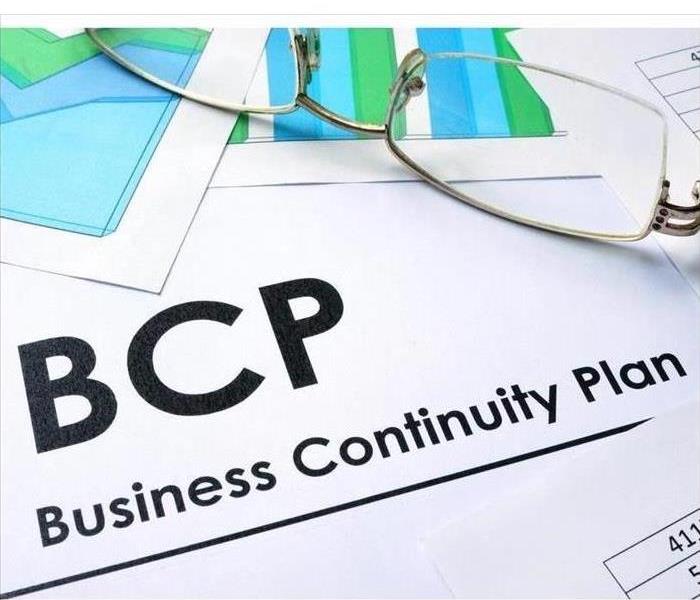 Have a continuity plan
Have a continuity plan
The Following Steps Can Help You During an Emergency
You never want to deal with a flood in the workplace, but it's something you should be ready for just in case. Making a plan now can spare you and your business a great deal of grief and heartache in the future. There are effective methods of both reducing the risk of flooding and of keeping your company going if water does make its way into the building.
Prevention
If your office is located in an area of Weldon Spring, MO, where floods are more common, you should take steps to minimize flood damage. You can't stop heavy rains from coming down and overflowing nearby waterways. However, you can do some of the following:
- Make sure all pipes are free of cracks and leaks.
- Make sure rain gutters and downspouts send water away from the building.
- Install backflow valves in the sewage system.
What To Do About Data
Your business has sensitive information on servers, external drives, and computers. Flooding can cause irreversible damage to electronics. If you have not backed up financial data, important files, personnel records, databases, and other critical information, now is the time to do so. Use cloud-based sites to store all your digital information. For paper records, scan in files and secure them on online storage sites.
Have a Continuity Plan
If flood issues such as black water make it difficult or impossible to conduct business from your building, you need to have something in place where you can continue running your operations. Ceasing your business until professional cleanup crews make your building safe could cost your customers and production. Make it possible for people to work remotely during the restoration process. Have a satellite office where you can manage the affairs of the company.
Implement these strategies today so if flooding does occur in your building, you'll know how to act. These steps can help you during an emergency.
4 Ways To Keep Your Pet Safe During and After a Home Fire
7/6/2021 (Permalink)
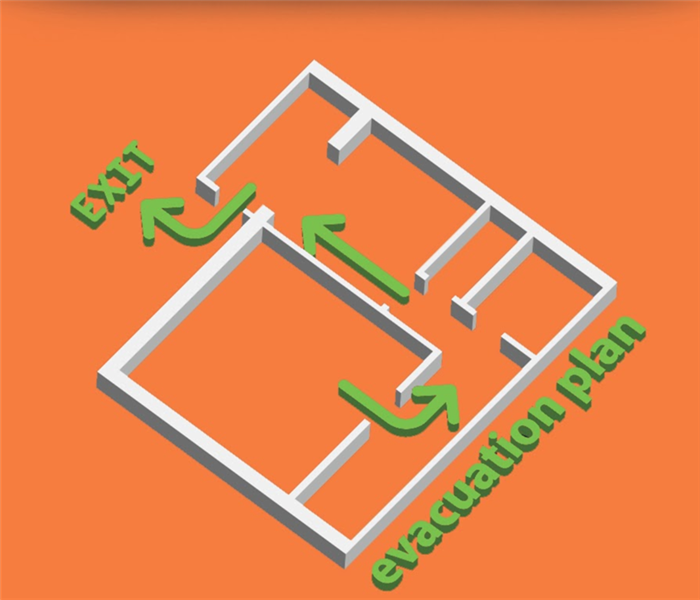 Remember to include your pet in your evacuation plan.
Remember to include your pet in your evacuation plan.
Four Ways to Protect Your Pet During a Fire Emergency
No homeowner wants to go through a home fire. While you can likely replace or repair damaged belongings, you can’t bring pets back to life.
1. Develop a Pet-Evacuation Plan
Like most pet owners, you consider your cats and dogs to be part of the family. As such, you need to include your pets in your evacuation plan. First, find out where your pets prefer to hide. Often, pets seek refuge in these places during emergency situations. Also, if you can do so safely, try to carry pets with you when you evacuate. Don’t forget to collar and leash them, though, as you may be away from the safety of indoor space for hours.
2. Keep Pet Records in an Accessible Place
Fires can be unbelievably destructive. While you may primarily worry about vital and financial documents, you can’t forget about pet records. When you are planning for a fire emergency, store veterinary and other information in a fire-safe box. Then, locate the box in a place where you or a fire-restoration specialist can easily find it.
3. Locate a Safe Spot
As you may know, not all emergency shelters welcome pets. Therefore, your pet preparation must identify a safe spot where your furry friends can stay temporarily after a fire. If your strategy includes staying with family members or friends, confirm that no one has pet allergies.
4. Prevent Pets From Starting Fires
Pets are often responsible for starting fires in St. Peters, MO. While you must have a plan for keeping your pets safe during a fire, you can decrease your chances of having a home fire by keeping open flames away from wagging tails. Additionally, hide wires to discourage your pets from chewing through them.
Ensuring pet safety during a fire requires a bit of preparation. With some effort, though, you can be certain your pets will survive a fire emergency.
How To Keep Your Washing Machine Smelling Fresh and Clean
6/15/2021 (Permalink)
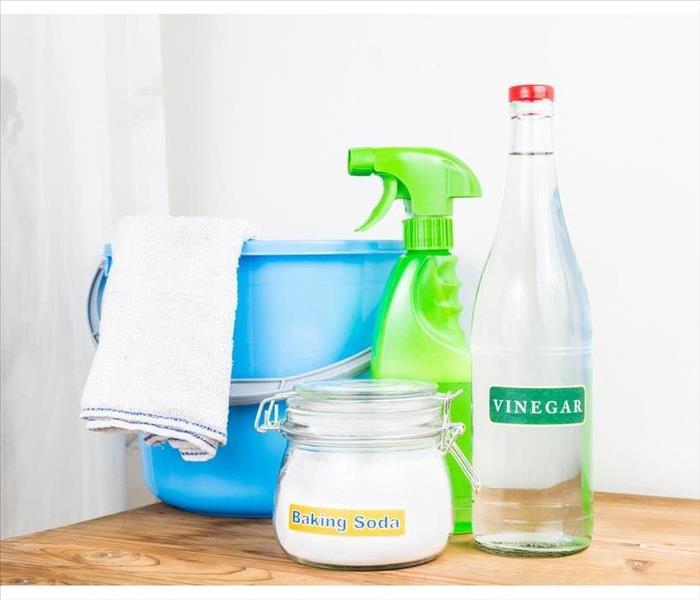 The mixture of baking soda and vinegar should eliminate the smell from your machine.
The mixture of baking soda and vinegar should eliminate the smell from your machine.
How To Keep Your Washing Machine Smelling Fresh and Clean
Have you ever unloaded your washing machine, only to be overwhelmed by a moldy, mildewy odor originating from your appliance? If so, you are not alone. Front-loading washers, while water-efficient and highly effective, are perfect breeding grounds for mold and mildew. This problem is related to the fact that the drum fills only halfway with water, typically not enough to rinse away the remaining detergent. Therefore, the residual soap scum traps dirt and lint under the gasket, producing an unpleasant and offensive odor. If you're looking for ways to keep your front-loader clean and smelling fresh, read on to learn some handy and helpful tricks.
Eliminate the Smell
While bleach is a powerful agent that can potentially disinfect your washer, natural, healthier solutions exist as well. To ban a mold smell in your front-loader, gather a few household items:
- Distilled white vinegar
- Baking soda
- Nylon brush
In St. Charles, MO, place one-fourth cup of baking soda and an equal amount of water in your washer's detergent container. Add two cups of white vinegar to the drum, and run an empty washer on a high-heat cycle. The mixture of these two ingredients should eliminate any foul smells coming from your machine.
If pesky spots remain following the cleaning cycle, attack them with a nylon brush and an extra squirt of vinegar. In extreme cases, professional mold remediation specialists can assist in stubborn mold and mildew removals.
Maintain Freshness
Once your front-loader is clean, make sure to maintain its freshness so that it can efficiently and dutifully clean your dirty laundry in the future.
First, make sure to use appropriate laundry detergent for your high-efficiency washing machine. If you attempt to use conventional detergent, it will produce too many suds, resulting in a stinky washer. Further, liquid detergent is a no-no for high-efficiency washers, so ditch it in favor of dryer sheets or fabric softener balls.
Finally, thoroughly dry the drum following each cleaning cycle. With no moisture or humidity present, mold and mildew will have nowhere to breed and multiply.
Keep your washing machine clean and mildew-free by following these helpful tips, and enjoy fresh-smelling laundry for years to come.
4 Things You Should Know About Cleaning Smoke Damage
5/24/2021 (Permalink)
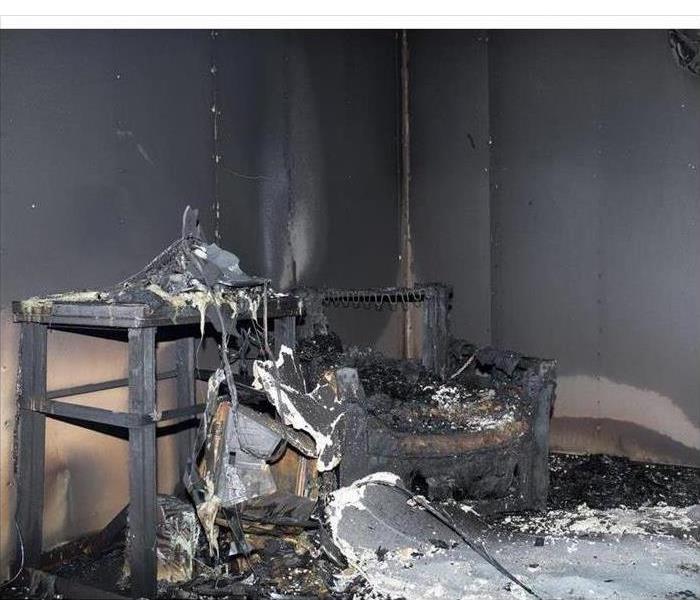 Fire and smoke damage in a St. Peters, MO home.
Fire and smoke damage in a St. Peters, MO home.
Four Things To Keep In Mind After A Fire Strikes
A home fire is one of the most common troubles to befall homeowners and renters. The extent of the fire determines the plan for recovery and restoration. Even a small fire, though, often results in a significant amount of damage to the home and to your belongings. The good news is that a qualified fire mitigation team has the resources to help no matter the situation. The technicians might recommend dry-cleaning of some items, particularly clothes, to get out smoke odors. Here are four things to keep in mind after a fire strikes your home in St. Peters, MO.
1. Content Cleaning Is Important. Many of your belongings will get damaged in a fire. This includes clothes, paintings, furniture, and even computers. A professional company has the equipment and skills needed to restore many items to good shape again, thus saving you money. In general, the technicians will use dry-cleaning for clothes and ultrasonic methods for non-porous items such as televisions and wooden desks and bookcases.
2. Content Storage May Be Needed. If the fire damage to your home is extensive, it is possible items will need to be moved to another area for protection. An orderly move-out and move-in process protect your valuable belongings from additional damage.
3. An Odor Control Technician Will Be Used. Smoke damage is often pervasive and persistent. To get your home clean, a highly-trained technician will use state-of-the-art equipment to remove smoke odors from walls, furniture, and belongings.
4. The Process Is Complex. A number of methods may be employed to get your home back in order again after a fire. The following cleaning methods are available from a professional team: dry-cleaning, immersive cleaning, foam cleaning, abrasive cleaning and spray and wipe options. All of these options allow for a better cleaning of your items as well as the option to restore many items instead of throwing them away.
What To Put in Your Commercial Building's First Aid Kit
5/18/2021 (Permalink)
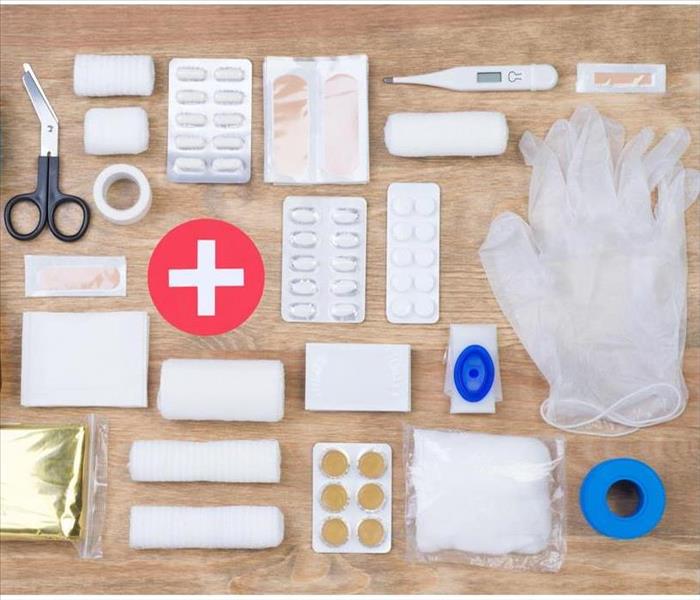 First aid kit supplies.
First aid kit supplies.
Items You Should Purchase For Your Kit
Every commercial building owner needs a first aid kit. In fact, the Occupational Safety and Health Administration requires businesses to keep one of these kits on the premises at all times. The items in the kit can be used to treat a variety of injuries, such as:
- Cuts
- Sprains
- Scrapes
- Burns
While these types of ailments can occur at any time, they are particularly common during storms and other emergencies. Making sure your kit is fully stocked is thus a key part of disaster preparation. Below are some important items you should purchase for your kit.
Basic Essentials
No matter what type of business you own, OSHA-compliant kits must include a box of Band-Aids, a splint, latex gloves, a pair of tweezers, scissors, adhesive tape, disinfecting pads and two triangular bandages.
OSHA also requires other items that may not immediately come to mind. For instance, you need to put a blanket in your first aid kit. This could keep a hypothermic employee warm during a winter storm before first responders and emergency restoration professionals arrive at the scene.
In addition, you may not know that the gauze in your emergency kit needs to be a certain size. To meet OSHA regulations, the tape must be at least 2 inches wide, and the pads must include 4-by-4 inch and 8-by-10 inch varieties.
Business-Specific Items
You may also want to put items in your kit that your specific business could need. For instance, if you own a childcare center, you can pack kid-friendly bandages and adhesive tape for dressing infant cuts.
Meanwhile, if an earthquake or windstorm hits a restaurant, hot food could go flying and cause severe burns. If you own an establishment that serves food, you should thus keep plenty of burn dressings in your kit.
A storm can cause lots of damage to your Portage Des Sioux, MO, property. The shattered glass and broken desks could injure your employees, as well. With a full first aid kit, you can provide immediate medical assistance to hurt workers until help arrives.
How To Clean Electronics After Smoke Damage
5/6/2021 (Permalink)
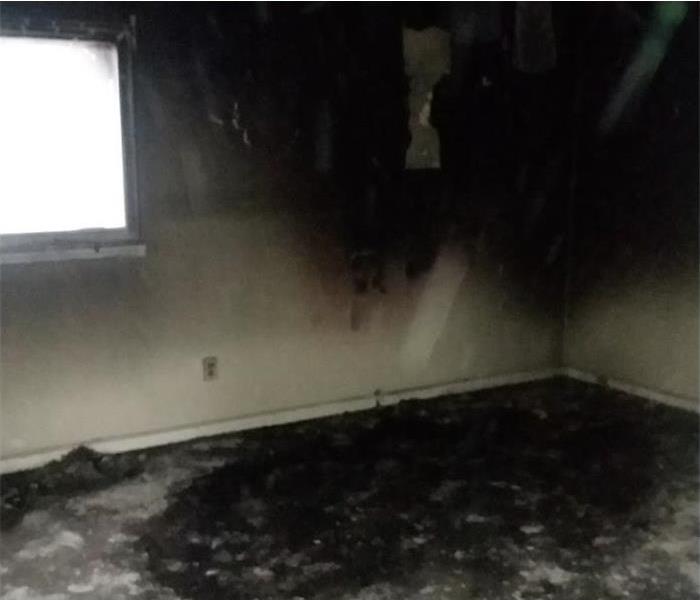 Smoke damage in Weldon Spring, MO.
Smoke damage in Weldon Spring, MO.
When you have an electrical fire at your business, you might think that cleaning up burned items is the end of it. Unfortunately, this is not true. Smoke can be worse than fire when it comes to your electronics.
Types of Smoke Damage
There are three basic types of smoke damage. These are:
Soot - This acidic substance coats the outside and inside of most electronics. It can shorten the life of your wiring considerably.
Magnetics - Smoke carries a mild electrical charge. This charge can short any electronics that are on during the fire.
Film - Smoke leaves behind a black film on everything that it gets near. This can cause your electronics to overheat if you turn them on before cleaning them.
Each of these types can cost you thousands of dollars if you do not properly clean your electronics after a fire, even if they look undamaged at first.
When To Call In Professionals
Cleaning electronics often requires taking them apart and cleaning individual wires and components. If you are not comfortable doing this, call in a professional cleanup company in Weldon Spring, MO. They might even perform this service as part of an overall electrical fire cleaning.
What You Can Do
Although it is not recommended that you clean major appliances, television sets or electrical panels, there are some things that you can do to make it easier for the professionals. The first thing you do unplug everything. This will allow any residual charge inside the item to dissipate. Small items can be taken apart and wiped down but larger more expensive items require a bit more.
For computer cleanup, take off the case and inspect the inside. If you are comfortable, remove the hard drive and take the data off it by hooking it to an undamaged system. If you are not, a computer expert can help you with this. Be sure to tell them the computer was damaged in a fire.
An electrical fire, like any fire, can be dealt with. All you need to do is make sure that your electronics are properly cleaned and serviced to get them back in working order.
How to Develop a Business Continuity Plan After a Storm
4/7/2021 (Permalink)
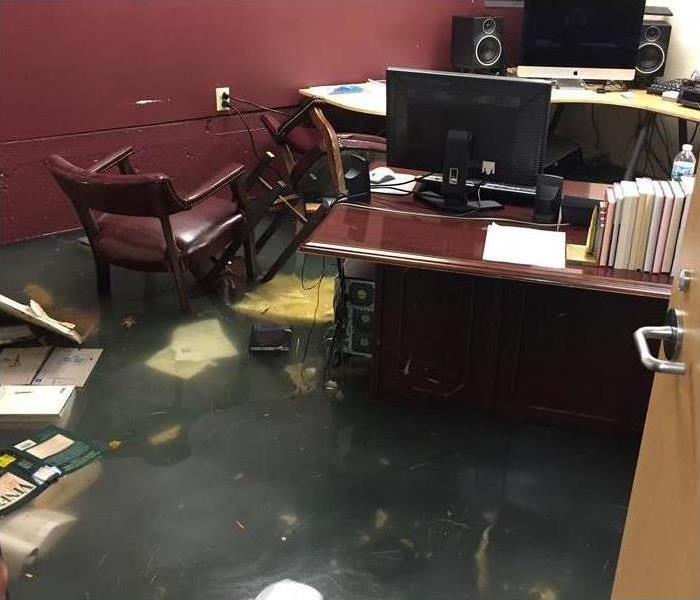 Flooded office in O'Fallon, MO.
Flooded office in O'Fallon, MO.
Prepare Your Business For A Storm
Storms and flooding can strike very suddenly in O'Fallon, MO. While some predictions can be made about widescale storms, others come without warning, and the results can be a disaster for a community – and spell bankruptcy for a business.
Fortunately, you can act proactively and prepare for problems. There are three critical steps to build resiliency in your business:
- Get a commercial insurance policy.
- Develop a continuity plan.
- Keep key personnel informed.
Know Your Insurance Coverage – and Its Exemptions
Insurance policies can be confusing. Make sure you ask your agent about what is and isn’t covered. If you want flood coverage, you’ll need a separate flood policy https://www.fema.gov/flood-insurance .
Establish a Business Continuity Plan
The U.S. Government maintains a website to help citizens and businesses prepare for disasters. They have a detailed description of how to develop your plan, beginning with the business impact analysis.
This starts with a risk assessment to determine what’s high risk for your location and type of business. Are you in a high-risk flood zone? Do you rely on digital information or is everything local? Which natural disasters are most likely?
Which Disaster Is Most Likely – or Most Harmful?
Aim for the most probable disasters based on your BIA. For disasters unlikely in O'Fallon, MO, it may not be worth detailed planning, but general disaster planning can have wide-reaching benefits, even in unforeseen situations.
Key Personnel Should Be in the Loop
The key to resiliency after getting storm damage is to get reopened as soon as possible. Most small businesses will fail within two years if they’ve been closed for more than a couple of days after a disaster. Immediately after the storm, every essential person should be contacted and information shared.
You need to discuss what resources you need to reopen as fast as possible after the storm passes. Calling a commercial restoration specialist immediately after a storm can also be the difference between surviving the disaster and never reopening. Speed is essential, so your restoration company will work with you to get reopened as soon as possible.
With an established continuity plan and good insurance, you can survive the storm and get back to business quickly. Every day you’re closed increases your risk of staying that way.
Protect Your Home After a Fire
3/25/2021 (Permalink)
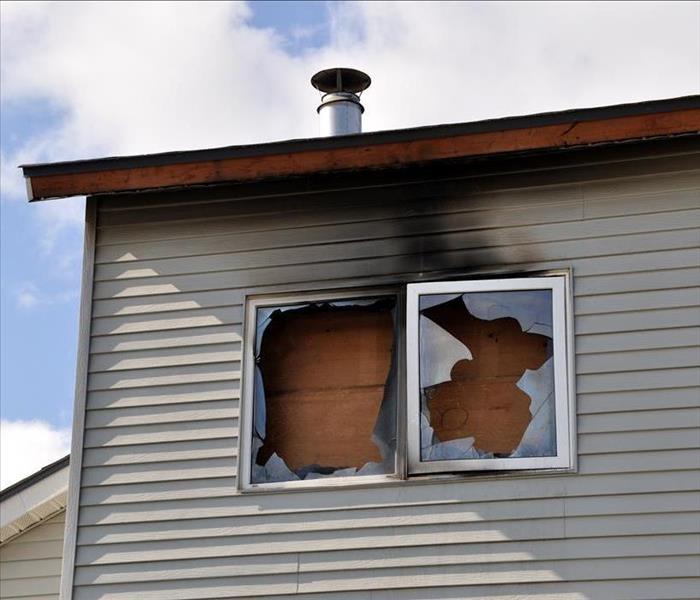 Boarded home after fire damage in St. Peters, MO.
Boarded home after fire damage in St. Peters, MO.
Protect Your Home After a Fire
After your home in St. Peters, MO experiences a fire, the process of returning to normal may seem like a long journey. While a fire damage and restoration specialist will repair, replace and restore it back to its former glory, you still need to protect your home before help arrives. In many cases, windows and other damage happens while extinguishing the flames leave your home exposed. To avoid secondary damage, it is recommended to board up any high-risk areas.
Minimize Risk
While your focus may be on the losses incurred from fire and smoke damage, that isn’t the end of potential risks. An emergency board-up helps in more ways than one.
Insurance Coverage Validity: After experiencing a loss, you want to get the most out of your insurance coverage. The longer you wait to cover existing damage, the higher the chance that additional damage will occur. In many cases, that added damage won’t be covered.
Keep Nature at Bay: Any exposed areas are an instant source of further problems. From wind to water to critters, existing issues may easily become much bigger.
Prevent Property Loss: While the fire may have destroyed or damaged many of your belongings, there is still valuable property inside the home. A boarded-up home helps prevent vandals or thieves from entering and looting.
Reduce Liability: The fire may have created structural damage. If people enter it and get it injured, you will be liable for the injuries.
Services Available
Since every situation is different, so is the type of solution that may be needed. If windows or doors are broken or cracked, a simple board-up will prevent trespassers from entering. If there is roof damage, installing a tarp over the affected area will prevent Mother Nature from wreaking unwanted havoc. In many cases, using both is the best option to get the most coverage possible.
The sooner you board up exposed areas, the better chances you have at getting your home back to “Like it never even happened.”
How To Prevent Water Damage in Your Home
3/12/2021 (Permalink)
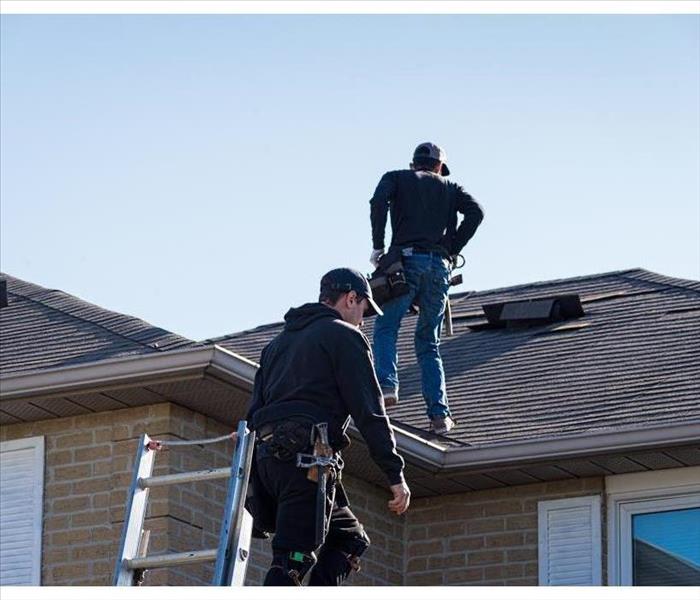 Roof inspection in a St. Charles, MO.
Roof inspection in a St. Charles, MO.
Common Locations For Water Damage
Water in a home is a devastating condition. Burst pipe cleanup, in particular, can require extensive restoration. Yet, even small leaks can cause thousands of dollars in damage to your St. Charles, MO, house. Luckily, you can prevent many water losses by performing basic inspections of your plumbing system. Here are some common locations for water damage and how you can keep them dry.
1. Water Heater
Most water heaters last 10 to 15 years. If your heater is older than that, you should replace it before it breaks down. You should also keep the heater in a basement or garage. This way, if it does leak, it will not cause as much damage. Since even a tiny amount of water in a home can be harmful, you should check the heater frequently.
2. Ceiling and Roof
Similarly, the roof of your property should be inspected for holes or other potential issues. Usually, by the time you notice a puddle of water on the ceiling, the liquid has already caused a ton of damage. A licensed professional should know how to spot leaks before they become visible.
3. Pipes
Many water problems are caused by a broken pipe. This often takes place during the winter months when pipes are known to burst. Keep your pipes as warm as possible. You can even purchase leak detection systems that will shut off your plumbing system if a malfunction occurs.
4. Air Conditioners
While air conditioners are incredible inventions, they are prone to water leaks. The drip pan, in particular, can overflow. Maintenance checks are thus a must. You should schedule them for the spring to ensure the system is working properly during the high-usage summer months. Leak detectors can help here, as well, especially for air conditioners in tough-to-reach locations.
Water in homes is a largely preventable problem. By performing proper maintenance and hiring professionals to conduct inspections, you can protect your beloved house.
Do You Have This Certain Type of Pipe? You May Be in for Unnecessary Sewer Cleanup
2/23/2021 (Permalink)
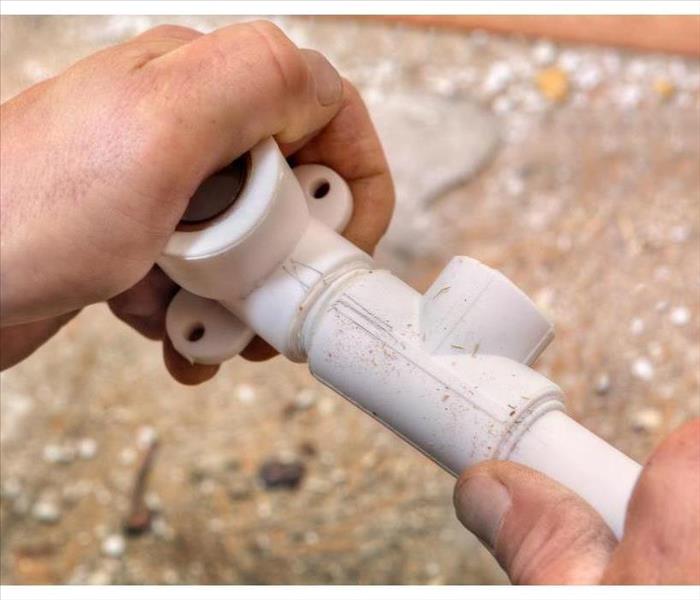 Do you have polybutylene pipes?
Do you have polybutylene pipes?
If the pipes in your commercial building were manufactured between 1978 and 1995, you may be in for some imminent sewer cleanup. Polybutylene pipes were used during that time period in place of copper pipes. They were less costly and easier to install. What's not to love? Well, there's a reason manufacture stopped in 1995. However, PB pipes are still commonly found in sewer systems that may lead right into your place of business.
Do You Have Polybutylene Pipes?
There are a few problems with this particular type of pipe:
- They are chemically reactive, breaking down when exposed to common cleaning agents.
- PB pipes can become brittle and crack over time.
- This can lead to leaks, backing up the sewers.
- These pipes are sometimes uninsurable.
To determine if you have PB pipes, you need to do a little digging. Leave the physical excavating to the experts, but if you can find a pipe coming out of the ground near your building's water heater, sink, or toilet, you can check for classic signs of a PB pipe. It will most likely be blue, black, or gray and one-half to 1 inch in diameter. These are good indicators that you have PB pipes in your sewer system.
However, there may be visible copper pipes and poly pipes hiding underground, closer to the water meter. If you don't want to go full-on detective mode on your pipes, it's OK to contact a sewer expert. Especially if there are any signs of sewer backup, such as a flooded toilet, it's advised to contact these professionals as soon as possible.
How Can You Prepare for Sewer Cleanup?
Preventing water damage from sewer backup issues starts with finding the right insurance coverage. It's harder, but not impossible, to cover PB pipes. Once you find adequate coverage, you will need to find trusted, insurance-preferred remediation experts in Portage Des Sioux, MO, to have on deck if and when disaster strikes. Even if you have this type of pipe, having a restoration plan makes for easier, cheaper sewer cleanup.
The Step Businesses Cannot Forget To Take Before a Storm Hits
2/23/2021 (Permalink)
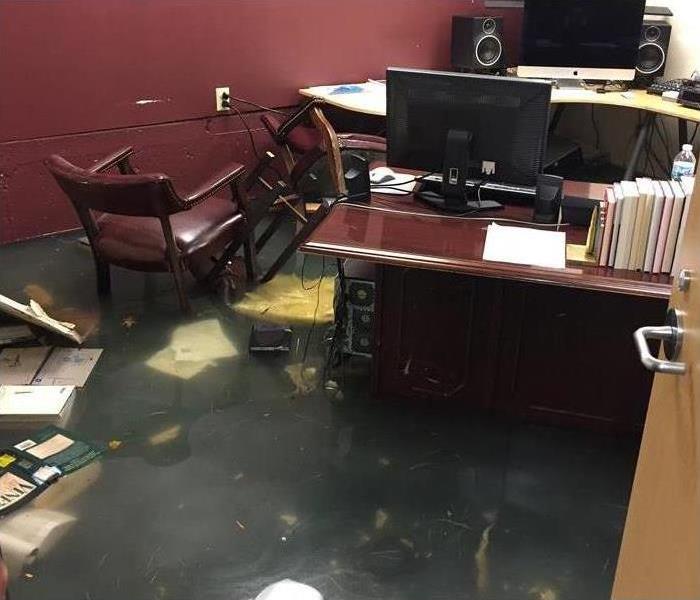 Flood damage in a St. Charles, MO office.
Flood damage in a St. Charles, MO office.
There's no way to predict the exact catastrophic loss that will occur after extreme weather. However, you can look at the historical data. Billions of dollars in the U.S. are spent yearly due to widespread damage from natural disasters. This gives an inside look into just how devastating a large-scale disaster can be. Particularly, if you run a commercial business with several franchises in a storm-prone area, it's best to be prepared.
Types of Damages That Occur
The Bureau of Economic Analysis defines catastrophic loss as any event that causes greater losses than usual. This can include hurricanes, flooding, extremely cold weather, tornadoes, wildfires, and more. Some of the aspects of commercial businesses most affected are:
- Physical structures
- Income sources
- Depletion of goods
- Employee health
- Financial standing
- Document destruction
This is just the beginning. Storm damage can cause long-lasting effects if not tended to promptly and properly.
Professionals That Mitigate Damages
While you can't predict the future, you can plan ahead for storm damage. There are structural and financial steps to take, but there is one crucial element of storm preparedness that cannot be overlooked. Get in touch with an insurance-preferred disaster recovery team that can respond quickly and efficiently if and when disaster strikes. SERVPRO sends many locations to a storm area to help rebuild faster. The best experts across the country are sent to the site, not just the local team in St. Charles, MO.
What You Should Avoid
While SERVPRO operates 24/7 and will get the experts to the affected area as quickly as possible, there are things that you can do to reduce damages in the meantime. You should avoid:
- Any suspected water contamination
- Operating electrical machines near water
- Keeping affected food, even canned goods
You should wear protective clothing and shoes at all times and try to wipe up water from surfaces where you can safely do so. Watch for mold growth. Catastrophic loss is never pleasant, but it can be less devastating with the right plan in place.
3 Tips for Avoiding Mold Growth in Your Restaurant's Kitchen
2/2/2021 (Permalink)
 Keep your food mold-free
Keep your food mold-free
3 Tips for Avoiding Mold Growth in Your Restaurant's Kitchen
Running a restaurant in Weldon Spring, MO, can be incredibly enjoyable, but there are some issues you might encounter. One to watch out for is mold growth in the kitchen, which is essential to avoid if you're selling food. If you're wondering how to prevent this, here are three tips for avoiding mold in your restaurant kitchen.
1. Watch Your Food
One of the main ways a restaurant can attract mold growth is through its food. If your food is damp and unprotected, it could begin to get fungal spores. This can eventually result in rotten supplies, so keeping a sharp eye on your ingredients is essential. If you do find fungus, throw out everything that has it. Although it may be tempting, don't save supplies by cutting away the moldy area. Here are some tips for keeping your food mold-free:
- Get fresh supplies regularly
- Keep storage areas clean
- Inspect items that were near the mold
- Focus on your fruits and vegetables
2. Avoid Humidity
Humidity is an almost sure creator of mold, so avoiding it is crucial. This is especially important if you live in a climate with high humidity or your store is outdoors. If you can get your levels between thirty and fifty percent indoors, you'll be fine. Otherwise, you might want to invest in some dehumidifiers.
3. Use Ventilation
Ventilation is crucial to reducing humidity. Essentially, it keeps humid air from remaining in place. It also prevents water damage from the accumulation of moisture. Therefore, you'll want to be sure that you have the right ventilation for your space. Even if you want to save money, don't get a small system if you have a large kitchen. Avoiding mold is worth the investment.
If you stay vigilant, you can protect yourself against major mold growth in your restaurant's kitchen. In the event that you find some, a mold remediation company can get rid of it.
The Dangers of Black Water
1/15/2021 (Permalink)
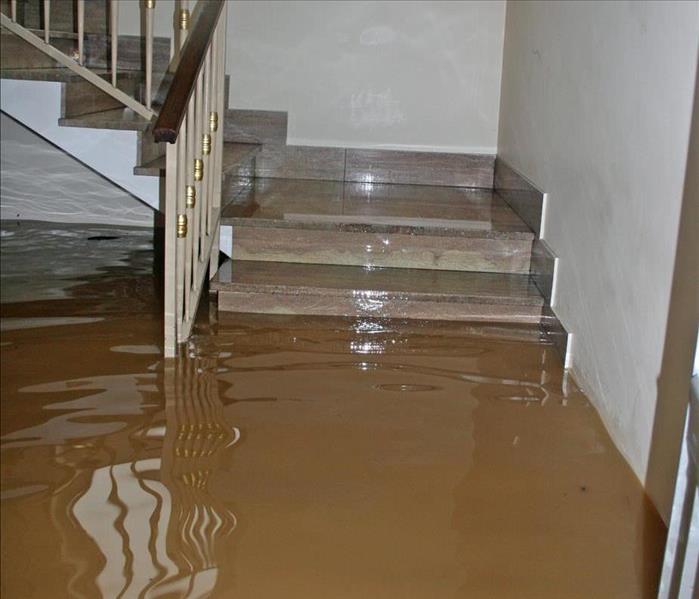 Flood damage to a home in O'Fallon, MO
Flood damage to a home in O'Fallon, MO
Water is categorized into the colors white, grey, and black depending on the substances it contains or has been in contact with. Blackwater is the most dangerous and can cause the most water damage.
What is Black Water?
This category of water can contain:
- Urine
- Feces
- Toilet paper
- Toilet water
- Pathogens
- Cleansing water
It usually comes from toilets and is more commonly referred to as sewage. It is more dangerous than greywater, which usually comes from sinks and appliances, and white water, which is considered pure or clean.
What are the Dangers?
This water carries bacteria and other pathogens that can be harmful. You should avoid any contact with contaminated water. A flood of this category will likely result in more water damage because anything it touches should be considered contaminated. This means items such as carpet, rugs, curtains, and clothing must be disposed of or thoroughly cleaned by a professional. It is also more difficult to clean since using fans or heating systems to dry the area can spread potentially harmful pathogens. Like all flooding, it can also cause molding if it is not properly treated.
What Should You Do?
If you have any contaminated water in your home, you should contact an emergency restoration service in O'Fallon, MO, immediately. They will be able to remove the sewage, dry the area, repair structural damage, and treat the area to prevent molding. They may also be able to clean and restore any belongings that were damaged or contaminated in the flood.
You should not try to clean up the water on your own, as you may expose yourself to harmful substances. Professionals will have appropriate protective gear that allows them to clean it up safely.
Blackwater contains potentially harmful waste and microorganisms and can result in a high amount of contamination and water damage. Floods of this category should always be treated by a professional in O'Fallon, MO.
Steps To Follow When Fixing a Leaky Compression Faucet
1/3/2021 (Permalink)
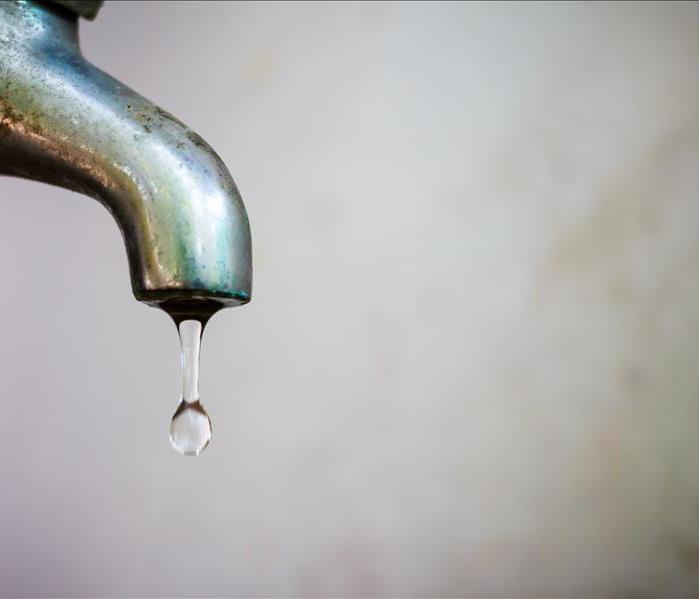 A leaking faucet is easy to fix if you follow these simple steps
A leaking faucet is easy to fix if you follow these simple steps
A leaking faucet usually indicates that an internal part has worn out. The most common type of faucet is the compression faucet, which has two handles that are screwed into place. One handle is for cold water, the other for hot water.
Let's Take a Look At the Steps Involved In Fixing a Leaky Compression Faucet
1. Shut the Water Off
The pipes underneath your sink will have shut-off handles. Twist them clockwise to shut the water off.
2. Cover the Drain
If you have a sink plug, push it down to plug the sink. If you don't have one, cover the opening with a towel or clean rag. This will prevent any washers or screws from falling into the drain.
3. Remove the Handles and Nuts
Unscrew each handle of the leaking faucet, and pull straight up to remove. Using a wrench, remove both nuts.
4. Lift The Stem Out
The stem is visible once you remove the handles and nuts. Remove that and you will see the O-ring and seat washer.
5. Replace the Seat Washer or O-Ring
Seat washer - Typically made of rubber, a worn washer is the most likely reason for a dripping faucet. Unscrew the brass screw to release it.
O-ring - If the leak is coming from one of the handles rather than the faucet, the O-ring needs to be replaced.
Since washers and O-rings vary in size, it's a good idea to bring the old one along when you visit the hardware store. You should also grease the replacement parts with plumber's grease before attaching them.
6. Reconnect the Handles
After reassembling all the components, reconnect the handles. Hopefully, you will have a fixed leak. If not, it's time to call a plumber in St. Peters, MO. If you discover water damage, you should call a water damage repair service right away.
A leaking faucet is easy to fix if you follow these simple steps.
Questions About the Cost of Fire and Smoke Remediation
1/3/2021 (Permalink)
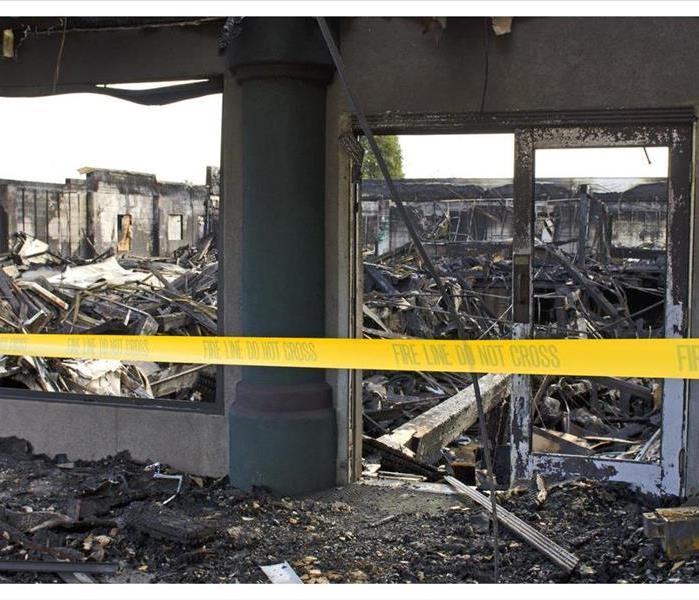 Commercial fire damage
Commercial fire damage
Questions About the Cost of Fire and Smoke Remediation
A commercial fire can cause a lot of damage to your business in St. Charles, MO. Not only will you have to deal with fire damage, but you will also have to deal with the damage resulting from extinguishing the flames. Thus, many people wonder how professional remediation companies come up with an estimate and what can impact the cost of restoration.
Does Space Matter?
While most companies do not charge you based on square footage, the size of your business matters. The larger the affected area is, the higher your estimate will be. Here are several other factors that can impact your cost:
- Water damage remediation
- Soot removal
- Burnt material cleanup
Is Smoke Cleanup Extra?
The professionals can charge hundreds of dollars extra to clean smoke. This can go higher if the smoke has been sitting for a while.
Does the Method You Use Increase the Price?
Smoke damage can be cleaned up using thermal fogging or ozone treatment. Fogging is great if you need to remove smoke from fabrics. Ozone machines are also great at removing sources of odors. They cost about the same, so the method used should not significantly impact your cost.
Is Cigarette Smoke a Factor?
If the professionals have to deal with cigarette smoke, you are going to pay extra. This type of remediation is typically a few thousand dollars. If you have a smoking section in your business, be prepared to have a very high bill.
Will You Need to Replace Your Suppression System?
You will need to replace your fire suppression system after it activates. This will add a few hundred dollars to your bill. If you have a large business, you could be paying thousands for your sprinklers to be installed.
Restoring your business can cost a lot of money. This is especially true for larger companies. The best way to know if you are getting a fair price is to understand what goes into your estimate. This means reading up on some of the most common questions about remediation services.
Three Places to Find Water Supply Lines
12/28/2020 (Permalink)
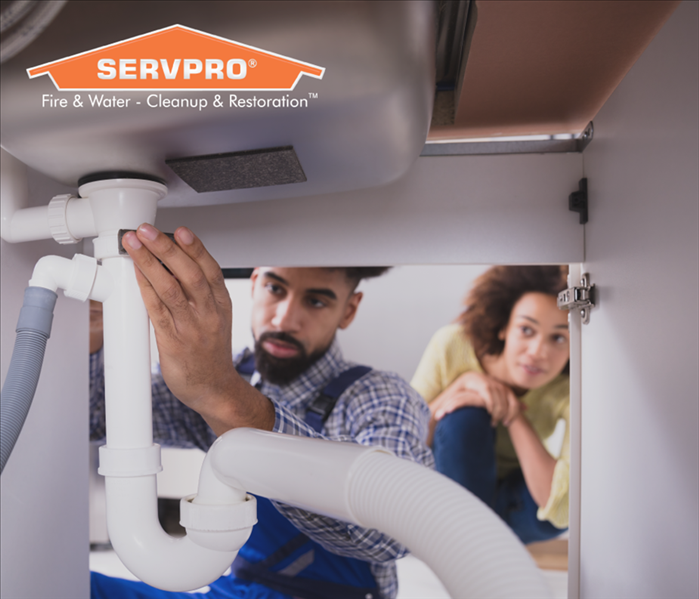 Regularly check under sinks for water buildup
Regularly check under sinks for water buildup
Three Places to Find Water Supply Lines
Water supply line damage can cause the construction materials of your home to become swollen, humid, and covered in mold. Supply lines are metal or plastic pipes that provide water to the plumbing fixtures in your home. These pipes become corroded with time and develop leaks. The common types of supply lines in St. Peters, MO, include:
- Copper
- Braided stainless steel
- Plastic
Plastic supply lines include a 5-8 year warranty and metal supply lines come with a lifetime warranty. Before purchasing a new supply line, check to see if your warranty will cover a replacement. Supply lines should be fixed immediately to prevent water damage to your home. Here are three places to find water supply lines:
The Kitchen Sink and Dishwasher
The supply line providing water to your kitchen sink and dishwasher can become corroded due to frequent use. If you find swelling wood in the cabinets underneath your sink, you likely have a damaged supply line. Replace this right away to avoid having to purchase new cabinets.
The Washing Machine
The washing machine has both a water supply line and a draining pipe that connects to your home's plumbing system. You can find this on the wall near the washing machine. This type of supply line leak may be overlooked due to the location of the pipe behind the washer. Check this area frequently for leaks to prevent your walls from prolonged exposure to moisture.
The Toilet
A toilet's supply line connects to pipes behind the wall. This is one of the most frequently used bathroom fixtures and, though the porcelain toilet could last upwards of 40 years, the parts can become corroded with time and cause a bathroom leak. This is especially true of the supply line and shut-off valve.
Water supply line damage can lead to more expensive repairs if they are not promptly dealt with. If you have water damages from a worn-down water supply line, call a water damage restoration service to help renew and dehumidify your property.
4 Ways to Keep the Mold from Coming Back
12/28/2020 (Permalink)
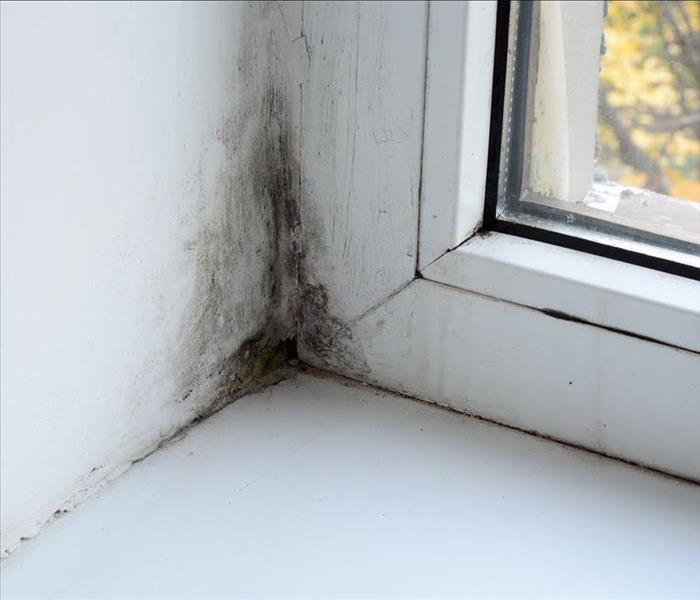 Black mold damage in O'Fallon, MO
Black mold damage in O'Fallon, MO
Make Sure Not To Do The Following Mistakes
Water damage and mold seem to go hand-in-hand. While the initial flood is relatively easy to resolve, the secondary mold damage that accompanies it might be more difficult to control. You've exhausted all of your treatment options, yet the mold just won't give up. Before you head back in to defend your O'Fallon, MO, home, make sure you're not guilty of the following common mistakes.
1. You Didn't Replace Your Water Damaged Possessions.
It can be difficult to get rid of your favorite items after they've fallen victim to mold damage. You might think that your favorite rug is clean after mold remediation, but there are probably still spores hiding in the material. As tough as it is, you're better off just replacing your items.
2. You Didn't Ventilate Your Home Properly During Remediation.
Any type of moisture can attract black mold, including moisture in the air. Next time you head in to tackle the problem, make sure you open your windows and doors to let the moisture escape. It's also a good idea to invest in some floor fans to aid with air circulation or a dehumidifier that can discourage mold growth.
3. You Didn't Remediate the Initial Damage.
If your mold problem is a result of water damage, then you have to make sure you resolve the initial problem before you engage in mold prevention. Make sure to completely clear out and dry any standing water, as well as identify and fix the source of the damage.
4. You Didn't Use the Correct Cleaning Products.
It's natural to immediately reach for the bleach when you discover a mold issue. Unfortunately, bleach doesn't actually kill the mold; it only changes the color so you can no longer see it. Instead, try mixing your own non-toxic cleaning solution using equal parts white vinegar and water.
Don't allow black mold to take up continued residence in your home. Contact mold remediation experts for assistance dealing with any persistent mold issues caused by water damage.
The Significance of Mold Containment
12/23/2020 (Permalink)
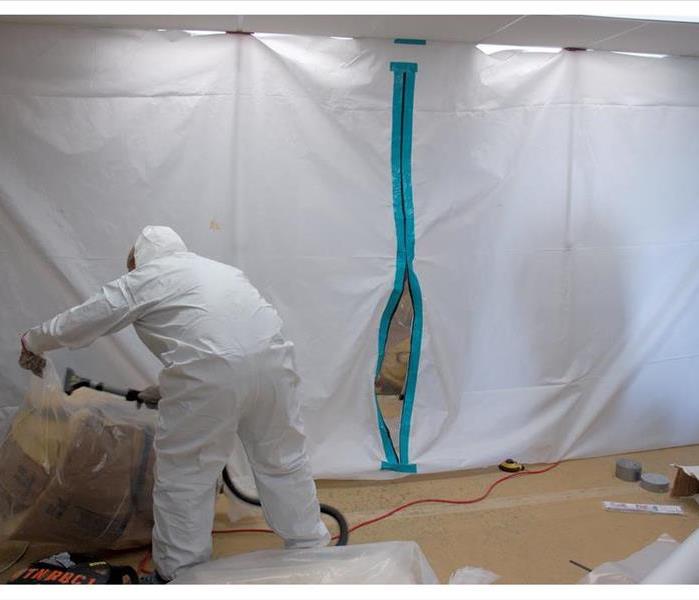 Mold remediation services
Mold remediation services
The Significance of Mold Containment
When commercial property owners in Weldon Spring, MO, find fungus growing on structures, it's imperative they begin sanitizing the area as soon as possible. Quick, do-it-yourself procedures, though, are problematic as they often leave behind spores that can breed over time. In addition, spores move easily from what area to the next. Mold cleanup, then, mandates not just disinfection, but an understanding of how to reduce reproduction and spread. A mold remediation company has the knowledge and skills to appropriately tackle and contain the situation.
How Does Mold Grow and Travel?
It's not unusual for a building to have mold spores. The organisms are a part of nature, existing outdoors as decomposers. They can move about in several ways. They enter in people's attire as well as through the airway. When the microbes meet up with dampness and organic matter, they begin to multiply. At that point, they reproduce quickly, causing issues within only a day or two. Their tiny, invisible nature and easy ability to migrate means that they can move from space to space.
How Is Mold Isolated?
Mold cleanup procedures seek to reduce the risk of proliferation. This means eliminating wetness, restricting access, and preventing air circulation. After the initial source is fixed, professionals should complete the following steps:
- Turn off the air condition
- Dry puddles
- Run dehumidifiers
- Use negative air chambers
- Wear protective clothing
- Block off the entrances and exits
These actions prohibit organisms from interacting with materials in other locations as well as continuing to grow within the affected section.
How Is Mold Contamination Financially Important?
When early stages do not focus on minimizing fungus, the situation can get out of hand. The cost of repairs may be more as additional work gets completed. The restoration, at that point, might mean further tear-outs and more technology.
Early intervention is key. Mold cleanup isn't just removing sports from a wall. It's a meticulous operation that begins with stifling spores.
What Is A Certified Water Damage Specialist?
12/23/2020 (Permalink)
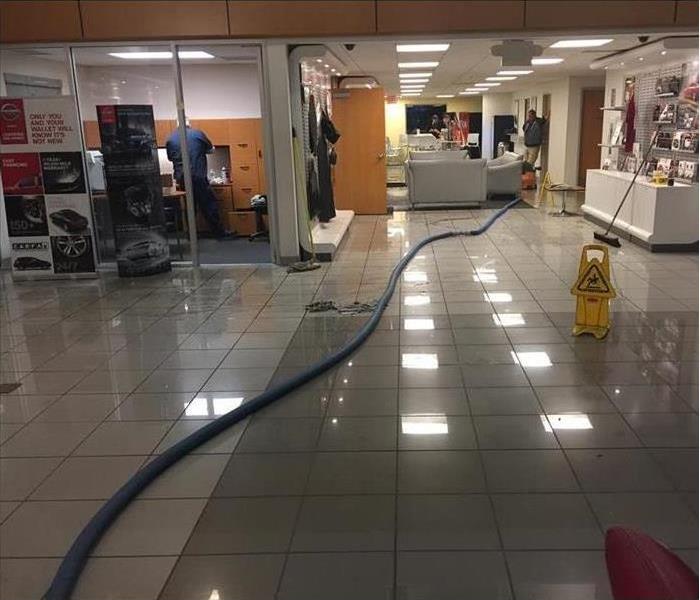 Commercial water damage experts
Commercial water damage experts
As a business owner in St. Charles, MO, you can appreciate the value of working with people who are experts in their respective fields. Often, working with an expert will save you time and money by eliminating the guesswork from technicians who have less experience and training. If the need ever arises for water cleanup at your property, it’s a good idea to seek out a certified water damage specialist.
Outstanding Qualifications
IICRC certified specialists in water damage restoration are trained to utilize the latest technology and best practices according to industry standards, and tailor them to your specific location and situation. They must undergo rigorous testing to be certified, and maintain their certification by enrolling in continuing education courses. These specialists are also sought out and employed by companies that value certification and have extremely high standards of quality and service.
Commercial Drying Specialist (CDS)
An additional certification a water damage specialist can receive is as a Commercial Drying Specialist, or CDS. These technicians are trained specifically in the commercial water remediation process, with knowledge of the electrical, mechanical, structural, and chemical components that are unique to commercial properties. Besides the initial water cleanup, the most important step of the process is ensuring everything in the space is thoroughly dry, so there aren’t problems later with mold, mildew, or rot. Having a CDS handle this step will give you peace of mind everything is done properly.
Water Detection Expert
Often the source of the flooding is obvious - a broken pipe, for example - but sometimes it’s less apparent. Certified specialists have extensive experience in knowing what to look for and where to find it. They will use infrared cameras to detect leaks or trapped water hidden behind walls, as well as moisture meters and other equipment to make absolutely sure there is no residual water or moisture after everything has been cleaned up.
If you experience flooding in your commercial space, you must act quickly to avoid loss and costly water damage, so don’t wait. Hiring someone who’s an expert at what they do will help you get back to doing what you do best.
4 Tips for Safely Using Candles in Your Home
12/23/2020 (Permalink)
 Enjoy using candles in your home and keep your home safe
Enjoy using candles in your home and keep your home safe
Use The Following Tips To Reduce The Chances Of An Emergency
If you enjoy using candles in your Portage Des Sioux, MO, home, then you are certainly not alone. With their varied fragrances and warm light, these items can easily create a pleasant and relaxing atmosphere. On the other hand, they can also cause a candle fire which is anything but soothing. Use the following tips to reduce the chances of an emergency.
1. Keep Candles Away From Flammable Materials
One way to prevent a candle fire is by keeping your candles away from anything that might catch. Don’t burn candles too close to fabric materials, such as bedding or curtains, or paper items like books and magazines. These should be at least a foot or two away from any lit candles. Flammable liquids and aerosols should be even further away.
2. Don’t Leave Candles Unattended
Energetic children or curious pets can easily knock over a candle, so they should always be supervised when candles are in use. However, even if there are no pets or children in your home, you should always extinguish candles when leaving the room. It is best not to leave them burning while you sleep as well.
3. Don’t Burn Candles Too Low
It might seem like a waste not to use every bit of your candle, especially if it’s a pricey scented one, but burning your candles all the way to the end can be a safety hazard. As the flame gets closer to the bottom of the jar, the glass can overheat and shatter, resulting in a candle fire.
4. Use an Alternative
If you enjoy candles but don’t want to worry about the safety risks, you can also find an alternative. Wax melts or diffusers are great for those who are more interested in filling their homes with fragrance. If you prefer the atmosphere created by candlelight, battery-operated candles will fulfill this need without the risk of fire damage.
Fire damage remediation services can perform smoke cleanup and make repairs to your home, but a fire can cause severe damage and loss of property. Keeping an eye on your candles and always using them properly can help keep your home safe.
3 Helpful Tips for Preventing Water Damage in a Storm
11/13/2020 (Permalink)
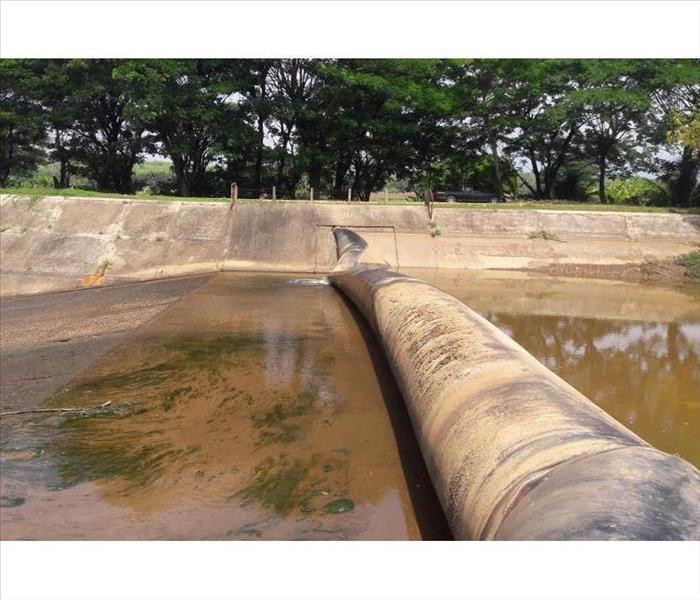 One protective strategy is setting up flood-prevention equipment
One protective strategy is setting up flood-prevention equipment
Tips For Preventing Water Damage In Your Property
Even storms that don't come with severe winds and hail can cause damage to buildings if precautions are not taken. Rain damage from heavy rainfall and the growth of black mold and other harmful molds as a result of moisture buildup are examples of other ways storms can harm property; these can render contents of buildings irreparable and create the need to hire a professional cleanup and restoration service. There are some steps that can be taken to help prevent water from wreaking havoc on property. Here are three helpful tips for preventing water damage in your property in St. Charles, MO.
1. Set Up Flood Prevention Equipment Water damage is a major concern in severe weather whether that be from rain itself or from rising water built up from rain. It is best to take actions to prevent flooding in the building. One protective strategy is setting up flood-prevention equipment:
- Quick dam barriers, or waterless sandbags, react to contact with approaching water, absorbing it.
- Dikes can be used to redirect water
- Absorbent socks can be set against doors, windows and any other place with cracks where water may leak in
2. Perform a Regular Inspection
Another preventative measure is to have a regular inspection of the building done. You should have it checked for cracks in the roof, walls and siding where rainwater could leak in and have those cracks sealed. Having seals placed around windows, doors and areas where cables, vents and pipes enter the wall is also a good move.
3. Have a Strong Building Envelope
A strong building envelope around the building is also a way to prevent rain damage. Technically, every building possesses one. The building envelope consists of the roof and walls (above ground and below ground). Ensuring that the roof and walls are strong and maintained well is one of the best ways to prevent rain penetration during a storm.
Keeping water out is important for preventing buildings from getting rain damage and potentially harmful mold growth.
How To Clean Up Smoke Damage
11/2/2020 (Permalink)
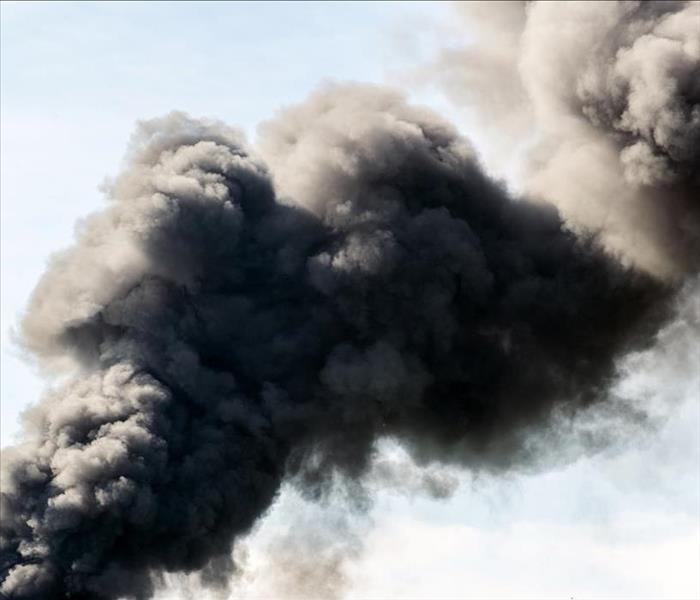 Smoke odor particles can stick to and penetrate nearly every surface
Smoke odor particles can stick to and penetrate nearly every surface
Here Are Some Smoke Cleaning Methods To Look Into
When a fire damages your building in Weldon Spring, MO, smoke odor can linger long after the structural repairs are made. Even if a nearby building caught fire and yours just suffered smoke damage, it can be difficult to fully remove the smell from the air, walls and carpet. Thankfully there are ways to do this, though.
1. Air Out the Building
One of the first steps to cleaning up from smoke damage is to thoroughly air out your building. Open the windows, run fans and get as much fresh air pumping through as possible to remove the smoke odor. Replace your air filters and add other portable air filtration devices throughout the building to scrub the air as well.
2. Clean Every Surface
Smoke odor particles can stick to and penetrate nearly every surface, so one of the first things to do is to clean the whole building. Scrub solid surfaces, wash fabrics, and wipe down walls, being careful to rinse your mops and rags thoroughly as you go to make sure you are getting the smoke particles off. A thermal fogger will be able to get the cleaning supplies into every crack and crevice of the building, allowing you to truly clean the whole structure.
3. If All Else Fails, Ozone
If you've followed the previous steps and there's still an odor, it might be time to ozone the building. This process literally changes the structure of the smoke molecules to neutralize them, which means it's extremely effective. It's best to leave this smoke cleaning method to the experts, though, so call a fire damage remediation company.
Smoke cleaning can be a frustrating process if you don't have the right tools. To help it go smoothly, do your research and call the experts early on in the process, and you'll have your building as good as new in no time.
How To Clean Up After a Pipe Bursts
11/2/2020 (Permalink)
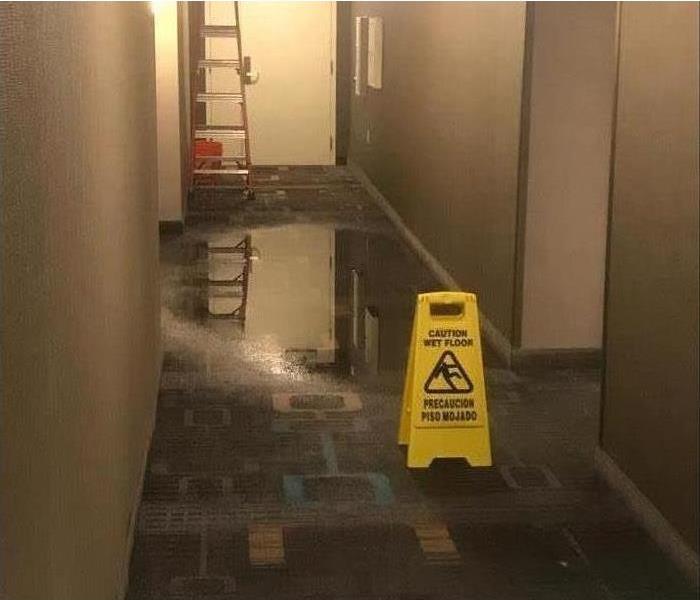 Commercial water damage in Portage Des Sioux, MO
Commercial water damage in Portage Des Sioux, MO
Steps To Take After A Pipe Burst In Your Building
Dealing with bursting pipes in Portage Des Sioux, MO, is rarely a task one can predict doing. However, this occurrence is more common than you might think. Therefore, it's helpful to know what steps to take. While waiting for a water damage restoration company, there are a few tasks you can complete so your building stays clean.
Get Rid of the Water
This may seem obvious, but it can't be overstated how damaging water from bursting pipes can be. While you won't be able to remove as much water as a professional company, you can at least start cleaning. These are some helpful items to locate:
- Buckets
- Fans
- Towels
- Pumps
Using the available buckets, dump out the water with anyone at hand. The quicker the water is disposed of, the quicker your building can be fixed.
Take Away Wet Items
Objects that are already soaked are just going to get in the way. Instead of working around these items, simply remove each one. This will make the drying process easier. Once you have time, assess the damage to your property. Any ruined items should be trashed immediately as mold will begin growing. If you have questions, simply search "water damage" and you'll be able to find more specific information.
Dry Everything
If you still have time, begin drying everything you can. Bursting pipes can cause a great deal of water damage, so negating the possibility of mold is a top priority. If you have a dehumidifier, turn it on immediately. Set up fans all over the building. Lift up the carpet from affected areas to make this process faster. If you have multiple towels and willing volunteers, try to soak up water from the worst spots.
It may seem overly stressful when a pipe burst, but staying calm is important. Keep in mind that "fix broken pipe" doesn't need to be added to your to-do list. Professional companies will help, and your insurance provider can cover the expense. Simply remember these steps if such an incident occurs.
Types of Flood Water Contaminants
10/27/2020 (Permalink)
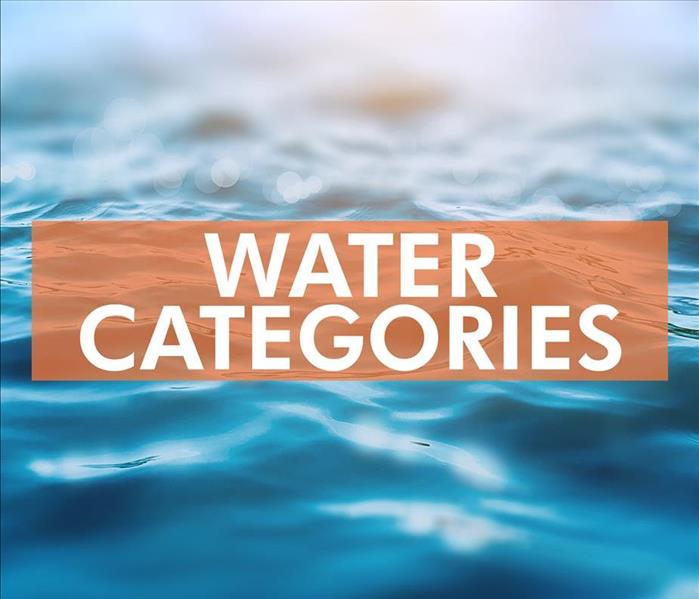 Floods are classified according to one of three categories
Floods are classified according to one of three categories
What Type Of Water Is Flooding In Your Home
While all types of floods are capable of inflicting massive amounts of water damage on your property, some are just inherently more dangerous than others. Floods are classified according to one of three categories, depending on which types of contaminants are present in the water. Read on to see which type of water is flooding your home in O'Fallon, MO.
1. Category 1: Clean Water Floods
Much like the name implies, Category 1 floods are characterized by an absence of contaminants. It is possible for these types of floods to transform into more dangerous varieties if outside contaminants are introduced to the water. Clean water floods are typically caused by:
- Supply line bursts
- Leaky pipes
- Rain water or snow melt
2. Category 2: Gray Water Floods
Category 2 floods do contain mild amounts of contamination, but not enough to be considered a biohazard. If left untreated for 48 hours, a Category 2 flood can quickly become a Category 3. Gray water floods are usually a result of:
- Sump pump failures
- Malfunctioning household appliances, such as dishwashers and washing machines
- Broken aquariums
3. Category 3: Black Water Floods
Category 3 floods are the most dangerous types of floods. They're categorized by the presence of human/animal fecal matter, raw sewage, dangerous chemicals and other types of biohazards. These floods are extremely dangerous and can inflict massive amounts of water damage, so you should never attempt to remediate them on your own. They're often caused by:
- Toilet back flow
- Sewage overflow
- Rising groundwater
- Overflowing banks from rivers or streams
It's important to take all types of water damage seriously, but you need to be especially wary of damage caused by black water floods. If not treated properly, the situation will only get worse and worse. It's best to contact flood remediation experts if your property has been affected by Category 3 flooding.
5 Common Home Mold Species
10/10/2020 (Permalink)
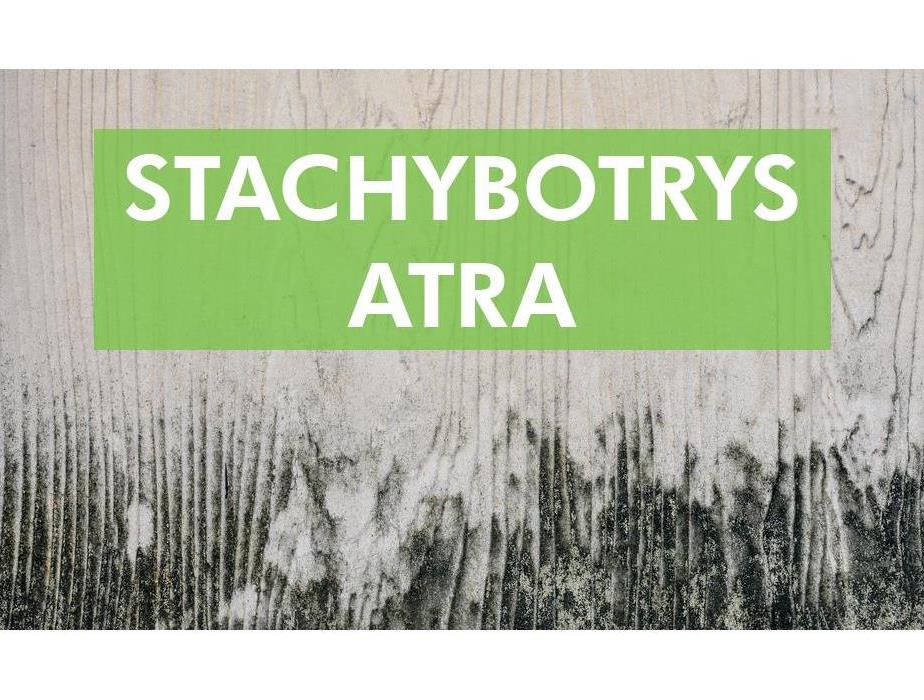 Stachybotrys also known as black mold
Stachybotrys also known as black mold
Common Household Fungi
Mold growth is an incredibly common issue that the majority of homeowners face at some point. The first step when it comes to protecting your home in St. Charles, MO, is to identify which mold species you're currently dealing with. Here are five of some of the most common household funguses.
1. Stachybotrys
Also known as the infamous black mold, this species is one of the most common household funguses. Like the name implies, this mold is black or dark green colored and may have a slimy or fuzzy texture. It thrives in damp, high humidity environments, so you're likely to find it growing in your bathroom.
2. Alternaria
This is the most common type of household allergenic mold. Like black mold, it favors damp conditions, such as kitchens and bathrooms. It's categorized by its velvety texture that often sprouts dark green or brown hairs.
3. Chaetomium
You're most likely to find this type of mold growth in your basement or roof after your home has suffered from water damage. It has a cottony texture and typically changes color from white or gray to brown or black as it ages. If your home smells musty, this species is likely the culprit.
4. Cladosporium
This mold species can thrive in both cold and warm environments. It's commonly found growing in fabrics and textiles, such as carpeting or upholstery. You may also find it growing in your cabinets or underneath the floorboards.
5. Ulocladium
This mold species is often confused for black mold, due to their extreme visual similarities. You may need to consult an environmental hygienist in order to differentiate between the two. It's often found in homes that have suffered from severe water damage or flooding.
Mold growth is a common, yet serious issue that needs to be taken care of as soon as possible. Spores can spread very quickly, causing widespread damage throughout your property. Contact mold remediation experts for help resolving the issue.
Toilet Overflows Demand Immediate Action
10/10/2020 (Permalink)
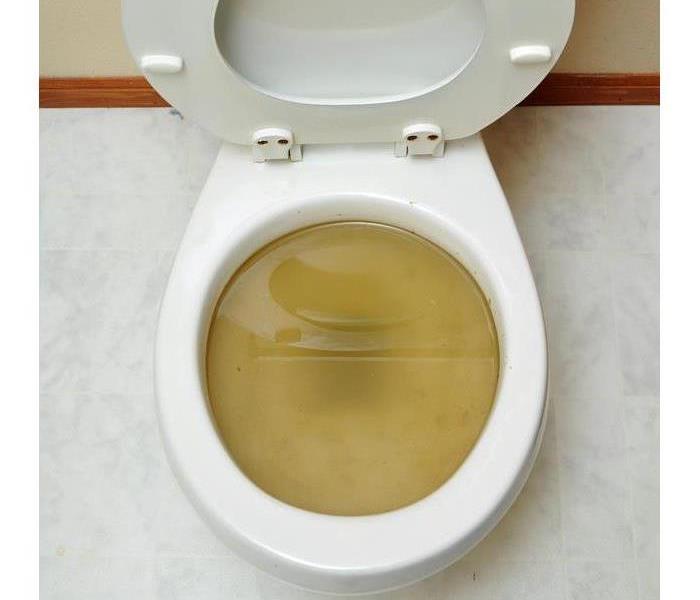 Toilet overflow in St. Peters, MO
Toilet overflow in St. Peters, MO
Take The Following Actions After a Toilet Overflow
With the simple push of a handle, toilet water should go down the drain, exiting quickly through the pipes. Sometimes, however, clogs occur, forcing the fluid to spill out of the commode and leading to sewer damage. Homeowners in St. Peters, MO, may think very little of the situation at first, grabbing for a plunger, cleaner and a mop; however, more may be needed to keep the rooms sanitary for future use. When the overflows happen, residents should take the following actions.
1. Stop the Flow
Focus on minimizing effects. At times, the spill just continues with moisture moving into walls and floors. Search for the shut off the valves in the restroom and outside. In addition, ensure that household members refrain from using washing machines, showers and dishwashers. This is a good time to call in a sewage company who can inspect the premises and determine a plan of action.
2. Address the Problem's Source
Discharges can happen for several reasons, so finding the obstacle should be the next step. At times, items have become lodged within the lines, preventing flow. Run a snake down the lines, forcing anything to push through. This may clear the path. Other times, breaks or hole may occur in the metal. Without a means of escape, the backup sends everything out from the closet exit point. If you're having trouble locating the sewer damage a water restoration company could run a camera through the system.
3. Clean Up the Flooding
Humidity and wetness pose several structural concerns. First, these conditions encourage mold to breed, increasing the likelihood of infestation. Second, the dampness could warp and ruin materials, weakening their integrity; therefore, the entire area, not just the flooded toilet, should be disinfected. Dry out the location; remove soaked contents and sterilize the space.
Lingering sewer damage is harmful to a house. Work swiftly to hinder water streams and correct the cause.
3 Things You Need to Throw Away After a Fire
9/24/2020 (Permalink)
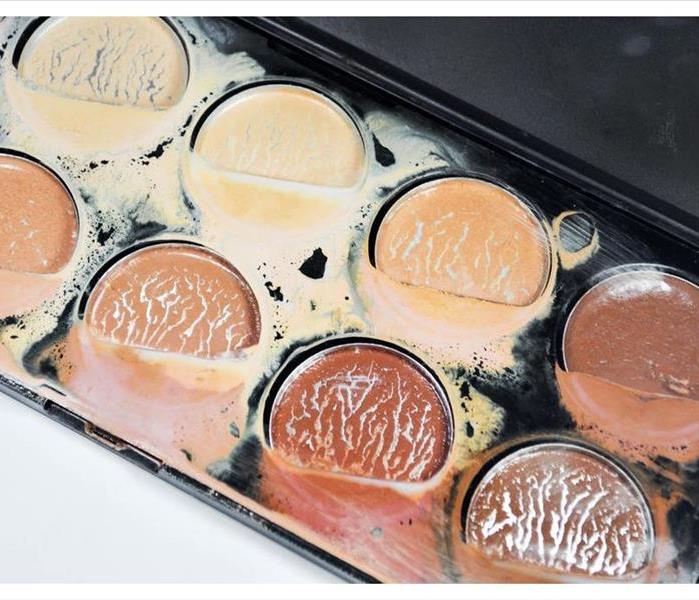 The fire's heat is certainly capable of melting your cosmetics
The fire's heat is certainly capable of melting your cosmetics
Items That Need To Be Discarded After a Fire
Attempting to remediate and recover from fire damage is extremely stressful for any homeowner. One of the first things you need to do upon returning to your property in Portage Des Sioux, MO, is to assess the damage and sort through your belongings to figure out which items you can keep, and which ones you need to throw away. That being said, there are certain items that always need to be discarded following a fire.
1. Burned Medications
It's highly recommended that you discard all of your medications following a fire. The high heat can alter their chemical structures, potentially making them either useless or dangerous to consume. If you want to avoid getting new prescriptions, make sure you check each and every bottle and pill very carefully for signs of heat damage or fire extinguisher residue.
2. Perishable and Non-Perishable Food Items
More likely than not, any food item that has been exposed to fire damage must be thrown away. Non-perishable food items can become contaminated when the fire melts their packaging, permeating the food itself. Perishable food that's inside the refrigerator could potentially be okay if the fridge itself wasn't damaged in the inferno. Assess and determine whether or not to throw away each food item on an individual basis, if this is the case.
3. Damaged or Burned Cosmetics
The fire's heat is certainly capable of melting your cosmetics, effectively changing their chemical structures. Much like your medications, this can make them dangerous to use. Even if they weren't damaged in the fire itself, they may have been contaminated when the fire was extinguished. Check the packaging to see whether it's warped, charred, or melted. Also, check for residue from the fire extinguishers.
Experiencing a home fire is almost just as stressful as attempting to recover from one. Knowing which personal possessions you can keep and which ones you need to throw away can help streamline the process and make it easier for you. Contact fire remediation experts for more information and assistance recovering after a home fire.
Troubleshooting Commercial Irrigation Sprinklers
9/24/2020 (Permalink)
 A broken sprinkler head could cost you thousands in your Wentzville, MO commercial building
A broken sprinkler head could cost you thousands in your Wentzville, MO commercial building
Broken sprinklers in a commercial irrigation system are a consistent problem in Wentzville, MO. All systems should be checked for irrigation problems and repaired regularly; otherwise, flooding and property damage can be caused by faulty devices.
Find the Problems
The whole irrigated area should be inspected for bad plumbing. After determining the location of the system’s sprinklers, look for the following:
- Sprinklers that spray incorrectly. Straight up, sideways, or just a trickle – you’ll likely know an abnormal spray when you see it.
- Heads that don’t pop up when the water comes on. These may spray or they may not.
- Puddles. If water is pooling on the property, it is likely that too much water is getting to that spot.
- Visually damaged heads. They can be cracked or even broken off completely.
Sprinkler heads are always at the mercy of the weather, animals and even vehicles. When they are not installed at the right depth, they can sit up higher than they were designed to and become especially vulnerable. Luckily, they are often cheap and can be replaced easily.
Replace Broken or Damaged Pieces
Probably the hardest work involved in replacing a sprinkler head in an irrigation system is making sure to purchase the correct one, which isn’t hard if you take an old one to the hardware store with you. Beyond that, it’s super-simple:
- Dig up the old head. Don’t get your biggest shovel and put all your weight into it. There are other parts that can break down there.
- Twist off the old one. This will detach it from the riser below.
- Twist on the new one. This will attach it to the riser below.
It’s really that easy. Remember that you will be working in a muddy hole, and cleanup may be needed before the new sprinkler head can twist on.
An irrigation system can do great things, but it can also cause property damage. Keeping a close eye on your system is a worthwhile task and usually not very complicated. Regular inspections and inexpensive repairs can often help avoid the need for water damage repair.
Do You Need to Add Mold Coverage to Your Pollution Liability Insurance?
9/1/2020 (Permalink)
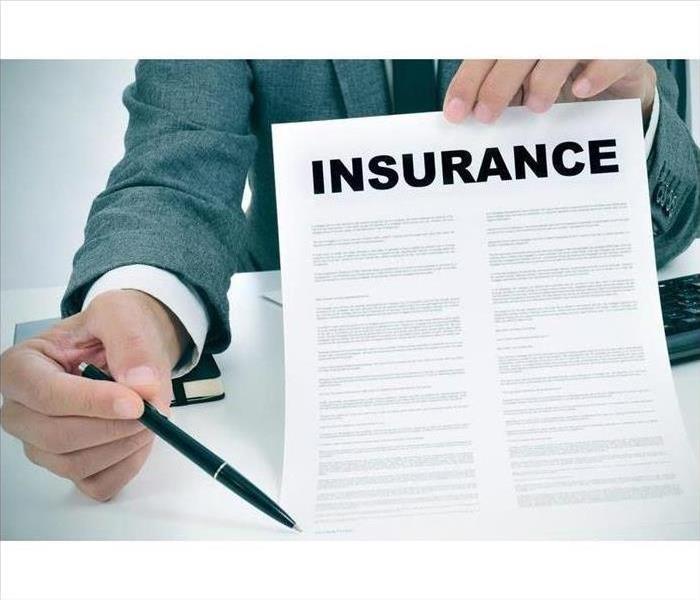 Mold insurance claims can potentially be covered under pollution insurance
Mold insurance claims can potentially be covered under pollution insurance
Independent contractors in St. Peters, MO, face so many potential risks, they can’t all be listed. Lawsuits are, unfortunately, common in the contractor world, and insurance doesn’t always cover damages. If your business produces any kind of waste, you may already be familiar with pollution liability insurance. Mold insurance claims can potentially be covered under pollution insurance.
What Businesses Typically Need Pollution Insurance?
Contractors who work in the physical world (as compared to computer or administrative contractors) often produce waste. Some examples include
Energy extraction, refinement and storage
Agricultural
Construction
Waste transportation and storage
What Is Mold Insurance?
Mold insurance claims have increased sharply in recent years. The damage mold causes is a frequent nuisance and an occasional disaster. Besides its risk to drywall and fabrics, it can chew into damp wood, causing potential structural damage.
Without regular mold inspections, hidden colonies can continue to eat into construction materials for years before being discovered – and they can spread throughout the building in the meantime.
Coverage may come in the policy or in a rider. For certain types of contractors, it may be found in their pollution liability. A mold claim may cover inspection costs as well as damage repair, but each policy varies.
Why Would Mold Coverage Be on Pollution Insurance?
Water is the proximate cause of most mold – and water can be a pollutant! Consider your commercial building; the building envelope is primarily concerned with keeping water out. A tiny leak in a roof can, if left for years, create a hazardous situation inside.
Contractors who routinely produce wastewater – even if just for regular cleaning – may be liable for the damage it causes. If someone who has insurance makes a claim, their insurance company will look for the cause – and for anyone to blame.
Mold insurance claims made against your pollution insurance can be tricky. Overlapping layers of liability can make figuring out who’s responsible a lengthy nightmare.
Contact a mold restoration company experienced in working with insurance companies to help you ensure you’re being treated fairly. This can prevent unnecessary policy rate increases or even help prove you weren’t the cause!
The 5 Steps of Water Mitigation
9/1/2020 (Permalink)
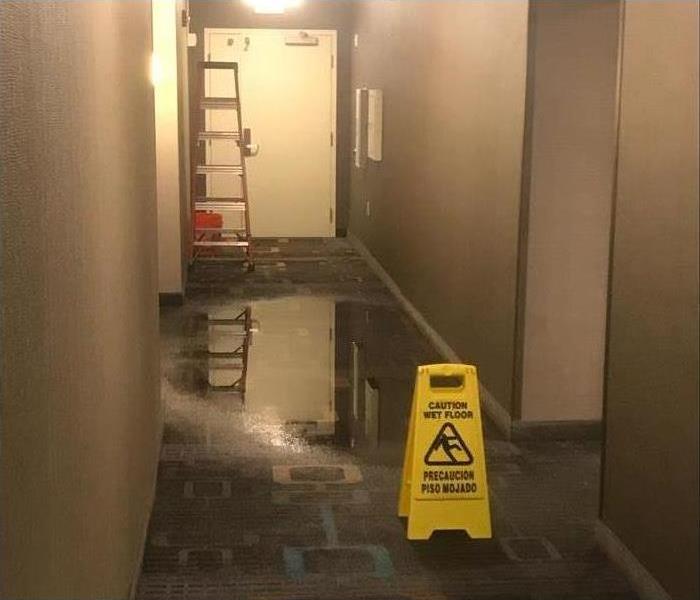 Standing water in an O'Fallon, MO office building
Standing water in an O'Fallon, MO office building
5 Mitigation Steps
Business owners often have a long daily to-do list to keep operations running smoothly. When a major water problem rears its ugly head, such as a supply line leaking, dealing with pipe burst cleanup isn’t something anyone wants to add to that list. While the initial discovery of water is unsettling, after finding and stopping the source, leaving the mess to a water damage and restoration specialist makes the process smooth and worry-free. Below are the mitigation steps you can expect as part of getting your business back to “Like it never even happened.”
1. Inspecting
To determine the type of water cleanup needed, a certified technician will complete a thorough inspection and assessment. That will include locating any hidden damage. They will define the damage.
2. Removing Water
Getting standing water and excess moisture out fast is key to preventing secondary issues. Professionals use the latest technologies and special equipment to make that happen.
3. Drying Out
A pipe burst cleanup often means hundreds of gallons of unwanted water. Even after the standing water is removed, there can be extreme saturation. Although the drying process may take weeks depending on the damage, the use of industrial fans and dehumidifiers make the process much smoother and faster than doing it alone.
4. Cleaning
The prevention of mold is a top concern. Cleaning all surfaces, flooring, carpeting, drapery and anything touched by water needs to happen. A professional has an array of cleaning methods to handle everything from wood floors to documents. They also have the tools to eradicate lingering odors.
5. Restoring
Although this may be the most complex part, the restoration process may mean different things for different situations. There is a likelihood that drywall and insulation will need to be replaced. Wood flooring severely damaged may also need repairs.
Instead of trying to tackle the massive task of pipe burst cleanup after damage to your O'Fallon, MO, business, leave every step of the process to trusted experts.
What Property Managers Should Know About Storm Preparedness
9/1/2020 (Permalink)
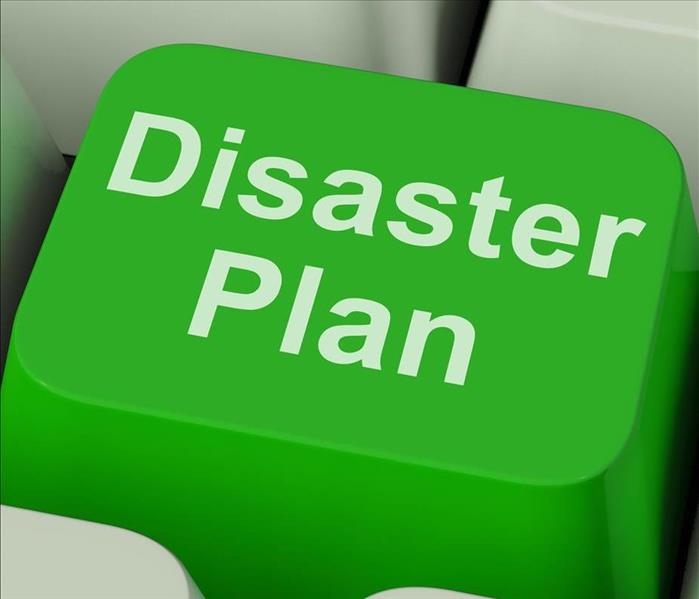 A disaster recovery plan is a fundamental part of great property management
A disaster recovery plan is a fundamental part of great property management
Prepare Your Business From Storm And The Aftermath
As a responsible commercial property manager, you should have a detailed plan before the storm season starts. While there should be insurance policies in place to help cover storm damage losses and a complete water cleanup plan, storm preparedness also includes a thorough recovery plan. From staffing to security to documented procedures, there are many elements to a comprehensive recovery approach that requires detailed and careful planning. If you find yourself facing an approaching weather event in Weldon Spring, MO, you’ll be glad that you took the time to prepare for the storm as well as the aftermath.
Developing a Disaster Recovery Plan
A disaster recovery plan is a fundamental part of great property management. While a storm preparedness plan varies from place to place, it should include these elements:
- Master contact list, which includes emergency response numbers
- Communication protocols, including an alert system for tenants
- Service contracts review, to determine what services are available during recovery
- Safety and emergency procedures checklists
- Identification of emergency personnel
- Documentation of pre-storm conditions
- Backup of property records and important files
- Review of existing insurance policies for adequate coverage
- Plans in place for contractors to mobilize on critical repairs
Property management staff should work with the owners to prepare a recovery plan as well as take steps to make sure that individual units are made ready to minimize storm damage as much as possible.
Dealing with the Storm Aftermath
While storms and the damage left in their wake are largely unpredictable, a storm preparedness plan can help minimize the time it takes to restore things back to pre-event conditions. A complete inspection and survey of the property is necessary to assess the extent of damages. As the property manager, you should communicate to tenants and other staff regarding the state of the property and information concerning disaster relief. Authorizations and signatories should be in place to expedite repair and restoration work for the most essential elements of the property.
Common Types of Water Damage in Commercial Buildings
8/27/2020 (Permalink)
4 of the Most Common Causes of Water Damage
Depending on the size and severity of the damage, something as minor as a broken pipe can cause a lot of problems in your commercial building in Portage Des Sioux, MO. It is important to know what to look out for so that you can perform regular inspections and proper maintenance on items that may lead to leaks or flooding. Here are four of the most common causes of water damage that you might run into.
Broken Pipes
If you are in an older building, your pipes are more likely to have problems. However, weather plays a big factor in this. When temperatures drop, the water inside expands, which can lead to a broken pipe. The best way to prevent this is to keep the water flowing constantly during the winter.
Toilet Overflow
An overflowing toilet is one of the more dangerous types of flooding you can run into. The water is considered unsanitary and contains bacteria and viruses if it comes from the sewer. You can help prevent this from happening by putting waste bins in each of the stalls and putting up signs asking people to properly dispose of feminine products and other trash. If you do find yourself in this situation, you may want to call a professional water repair company to help clean and disinfect the area.
Weather
Severe weather can occur in Portage Des Sioux,MO, so it is a good idea to have your roof inspected before the rainy season. Oftentimes, the leak is so small it goes unnoticed, which can lead to mold growth or other issues. Always check for signs of damage after a storm. Get even the smallest problems fixed right away so that further complications don't arise.
You can usually handle small leaks by yourself, but if you do not feel you are equipped to deal with a broken pipe, you should call a water restoration company in Portage Des Sioux, MO to come help.
5 Vital Storm Preparation Tips
8/12/2020 (Permalink)
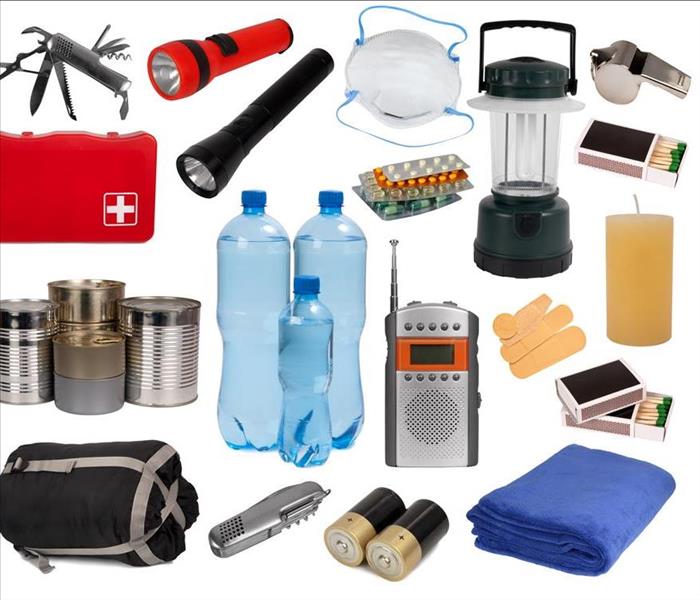 Create an emergency supply kit
Create an emergency supply kit
Ways To Keep Your Home Safe During Storm Season
Hurricanes and other tropical storms can inflict devastating damage on a community. High winds, heavy precipitation, and flood water are only the first of your worries during this time. However, you can reduce your risk by preparing yourself before the storm hits. Follow these safety tips to help keep your home in St. Charles, MO, safe during storm season.
1. Stay informed: The first thing you should do is sign up for your community's emergency alert system. This way, you'll have access to the latest storm updates as they occur.
2. Learn and practice your escape routes: Chances are, your community already has specific evacuation routes mapped out. If they don't, then make sure to take the time to plan your own escape methods. Practice these regularly so you'll be ready in case of an emergency.
3. Create an emergency supply kit: Your emergency supply kit should contain everything you need during an emergency. Your kit should contain freshwater, non-perishable food items, a first aid kit, a flashlight, extra batteries, a wrench and/or set of pliers, and a backup cell phone, at the very least.
4. Keep electronics away from flood water: The most dangerous part of any flooded building is electrified water. Move all electrical equipment, such as wiring, and circuit breakers at least one foot above flood level.
5. Never enter the flood: You should never, under any circumstances, attempt to swim, walk-in, or drive through floodwater. You may think you're a strong swimmer, but the flood is definitely stronger. It only takes six inches of moving water to knock you off your feet. Additionally, there's always a chance that the water could be contaminated, which poses a dangerous health risk.
Preparation is an essential part of staying safe. Possessions can be repaired or replaced, and are never worth risking your life over. After the water has subsided, and the authorities have given you permission to return to your home, you should contact storm remediation experts to help assist with the water damage.
5 Ways To Control Mold Reproduction in Your Home
7/28/2020 (Permalink)
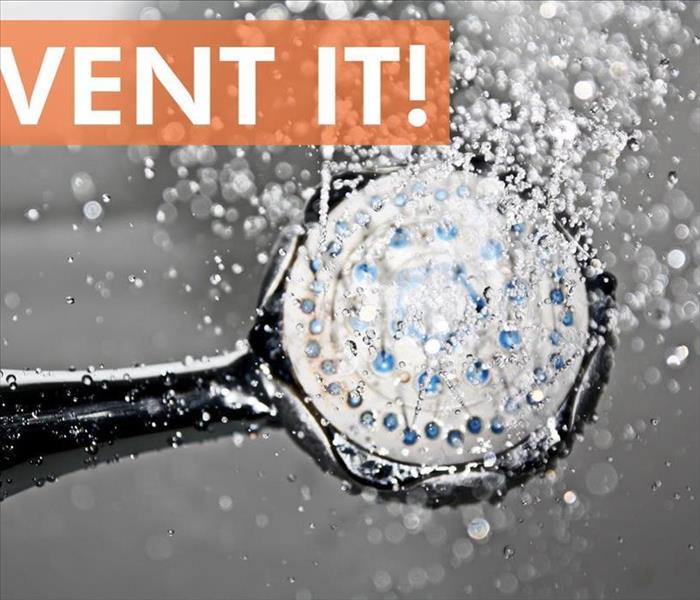 Bathrooms with a shower should be properly ventilated to prevent mold growth due to humidity
Bathrooms with a shower should be properly ventilated to prevent mold growth due to humidity
Five Ways To Control Mold Reproduction
Homeowners in Portage Des Sioux, MO, have enough on their plate. Mold doesn't need to be part of the concern. With that in mind, residents should be cognizant of how fungal growth impacts a place as well as how to promptly handle water damage and spore development. By arming themselves with this knowledge, people may be able to prevent major cleanup projects and financial headaches. Here are five ways to control mold reproduction.
1. Monitor the Humidity Levels
Spores exist everywhere. They are in the home. These microbes are harmless until they interact with moisture and organic material. This combination spawns mold growth. To cut down on issues, avoid having too much fluid in your place. Humidity should remain at or below 50%. A mold remediation company can test the premises, offering suggestions for reducing the levels.
2. Clean Up Spills Immediately
Water damage is a leading cause of fungus. Therefore, any spills or floods should receive prompt attention. Air out space. Open windows, run fans, or plugin dehumidifiers. If carpeting is overly soggy, you may want to remove it and the pad.
3. Clear Vents Regularly
Too much heat can also contribute to the problem. Reduce it by ensuring that ventilation systems work efficiently. Several times a year the oven and dryer vents should be cleared out, allowing for appropriate circulation.
4. Run Your HVAC System
One of the top mold prevention tips is to run your air conditioner. The cooler air helps alleviate dampness while also working to pull out the extra water in the air. Have this serviced every six months, change out the filters per unit instructions, and double-check that the line does not clog.
5. Inspect Plumbing
Avoid leaks and breaks. Look for rings, rust, or drips. Any changes should be handled swiftly.
Minimize your mold trouble by focusing on reducing water damage and remaining vigilant about routine evaluations. Keep things dry and clean.
Factors in Fire Remediation
7/7/2020 (Permalink)
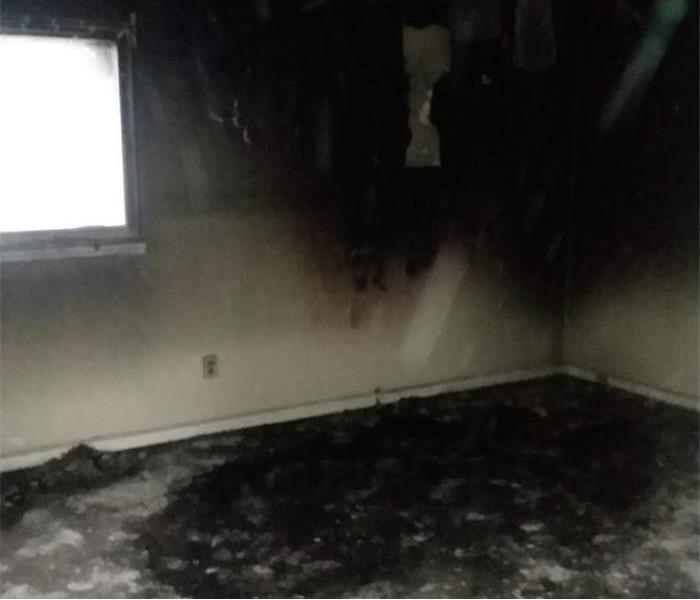 Fire damage in Weldon Springs, MO
Fire damage in Weldon Springs, MO
Fire damage is quite destructive all on its own. If your commercial building in Weldon Spring, MO, is ravaged by a fire, however, it probably also has water damage after the fire is put out. Firefighters use a lot of water to douse the flames and the problems that cause also need to be dealt with during remediation.
Water Mitigation
A fire hose puts out a lot of water, so one of the first things fire restoration specialists have to do is take measures to dry the building out:
- Pump standing water out
- Dry surfaces by increasing air flow
- Bring humidity levels down to normal
It is important to dry your building out to avoid mold growth. Mold patches can start to form in as little as 24 hours after excess moisture becomes present. Taking care of these problems quickly is the best defense your building has against secondary damage.
Fire Mitigation
To mitigate fire damage, technicians have to take several important steps. First, they remove all items in the area affected by the fire. Many of these items may have to be thrown out, but some can be cleaned and salvaged. Second, they tear out all the materials that were destroyed by the fire, including drywall, insulation, carpet, floor pads, and ceiling tiles. Once they have removed all these materials, they start a thorough cleanup. Soot and smoke have to be removed from every surface and crevice, including the many areas of the building otherwise unaffected by the fire. After everything is clean, restoration professionals step in to rebuild the structure and make your building look "Like it never even happened." When there is a fire in your building, it takes a lot of water to put it out and keep it from spreading. You need remediation that tackles both water and fire damage from certified experts who specialize in both.
Document Recovery After Water Damage Can Save Your Business Thousands
6/20/2020 (Permalink)
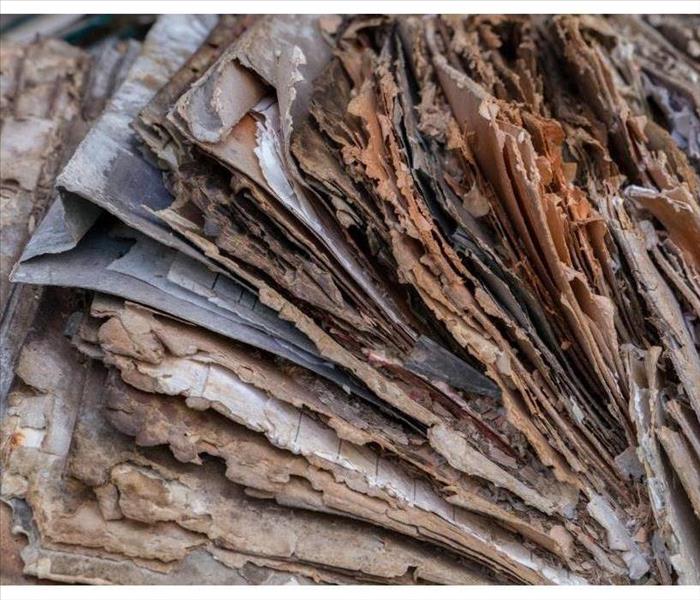 Some documents are simply irreplaceable
Some documents are simply irreplaceable
Modern business in O'Fallon, MO, would be impossible without volumes of paperwork. These days, much of this can be stored digitally, and, increasingly, on remote servers in the cloud. Regardless, most companies still stand to lose a great deal of money if local paperwork is water damaged from a flood or fire. There’s good news, though: If you act quickly to save them, document restoration may be possible.
Many Types of Documents Can Be Saved
Some documents are simply irreplaceable. Businesses that could survive a devastating fire have nevertheless succumbed to financial stress from losing paperwork to firefighting efforts. There are often many items kept on location:
- Commercial paper accounts
- Receipts and payroll
- Employee records
- Financial and tax records
- Medical records
- Manuscripts
- Blueprints
- Photographs, films, negatives and microfiche
Document Drying Is Possible Thanks to Specialized Equipment
SERVPRO has several advanced technologies that have revolutionized document restoration. A team of expert technicians can rush to the scene and quickly evaluate which strategy will work best.
Typically, this involves using the same vacuum freeze-drying process used by the National Archives and Records Administration for restoring documents to be stored in the Library of Congress.
The technology allows water to sublimate, bypassing the stage that causes the most harm to paper. This innovative process rescues far more documents than was ever possible before. It’s why SERVPRO is the preferred vendor for disaster mitigation for most insurance companies.
Sterilization and Digitization Provides Quick, Safe
Access
After drying, the restored items are sterilized with gamma radiation. This removes microbes that are harmful to humans or that can digest paper. Next, all items are digitized and saved to a secure location for you to download.
During the entire document restoration process, your items are under 24/7 surveillance and managed by HIPPA-certified master technicians. The chain of custody is carefully controlled to avoid any questions of authenticity.
Not only is SERVPRO the preferred vendor, each franchise is owned locally to stay responsive to their communities yet also have access to all the corporate resources and knowledge needed for restoration. This advanced damage restoration technology has saved businesses — and insurers — many thousands of dollars.
Preparing for the Insurance Adjuster's Visit
5/27/2020 (Permalink)
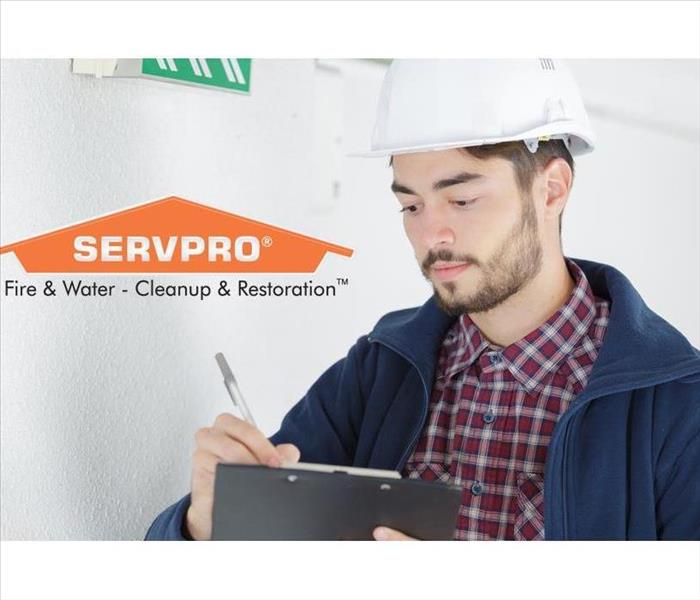 A home adjuster is an important part of the insurance claims process
A home adjuster is an important part of the insurance claims process
To Prepare For The Adjusters Arrival, Follow These Steps
You have probably heard that floods are not included in a typical homeowners' policy. Yet many other types of water damage are covered. For instance, if water enters your home through a hole in the roof caused by a storm, you can file an insurance claim to pay for the cost of repairs.
Before your claim is finalized, a home adjuster will visit your property to see how much damage there is. To prepare for the adjuster's arrival, follow the below steps.
1. Make an Inventory
If it is safe to do so, walk around your home to see which items were damaged. Make a list of these possessions that includes costs and dates of purchase. You can give this list to the adjuster when he or she arrives.
2. Check for Structural Damage
The adjuster will also want to look at structural issues on your property. This includes any harm that occurred to the shed or swimming pool. Identify this damage in advance so you can show it to the adjuster.
3. Get Electrical System Inspected
Find out if the house has any electrical problems before the home adjuster arrives. The insurance provider may even cover the cost of this inspection.
Subsequent Visits
Keep in mind that if there is a major disaster in St. Charles, MO, the adjuster may have to visit numerous homes in your area within a short amount of time. As a result, the adjuster may initially only be able to provide an estimate of the damage. You can always set up a second appointment for a more thorough assessment.
Next Steps
After the adjuster has left, you can contact emergency restoration professionals. Your adjuster may even recommend a local company that he or she has worked with in the past. Make sure the adjuster has approved the cost of the cleanup before the work begins.
A home adjuster is an important part of the insurance claims process. If you properly prepare for his or her visit, you should get your money more quickly.
What To Expect When Rebuilding After a Commercial Fire
5/25/2020 (Permalink)
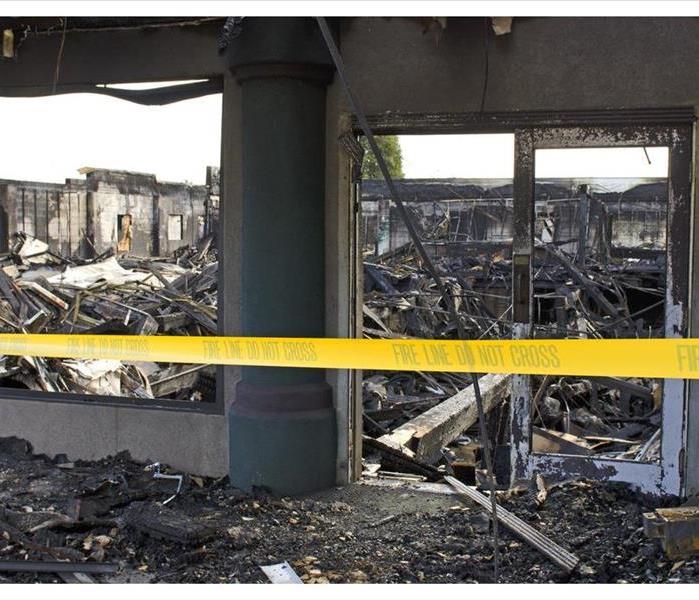 Fire breaks out in a commercial building in St. Charles City
Fire breaks out in a commercial building in St. Charles City
There is a lot to consider when a fire breaks out at your business in St. Charles City, and you are figuring out the process of rebuilding. A good first step is to get an estimate from a reputable fire restoration company. A full-service company will make several considerations when they send contractors to your property to make a bid.
Secondary Damage
When a commercial fire has caused damage to your property, the first job the contractors will do is prevent secondary damage. This will likely start with boarding up the doors, windows, and damaged walls to prevent intrusion, theft, or wandering critters. If there is damage to the roof, then a temporary roof tarp can be put in place to prevent further destruction from weather. If there is concern about theft in the area, then a surveillance system may be installed or a security guard may be dispatched to the property.
Removal Services
Before the restoration process can begin, there needs to be a good cleanup of the property. If the fire department was dispatched to the property, the logical first step is to clean out any remaining water and then estimate the level of water damage. The contractors can then assess how much smoke damage and fire odor is left behind and what procedures are needed to correct the problem. Any unsalvageable debris will most likely be removed, which can help eradicate a lot of the smoke smell.
Restoration of Salvageable Materials
Any items or materials that can be saved will likely be packed up and sent to cleaning facilities in order to remove any smoke or fire damage. The rest of the items can then be moved to storage facilities for the duration of the restoration process.
Calling a fire restoration company to provide an estimate is a smart first step when your business suffers a fire. The contractors can provide a good accounting for how much it will cost to fix your property and work with your insurance company to make sure you have the best experience getting back into business.
How Business Interruption Insurance Helps After a Fire
5/12/2020 (Permalink)
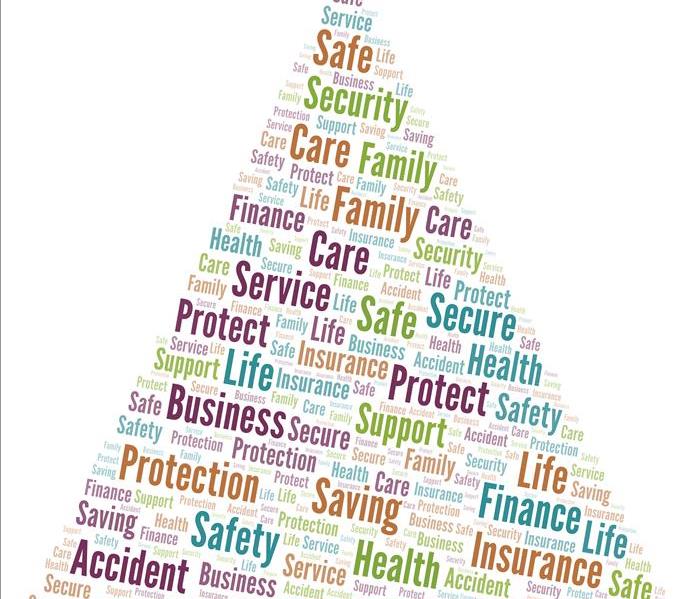 Business interruption insurance can help cover your costs during the restoration period
Business interruption insurance can help cover your costs during the restoration period
A fire to your O'Fallon, MO, business can cause major damage and disrupt your operations for a significant period of time. Fortunately, business interruption insurance can help cover your costs during the restoration period.
What Does Interruption Insurance Cover?
Every policy is unique, but interruption insurance usually covers regular operating expenses incurred as well as profits lost while your business is not fully operational. Some of the expenses covered include the following:
Fixed expenses, such as operating costs and loan payments
Temporary relocation
Other miscellaneous expenses the business incurs in order to remain operational
Many companies close permanently after a business fire due to lost income. The funds received from an interruption policy can help your business stay afloat without losing employees, falling behind on taxes or defaulting on loans. Make sure you maintain adequate records showing income, expenses, and profits for your business and keep these in a safe location, such as cloud storage so that you have access to them when filing a claim. Discuss the details of the policy with your insurance agent to make sure you have enough coverage to see you through a disaster.
How Long Does Coverage Last?
As the name implies, business interruption insurance covers the period of interruption due to a fire or other unforeseen event. Many insurance companies define this period as extending from the day the loss occurred, i.e., the date of the fire, to the day the business has been fully restored and is back to normal operations. This includes the time needed for fire cleaning, purchasing new equipment, etc.
If your company suffers a fire, business interruption insurance can help pay for your expenses while your property is being restored. Even so, it is important to get your business back in its regular building and operating at full capacity as soon as possible. An experienced restoration service can help with this process, giving you more time to focus on taking care of your employees and customers.
Benefits of Using a Certified Water Damage Expert
5/12/2020 (Permalink)
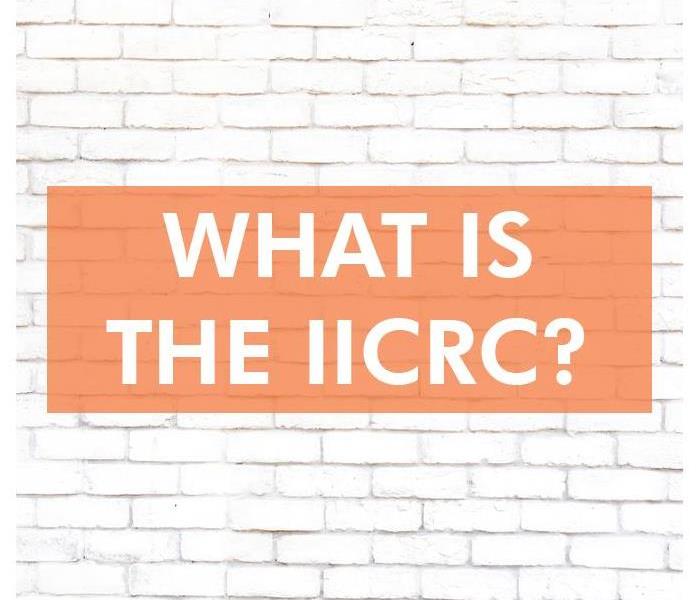 What is the IICRC certification?
What is the IICRC certification?
Water damage to your commercial property from such things as flooding or a broken pipe should always be taken seriously. If left untreated, the damage can pose serious health risks to your employees in Weldon Spring, MO. It is important to call a certified expert as soon as possible after the trouble occurs to assess the situation and handle the water clean up. When searching for a qualified company, make sure it employs IICRC-certified professionals.
What Is IICRC Certification?
The Institute of Inspection Cleaning and Restoration Certification (IICRC) is an organization that sets the industry standards and certification for cleaning, restoration, and inspection. A company has to pass a rigorous audit before obtaining certification. Each technician must also pass a strenuous written exam to ensure they are knowledgeable in their specific field.
What Are the Benefits of IICRC Certification?
Each individual that is certified by IICRC has been trained to handle water clean up in a safe and professional manner. Some of the benefits in choosing a certified professional include:
Works well under pressure - Certified technicians are trained to handle stressful emergencies with a level head. They are also excellent problem solvers.
Has specific knowledge to handle technical equipment - Trained professionals can safely and effectively operate all of the advanced drying, cleaning, and deodorizing equipment.
Can communicate well - A professional will be able to answer your questions with clear and concise responses so that you aren’t left in the dark.
Has the ability to handle large projects - A certified water restoration professional is trained to identify all problem areas and handle the water damage repair, especially on large commercial properties.
As you begin your search for a restoration company to take care of your water clean up, make sure you select an IICRC-certified company. This will give you the confidence you need to know that your property is in good hands.
3 Tips For Making a Mold Damage Claim
5/12/2020 (Permalink)
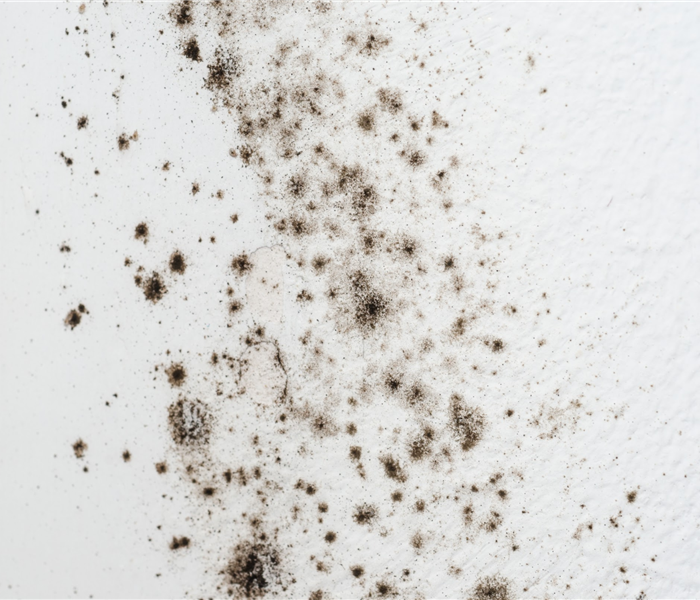 Mold growth on wall
Mold growth on wall
3 Tips For Making a Mold Damage Claim
The average cost of mold damage remediation ranges from $15 to $30 per square foot. Fungus removal expenses for a commercial building can quickly add up, and some materials and contents may also need to be replaced. Commercial property policies often exclude mold damage that does not result from certain covered perils. Additional coverage in the form of an endorsement or thorough documentation of mitigation may be necessary to cover costs. These three tips can facilitate the process of making a mold claim.
1. Check Mold Coverage
General commercial insurance may have a limited amount of coverage for mold caused by covered perils. The standard Insurance Services Office commercial property policy caps this coverage at $15,000 for a single incident or policy year. A policyholder should review an insurance agreement, definitions, conditions, and endorsements to determine whether coverage is available. Confirm the terms of a policy before renewing and consider adding an endorsement for mold to cover more remediation costs.
2. Document Damage
A commercial property owner should put all communications with an insurance company in writing. Follow up a call to an agent with written communication. It is also important to take and date photos or videos that indicate the extent of damage or loss prior to fungus removal.
3. Provide Proof of Mitigation
The owner of a building should also maintain records demonstrating that any water damage has been mitigated in a timely manner and that industry-standard methods were used during restoration. An insurer may be more likely to cover mold cleanup costs if it is clear that negligence was not a factor.
Maintaining a sufficient level of insurance coverage is the responsibility of a commercial property owner in Portage Des Sioux, MO. Regularly check policy terms and fill in gaps in coverage with endorsements. If water damage occurs, gather proof of damage, mitigation, and restoration to support a fungus removal claim.
How To Identify the Type of Water Damage in Your Home
4/29/2020 (Permalink)
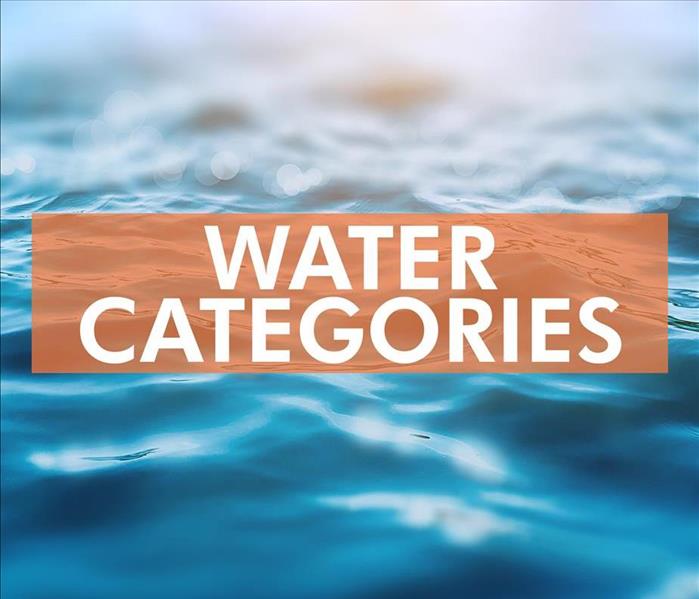 What are the three types of water categories?
What are the three types of water categories?
Water damage is a very serious issue to deal with in your home in St. Peters, MO during a storm. It’s also important to realize that there are different classifications of water contamination. Listed below are the different categories, along with some storm tips for how best to handle them.
What Are the Three Types of Water Contamination?
Clean water: Category 1 - This is water that originated from a fresh water source, such as a burst water pipe or a leaky faucet. The water starts out clean, but if not removed quickly it can become contaminated by other materials and escalate into a more serious problem.
Gray water: Category 2 - Any water that has leaked or overflowed from a dishwasher, washing machine, or feces-free toilet would fall into this category. The water may potentially contain bacteria so it should be dealt with quickly or it could become a category 3 problem.
Black water: Category 3 - Flooding that originated from streams or rivers is considered black water. Sewer backup would also be included in this category. Since this storm damage is highly contaminated, you should avoid it and call a professional immediately to handle the water cleanup.
How Can You Mitigate the Water Damage?
If the living space is flooded, you should leave the house and not return until an expert has assessed the situation. If the water is limited to a small area and you’ve determined that the source was clean water, you can follow these storm tips:
- Use heavy towels or clean rags to soak up the water
- After the water is removed, turn on a dehumidifier or fan to aid in drying the carpet
- Call a professional to inspect for mold
The safest way to handle any kind of storm damage is to follow these storm tips in the interim while you wait for the experts to assess the situation. They will be able to find the best solution for your home.
How To Fix A Leaky Roof
4/9/2020 (Permalink)
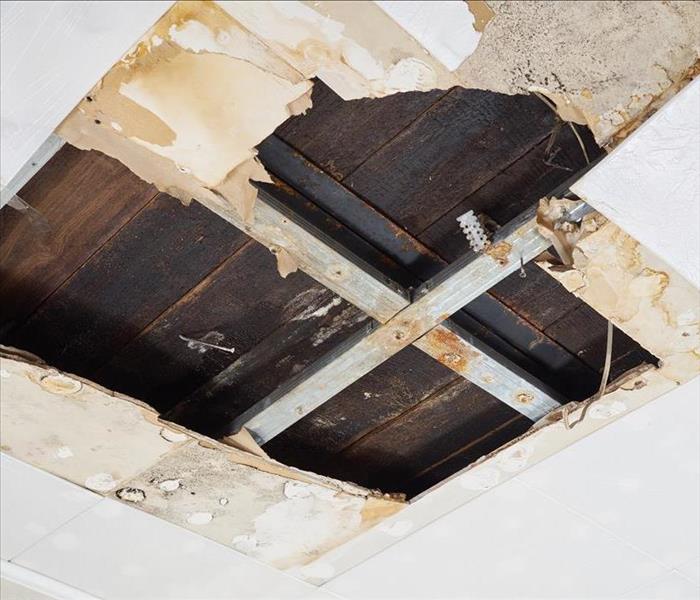 Damaged ceiling panels in a St. Charles, MO building
Damaged ceiling panels in a St. Charles, MO building
Many business owners are too busy thinking about how to manage employees and maximize the efficiency of their operations to consider the roof of their commercial building. A nasty roof leak can derail an enterprise, however, especially during a storm. Fortunately, it’s possible to prevent the devastating consequences of a damaged roof with the right preparation.
Know the Signs of a Problem
People often don’t realize that their roof is leaking until they notice water dripping from their ceiling. There are several subtle indicators of a leaky roof, including:
- Ceiling stains
- Mold or algae growth
- Buckling, curling or missing shingles
Business owners don’t have to take care of these issues during storm cleanup. They can start early and inspect their property for a roof leak before a problem gets out of hand. A sturdy roof is one less problem to worry about in the aftermath of a vicious storm, especially since it’s common for property owners in St. Charles, MO, to deal with accompanying flood damage as well.
Trust the Professionals
Commercial building restoration professionals specialize in revitalizing properties from storm damage to make it “Like it never even happened.” They’re trained in a variety of cleaning techniques to eliminate moisture and bacteria in your roof as well as all the interior areas that suffered from unwanted water and debris.
Professionals can get to work in little time and complete every step from pumping away stagnant water, disinfecting and drying a damaged area, and replacing shingles, wallpaper and carpet. They collaborate with insurance to ensure that your costs are as low as possible. Once you see the level of quality that restoration professionals in your area bring to every project, then you can feel confident contacting them for future emergencies. If inclement weather is a yearly occurrence, then it’s a great way to obtain peace-of-mind over things that you cannot control.
A roof leak and the subsequent flood cleanup requires worries many business owners, but it doesn’t have to be this way. Early detection can prevent expensive damage to your property.
We are Cleaning Experts
3/27/2020 (Permalink)
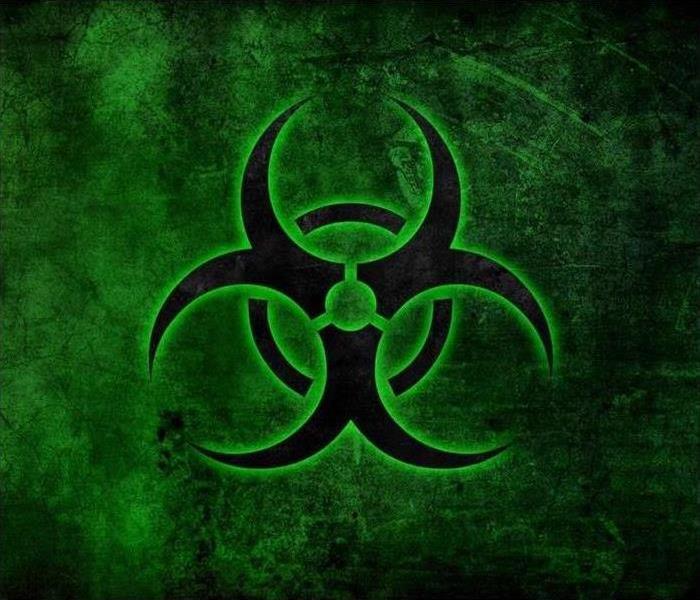 We can help you today!
We can help you today!
SERVPRO is Here to Help during this time of need
During this unprecedented time caused by the global pandemic of coronavirus, this is a reminder to our customers that we are specialists in cleaning services, and we adhere to the highest cleaning and sanitation standards.
Specialized Training
We are prepared to clean and disinfect your home or business, according to protocols set forth by the Centers for Disease Control and Prevention. We have years of experience in dealing with biological contaminants, and we will go beyond the scope of work that regular janitorial staff perform on a daily basis.
The CDC encourages cleaning of high-touch surfaces such as counters, tabletops, doorknobs, light switches, bathroom fixtures, toilets, phones, keyboards, tablets and tables. Other spaces mentioned in the CDC’s guidance for commercial spaces include:
- Kitchen/Food Areas
- Bathrooms
- Schools/Classrooms
- Offices
- Retail Spaces
- Water Fountains
- Shelving/Racks
- Sales Counters
- Carpets and Rugs
- Stair Handrails
- Elevator Cars
- Playground Equipment
- Fitness Equipment
Specialized Products
The CDC recommends usage of a labeled hospital-grade disinfectant with claims against similar pathogens to the coronavirus. Multiple products in the SERVPRO product line carry the EPA-approved emerging pathogens claims. While there is currently no product tested against this particular strain of the coronavirus, we are following all guidelines as provided by the CDC and local authorities.
Call Today for a Proactive Cleaning
If your home or business needs deep cleaning services, call the experts today – SERVPRO of St. Charles City, 636-926-0033
3 Reasons Not To Use a Home Mold Test Kit
3/26/2020 (Permalink)
 DIY mold solutions do not come with the expertise needed to perform such inspection
DIY mold solutions do not come with the expertise needed to perform such inspection
Reasons Not To Use Home Testing Kits
Almost everyone will find mold in their home from time to time. A small amount on your shower curtain or that loaf of bread you forgot about is not cause for major concern. However, a large infestation can require professional assistance. For that reason, many homeowners are interested in testing to uncover hidden mold problems. Unfortunately, there are reasons not to use home testing kits.
1. Home Test Kits Are Unreliable
Consumer Reports tested numerous home kits and found them all to be unreliable. Additionally, they found that identifying the particular type of mold in your home is less important than removing it. If you suspect you have a problem, it can be wise to contact a mold remediation professional in Portage Des Sioux, MO, promptly.
2. False Positives Are Common
Because mold spores are constantly floating in the air, being brought in on shoes and clothing, or even by the family pet, they are always present in your home. As long as the concentration of spores does not get too high, this is usually not a problem. Mold testing with a home mold kit will often give a false positive for a problematic infestation when none is present, simply because it detects normal levels of spores in your home. Additionally, some kits are not properly sealed and may have been contaminated with spores before you purchased them.
3. You Need an Inspection
In order to properly diagnose a mold problem and determine how best to eliminate it, your property needs to be inspected by a professional in Portage Des Sioux, MO. DIY mold solutions do not come with the expertise needed to perform such inspection and thus are of little value.
Concerned homeowners often turn to home mold testing when they suspect they may have a problem. Unfortunately, home kits are unreliable indicators that do not come with the expertise needed to detect and eliminate infestations and sometimes indicate problems where there are none.
How Can I Protect My Business from a Flood?
3/20/2020 (Permalink)
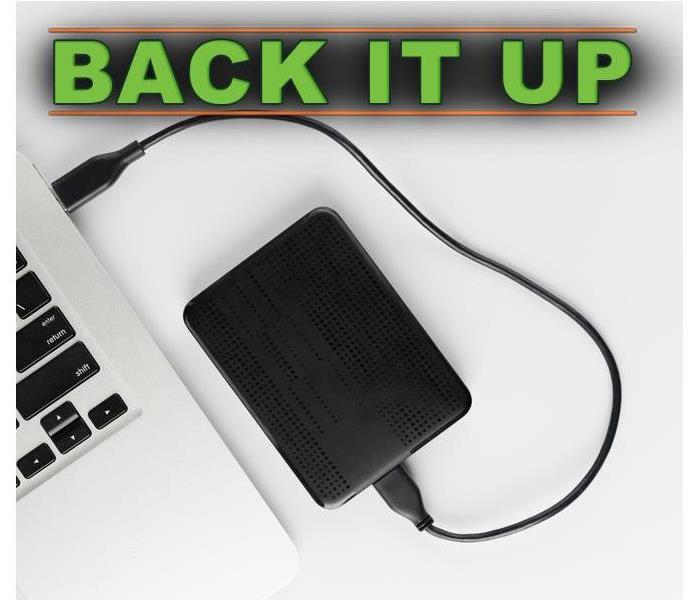 Make sure that all of your important computer data is backed up
Make sure that all of your important computer data is backed up
How Can I Protect My Business from a Flood?
If your business is in a flood-prone area, you have every reason to prepare for the inevitable. Flooding can happen quickly during heavy rain. You can begin making long-term preparations today. Then, when you hear that there’s a flood warning, you can make more immediate preparations. Reduce flood damage as much as possible by following these steps:
1. Protect Valuables
Move any valuable items or electronic equipment to an elevated location. Unplug electronics to avoid electrocution.
2. Protect Important Documents
Keep all important documents in a waterproof location. For more security, scan the documents to make digital copies, then back them up.
3. Backup Computer Data
Make sure that all of your important computer data is backed up in case your computer equipment is damaged. Saving to the cloud is ideal since it’s stored in a secure location. You can also backup to an external hard drive to be kept in a waterproof location.
4. Clean Gutters and Drains
Keep your gutters and storm drains maintained. Doing this can potentially keep your building from flooding or will make the damage less severe if it does.
5. Review Your Insurance Policy
If you’re in a flood-prone area, make sure that you have flood insurance and that your business insurance has the proper amount of coverage. Ask your agent about business interruption coverage to cover lost business revenue and employee salaries should a disaster occur.
6. Stock Emergency Supplies
Keep a well-stocked first-aid kit for any type of emergency. Also, keep a battery-powered radio, plenty of drinking water and non-perishable food, flashlights, blankets, sandbags, and a wet/dry vacuum.
7. Create an Emergency Contact List
Make emergency contact information easily accessible to you and your employees. Include family of employees, your business associates, your insurance agent, and remediation professionals.
It’s important to prepare for potential flooding well before a water incursion occurs at your Weldon Spring, MO, building. However, some flood damage can be unavoidable. Whether your building has suffered a flood of black water or secondary damage such as mold, remediation professionals can return your building to its preloss condition.
Boarding Up After a Fire Is Essential
2/26/2020 (Permalink)
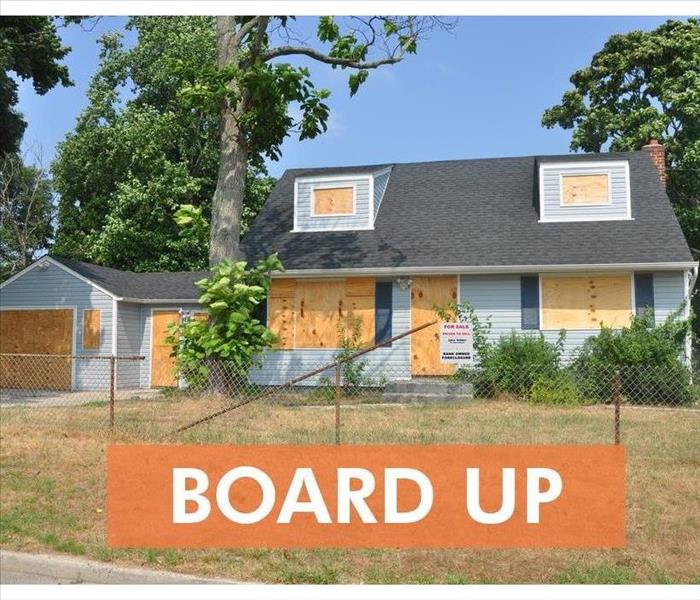 Don't neglect the board up phase
Don't neglect the board up phase
Boarding Up After a Fire Is Essential
After a fire, your home in O'Fallon, MO, may look and feel like a loss, but it is still a very valuable asset. In fact, the temptation may be to walk away for a bit, trying to remove the emotional pain and physical sight of the destruction. However, it's more important now than ever to stay, working with a fire restoration company to board up the premises, securing it and you from any further harm.
1. Don't Jeopardize Your Coverage
As soon as you wrap up with the fire company, contact your insurance agency and a restoration business. These crews will be essential in the recovery process. As a matter of fact, your insurer may require boarding measures to be taken to prevent other trouble. The restoration team, then, should begin emergency board up. At this time, they assess the building's structure, identifying weak areas, cracks or holes. Vulnerable areas should have boards and tarps placed over them. If not done, it's possible your carrier could deny coverage or make the proceedings more difficult.
2. Avoid Intruders
Exposed houses mean an opportunity for theft or trespassers; therefore, board up in order to lock the place down. Animals could sneak in, taking harbor in your rooms and creating more of a mess for you to handle. In addition, the open windows or doors are a calling card for robberies, asking people to simply try and see what you have left; thus, closing up protects your valuables.
3. Prevent More Harm
Fire damage is costly. Anything that happens afterward could simply increase the bill, so don't allow the environmental factors to ruin your place more. The fire may have ruined shingles, window frames or sideboards, allowing rain and wind to infiltrate. Closing off these areas could help guard from roof collapse, water accumulation, and mold development.
Don't neglect the board up phase. Reinforce your roof, walls, and windows so that you can maintain coverage and avoid major headaches.
How to Handle Leaks in Light Fixtures
2/14/2020 (Permalink)
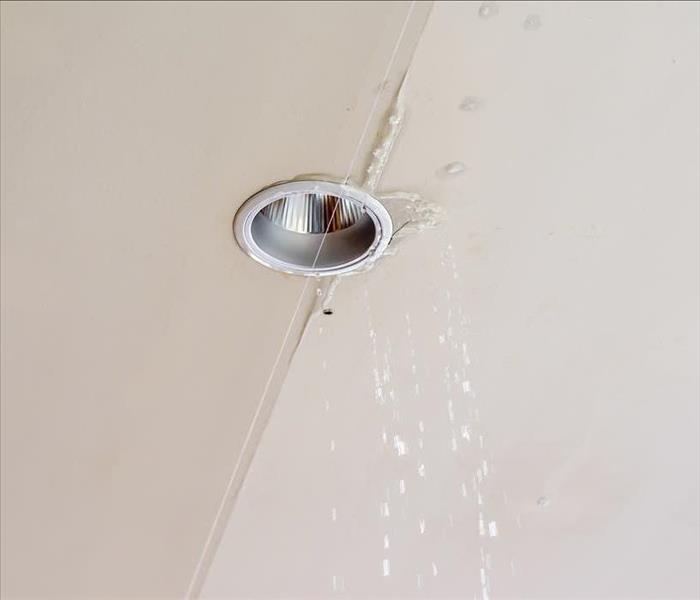 A "water in light" situation is the worst thing that could happen in the event of a leak
A "water in light" situation is the worst thing that could happen in the event of a leak
Possible Causes Of Water In Light Fixture
As a homeowner in St. Peters, MO, a "water in light" situation is the worst thing that could happen in the event of a leak. The result is a highly hazardous situation that requires urgent professional attention. The last thing you want to do is test your DIY talents with this type of project.
Possible causes of water in light include:
- An overflowing AC drip pan
- A leaking bathroom directly above
- Broken fire sprinklers
Turn Off the Electricity
There's no doubt water and electricity don't mix. For that reason alone, turn off the power at the main switchboard immediately you notice water in the electrical fixtures. That will mitigate ceiling damage and give you time to inform everyone of the impending danger.
However, do not assume the power is off just because you flipped a switch. Water can be pretty unpredictable, and there's no telling when or if it will get into the switch box. Instead, use a non-contact voltage tester to make sure the electricity is off.
Shut Off Water Supply
Depending on the situation, the leak could be coming from a plumbing accident. If so, find the main valve and turn it counterclockwise to cut the water supply. That should stop further water damage, saving you thousands of dollars.
Call the Professionals
Next, have a plumber come on-site to asses the leak. They should fix it quickly and get the area ready for electrical work. After that, get an electrician to replace the light fixture.
Keep in mind that this restoration process may take a long time to complete as the experts have to make sure the entire electrical system is free of water.
That said, please do not attempt to fix the "water in light leak" – unless you have training and experience in dealing with flooded electrical systems. Things can head south in an instant, leaving you homeless or even worse.
What To Know About Frozen Pipes
1/31/2020 (Permalink)
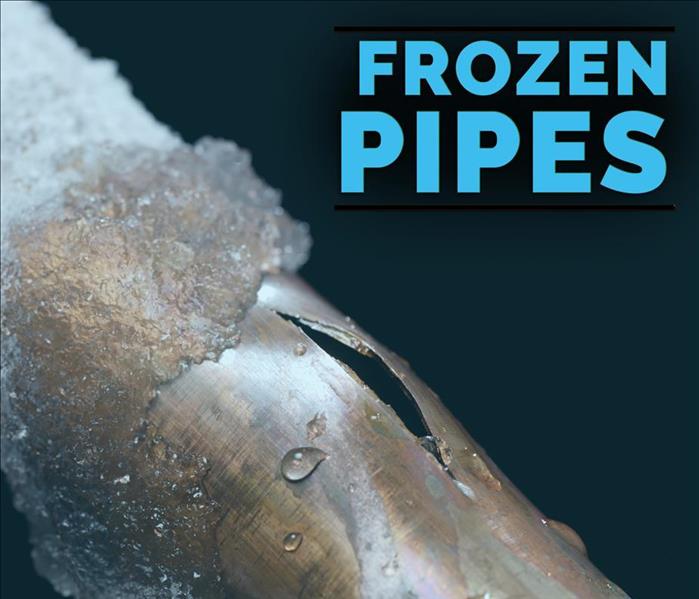 Cold temperatures can lead to freezing which in turn can cause water damage
Cold temperatures can lead to freezing which in turn can cause water damage
What To Know About Frozen Pipes
Many business owners in St. Charles, MO, find that water damage occurs after a pipe freeze. There are a few things business owners should know about their pipes and any cold weather they may experience in their area. If you think you may be at risk for frozen pipes there are a few things you should know
1. How Freezing Leads To Damage
When water freezes it expands. These means that any water in the pipes during cold weather can expand and bush against the walls creating stress points. Enough stress from within can lead cracks which in turn can create broken pipes. When the water thaws it can seep through any cracks and create a leak, or if the chink is large enough flood the area.
2. Winterizing May Help Prevent Freezing
One way to help prevent this type of water damage is to winterize the pipes. This process usually involves turning of any water to outdoor spigots, and draining the water to ensure these pipes are empty. Pipes in areas where there is no insulation from outside temperatures may require additional insulation.
3. Damage Should Be Quickly Fixed
In the even that a frozen pipe does lead to flooding, it’s best to have the damage repaired as quickly as possible. If left unattended water caused damage can seep further in and lead to issues such as mold, swollen wood, and even cracks in the foundation. Fortunately, a local damage restoration service can help with a water cleanup as well as any repairs that need to be made.
Cold temperatures can lead to freezing which in turn can cause water damage. Winterizing your business’s pipes can help prevent this problem, but if damage does occur a local restoration service may be able to help. Remember, if damage does occur, it’s best to have it taken care of as quickly as possible.
How SERVPRO Works With Insurance Providers
1/27/2020 (Permalink)
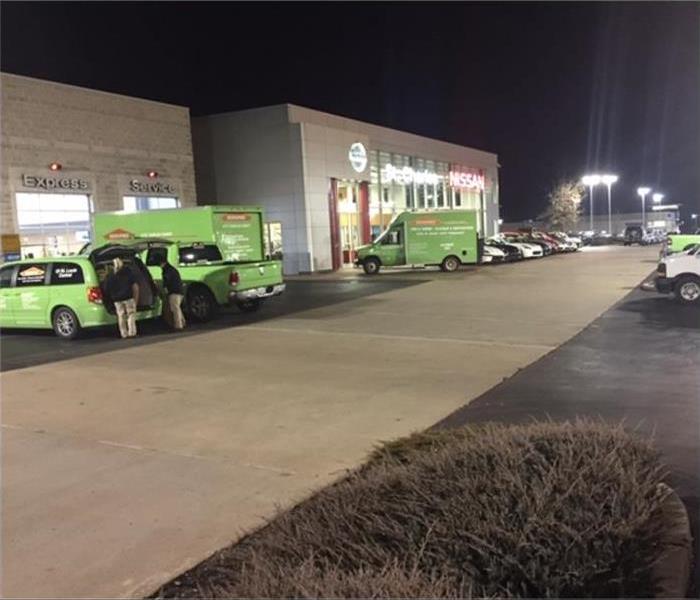 SERVPRO responds immediately to any emergency
SERVPRO responds immediately to any emergency
From offering claim services that make it easier for insurance agents to do their jobs effectively to reducing costs wherever possible, there are many reasons SERVPRO is a preferred vendor for many major insurance companies. Here are just a few of the ways they can help.
What Claim Services SERVPRO Offers
While serving clients in Portage Des Sioux, MO, in a speedy manner and consistently restoring properties to their original condition is an important part of what a restoration company does, it is also important to keep the insurance agent or adjuster in mind. The following services help makes claim process run smoothly and efficiently:
Immediate Emergency Response: Quickly making it onto the property helps reduce damage and allows for the claim to be filed in a timely manner.
Claims inventory: An itemized loss inventory and report makes it easy to see exactly what items have been lost and what needs to be replaced. An Excel formatted report can be provided to insurance companies, which includes pictures of items.
Electronic Claims: Easily access electronic job files online and review important information such as detailed estimates, paperwork, photos, and more.
How SERVPRO Keeps Claim Costs Down
One of the main ways claim costs are reduced is by striving to always restore items instead of replacing them. From personal belongings to building structures, making repairs where necessary is significantly less expensive and gives the client a better chance of keeping valuable or sentimental items. Additionally, insurance providers are satisfied knowing that every possible effort is taken to minimize the damage. By pretesting items during the emergency response process, the restoration and cleanup crew can determine ahead of time what can be salvaged.
By organizing information and making it easily accessible at any time, claim services allow insurance agents and adjusters to quickly do their jobs. Additionally, a restore over replace mentality helps reduce the overall cost, keeping both providers and clients satisfied.
Preventing Mold Growth in Commercial Buildings
1/9/2020 (Permalink)
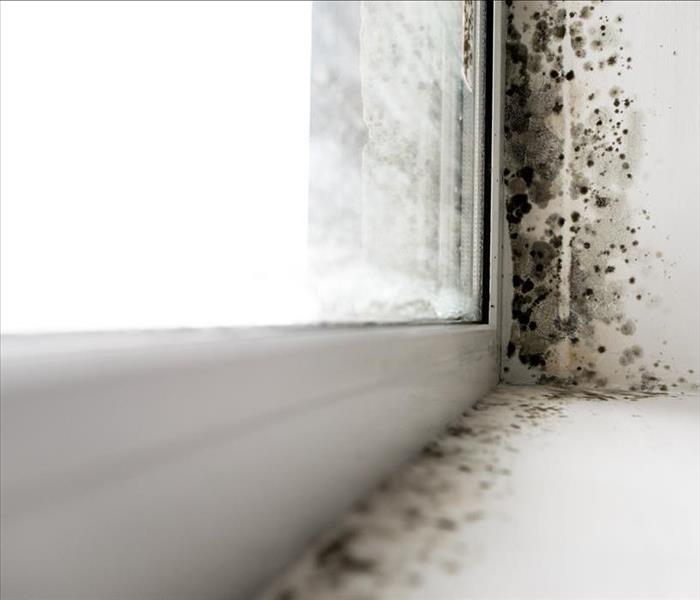 Mold growth in Weldon Spring, MO
Mold growth in Weldon Spring, MO
Black mold can be a major problem for your Weldon Spring, MO, business. In addition to the potential health effects associated with this type of mold, it can also permanently damage the contents and structure. Fortunately, it is possible to prevent mold growth in many cases.
Where Mold Grows
Knowing where to check for mold is key in catching a problem before it becomes serious. The following are some common locations for mold growth:
- Bathrooms
- Kitchens
- Carpet
- Upholstery
- Ductwork
Be sure to check these areas routinely for any signs of mold growth, and begin mold cleanup as soon as possible. If you are unable to check the ductwork yourself, you can ask your HVAC technician to perform an inspection.
How To Prevent Mold Growth
All mold types, including black mold, need moisture to grow. Because fungi can survive on many surfaces and grow at a wide range of indoor temperatures, it is important to keep the building dry. Try to keep the indoor humidity below 50%. You may need to use a dehumidifier to accomplish this. Also make sure that all items are fully dry before being put away. If you discover a moisture problem, address it immediately. In addition to keeping your building dry, you can deter mold growth by keeping the mold spores in the area to a minimum. A HEPA air purifier can help with this. Additionally, using a vacuum cleaner with a HEPA filter can capture more mold spores than can a traditional vacuum. During routine cleanings, make sure to use a cleaner that will kill mold spores before they have a chance to begin growing. Bleach, vinegar and many commercial cleaning solutions can accomplish this.
Even the most conscientious business owner can discover black mold and other fungi in a commercial building. Fortunately, a certified restoration company can help you get your Weldon Spring, MO, business back to normal quickly and safely.
Traits Every Restoration Company Should Have
12/26/2019 (Permalink)
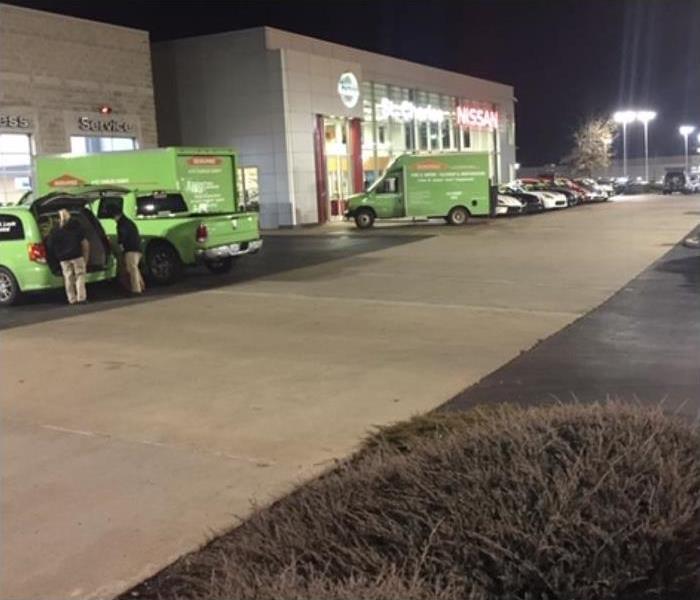 When your needs are great, you rely on the best help possible
When your needs are great, you rely on the best help possible
Traits Every Restoration Company Should Have
When your needs are great, you rely on the best help possible. This is certainly true when there's a fire in your office. Getting out safely and putting out the fire is only part of the ordeal. The aftermath and the extensive cleanup that goes with it are critical to your business. For a smooth transition back to regular operations, you need a skilled fire damage restoration company to lead the process.
Experience
You wouldn't want to hire a group of novices to handle a job this important. As you get bids from different commercial fire cleanup companies, look for ones that have been in business for several years or decades. When you work with a long-established team of professionals to restore your Weldon Spring, MO, office, you get the following benefits:
- Technicians who understand the fire remediation process
- Experts who have the right training and tools for the job
- Professionals who are accustomed to handling tasks of any size
Responsiveness
You may require a team of smoke cleanup specialists to come to your office at a moment's notice. If you've experienced a fire, you can't afford to wait long for crews to start tearing out damaged items and replacing materials. Luckily, the best companies are ready, willing and able to begin the project immediately. These teams will arrive the same day you call, assess the damage and develop a restoration plan.
Professionalism
Before you hire a fire damage restoration company, talk to the organization's leadership about their process. During your initial interview, you can tell what kind of service you'll get. Good companies will communicate well with you and will be courteous and respectful toward your business. The team will work quickly but efficiently.
With thorough fire damage restoration, even the most devastating fires won't keep your business from bouncing back. Emphasize these characteristics when you look for a disaster recovery company.
Water in Light Fixtures Requires Precaution
12/13/2019 (Permalink)
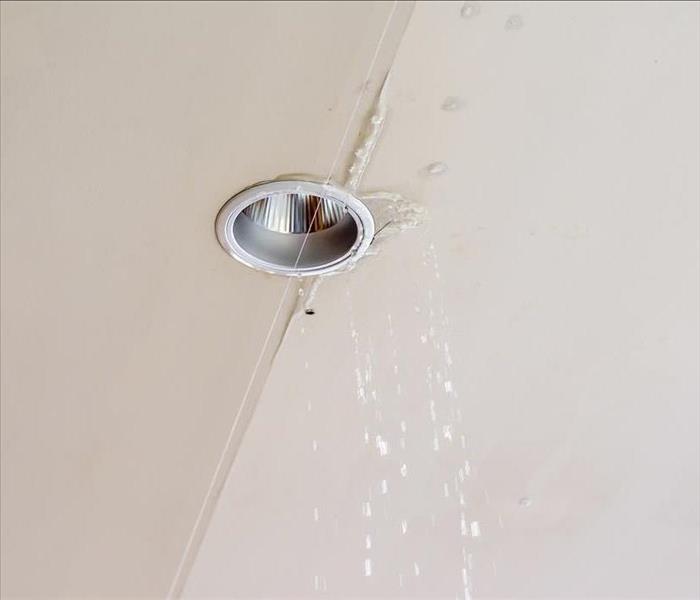 When there is water in light fixtures it becomes a more serious issue
When there is water in light fixtures it becomes a more serious issue
A water leak in your St. Peters,MO, is a hassle. When there is water in light fixtures, that hassle quickly becomes a more serious issue. Since water is an electrical conductor, a ceiling leak requires extra safety precautions. Although you may want to jump right in and solve the issue, staying safe needs to be the first priority.
4 Safety Precautions
At the first signs of water in a light fixture, take the following safety precautions to ensure no one is injured or a fire starts.
Immediately turn off the water and electricity in the home. This will stop extra water coming in if it is from a pipe burst and reduce the chances of an electrical fire starting.
Communicate the situation to everyone in the home. It is best to stay clear of any electrical sources until the situation is remedied. If possible, block access to the affected area.
Test that the electricity is off with a non-contact voltage tester. This includes checking outlets, switches, and appliances. Be sure to not touch sources with visible moisture.
Get professional help. A licensed electrician and water damage expert can help ensure the situation is safely handled and repaired.
Safe Cleanup
After finding water in light and taking the above precautions, you can begin to do some minor cleanup while you wait for the professionals. If water can still be visibly seen dripping, capture it with buckets or large bowls. Towels and newspapers can be used to absorb the standing water. Any rugs, furniture or other items that have been affected should be removed to dry out.
It's also important to find the source of the problem. Ceiling damage is often a result of a roof leak or plumbing issues. If there is a bathroom above the affected area, you will want to also call a plumber.
Water in light fixtures is not something to be taken lightly. By taking a few extra precautions, you can safely get the situation handled and your home back to normal.
FAQs About Mold Testing Kits and DIY Mold Testing
11/27/2019 (Permalink)
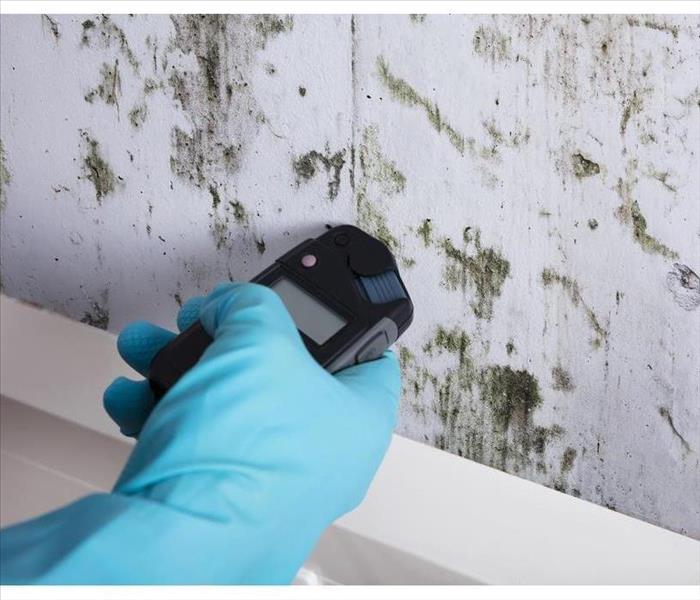 Mold testing in a St.Charles, MO home
Mold testing in a St.Charles, MO home
Many homeowners in St. Charles, MO, notice mold growth in their homes throughout the year. Though it can be tempting to rely on a store-bought mold testing kit, there are several things homeowners may not realize about mold growth and these kits.
What Causes Mold Growth?
There are a variety of factors that can contribute to the growth and spread of mold in homes. Most types of mold thrive in humid environments, making mold especially common in bathrooms, kitchens, basements and attics. For nutrients, mold can use almost any organic material, such as wood. Leaking sinks, broken appliances, cracks in a home's foundation and leaky roofs are frequently the cause of mold growth in homes.
Should You Use a Mold Kit To Test for Mold Growth?
When homeowners spot mold in their homes, many consider using store-bought mold testing kits. These kits appeal to many people due to their affordability. However, these kits are usually unreliable. Mold spores are present in many areas throughout homes, and these kits will automatically test positive due to the spores' presence. These kits don't differentiate between safe and unsafe levels of mold spores, though, which can cause homeowners unnecessary panic.What Is the Best Method of
Testing Mold?
In general, it's often best to avoid DIY mold tests. Even though the kits are affordable, they will always test positive and often don't provide accurate information about the type of mold in homes. Instead of using a kit, it's often wise to contact mold remediation specialists. Experts can accurately test for various types of mold in your home and can also mitigate the spread of mold in the process.Though you hope you will never have mold in your home, it's often wise to know how to appropriately respond in case mold does appear in your home. For homeowners, it can be beneficial to understand the cause of mold growth, why mold testing kits are inaccurate and the best methods of testing for mold in the home.
Why an Emergency Board Up Is Needed After a Fire
11/22/2019 (Permalink)
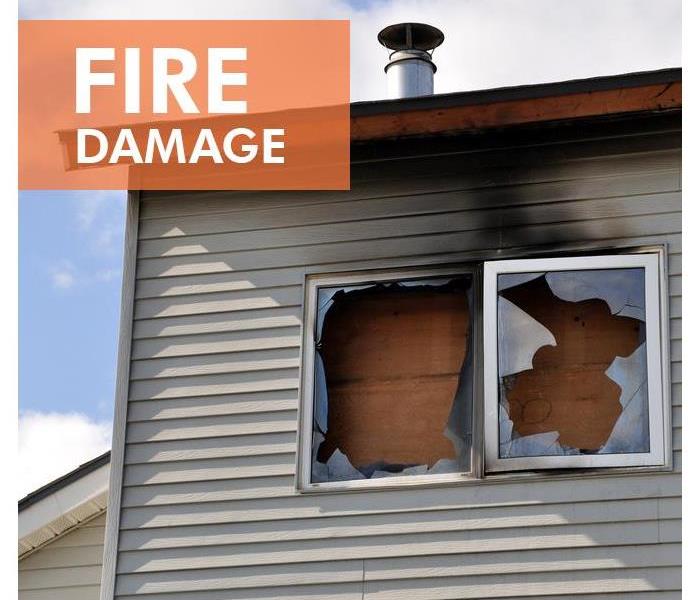 A home needs a board up if doors are broken, windows are shattered and walls are burned away
A home needs a board up if doors are broken, windows are shattered and walls are burned away
Why an Emergency Board Up Is Needed After a Fire
A home fire in Portage Des Sioux,MO, can be a traumatic event and it's possible you won't be thinking your clearest even after the flames have been extinguished. Therefore, it's a good idea to call in a professional fire remediation team to complete an inspection and a damage assessment. Trained technicians can help you avoid mistakes and offer advice that will keep you and your family safe. It's tempting for many people to want to get away from the home and take a break, but it may be beneficial to board up the property before leaving, or to put a tarp over the roof.
Secure Your Home After a Fire
A compromised home exposes property owners to a number of potential liabilities. An emergency board up protects you and your home in the following ways:
- Criminals won't be able to enter your home and steal valuables
- Children won't explore the property and hurt themselves
- Bad weather won't cause additional damage to the home
- Insurance coverage won't be jeopardized because the home was unsecured
A home needs a board up if doors are broken or burned down, windows are shattered and walls are burned away. A tarp might be necessary if the roof is damaged enough to allow in moisture.
Hire a Professional
Serious fire damage requires the work of a professional team. Their services will save you the trouble of having to carry heavy boards onto ladders, risking injury to yourself. They have done the work before and know which materials to use. A quality board up means having the right materials installed in the most secure manner possible. A sub-par job still leaves your home exposed to the elements and could also result in materials falling and harming family members. Recover quickly after a home fire. Get the services you need from a team that is Here to Help in a safe and efficient manner.
How To Deal With a Sewage Backup in Your Home
11/16/2019 (Permalink)
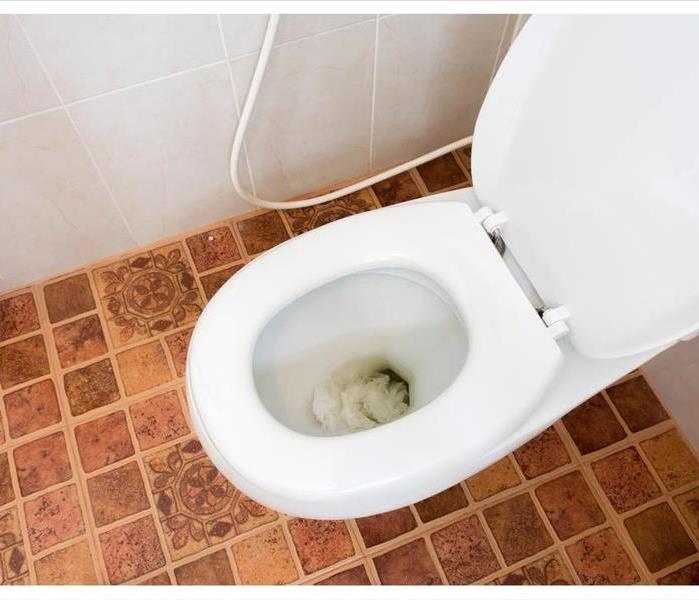 A toilet clogged can cause a sewer back up in your home
A toilet clogged can cause a sewer back up in your home
If your home in Weldon Spring,MO is your castle – a place of safety and comfort where you can spend time with your family in learning, loving and relaxing – the last thing you want to think about is a backed-up sewer. The contamination and odor are bad enough, but resolving the problem can be complicated and cleaning a sewer-flooded basement can be a nightmare.
What Causes a Sewer Backup?
There are several things that could make a sewer back up – some reasons are due to people’s actions, some are due to natural causes. This list will help explain some of the possible reasons.
Someone nearby flushed something that created a major clog, such as a diaper, a toy or some clothing, for example
Roots have grown into the main line, constricting the flow
Water has backed up into the sewer lines due to storms causing a flooded basement
A line may have broken due to frost heaves or for other reasons
What Should You Do?
If you see water coming up out of a floor drain or backing up in your toilet, call for help immediately, as it could be something serious requiring special equipment. Try to barricade the flooding if possible with rolled up towels or even sand bags in order to contain the contamination. Sewage contains not only human waste, but can also carry chemicals and toxins, so special care should be taken to keep it from spreading.
Proper Cleanup
Get help from a sewage and water restoration company in Weldon Spring,MO to use appropriate disinfectants, dispose of contaminated materials and make sure that things are safely clean. Any carpet, rugs or upholstered furnishings that were exposed to sewage water will likely need to be disposed of. Non-porous surfaces may be cleaned and disinfected.
A backed up sewer is no laughing matter, but understanding how to safely clean and restore a flooded basement can keep it from becoming catastrophic. Act quickly and get help as needed to minimize the damage.
How To Clean Up a Leaking Roof
10/30/2019 (Permalink)
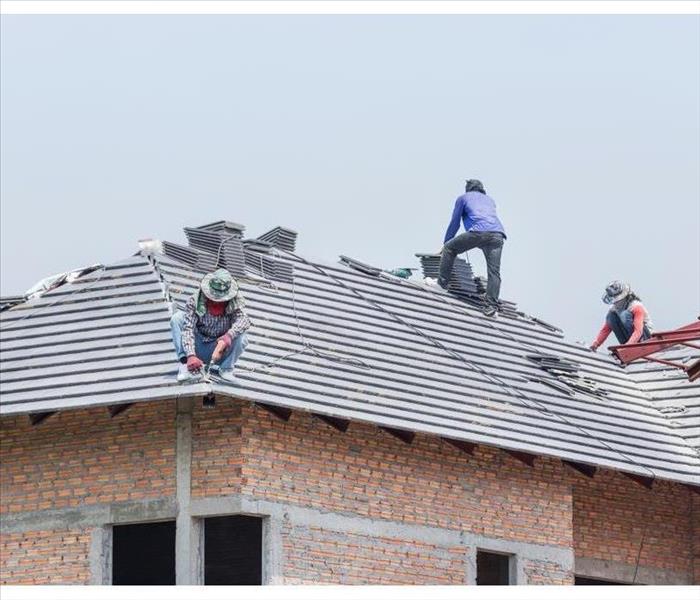 Maintaining your commercial building is essential, especially if it’s a major business investment
Maintaining your commercial building is essential, especially if it’s a major business investment
How To Clean Up a Leaking Roof
Discovering a roof leak in O'Fallon,MO, is probably on the list of least-desired problems a commercial building owner can deal with, especially if you’re not sure when it started. If you suspect that the leak occurred a few days or weeks ago, perhaps going unnoticed while you were out of the office or not using that part of the building, you might discover more damage than anticipated such as:
- Mold
- Rotted wooden trusses or beams
- Pooling water, causing bacteria growth
- Electrical damage
- Soaked insulation
Knowing what to do in these situations is critical to preventing additional structural damage.
Stop Leaks and Remove Wet Materials
If there is an active roof leak, you should first contain the leak with buckets or towels. If you notice bulges in the ceiling, this could cause a collapse at some point. If it is safe to do so, poke a hole in the middle of the bulges to release the water. It is better to have a professional do this for your safety.
Then, begin removing belongings and other easily removable items from the area. Any materials, such as dry wall and damaged flooring can be torn out by a flood restoration company.
Dry and Disinfect Area
The flooded are must then be completely dried and disinfected if necessary. If any moisture is left behind, you could develop a mold problem very quickly. Roof leak restoration companies utilize professional drying equipment, which is very thorough at removing all moisture, including inside walls.
Depending on how long it took to begin the cleanup process, there may already be mold or bacterial growth. Disinfection is necessary to ensure no spores or bacteria are left behind.
Restore Roof and Ceilings
Once the area is completely clean and dry, you can begin to restore your damaged roof. Utilizing the services of a professional company is ideal in these circumstances, because they are able to determine the structural safety of the building and what types of repairs are needed to bring your building back to how it was before the flood.
Protect Your Investment
Maintaining your commercial building is essential, especially if it’s a major business investment. If you notice missing shingles or roof damage, it is best to make repairs sooner rather than later, so you don’t end up with another flooding problem in the future. If you have discovered a leak, also make sure to document and photograph damage and repairs for insurance purposes.
3 Tips for Preventing Frozen Pipes
10/14/2019 (Permalink)
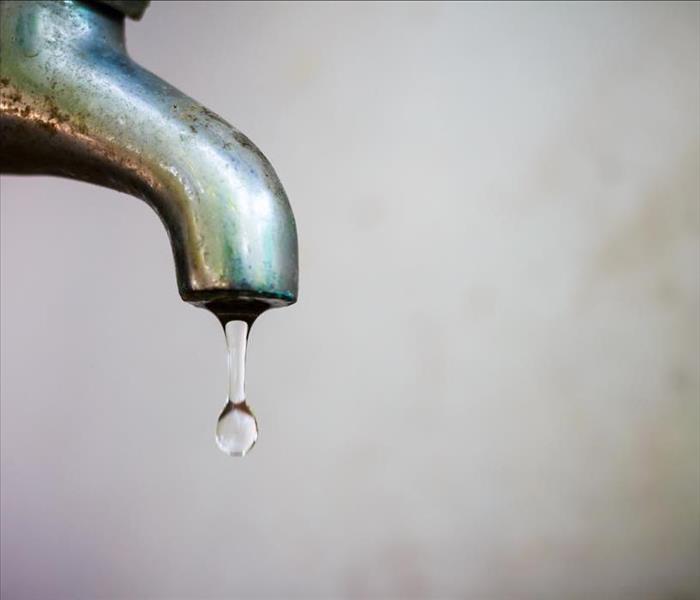 Let the faucet drip
Let the faucet drip
When it gets cold outside and you bundle up to stay warm, don't forget to give your pipes a bit of TLC. Dropping temperatures can lead to frozen pipes, causing them to burst and flood your St. Peters,MO, home. Too often, people who live in warmer climates don't take steps to protect their pipes. Remember that a pipe freeze can happen in any community when freezing temps cause an unusually cold day or two.
Metal Pipes Are the Main Risk
It's possible for pipes inside and outside the home to freeze. It's also possible that harm done during the winter may not show up until temperatures warm up again in the spring. Metal water pipes are particularly susceptible to the cold:
- Metal readily conducts cold from the water and the air
- Pipes tend to be only an inch or two in diameter
- Water systems run into the home from outside, carrying freezing temps inside
There are steps you can take to make sure the water running through your pipes doesn't freeze.
Leave the Heat On
If you plan to go out of town, leave the heat on. The ideal temperature is somewhere above 50 degrees Fahrenheit. If you generally turn your thermostat down at night, consider the same step of leaving it a bit higher when outside temperatures drop very low.
Let the Faucet Drip
When you open the faucet, water continues to move through the plumbing system, relieving pressure throughout the system. If you have hot and cold water in separate pipes, open both handles just a little bit.
Open Cabinet Doors
The pipes running under the sink can be kept a little warmer if you leave the cabinet doors open to allow access for the heated air of your home. Any rooms that you might otherwise close off should also be opened up to allow for warm air to pass through.
If you do experience frozen pipes, contact a St. Peters,MO, water damage remediation professional right away. Water causes damages quickly and freezing temperatures are sure to exacerbate the problem.
Designing Your Home Fire Escape Plan
10/7/2019 (Permalink)
 One of the best things you can do is practice your fire escape plan
One of the best things you can do is practice your fire escape plan
Tips For Designing a Good Escape Plan
In addition to installing smoke alarms, one of the most important fire preparation steps you can take is creating a fire escape plan. A well-planned strategy is critical since you generally have only one to two minutes to safely escape. Here are some tips for designing a good escape plan.
Make a Plan
The hardest part of creating your strategy is starting. Many people fail to plan because they don’t think a home fire will ever happen to them. Even if you never experience the devastating effects of a fire, being prepared for one will give you peace of mind. Here are some suggestions for starting your plan:
- Walk through your home and identify all exits.
- Draw a floor plan marking all possible exits.
- Identify two exits from each room of your home.
- Mark each smoke alarm on the floor plan map.
When making your fire escape plan, make sure infants or those family members with mobility limitations are especially considered. Assign one person to help each individual that has special needs.
Know Important Details
A home fire spreads quickly so it’s critical to know important fire preparation details. First, family members should be familiar with the sound of the smoke alarm. Second, choose an outside meeting place where all family members should congregate immediately following a fire. Third, make sure that your house number is visible from the road so that emergency professionals can find your St. Charles, MO, home.
Practice Your Plan
One of the best things you can do is practice your fire escape plan. Practice should be done at least twice a year and without advance notice. The goal is to see how quickly your family responds to an alarm. Remember to be sensitive to children so that they don’t become frightened easily. The goal is proper education, not fear.
Proper fire preparation includes designing an escape plan. Draw a floor plan of your home and mark all available exits. Educate all family members about your plan. If you ever need assistance after a home fire, there are fire restoration specialists who can help you.
Who Should You Bring in To Check for Mold?
9/25/2019 (Permalink)
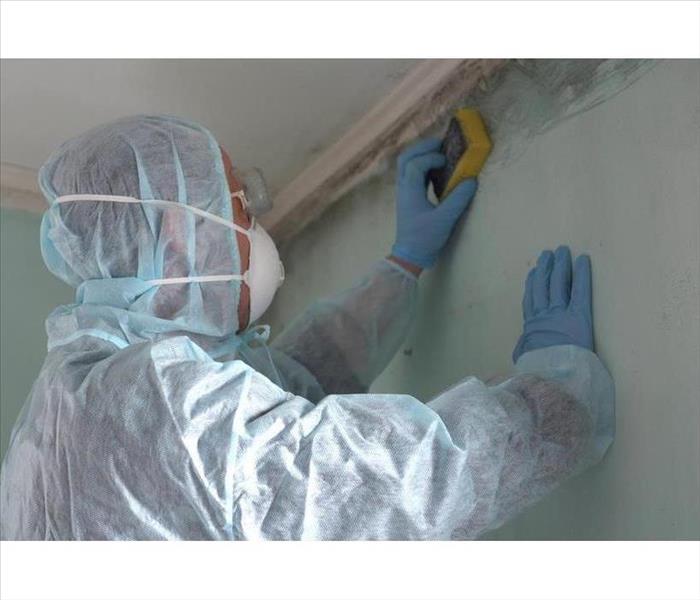 Mold cleaning in a Portage Des Sioux, MO home
Mold cleaning in a Portage Des Sioux, MO home
If you suspect mold in your home in Portage Des Sioux,MO, how can you be sure? You may be tempted to buy an at-home test kit or scrub at it yourself, but mold cleaning is a serious issue and should be treated as such.
What Is a CIH?
CIH stands for Certified Industrial Hygienist. They are trained to identify hazards to people and the environment in both the home and workplace, and also how to safely remove them, including mold remediation. These professionals are certified by the American Board of Industrial Hygiene and the Board for Global EHS Credentialing. You can be sure that a CIH has the following:
- College education
- Practical experience in the field
- Routine examination
- Ethical oversight
- Continual professional development
What Do They Know About Mold?
The short answer- a lot. CIH professionals follow mold guidelines set forth by the US Environmental Protection Agency and other state and local authorities. They are trained to provide an entire mold assessment. That means they can identify where the mold is, what type it is and the source of the growth. They can also evaluate the damages and recommend a mold cleaning protocol specific to your situation, even if it is black mold cleanup. Once the a mold remediation company has completed work, you can also bring them back to inspect the results and declare your abode safe for occupation.
How Can You Find One?
When you are searching for someone to evaluate your mold situation, keep your eyes peeled for the letters "CIH" after their name. You can visit the American Board of Industrial Hygiene's website to verify their certification or peruse the roster of certified industrial hygienists. If your insurance company is covering the cost of the mold damage, they may also have some recommendations of certified professionals that they trust.
Before you get around to mold cleaning, you will need the problem assessed. You won't be able to handle it properly if you don't know the extent of the damage or the details of the mold. That's where a CIH comes in.
How To Handle Water Damage That Spans Multiple Floors
9/25/2019 (Permalink)
 Water damage on ceiling
Water damage on ceiling
If you have sewer damage from an overflowing toilet in your building in St. Charles, MO, the immediate area may not be the only cause for concern. This is especially true if the restroom in question is not on the ground floor. Sewer water can seep into the floor and wall of the restroom and then work its way down into the ceiling and the walls of the floors below. If the flood is large enough, every lower level can be affected. This changes the cleanup process for sewage remediation experts in several ways, which also changes the rate at which they are able to complete the mitigation.
Assessment
With most sewage problems, the issue is localized in one area of the building. When you have a flooded toilet on an upper level, however, it can spread to a large portion of the floors beneath it:
- Inside walls, including insulation
- Through ceilings, including light fixtures
- On wall surfaces, including wallpaper or paint treatments
All of the sewer damage must be found and included in the initial assessment. You want technicians to be as thorough as possible so that you have a realistic itemized list to present to your insurance company.
Removal
The other step that is complicated for the sewage company in a multiple-floor job is the removal of damaged material. Although there may be multiple floors involved, they may have to work on one floor at a time to maintain the structural integrity of the building. They will likely start with the area that has the most damage. Then they can work quickly through the other areas to tear out material before it has the chance to start to grow mold. Once all the affected material is gone in an area, they can start to clean and rebuild the structure.
Sewer damage involves multiple steps to clean up anyway, but the process gets a little more complicated when it spreads to other floors. Calling restoration professionals quickly when you know there's a problem is key to making the process go as smoothly as possible.
5 Ways To Prevent Sewage Backups
9/9/2019 (Permalink)
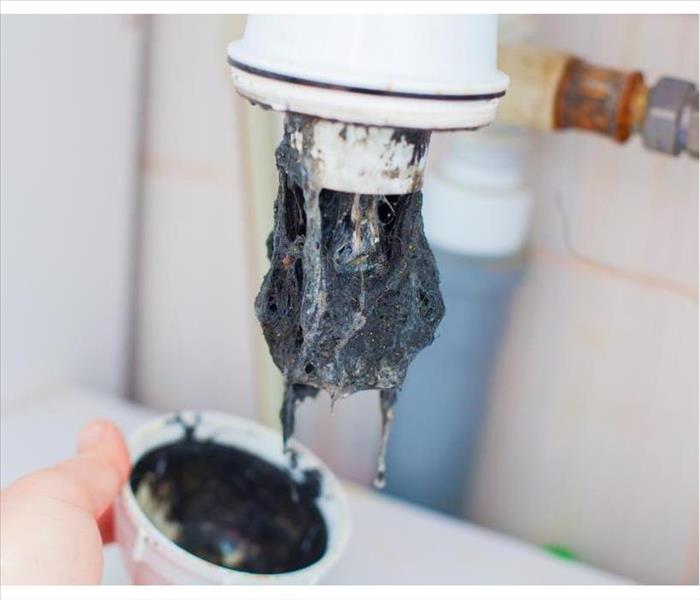 Do your best to prevent hair from traveling down your drains
Do your best to prevent hair from traveling down your drains
5 Ways To Prevent Sewage Backups
Did you know flooding in Weldon Spring,MO, can cause a sewer backup? To help prevent this common form of storm damage from occurring in your home, follow these tips.
1. Trash It, Don’t Flush It
Backed-up sewage is often caused by blocked pipes. Certain household items can contribute to this, and should never be flushed down the toilet. These items include the following:
- Paper towels
- Wet wipes
- Hygiene products
- Diapers
Even if the packaging says it’s alright, it’s not a good idea to flush them. Be on the safe side and put them in the trash instead.
2. Stop Hair From Going Down the Drain
Hair, especially if it’s long, is another contributing factor to clogs. Do your best to prevent hair from traveling down your drains. You may need to invest in a shower drain cover to catch the hair. If the hair has gone too far, you might even need to snake your pipes.
3. Dispose of Grease Properly
Although grease is a liquid when it’s hot, it quickly solidifies into a thick, pipe-clogging mess when it cools. Grease that is poured down the drain will stick to your pipes and contribute to clogs. Make sure you always properly dispose of grease after cooking to avoid a backup.
4. Keep an Eye on Tree Roots
If you have large trees near your sewer line, contact a professional to inspect the line. They can use a camera to determine if roots are damaging your system. There are solutions available for this problem, but you want to catch it early to prevent a complete block of the sewage line.
5. Act Quickly
If water is draining more slowly in your bathtub or sink, make sure you act quickly to determine the problem. A professional company offering sewer cleaning can help you identify the issue. You can then take steps to ensure the issue doesn’t turn into a messy situation.
Following these tips can help prevent sewage from backing up into your home. In the event you do experience a backup, professional residential cleaning experts in Weldon Spring,MO, are available to clean and restore your space.
Prepare for a Visit From the Insurance Adjuster
8/29/2019 (Permalink)
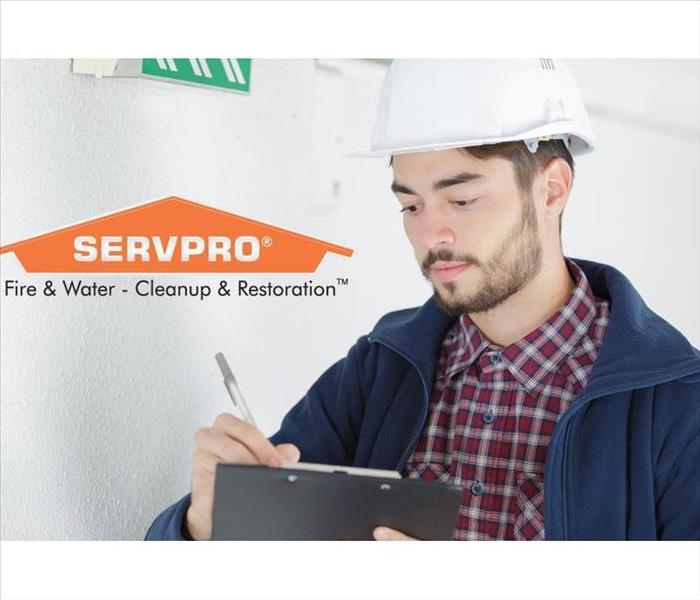 The insurance adjuster works closely with our team from start to finish
The insurance adjuster works closely with our team from start to finish
Filing a homeowner’s insurance claim in O'Fallon, MO, can be tricky if not handled correctly. Details are key in these situations, especially if the cause of the damage is not clear. To ensure your claim is accepted, you must know exactly what your policy requires you to do. If you skip some steps or miss any deadlines, the insurance agent may throw your claim out.
Contact Your Agent Immediately
Contact either your insurance agent or the insurance company to find out the specifics of your policy and what types of damage are covered. You will also need to know:
- How much time you have to file the claim
- If the claim will exceed your deductible
- How long the claim will take to process
- If they require repair estimates
Prevent Further Damage
Some insurance companies require that you do some temporary repairs or get board up services to secure the damaged areas and prevent further damage. You will want to save receipts for any purchases you make regarding the home damage, to collect insurance reimbursement. You should wait on completing large permanent repairs until the home adjuster assesses the damage.
Prepare a List
Before the home adjuster arrives, it is best to be prepared with a list of house damages as well as damaged belongings, so they can add this to their overall claim valuation. Your list should include the items, a description of each, approximate purchase date, and the replacement or repair cost. Having receipts for as many of these items as possible will help your case move more quickly.
If your insurance company requires bids from licensed contractors, collect a few written bids with materials and prices listed clearly. Keep copies of everything you provide to the home adjuster, as well as copies of paperwork they provide to you. Write down names and numbers of everyone at the company you speak with too, just in case something goes wrong with your claim.
Repair Your Home Back to Normal
Providing your home adjuster with as many details as possible will help to ensure your claim is accepted. Doing all of these things in an efficient manner is important too, as the longer some types of damages sit around, such as water damage, the more likely mold and further permanent damage can set in. Disaster remediation companies can help you repair both your home and damaged belongings quickly and thoroughly, saving you time and effort.
How To Prevent a Business Fire
8/28/2019 (Permalink)
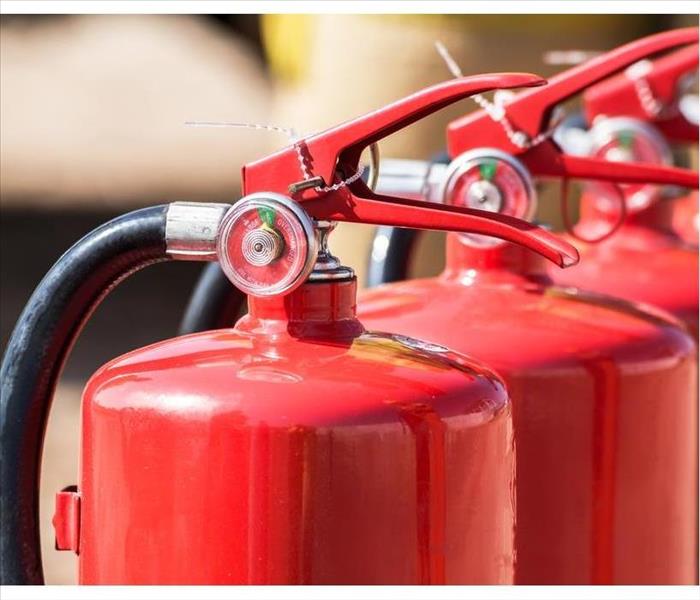 Have fire extinguishers available in your St. Charles, MO business
Have fire extinguishers available in your St. Charles, MO business
Fire Prevention Tips To Follow To Keep Your Business Safe
A business fire in St. Charles, MO, can greatly affect your bottom line. If a fire breaks out in your office building, your employees may not be able to work while the area is being restored. A store fire, meanwhile, can lead to a temporary closing and a loss of customers.
It is not just the fire’s flames that can destroy parts of your commercial building, either. Smoke damage can also occur. Thankfully, there are fire prevention tips you can follow to keep your business and employees safe.
Have Fire Extinguishers Available
A small fire can tear through a building in a hurry. You should thus make sure your building has extinguishers that your employees can use to stop a fire before it spreads. There should be at least one fire extinguisher on every floor, and employees should know where they are.
Install Sprinklers
Automatic sprinklers can prevent severe fire damage to your building. In fact, the National Fire Protection Association states that properly maintained sprinklers are 95% effective.
Unplug Appliances
Unplugging appliances at the end of each business day is a simple fire prevention step you can take. Cloth, paper and other flammable materials should also be kept away from any appliances that may overheat.
Replace and Check Wiring
Electrical wires are a common cause of commercial fires. You should thus frequently check any power cords for broken connectors or fraying. Damaged cords should be replaced immediately.
Placing too many plugs into a single outlet can also lead to fire. Only use one extension cord in each outlet, and don’t go above the maximum suggested wattage when utilizing power strips.
If a fire does occur at your business, a company that provides commercial building restoration services can get your property back to its pre-fire condition as soon as possible. However, by following the above fire prevention suggestions, you can do your part to avoid the need for such services.
Tips for Flood-Proofing Your Commercial Building
8/28/2019 (Permalink)
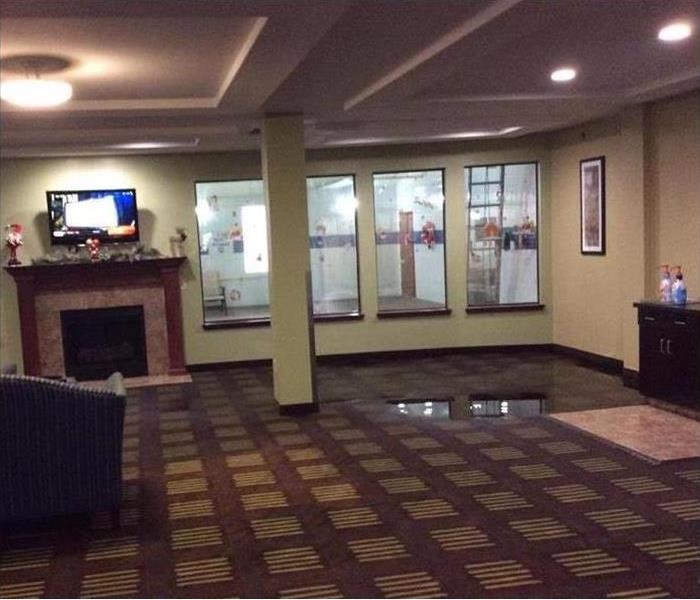 Storm damage in St. Peters, MO
Storm damage in St. Peters, MO
Steps You Can Take To Mitigate Your Damages And Protect Your Assets
A massive flood can destroy your commercial property. It can also put your entire business at risk. The National Flood Insurance Program reports that at least 25 percent of all companies that close due to flood damage never reopen.
Unfortunately, due to global warming, the odds of your company being affected by storm damage have increased in recent years. Even states that are not used to major flooding, such as Texas, have seen weather catastrophes.
If you are a business owner in a flood-prone area, there are steps you can take to mitigate your damages and protect your assets. These options include:
- Elevating your building above flood levels
- Moving your office to a higher location
- Building flood barriers
- Enacting flood-proofing measures
Flood Proofing
Seals, pumps and barriers can help limit flood damage in St. Peters,MO. However, before considering these or other flood-proofing devices, you should perform a benefit-cost analysis to see if the mitigation method you are choosing is cost-effective.
You must also inspect any flood-proofing system regularly to make sure it is working properly. Similarly, you can limit the need for flood cleanup by checking for cracks in your floors and walls before a storm arrives.
Emergency Plan
Besides flood-proofing your commercial building, you can also protect your property and assets by coming up with an emergency plan. The plan should obviously feature evacuation procedures and drills.
The plan should also state where any flood-proofing devices are located and who is responsible for implementing them. You may also want to include steps for keeping essential electrical equipment running if the power goes out.
Flood-proofing measures and an emergency plan can limit the need for storm cleanup. However, even if you properly prepare your building, it may still sustain flood damage. A commercial building restoration services company can help save your assets after a storm and get the office running again.
Guide to Mold Lawsuits Against Property Managers
7/29/2019 (Permalink)
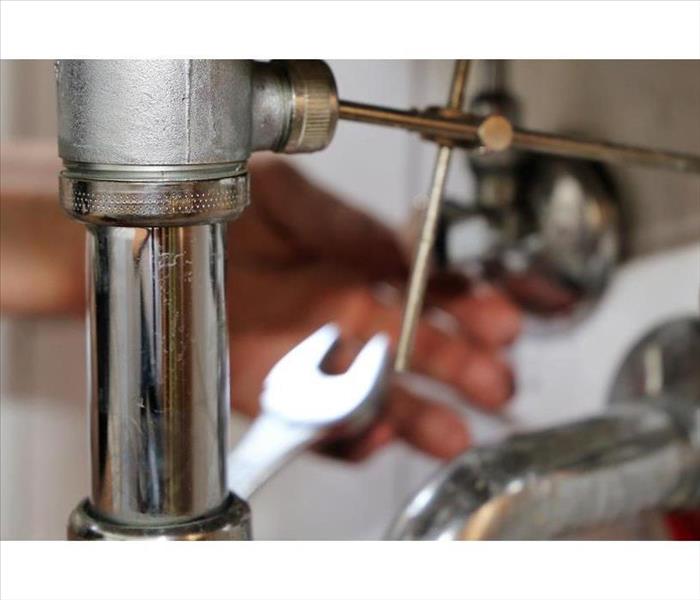 Fix plumbing leaks quickly
Fix plumbing leaks quickly
If you’re a property manager or a landlord, then you should consider mold insurance claims as crucial claims to pay attention to. If your building in Portage Des Sioux,MO, has a mold problem, you need to take care of it with the help of mold remediation specialists.
Inhabitable Conditions
Under common law, residential property owners must maintain their rental properties in a way that is habitable. What this means is that it has to be in safe condition for tenants to live in. When there is a mold infestation, the landlord becomes liable for any injuries or illness sustained by the inhabitants. Likewise, the property owner is liable for the damage that occurs on the property due to the mold. If the landlord does not pay for mold remediation, he or she may end up under a mold claim lawsuit.
Mold Prevention
If a landlord does not do everything reasonable to prevent mold, then he or she may end up sued due to mold damage. For instance, say that there is a burst pipe in the building and the property owner knows about it. Later on, the tenants discover severe water or mold damage and need to fix it. The owner is liable and should be the one to do the repairs. If he or she does not and the tenant fits the bill, then they may file mold insurance claims to receive compensation for the work.
When you own or manage a property, then you are responsible for the damage incurred. As long as the damage is not due to negligence on behalf of the owner, you generally have to pay for it. If you are a property manager and your tenants pay for mold remediation or make mold insurance claims, you should pay attention because this can result in a lawsuit. To avoid a lawsuit, remediation services can make mold out to be “Like it never even happened.”
Removing the Smoke Smell From a Home
7/21/2019 (Permalink)
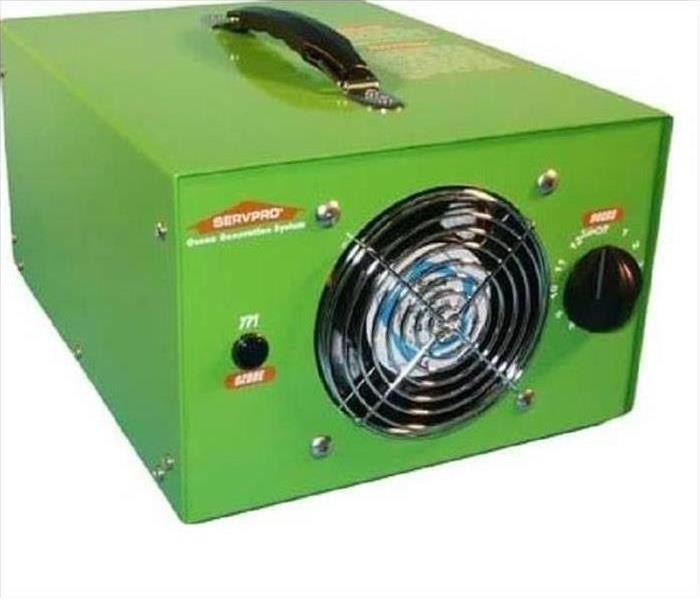 An ozone generator will kill the bacteria and molecules responsibles for the smell
An ozone generator will kill the bacteria and molecules responsibles for the smell
When most people in O'Fallon,MO, think of smoke damage, they associate it with fire cleanup. However, cigarette smoke can also pose a risk to homeowners, as it often gets ingrained in fabrics, carpets and walls. It isn’t an easy smell to eliminate, and professional restoration companies are often the most effective choice.
Why Should You Get Rid of the Smoke Smell?
Most people assume that the harmful effects of cigarette smoke are gone once the cigarette is put out. However, the lingering smell is more than just an unpleasant odor; it actually indicates that there any number of toxins present, including those below:
- Lead
- Cyanide
- Nicotine
- Arsenic
The gases, many of which are carcinogens, are absorbed into walls, furniture or even dust particles. They are then free to be recirculated throughout the air as harmful chemicals for you to breathe. Therefore, it isn’t enough to cover up the smell – you need to have a professional home deodorization.
What Do Professionals Do To Eliminate Smoke?
A professional company will be able to use an ozone generator in order to kill the bacteria and molecules responsible for the smell. They can clean any fabric or carpet to ensure your home is safe for your family and pets. You will need to be away from the area for a short period of time while the ozone dissipates, and then your home will be safe.
Why Not Do It Yourself?
While very effective at home deodorization, ozone needs to be handled properly and by professionals. The entire purpose of cigarette smoke removal is to make your home safe and give you peace of mind. You won’t have that if you’re still wondering whether smoke is present.
In order to keep your lungs healthy, you need to remove smoke damage from your home. It’s important to contact a competent company that can use ozone to kill any chemicals and bacteria that lingers. It is worth the small cost of home deodorization to make it safe and more enjoyable for family members and guests.
The Facts About Nor’easters
7/11/2019 (Permalink)
 A nor’easter is a storm in which winds blow in a northeasterly pattern as it heads along the Eastern Seaboard
A nor’easter is a storm in which winds blow in a northeasterly pattern as it heads along the Eastern Seaboard
Facts About Nor'easters
According to the National Weather Service, a Nor’easter is a storm in which winds blow in a northeasterly pattern as it heads along the Eastern Seaboard. These storms occur when cold air from the polar jet stream moves southward from Canada into the U.S., then moves to the east, where it joins the warm air moving up from the Gulf of Mexico. Here are three additional Nor'easter facts.
1. Where Do They Happen?
A Nor’easter can span thousands of miles, developing between Georgia and New Jersey. Most storms begin within a hundred miles of the East Coast. This major weather disturbance usually reaches its maximum intensity near New England and continues into the Maritime areas of Canada.
2. When Do They Happen?
This type of storm occurs any time of the year; however, the most dangerous and violent storms hit between September and April. For seven months out of the year, the East Coast has the chance to be inundated with severe weather that can last for days at a time. In March 2018, for example, four Nor’easters hit the East Coast in three weeks.
3. What Happens During a Storm?
Nor’easters are typically considered to be winter storms, but snow is not a requirement. In the worst of storms, snow can accumulate 1 to 3 inches an hour and cause blizzard-like conditions. Thundersnow is also an occurrence, although it is rare. Heavy, torrential rain and gale-force winds can leave an enormous trail of destruction and devastation.
Billions of dollars in damages can result when a massive storm crashes into your city. Whether you’re from St. Peters,MO, or another part of the U.S., flooding and other water damage is a common occurrence, not only after a Nor'easter, but also after a wide variety of severe weather events. Fortunately, there are storm damage restoration experts near you who can provide tips for protecting your home and help you minimize and mitigate the damage.
Protecting Your Commercial Building After a Fire
6/26/2019 (Permalink)
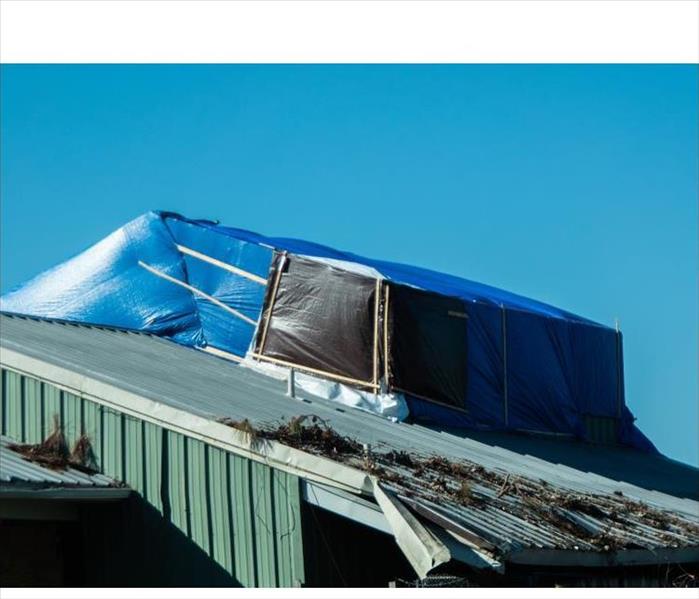 The roof can be tarped to prevent wet weather from entering
The roof can be tarped to prevent wet weather from entering
In St. Charles, MO, your business is your lifeline, so it is understandable that following a fire, your desire is to protect it from further destruction. Fire damage can also mean it is a safety hazard, so in the first place you don’t want anyone getting inside and becoming hurt or looting your building – a common problem following damage to a business. Fire cleanup needs to wait until your insurance company is alerted, but there are some things that need to be done right away.
What To Do Immediately After the Fire
The first things you should do if a fire breaks out are to get everyone out of the building as quickly as possible and to call 911 to send firefighters. No attempts should be made to re-enter the building once the fire is out. Even though you may be tempted to go look around, you should notify your insurance company and call for local fire restoration professionals to come and board up and secure the building against the weather and looters. There are several methods that can be used to close openings.
- The roof can be tarped to prevent wet weather from entering
- Sheets of plywood may be fastened over doors and windows
- Lay wooden studs in the tracks of windows and doors to prevent them opening
- Remove valuables to a secure location for storage
Fire damage can make your building more vulnerable to looting and weather damage as openings may be created by segments of the structure falling during a blaze, a firefighters battering ram through a wall or door to get water inside or even exploding chemicals. All of these openings are a potential threat to security and an invitation to a looter. Boarding up is critical to help maintain a secure building.
If you are dealing with fire damage in St. Charles, MO, get the help you need to walk you through the process and stay by your side until the restoration is complete. Fire cleanup and rehabilitation of your commercial building can help make things as good as new.
Three Crucial Steps in Removing Water From Your Flooded Basement
6/14/2019 (Permalink)
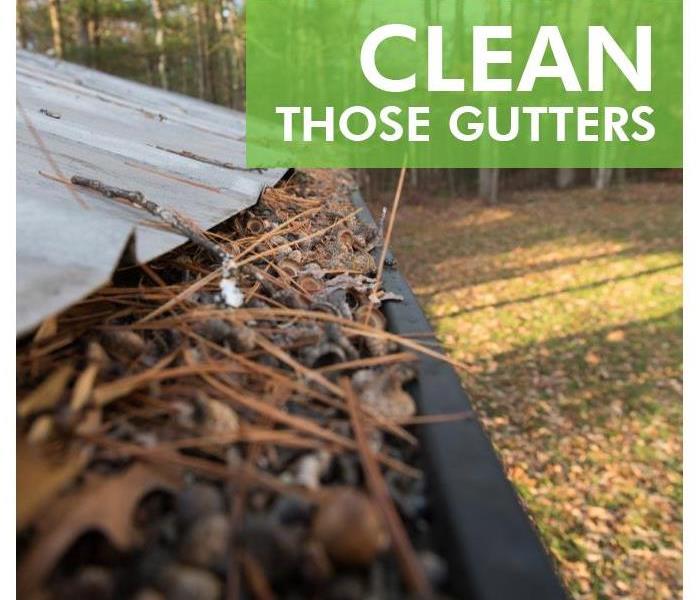 Cleaning your gutters can prevent future water problems in your home
Cleaning your gutters can prevent future water problems in your home
How to Stay Safe While Removing Water from Your Flooded Basement
Anyone that owns a home with a basement knows the fear the very thought of a foot of standing water reaching across the floor below ground can send up the spine. A basement flood is more than a nuisance; it can be a costly destructive force that destroys Christmas decorations, stored antiques, and even precious pictures and journals. The flood water can also seep into the structure of your home and weaken the foundation. No matter how the water got into your basement, you need to remove it as quickly as possible; however, to stay safe while doing so, there are three crucial steps to follow.
Stay out of the water.
The flooded basement can be an electrocution hazard, so stay out of the water. Call in a water removal and restoration team to get the liquid safely out as quickly as possible and while you are waiting for the team’s arrival, turn off the utilities to the area. If you must enter the water, wear rubber boots at least six inches higher than the water’s level and move very carefully with each step.
Know what to throw away.
Floodwaters are often filled with bacteria, fecal matter, and other chemicals that can damage your home and any items soaked by the liquid. Electronics, appliances, stored porous items, and water-soaked walls and floors resulting from a basement flood are probably damaged beyond repair. Make sure to itemize everything you throw away so you can apply for insurance coverage of each piece.
Prevent future water problems.
Floods are not always preventable. However, there are things you can do to help protect your home. Cleaning gutters, sealing foundation cracks, installing rubber water barriers, and sloping the ground around your house can help prevent future floods. Nothing is fool proof, but each of these steps can help.
A basement flood in Weldon Spring,MO, can be costly and cause serious damage to your home. When a flood does occur, use these three crucial steps when removing the water.
Where To Look for Mold in Your Home
5/30/2019 (Permalink)
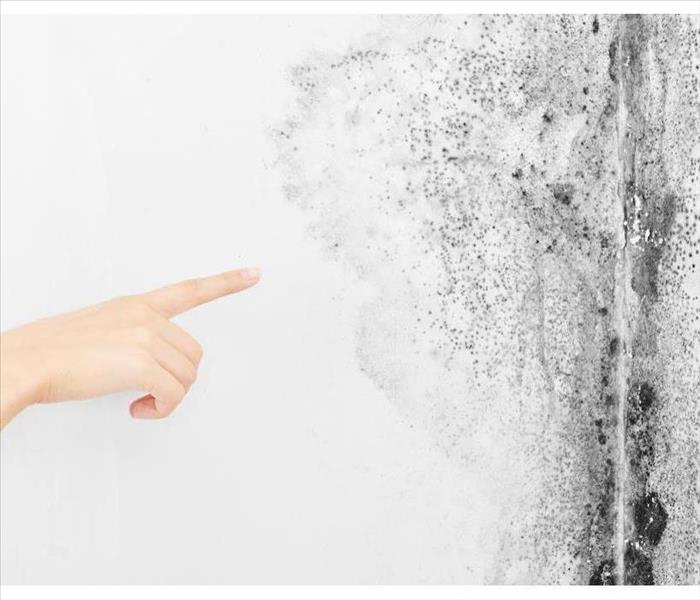 What are mold and mildew
What are mold and mildew
If you know where to look for mold, you can stop mold damage before it gets too serious. In O'Fallon,MO, this is an important issue for any homeowner. Mold can be predictable, so it’s a good idea to educate yourself about how mold works in order to stay on top of it.
What Are Mold and Mildew?
Mold is a type of fungus that can cause structural damage to your home. It reproduces via microscopic airborne spores, so it can only be seen once it begins growing as a colony. Mold growth has a fuzzy appearance due to multicellular filaments known as hyphae and can present in a variety of colors, such as black, brown, blue, green, yellow, pink and white. It emits a distinct musky odor. Mildew growth is a specific type of mold that appears chalky rather than fuzzy and is usually white or gray. It does not cause as much damage as mold.
Where Does Mold Like To Hang Out?
Since moisture facilitates mold, it is best to identify any sources of this in your home, such as leaky pipes. Mold likes to feed on organic material, such as drywall, paper, wood and fibers that have been exposed to water. You should routinely inspect the following places for mold damage.
- Basement
- Kitchen
- Bathroom
- Area near HVAC
- Anywhere that appears damp
What Should You Do When You Find It?
If you locate evidence of damage from mold in your inspections, the first thing you should do is have the problem assessed by professionals. They can recommend how to move forward via a mold remediation process. Mold can never be totally removed because it is a natural component of the air around you, but it can be managed to stay within appropriate levels. You should not attempt to remove mold on your own.
Knowing where to expect mold in your home is an important first step in preventing mold damage. Remember, mold loves moisture.
How To Prepare a Fire Escape Plan
5/22/2019 (Permalink)
 Once you have a plan, it’s often helpful to practice it frequently
Once you have a plan, it’s often helpful to practice it frequently
A Fire Escape Plan Can Help Keep You Safe
Many homes in St. Peters,MO, sustain fire damage every year. Although no one wants to think that a fire could occur in their home, having a fire escape plan can help keep you safe in case a fire starts in your home.
1. Map Out Routes of Escape
One of the first steps in making an emergency escape plan is to map out the best ways to leave your home during a fire. It can be useful to consider how you would escape from any room in your home since you may not be in your bedroom when a fire occurs. Additionally, it’s also often helpful to know multiple ways to escape each room since a fire could cut off access to some parts of your home.
2. Have the Proper Equipment
Ladders, fire blankets, smoke detectors and extinguishers can all be life-saving tools during a fire. When escaping a fire, it can be important to have access to the tools that may be helpful to you. As you make your fire escape plan, it can be helpful to make sure you have the appropriate equipment and tools located in various areas throughout the home in case you are unable to access certain areas in your home due to a fire.
3. Practice Your Plan
Once you have a plan, it’s often helpful to practice it frequently. When you practice, it’s often important to act as you would in a real fire, which means that your focus should be on exiting the home quickly and safely. Don’t bring your belongings with you; in the event of a real fire, fire restoration professionals can restore your home, but it’s important that you get out quickly. Each time you practice, you will likely feel more at ease with your plan.
By having a fire escape plan, you can feel confident in your ability to react to a disaster. In order to create a plan, it’s often helpful to map out routes of escape, have access to important equipment and to frequently practice your emergency escape plan.
3 Household Problems Caused by Winter Storms
5/17/2019 (Permalink)
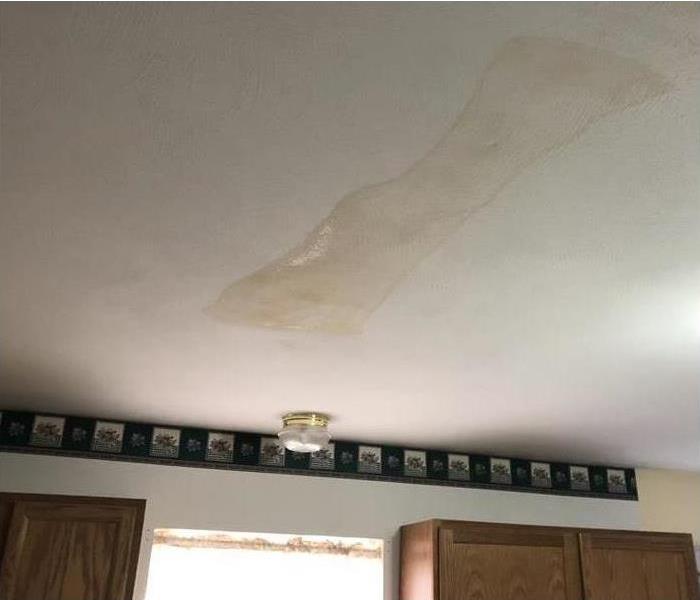 Ceiling damage due to roof leak in St. Peters, MO
Ceiling damage due to roof leak in St. Peters, MO
Three Winter Dangers That May Happen To Your Storm
Children view a winter storm in St. Peters,MO, as a break from school and a chance to build a snowman. Homeowners see a blizzard as shoveling and potential disasters. Be aware of the following three winter dangers that may happen to your home.
1. Roof Damage
During a blizzard snow has the potential to become very heavy, especially when it accumulates quickly. Buildup of snowfall on trees may cause branches to break and crash into roofing. A mere inch of wet snow gathered on your roof weighs in at 20 pounds per square foot, so an epic winter storm may incite a roof collapse. Be sure to consider your safety first, if your roof is compromised it is wise to leave the house immediately.
2. Flooding
As if a roof collapse isn’t bad enough, snow in the house melts. A lot of snow means a lot of water. Flooding damages the house structure, such as drywall and flooring. It also has the potential to damage your personal property if not dealt with immediately. When flooding is suspected, it is a good idea to contact a water restoration specialist as soon as possible to mitigate and prevent further damage to your home.
3. Fire
Unfortunately cold, wet weather does not always preclude fire from damaging your home. Storm winds may cause electrical problems or lightning may strike. Use good sense not to leave candles unattended and practice space heater safety. If a fire occurs, relocate to safety and call for help. Oftentimes both fire and water damage from firefighting efforts need to be addressed by a restoration professional after the fire.
When a winter storm strikes in St. Peters,MO, be knowledgeable about potential hazards and what to do if one occurs. Once you are prepared for the worst, expect the best. Relax, enjoy a hot drink and build a snowman with your family.
How To Estimate Fire Damage
5/17/2019 (Permalink)
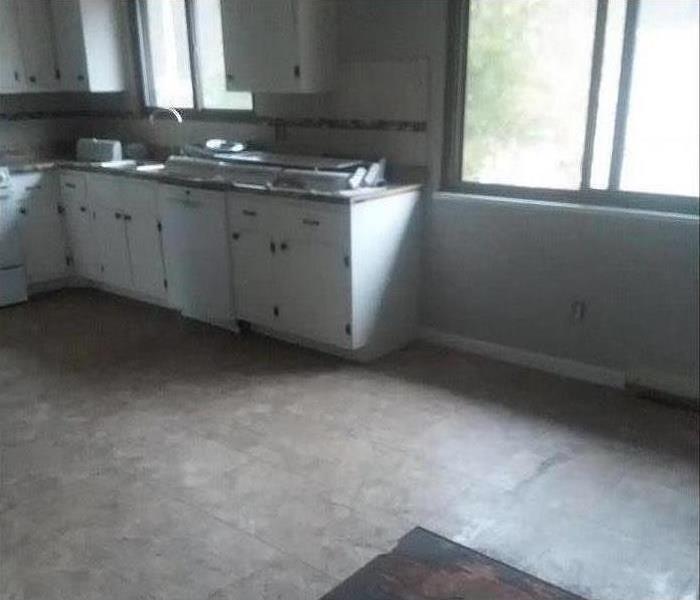 Fire damage restoration in an O'Fallon, MO, home
Fire damage restoration in an O'Fallon, MO, home
The cost of fire damage restoration can range from a few thousand dollars all the way up to $20,000 or more. Read on to learn more about how restoration professionals estimate the cost of a commercial fire.
Calculate Cleaning, Repair, and Replacement Costs
Restoration costs are determined by the extent of the damage. Many commercial properties have fire suppression systems that limit the amount of damage. Expenses will increase depending on several factors.
- The amount of damaged building materials and contents
- Materials or contents that can be cleaned
- Materials or contents that must be replaced
Some expense is involved in any restoration strategy. Professionals can ensure that mitigation measures are performed in a cost-effective and efficient manner.
Get an Estimate From a Restoration Company
A restoration company will assess damage and calculate a price for an insurance adjuster based on a variety of criteria:
- The extent of a rebuild
- The cost of cleaning or replacing materials and contents
- The duration of the restoration process
After professionals provide an estimate of the damage, property owners should have a clearer sense of the cost of restoration.
Check Your Insurance Policy
A commercial property insurance policy should cover all damage caused by a fire. The policyholder is responsible for paying the deductible. An adjuster will need to perform several tasks:
- Determining the cause of the fire
- Confirming damage reported by the owner or restoration service
- Processing the claim
Policyholders should familiarize themselves with the terms and limits of commercial property insurance coverage. The cost of a policy may go up after a fire.
The overall cost of a fire is determined by the extent of the damage, the types of restoration required, and the level of insurance coverage. After a fire at a commercial building in O'Fallon,MO, the property owner should call his or her insurance provider and schedule a consultation with a fire damage mitigation and restoration company to obtain an estimate and begin the rebuilding process.
Safety First When Dealing With a Basement Flood
5/14/2019 (Permalink)
 Find out what type of insurance coverage you have and whether your insurance company has any requirements.
Find out what type of insurance coverage you have and whether your insurance company has any requirements.
Too many homeowners regularly deal with flooded basements after heavy rainfall and during the spring thaw. What can you do when this disaster strikes your own home? Take a look at the following steps for how to safely resolve a basement flood in St. Charles City, Illinois by addressing:
- Electricity
- Gas
- Insurance requirements
Avoid Electrocution
One of the first things you need to understand is that there's more than water damage to worry about. As soon as even an inch of water has collected in the basement, you need to address the danger of electrocution and the possibility of gas problems. If you have a service panel, a water heater, or other major appliances in the basement, there is a serious risk of electrocution. If the level of water is higher than the electrical outlets, do not go into the area. Instead, call the fire department for the safe removal of much of the water.
If the water level is low, begin by shutting off the power to the basement. If the breakers or circuits are in the basement, put down a wood or plastic step stool, so you don't touch the water. Keep all appliance cords out of the water and wear rubber boots while working in the flooded area.
Prevent Gas Leaks
Contact your gas company and get specific instructions from them for dealing with flooded gas appliances. There should be a gas shutoff on the outside of your home.
Contact the Insurance Company
Find out what type of insurance coverage you have and whether your insurance company has any requirements. For example, you may need to provide photographic proof of the flooding, or the insurance company may require you to work with specific flood remediation companies. Even if you intend to handle much of the work yourself, you need to know what your insurance company expects.
After making sure that electricity, gas, and insurance requirements have been satisfied, you can move forward with removing water and addressing damages caused by the basement flood. Remember you won't get much done if you, friends, or family members are injured before you even get started.
Securing Your Building Post-Fire
5/13/2019 (Permalink)
Is your St. Charles City, commercial property suffering after a fire? If you are planning on seeking help from a local fire damage restoration company, you are already on the right track. But you also need to keep your building safe in the meantime. Follow these three steps to make sure looting does not affect your business in the aftermath of a commercial fire.
Identify and Secure Open Spaces
Survey your building very carefully when beginning your fire cleanup efforts. Ensure that all windows, doors and other open spaces are securely locked. Next, make sure that you purchase some sturdy boards that will be sufficiently protective for the type of opening that you are securing. The length of time you expect the boards to be in place should also influence what type of covering you buy.
Research Further Options
While waiting to repair fire damage to your building, you may want to invest in some fencing for added security. This really depends on whether or not you feel that your building is in an area prone to heavy looting, as well as the amount of time you expect your business to be shut down for.
Consider Advanced Security Options
If you feel that your company’s geographical area is highly unsafe or expect you will be closed for a very long time, security services or a high-tech alarm may be the way to go. These options allow your building to be secured when you are not physically available to keep a close watch.
Don’t Get Intimidated
Fire damage is stressful enough without worrying about highly customizable security options. You need to focus on fixing any destruction first and foremost, so if you think complicated security measures are out of the question logistically or financially, stick with basic, reliable boards that will keep your St. Charles City business protected not only from criminal activity, but also the unpredictable natural elements.
Is Dry Flood Proofing an Option for Your Business?
5/11/2019 (Permalink)
Protecting your building from flood damage is a crucial step in avoiding losses during natural disasters or trouble with plumbing systems. Around the country, the risk of flooding is increasing for business owners. There are a few options you can take to keep your St. Charles, MO, business safe from losses:
1. Build on or move to higher ground.
2. Create barriers around commercial structures.
3. Dry flood proof your properties.
Possible Roadblocks
Many business owners, especially of smaller operations, don't have the option of moving their property or setting up from scratch. It may also be difficult to get permission to build new structures if the business front is rented or if the community has specific requirements for new construction. In many cases, dry flood proofing is the most cost-effective route for reducing losses and damage from flooding.
A Proven Strategy
What is dry flood proofing? This strategy for protecting buildings from storm damage involves the use of seals and pumps for a water tight perimeter. The use of barriers is also a component. The U.S. Army Corps of Engineers uses this protective method. As a business owner, you may want to consider the value of this strategy for your own company.
Decision Factors
Guarding against flood damage with dry proofing is a smart move. As you consider the costs and benefits of this solution, there are several factors to take into account:
- Benefit-cost ratio involving factors such as insurance rates and business financing
- Current and future use of buildings and the potential for business disruption
- The safety of occupants on your property, including employees and customers
- Existing flood emergency operation plans
Flood damage restoration professionals can often offer information about your specific community. If a dry flood proofing plan isn't right for your business, consider an alternate emergency operational plan. While working through these steps, schedule routine inspections and ongoing maintenance. Work closely with water damage and remediation experts in your area.
3 Household Problems Caused by Winter Storms
5/10/2019 (Permalink)
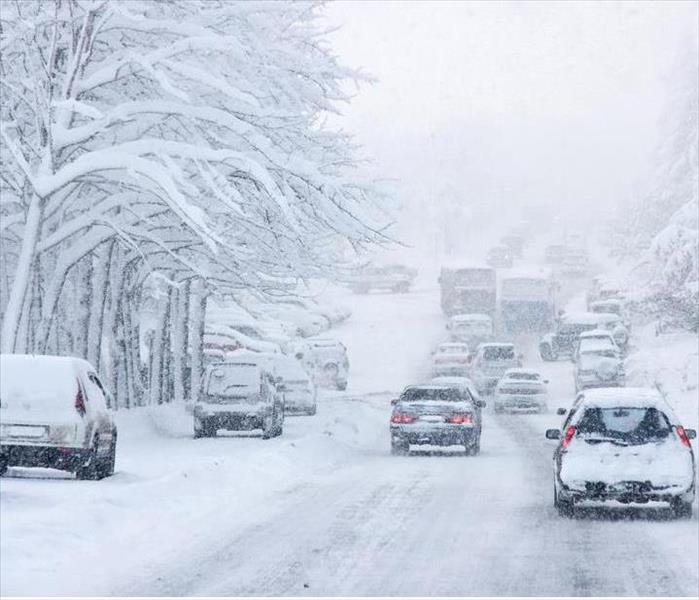 What type of issues can arise after a snow storm?
What type of issues can arise after a snow storm?
Children view a winter storm in St. Charles City, as a break from school and a chance to build a snowman. Homeowners see a blizzard as shoveling and potential disasters. Be aware of the following three winter dangers that may happen to your home.
Roof Damage
During a blizzard snow has the potential to become very heavy, especially when it accumulates quickly. Buildup of snowfall on trees may cause branches to break and crash into roofing. A mere inch of wet snow gathered on your roof weighs in at 20 pounds per square foot, so an epic winter storm may incite a roof collapse. Be sure to consider your safety first, if your roof is compromised it is wise to leave the house immediately.
Flooding
As if a roof collapse isn’t bad enough, snow in the house melts. A lot of snow means a lot of water. Flooding damages the house structure, such as drywall and flooring. It also has the potential to damage your personal property if not dealt with immediately. When flooding is suspected, it is a good idea to contact a water restoration specialist as soon as possible to mitigate and prevent further damage to your home.
Fire
Unfortunately cold, wet weather does not always preclude fire from damaging your home. Storm winds may cause electrical problems or lightning may strike. Use good sense not to leave candles unattended and practice space heater safety. If a fire occurs, relocate to safety and call for help. Oftentimes both fire and water damage from firefighting efforts need to be addressed by a restoration professional after the fire.
When a winter storm strikes in St. Charles City, be knowledgeable about potential hazards and what to do if one occurs. Once you are prepared for the worst, expect the best. Relax, enjoy a hot drink and build a snowman with your family.
4 Ways to Prevent a Fire Disaster
5/10/2019 (Permalink)
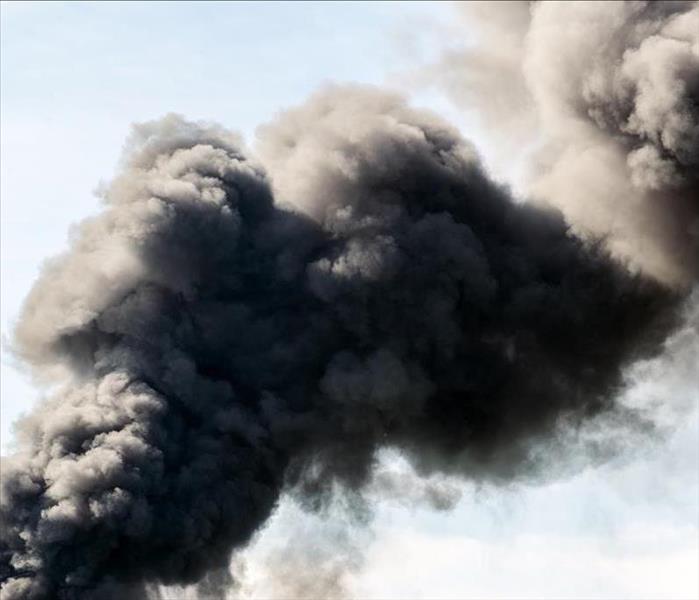 What can I do to prevent a fire?
What can I do to prevent a fire?
Every business may have some level of fire risk. This risk may be higher or lower depending on whether the buildings only have electrical devices and heating equipment or specialized machinery. There are a few fire preparation measures that property owners, employers, and staff can take to prevent fire damage. Take these four disaster preparation measures today to lower your risk.
Keep the Workplace Clean
Clutter can close off evacuation routes and feed a fire. Try to reduce the number of boxes, papers, or other materials that are left lying around a workplace. It is also a good idea to properly dispose of all waste, especially flammable materials.
Maintain Fire Safety Equipment
Regular maintenance can prevent malfunction and reduce fire risks whether a business only has standard office machines or additional machinery. Employees should be made aware of potential overheating dangers and monitor the status of equipment. Have a licensed electrician fix any problems that arise to reduce the risk posed by faulty wiring. Property owners can also regularly test fire suppression systems and ensure that fire extinguishers are frequently inspected and ready for use.
Post Emergency Information
One of the most critical fire preparation steps is to ensure that emergency numbers are posted in convenient locations. Managers and employees should be familiar with the Occupational Safety and Health Administration guidelines for fire safety in the workplace. Property owners may also want to schedule fire drill and tutorials on using extinguishers.
Provide Smoking Areas
Provide designated outdoor smoking areas and make sure that there are safe receptacles for smoldering cigarettes in these areas. Consider a self-extinguishing design that will hide unsightly cigarette butts and reduce the risk of fire.
Taking these fire preparation steps can prevent a workplace disaster. If a structure sustains fire damage, rely on a commercial fire mitigation and restoration service in St. Charles City.
5 Ways To Upkeep a Commercial Roof
5/8/2019 (Permalink)
Roof damage or deterioration can be very costly. In addition to the price of materials and labor for repairs or replacing a roof, this damage can also damage building materials and contents. Property owners can follow five simple steps to preserve the condition of a commercial roof.
5 Simple Steps
- Inspect the roof at least twice a year. Make sure you know about potential issues and all of your upkeep options to extend the life of a roof. Do this by having experts perform annual inspections. If you know what to look for, you can do at least one of these inspections yourself.
- Trim trees with overhanging branches. Reducing the number of branches and leaves that accumulate on the roof can help to keep drainage systems clear. Tree maintenance can also prevent heavy limbs from falling in the event of high winds or adverse weather conditions.
- Clear drainage systems regularly. Water that cannot drain may pool and work its way under roofing materials, resulting in leaks. Make sure that leaves and other debris are not blocking downspouts, drains, or gutters, and that drainage is routed away from the foundation.
- Regularly repair minor roofing issues. Extend the amount of time before a roof rebuild by addressing roof damage as soon as it occurs.
- Have your roof waterproofed. Waterproofing can help to prevent cracks and leaks. A roofing service can help you determine the right methods and materials for your property.
A regular maintenance schedule can help property owners address roof damage and wind damage in a timely manner. Keeping an eye on the condition of your roof can extend the life of this part of your building and prevent costly leaks. If a roof sustains damage or deteriorates to the point where the interior suffers water damage, property owners should contact a company in St. Charles City, that specializes in commercial damage restoration.
How Do Restoration Experts Clean Electronics After a Fire?
5/8/2019 (Permalink)
Electronics can easily become damaged in the event of a fire at a commercial property. Appliances and devices close to the fire may melt or warp and become unusable. Even electronics that are some distance away may sustain smoke damage that can cause short circuiting and result in an electrical fire. Electronics and computer cleanup experts can take several measures to reduce the risk of fire and restore data that might otherwise be lost.
Assessing Fire Damage
Electronics may become damaged or unpredictable after exposure to fire or smoke. Several common consequences include:
- Warping due to the heat of the fire
- Corrosion due to the acidity of smoke
- Black film coating due to soot
If a device short circuits, it can cause an electrical fire. Do not attempt to turn on electronics before handing them over to cleaning experts. Specialists can check for signs of damage and clean delicate components.
Removing Residual Debris
All build-up should be removed before a device that has been exposed to fire or smoke is tested. Restoration experts may:
- Clean circuits and other metal components
- Wipe off black film
- Vacuum out ash and soot
These methods may increase the likelihood that an electronic device can be repaired. If the device is any type of computer system, these specialists may back up or transfer data.
Backing Up Data
Regardless of whether a device seems to be functioning normally, it is still a good idea to back up data. An electronics cleaning service may offer to:
- Transfer data to a replacement device
- Back up data to a storage medium
- Upload data to secure cloud storage
Rely on the specialized services of a damage mitigation and restoration company after a fire at a commercial property in St. Charles City. These computer cleanup specialists can increase the chances of retaining important data while lowering the risk of an electrical fire.
4 Residential Flood Proofing Tips
4/25/2019 (Permalink)
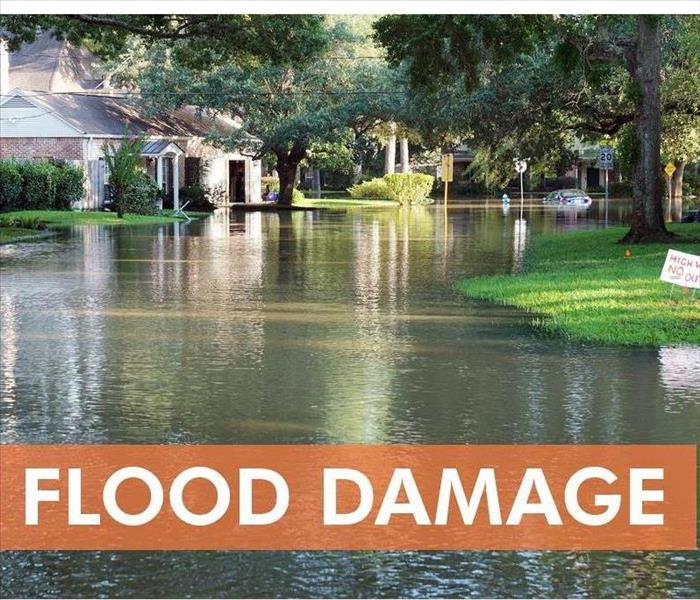 SERVPRO is committed to respond immediately to any size disaster.
SERVPRO is committed to respond immediately to any size disaster.
Four Flood Prevention And Safety Tips
Homeowners can follow these four flood prevention and safety tips to promote flood safety and keep water out of a residence in Elburn,IL. While it is helpful to flood proof a property in advance, residents should comply with evacuation orders to preserve personal safety.
1. Enhance Drainage
It may be possible to significantly reduce the flood risk of a property by hiring landscaping experts to adjust the grading or slope to ensure that water flows away from the foundation. Adding fill to a property located in a flood zone may enable a homeowner to obtain an amendment or revision on the Flood Rate Insurance Map maintained by the National Flood Insurance Program, which may reduce the cost of flood insurance coverage.
2. Invest In Reusable Flood Barriers
Owners of homes in areas that frequently flood may want to invest in sandbag alternatives for flood safety. Choose from water-filled cofferdams or self-stabilizing fence barriers. Absorbent single-use alternatives are also available.
3. Install Backup Prevention Equipment
Flooding can overwhelm a municipal main and result in sewer backups. A homeowner can hire a plumber to determine whether preventative mechanisms such as a backflow valve, standpipe or overhead sewer could be effective solutions for flood proofing a basement.
4. Anchor or Elevate Critical Components
If flooding is anticipated within days or hours, homeowners should make every effort to promote personal safety while limiting losses. Anchor or elevate critical components such as fuel tanks, generators and HVAC units. Raising indoor electrical components can also reduce electrocution risks. Relocate as many appliances as possible above the anticipated flood water level.
These safety tips can reduce the likelihood that flooding will result in extensive damage and losses at a residence. In any case, flood safety is the primary concern. If a residence suffers damage, mitigation and restoration specialists can quickly arrive on site in Elburn,IL.
Preventing Water Damage During Building Construction
4/18/2019 (Permalink)
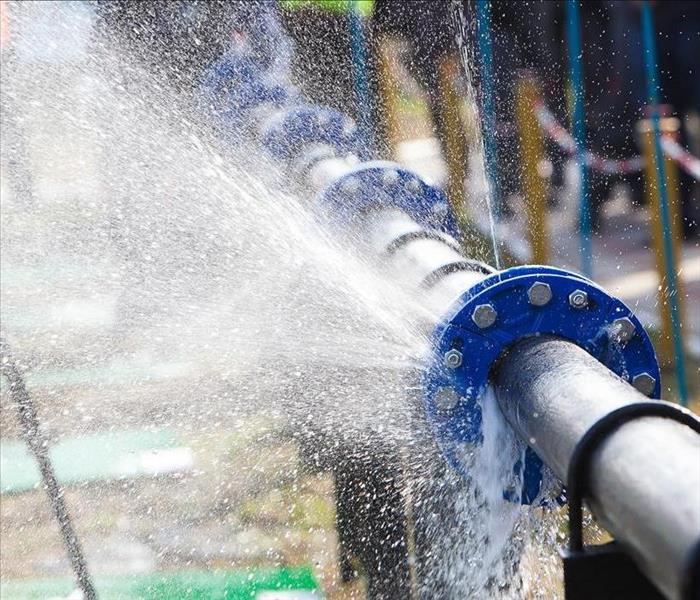 Broken pipe in a St. Peters, MO building
Broken pipe in a St. Peters, MO building
One of the most frequent losses caused during building construction is water damage. Whether it is the result of a flooding, unexpected rain storms, or a forgotten water pipe repair, the resulting water can cause delays in construction and an over-run on building material replacement costs. Here are three ways that water damage can cause problems.
Losses
Flooding from a broken pipe or a plumbing valve that was incorrectly installed can be one of the most frequent causes of water damage loss during construction. Losses can result in thousands of dollars due to
- Damaged material tear-out
- Removing debris
- Water remediation team expenses
- Material costs
- Employee wages
Reducing possible construction defects can help avert expensive repairs, as can taking precautions such as turning the water off at night to a building under construction. This can also help reduce your loss profitability.
Delays
Construction delays can result in a great deal of paperwork as insurance becomes involved. It may only be damage from a water pipe repair or sudden torrential rain storm, but when building materials are damaged, it can become costly, and contractors must turn to insurance as a partial remedy. Once water enters the building envelope, the losses in time and man-power can be staggering.
Reputation
In this social media rampant world, loss from water damage in a flooded area during construction can result in angry clients in St. Peters, MO, that may rant on one of their social walls about the building delays. That, in turn, can influence the way others look at you and your crew, and it may even prevent the possibility of future jobs.
Reducing water damage can be as simple as checking for water pipe repair issues during construction. By avoiding flooding, you can often prevent schedule delays and increase your profits. If you do have water damage problems, contact a water remediation team immediately for help to alleviate secondary water damage.
How Ice Dams Contribute to Mold Growth
4/12/2019 (Permalink)
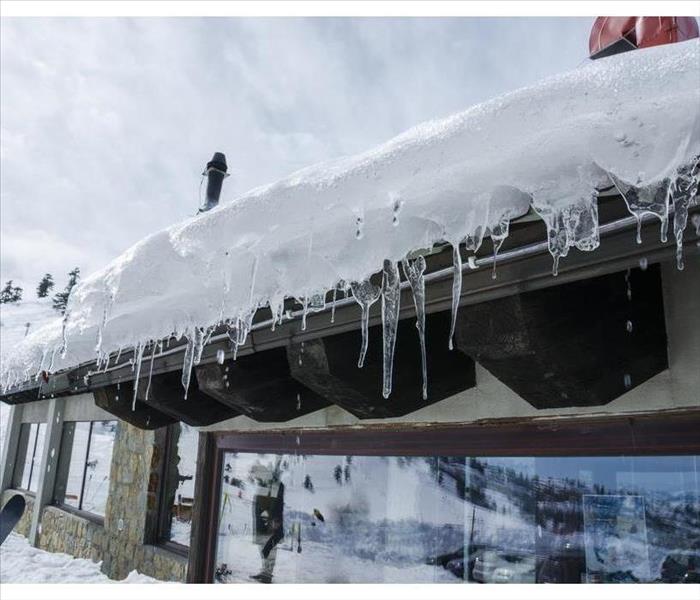 Ice dam on a St. Charles, MO building
Ice dam on a St. Charles, MO building
What Happens to Your Building After a Snow Storm?
During severe weather, your St. Charles, MO, business may be more likely to experience damage to its premises. One thing that can cause a problem is the formation of an ice dam. This seemingly innocent product of melted snow can cause costly damage. Here is what happens to your building after a snow storm.
1. Snow Melts and Forms Ice on the Roof and Gutters
During a snow storm, quite a bit of snow can accumulate on your building’s roof and gutters. Heat from inside of the building or from the weather warming up can cause the snow to melt and then reform as ice. The buildup of ice can prevent the rest of the snow from draining properly as it melts, which can cause damage to your building.
2. Water Leaks Into Your Building
As the snow begins to melt, because the ice dam prevents it from draining, it can begin to trickle down inside of the walls of your building. As this continues, it can cause damage to walls as well as create the right conditions for a fungus, such as black mold, to form.
3. Mold Begins To Form
As the water creates moisture inside of the walls, fungus can begin to grow within the day. After just a short period, you might be left with a big problem that requires professional mold cleanup. The mold will continue to spread as long as the moisture is not removed. If you believe that a growth has formed, you should take action immediately.
Mold spreads very quickly, so the best way to keep your building mold-free is to remove the snow and ice from your building before it causes any damage. If you are unable to do so and an ice dam causes leaking and mold, you should hire a mold remediation service to take care of it as soon as you can.
How to handle a commercial water loss in St. Charles, MO
4/9/2019 (Permalink)
If you have a commercial water loss in St. Charles, MO, SERVPRO of St. Charles City is the premier restoration company to help you from start to finish.
Here is a typical guideline of what will be needed to perform to get your business back to pre loss condition.
1. Initial Assessment: This can include the initial walkthrough and determine what needs to be done from start to finish. Typically a scope of service will be written.
2. Immediate Emergency Services: SERVPRO of St. Charles City will begin extracting and removing water from the facility.
3. Drying: SERVPRO will place drying equipment throughout your facility. Each day a member of their team will check on the progress until the structure is dry.
If you have any questions, do not hesitate to reach out to us at anytime. We are always here to help!
What to do if you have a fire in your place of business
4/9/2019 (Permalink)
If you have a fire in your business, it can create a stressful time for you and your team. Luckily, SERVPRO of St. Charles City is here to help from start to finish. Our goal is to get your property back to pre loss condition as soon as possible.
The first step is for SERVPRO to perform the initial emergency services. Once all of the water and damaged materials are removed from the fire, SERVPRO can begin the cleaning process. Each fire job can be different, so it is important to follow all guidelines set forth by the IICRC.
SERVPRO takes great pride in documenting each step of the project so you have accurate records of you job for your insurance company. If you have any questions, do not hesitate to reach out to us at anytime.
Can SERVPRO help with a large Commercial Loss
4/9/2019 (Permalink)
Can SERVPRO of St. Charles City help with a large commercial loss?
The answer to that question is absolutely yes. SERVPRO has more equipment and manpower than any company in the St. Peters and St. Charles area. If you have any questions, do not hesitate to reach out to us at anytime.
Every loss can be different, so it is important to make sure that a trained company like SERVPRO assesses each step of the job to make sure the proper steps are taken.
It is important to make sure that plenty of notes and pictures are taken throughout the project. This can help if there are any issues with your insurance company along the way.
If you have any questions, please do not hesitate to reach out to us at anytime.
Who is the best commercial restoration company
4/9/2019 (Permalink)
SERVPRO of St. Charles City is the best choice when it comes to choosing a disaster restoration company. If you own a large or small business, SERVPRO understands the importance of keeping your doors open and minimizing downtown in the nature of a catastrophic event.
Our team is faster than any other restoration company in the St. Charles City region. Our technicians and managers are trained and certified to handle any type of water, fire or mold damage. We pride ourselves in being an educational resource to help your from start to finish.
Documentation throughout any large project is a priority that we take seriously. We want to make sure that you have the notes and documentation for your records in case you have any issues with your insurance company.
If you have any questions, call SERVPRO at anytime day or night.
Flood Damaged Documents Can Be Saved
3/25/2019 (Permalink)
Imagine if a three-foot wave of water hit Portage Des Sioux,MO. The business documents, company records, and personal keepsakes that would be impacted by the water would be tremendous. Many of the documents can be critical to the every-day business of companies, while other documents, such as tax records or credit and debit accounts would be very difficult to replace. If you find yourself, or one of your insured in need of document restoration services, turn to SERVPRO to help you restore those valued items.
When Does Restoration Work?
Even 30 years ago, if a valuable paper item was flood damaged, it was considered an insurance write-off because most of the time it could not be restored. Not only were the pages bacteria infused, but the dirt and chemicals could not be removed.
Thanks to a special freeze-drying technique, that is no longer the case. Paper items such as
- Business files
- Manuscripts
- X-rays
- Photographs
- Books
- Parchment
can be put through a document drying process and restored to near pre-flood condition. The advanced technology is the same one the Library of Congress used to remove mold, bacteria, and dirt from their most valuable documents.
How Does Restoration Work?
There are two methods of document restoration often used by SERVPRO technicians. The first is making a digital representation of the document. This saves space and keeps them safe from future damage. The second is the freeze-drying method mentioned above which extracts all the water from the damaged documents while keeping the pages intact and doing so without the brittleness that often accompanies water soaked papers.
How Does Restoration Help You?
Whether you are an adjuster, insured, or company owner, SERVPRO’s document drying can save you money because they process the documents themselves. The technicians have been trained with the latest equipment available, and they can work quickly and efficiently to get the job done.
You can trust this reputable company with your document restoration needs. Give them a call and find out what services they have to offer.
Three Things You Should Know About Water Damage
3/17/2019 (Permalink)
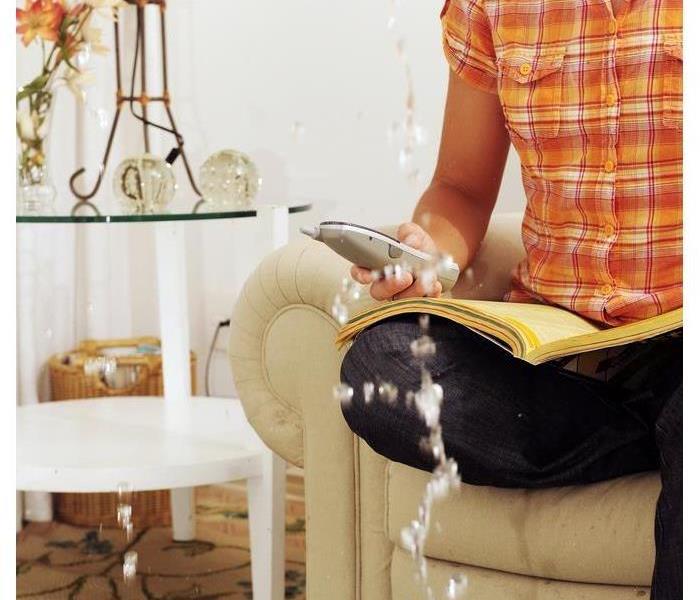 Leaking roof in a Weldon Spring, MO home
Leaking roof in a Weldon Spring, MO home
3 Things to Keep in Mind in The Event of Water Damage
Water from a storm or pipe burst is often the cause of home damage, but it is likely that you don’t know all there is to know about this common problem. Here are a few things to keep in mind in the event of water damage to your Weldon Spring,MO home.
1. It Can Come From a Variety of Sources
There are many things that can cause water damage. In the winter, frozen pipes can break, and snow or ice can cause damage to your roof and create a leak. A broken water line can also cause quite a bit of damage. Water can also come from a smaller source, such as a leaky pipe or cracks in the walls.
2. It Is Not Always Covered By Homeowners Insurance
Depending on the source of the water damage, you will not always be covered by your insurance. One example is if you have failed to maintain your home properly and a broken pipe or appliance is found to be caused by negligence. Another instance when you will generally not be covered is if the damage is caused by flooding. Most homeowners policies do not cover this type of natural disaster, and you will need to have a separate flood policy.
3. It Can Cause Significant Damage
Even if the source of damage seems insignificant, you should have it dealt with right away. A leaky window may not be as much of an emergency as having a pipe burst, but if it is ignored, the water damage will only worsen. Water can cause building materials to warp and can contribute to the growth of mold inside of your walls and flooring, so it should be taken care of as soon as you notice it.
Whether a pipe burst or a leaky roof has let in moisture, a professional water damage remediation service can help. They can repair both the source of water in your home as well as the resulting damage. If you notice water in your home, do not hesitate to get it fixed.
Why Does Food Get Moldy?
3/8/2019 (Permalink)
 Mold can grow anywhere. All it needs is some moisture and the right temperature
Mold can grow anywhere. All it needs is some moisture and the right temperature
Three Main Elements That Contribute to Moldy Food
You open up your bread box, and the musty smell hits you. Then you get visual confirmation as you pull the loaf of bread out of the box. You have bread mold. Understanding how mold growth in food happens can help you store food differently and thus prolong its life. There are three main elements that contribute to moldy food.
1. Warmth
Mold thrives at room temperature. If your bread is in an open container without being sealed, spores from the air can settle on its surface and begin to grow quickly. You can slow down the fungus growth process a little by storing food in a sealed bag, but mold can still get in. In fact, if the temperature in the room is too warm, plastic wrap may act as an incubator for mold.
2. Moisture
Another key contributor to bread mold growth is moisture. A wet surface is particularly inviting to spores, which is why mold remediation specialists always seek to dry out an area with water damage before trying to clean it. This is why fridge mold occurs, despite the appliance's cooler internal temperature. The cooler air may slow down the growth, but eventually, the moisture creates the perfect home for mold.
3. Food
Bread and other foods often mold because the fungus feeds off the nutrients in these items. Warmth and moisture alone are not enough to sustain a patch of mold. It must have sustenance, and bread is the perfect meal for it. Because it does not derive any of its nourishment from the sun, mold depends solely on organic matter to feed itself.
Many surfaces in your home in O'Fallon,MO, are susceptible to mold growth, and your food is no exception. By understanding how bread mold forms, you may be able to adjust how you store it so that you can make it last longer.
The Necessary Relationship Between Insurance Claims and Disaster Response
2/18/2019 (Permalink)
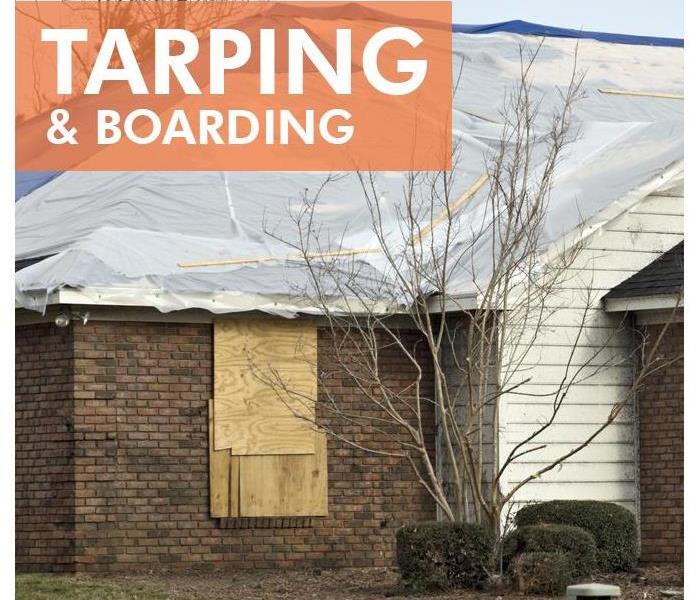 SERVPRO provides board up and tarping services
SERVPRO provides board up and tarping services
Insurance Claims and Disaster Response
Insurance claim services require many things from homeowners as far as paperwork and proof of damage, but not every owner is prepared to provide these details and may even struggle to focus after experiencing a disaster. Therefore, it can be up to an insurance agent to guide clients through the process by making suggestions as to what comes next. One of the most significant suggestions you can make to a distraught client is that of a disaster restoration specialist in the St. Peters,MO, area, like SERVPRO. These companies will help to guide your client through the process while simultaneously making the claims process easier for you.
1. Reducing the Risk of Claims Denial
A potential misstep for clients without guidance is a lack of an emergency response regarding mitigation practices. The proper care of the damaged property is pivotal to claims approval. If a client fails to prevent further damage, then they put the whole restoration project in jeopardy. Therefore, you should share the importance of board-up and tarping services provided by restoration companies.
2. Helping to Uncover Hidden Damage
Another vital aspect of the claim services process is the proof of loss statement. This statement provides a record of all lost and damaged insured items. Restoration companies can help with this process by thoroughly cleaning the residence, making sure that all damage is visible and brought to the homeowner’s attention.
3. Performing the Restoration
Once you have filed a claim on behalf of your client and the funding is approved, the restoration work can begin. This is an exciting time for most clients as they start to see the reality that their home will be their home again.
The claim services process is difficult and time-consuming, but when that process is combined with devastated clients, it becomes that much more trying. During these difficult times, it is your job to help nudge clients in the right direction and toward competent specialists who will help both you and the client get through.
3 Ways Engineers Can Prevent Flooding in Urban Areas
2/13/2019 (Permalink)
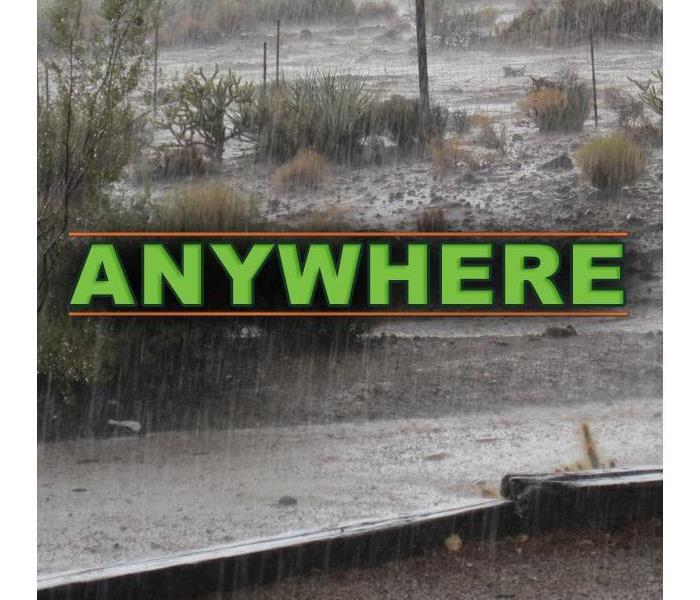 It is important that cities develop ways to stop flooding in order to protect its citizens
It is important that cities develop ways to stop flooding in order to protect its citizens
3 Ways Engineers Can Prevent Flooding In Urban Areas
Many cities throughout the world are aware of how devastating the damage caused by flooding can be. Whether they are located near large bodies of water or experience heavy rain on a consistent basis, there are several flood prevention methods engineers have used to protect the entire city. If your business in St. Charles, MO has seen its fair share of damage caused by high water and is only back in business due to the work of skilled storm damage restoration specialists, you might be wondering what tactics are actually effective at preventing floods. Here are three ways engineers have used to help prevent flooding in urban areas around the world.
1. Water Barriers
Many countries use various types of technologically advanced water barriers to stop high water in its tracks. Water gates, dams, storm surge barriers, and dikes are all methods used to keep the ocean from flooding the nearby city. Various advancements like aqua-drive motors and movable gates are increasingly efficient at stopping floods in their tracks.
2. Enhanced Drainage Systems
Since typical rigid draining systems are unable to deal with a large amount of water runoff or rainfall, one way to address urban flooding is to enhance these draining systems and make them more flexible. Some cities have even adopted sustainable drainage options by replacing impermeable surfaces like concrete with soil and plant life.
3. Constructing Flood-Proof Businesses
Cities who experience frequent high water issues and flooding have begun to rethink how they construct buildings. From constructing buildings far above flood levels to using materials that are designed to withstand contact with water for long periods of time, there are ways to help businesses and homes better withstand the damage flooding causes.
It is important that cities develop ways to stop flooding in order to protect its citizens and allow growth within the city. While there are many unique ways cities have battled flooding around the world, these three methods are a good place to start!
How To Choose and Use a Fire Extinguisher for Your Home
2/5/2019 (Permalink)
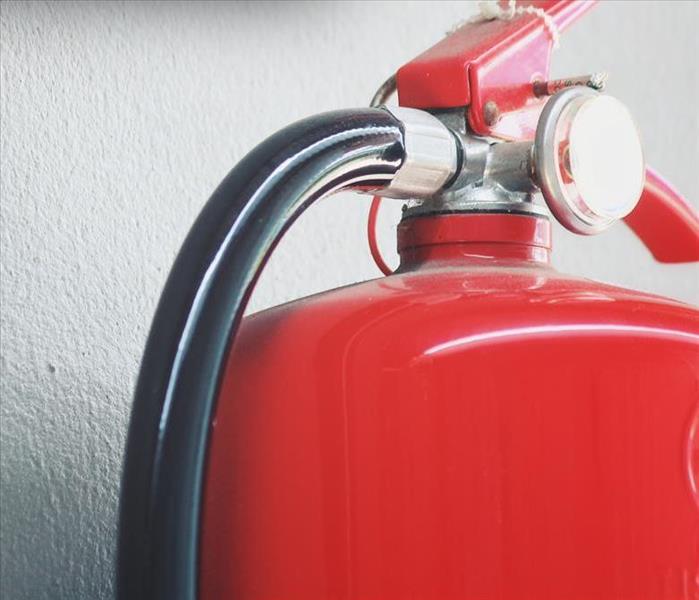 Fire extinguishers are a vital element of home and family safety
Fire extinguishers are a vital element of home and family safety
You hope you never have to face a fire in your home, but taking appropriate precautions is an important way to prepare for emergencies. One of the first things you should do, in addition to installing appropriate fire and smoke alarms, is to put a fire extinguisher in the kitchen,
Types and Classes of Extinguishers
The first step is to identify the appropriate type of extinguisher. There are several options available. These include:
- Water
- Water Mist
- AFFF Foam
- Carbon Dioxide
- ABC Powder
- Wet Chemical
It's important to understand which of these is best for your home. Look at the class designations to make this decision, for example water and foam fire extinguishers are only appropriate for class A fires.
- Class A: solid combustible materials, such as paper, coal, and wood
- Class B: flammable liquids, such as paints, alcohol, and paraffin
- Class C: combustion gases, such as propane, methane, and natural gas
- Class D: flammable metals, such as aluminum, sodium, and potassium
- Class K: combustible cooking materials, such as fats and grease
- Electrical: electrical appliances, such as stereos and fuse boxes
Why the Correct Choice Matters
Using the correct extinguisher is vital. For example, if you were to use a water mist extinguisher on a Class F fire, the water may send drops of burning oil or grease around the room, causing fire damage and injuries to your family members. The extinguishers recommended for homes are Class ABC with higher classification numbers, such as a 3-A:40-B:C unit.
How To Use an Extinguisher
Once you've chosen your extinguisher, follow the PASS sequence to put out flames before fire damage becomes too severe.
- PULL the pin.
- Aim at the base of the fire.
- SQUEEZE the lever or button about the handle.
- SWEEP from side to side.
If you already have extinguishers in your home, check the date. Even if you haven't used the devices, they may lose pressure or effectiveness if they are too old.
Keep Your Home and Family Safe
Fire extinguishers are a vital element of home and family safety. If you're not sure where to keep the safety devices or how many you need for your home, contact fire remediation professionals in St. Charles, MO.
4 Reasons DIY Mold Test Kits Tend To Be Ineffective
1/23/2019 (Permalink)
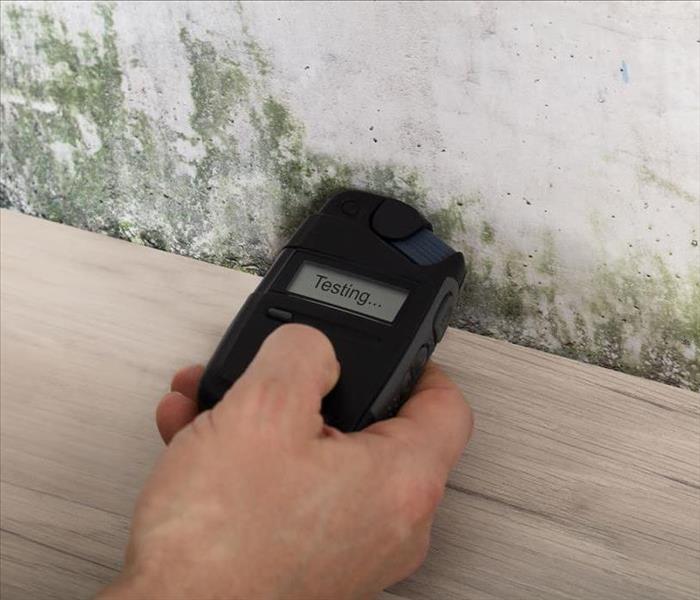 Contact a certified professional who can evaluate your home fungal infestation
Contact a certified professional who can evaluate your home fungal infestation
4 Reasons DIY Mold Test Kits Tend To Be Ineffective
If you’re concerned about possible mold contamination inside your Weldon Spring, MO, home, purchasing a mold kit may seem like a good idea. To obtain a more accurate assessment, however, many industry professionals argue that mold testing should be completed by a certified specialist. To support their argument, they often list several reasons why home test kits tend to be ineffective.
1. Prevalence of Fungus in the Environment
Because the fungus exists throughout the environment, it’s likely to grow on every DIY mold evaluation sample. While seeing growth on the collection plate may alarm you, it does not necessarily mean that your home has a serious problem requiring extensive mold remediation.
2. Importance of a Visual Inspection
Because it enables you to identify the exact source of contamination, many professionals argue that a thorough visual inspection is a key component of mold testing. Home test kits do not assist with this task. Certified experts are knowledgeable about fungal behavior and often have access to specialized equipment that can help them detect moisture issues and efficiently diagnose the problem.
3. Lack of Expiration Dates
A mold kit usually contains a sterile collection plate. Unfortunately, many units do not contain an expiration date. As a result, it’s often impossible to tell when it was sealed and how long it has been sitting on the shelf. This can be problematic because over time numerous environmental factors, such as temperature variations and exposure to moisture, can compromise the integrity of the sterile collection surface.
4. Lab Integrity
Unless specifically stated, your sample may not be analyzed by an accredited lab. Proper certification can be important because it implies that an organization follows established standards during the testing process, which helps ensure accurate results.
Mold testing can be a useful means of identifying contaminants, but DIY testing kits often provide inconclusive results. For this reason, it’s usually best to consult a certified professional who can help you properly evaluate your home for fungal infestation.
Prevent Water Damage While You Are Away
1/19/2019 (Permalink)
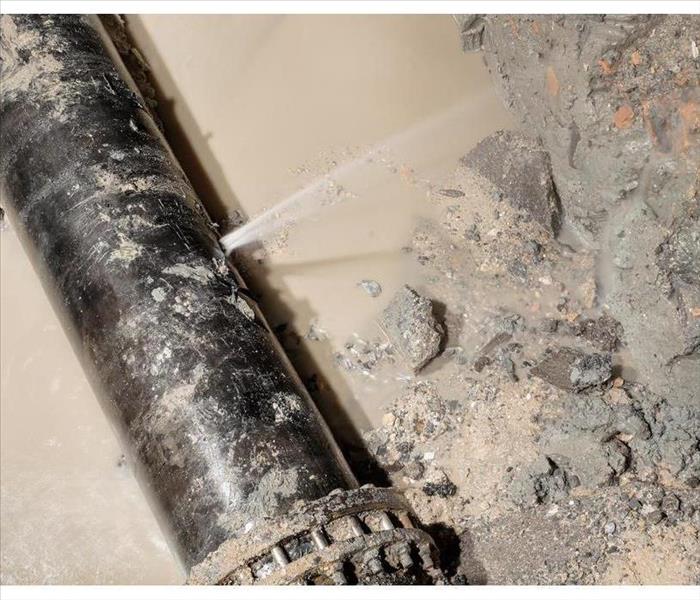 Broken pipe in St. Peters, MO
Broken pipe in St. Peters, MO
Have you ever traveled for an extended period of time and wondered what was going on in your home in St. Peters,MO? In order to prevent the necessity of water pipe repair, it is important to properly monitor your home while you are away.
Steps To Prevent Water Damage
In order to prevent water damage from a broken pipe while away from your home, here is a list of things you can do to prevent coming home to a house that is flooded.
- Make sure that your heat is on to prevent pipes from freezing while you are away.
- Have someone check on your home while you are gone or utilize a digital home monitoring system that can be viewed using your smart devices.
- Check all the pipes in your water system and heating system before departing to make sure there are no cracks.
- Ensure that your heating system is working correctly, that all necessary repairs have taken place and that the oil tank is filled if your home is heated by oil.
- Look at the connections to your appliances to determine they are secure and there is no chance of a leak occurring.
It is important to take the necessary steps to prevent a leak and do your best to ensure that water pipe repair is not needed when you return home.
What if Water Damage Occurs?
Even with all the preventative measures, there is no guarantee that you will not come home to a broken pipe or some sort of water damage. If something has flooded while you were away, it is important to take the proper steps to dry your home and personal property. Shut off the main water valve if the leak has occurred in a pipe in order to prevent further damage. If the amount of water damage is severe, a professional water mitigation company can help to restore your home and prevent future issues.
Sitting water can be harmful to your health and home. Prevent it if you can, and don’t be afraid to ask for help with water pipe repair when it is necessary.
The Riddle of Water Damage After a Fire
1/12/2019 (Permalink)
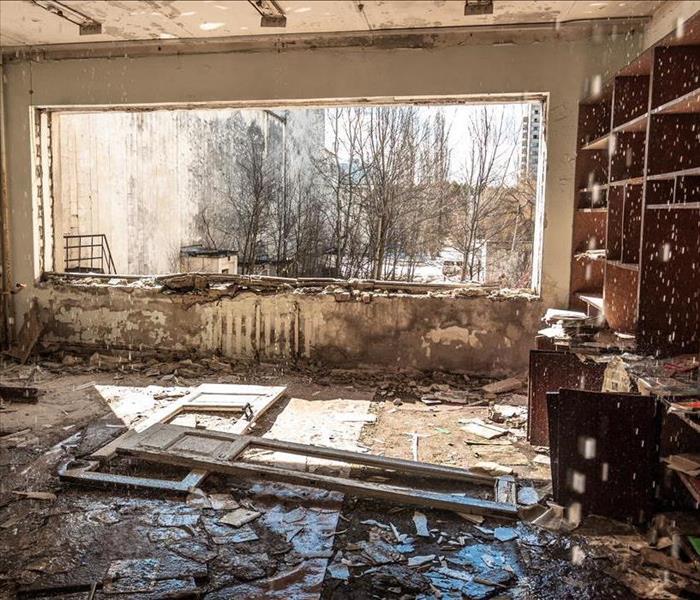 Water damage after a fire in St. Charles, MO
Water damage after a fire in St. Charles, MO
Water Damage After a Fire
The flames billow during a fire in St. Charles,MO, and nothing is more welcome that the fire fighting crew with the pressurized water hoses and chemical retardants being sprayed onto the roof of your commercial building. As the flames die down, an inspector can then inform you the building is safe to reenter. That is when you notice the fire damage and water - so much water. How can you begin to deal with all that unexpected water? Try these three steps.
1. Contact a Professional
Fire and smoke restoration professionals can quickly begin work on removing the water from your building once the fire marshal, inspector or deputy allow entrance. By beginning the cleanup process as quickly as possible, future mold and mildew problems can often be alleviated.
2. Look for Water
An average fire hose can supply up to 24 gallons of water a minute when fighting a fire. That means that in 30 minutes, the hose is shooting out enough water to fill an average swimming pool with about 18 inches of water. Along with fire damage, water pressure often breaks windows, tears through doors, and enters ceiling holes. Water may find its way into unexpected places such as inside electronics, under wooden floors, and inside walls. Looking for water damage in hidden places can save time and money.
3. Create Air Flow
After removing as many of the porous items from the water as possible, and once the professional team has removed the majority of the liquid, create a method of air circulation and ventilation. Your fire restoration team may offer industrial blowers, dehumidifiers and air moving fans, but if they do not, it is still important to get the air moving to remove excess moisture from the building. This can help prevent mold and mildew, warping floors, and bulging walls.
Fire damage often includes hundreds of gallons of water. Knowing what the possible scenario is in the aftermath of a fire can help you be prepared for the unexpected. Too much water can be a bad thing, especially when it is on the floor of your commercial property.
What Water Damage Can Do To Your Home or Business:
11/15/2018 (Permalink)
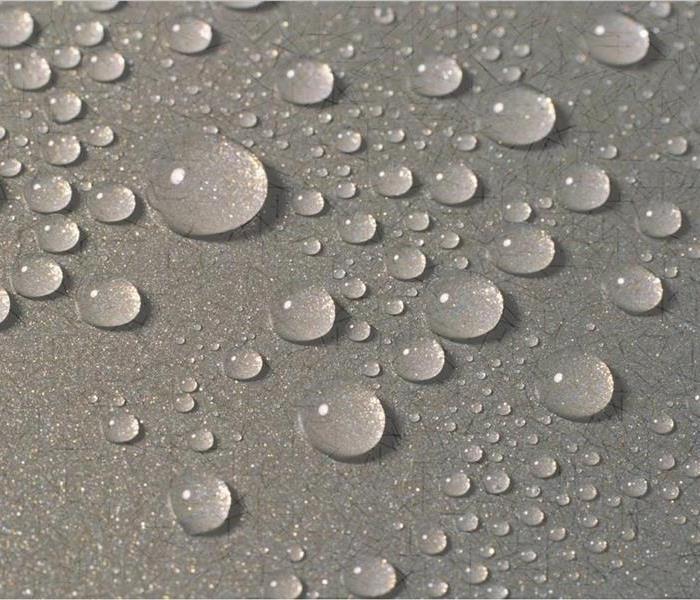 Common Water Damage
Common Water Damage
Flooding and water emergencies don’t wait for regular business hours and neither do we. SERVPRO of St Charles City and County provides emergency cleaning and restoration services 24 hours a day, 7 days a week—including all holidays.
Flooding and water damage is very invasive. Water quickly spreads throughout your home and gets absorbed into floors, walls, furniture, and more. SERVPRO of St Charles City and County arrives quickly and starts the water extraction process almost immediately. This immediate response helps to minimize the damage and the cleaning and restoration costs.
Need Emergency Service? Call Us 24/7 SERVPRO of St Charles City and County 636-926-0033
Here is a Typical Timeline for Water Damage:
Within Minutes:
- Water quickly spreads throughout your property, saturating everything in its path.
- Water is absorbed into walls, floors, upholstery, and belongings.
- Furniture finishes may bleed, causing permanent staining on carpets.
- Photographs, books, and other paper goods start to swell and warp.
Hours 1 - 24:
- Drywall begins to swell and break down.
- Metal surfaces begin to tarnish.
- Furniture begins to swell and crack.
- Dyes and inks from cloth and paper goods spread and stain.
- A musty odor appears.
48 Hours to 1 Week:
- Mold and mildew may grow and spread.
- Doors, windows, and studs swell and warp.
- Metal begins to rust and corrode.
- Furniture warps and shows signs of mold.
- Paint begins to blister.
- Wood flooring swells and warps.
- Serious biohazard contamination is possible.
More Than 1 Week:
- Restoration time and cost increase dramatically; replacing contaminated materials and structural rebuilding may be extensive.
- Structural safety, mold growth, and biohazard contaminants pose serious risks to occupants.
About SERVPRO of St Charles City and County
SERVPRO of St Charles City and County specializes in the cleanup and restoration of residential and commercial property after a fire, smoke or water damage event. Our staff is highly trained in property damage restoration. From initial and ongoing training at SERVPRO’s corporate training facility to regular IICRC-industry certification, rest assured our staff is equipped with the knowledge to restore your property.
Hurricane HELP
9/18/2017 (Permalink)
Join #SERVPRO in support of the American Red Cross and let’s help those affected by the hurricane. Text HARVEY to 90999 to donate $10 now!
the American Red Cross “Sound the Alarm” Campaign
8/28/2017 (Permalink)
We are Proud sponsors of The American Red Cross and this year They are promoting the "Sound the Alarm" Campaign
Seven times a day, someone in this county dies in a home fire. countless others suffer injuries. join us as we sound the alarm and combat these tragic statistics. learn how: https://www.redcross.org/sound-the-alarm





 24/7 Emergency Service
24/7 Emergency Service



















































































































































